HID Global X002200 This is a color card printer on a plastic identification cards User Manual Windows User Guide
HID Global Corporation This is a color card printer on a plastic identification cards Windows User Guide
Contents
- 1. Windows User Guide
- 2. Installation Guide
Windows User Guide

hidglobal.com
FARGO® HDP®6600
HIGH DEFINITION CARD PRINTER/ENCODER
MODEL X002200
USER GUIDE
PLT-02931, Rev. A.0
September 2018
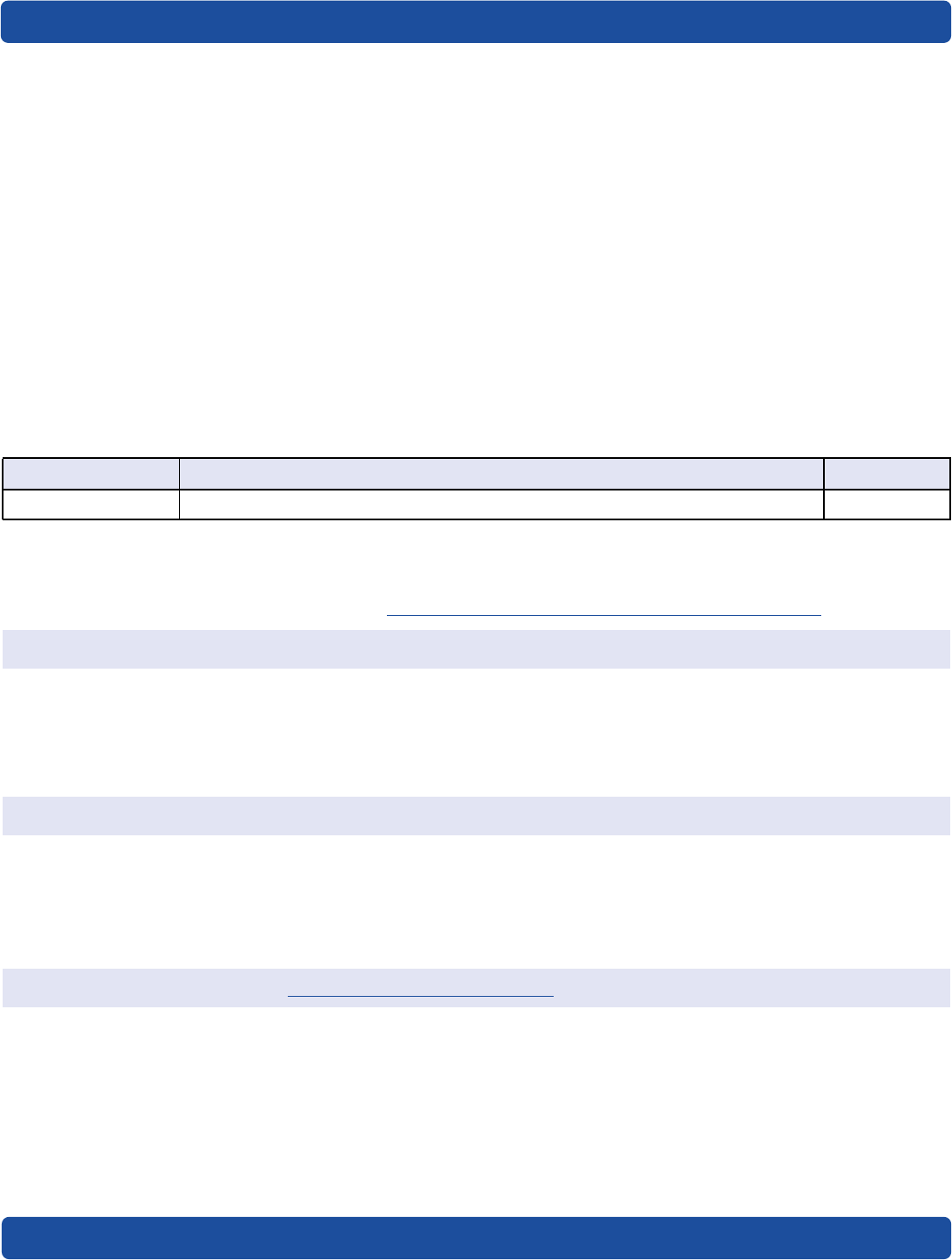
2September 2018
Copyright
© 2018 HID Global Corporation/ASSA ABLOY AB. All rights reserved.
This document may not be reproduced, disseminated or republished in any form without the prior written
permission of HID Global Corporation.
Trademarks
HID GLOBAL, HID, the HID Brick logo, the Chain Design, FARGO, POLYGUARD, HDP, SECUREMARK,
ULTRACARD, INDALA, OMNIKEY, ICLASS SE, and ICLASS are trademarks or registered trademarks of HID
Global, ASSA ABLOY AB, or its affiliate(s) in the US and other countries and may not be used without
permission. All other trademarks, service marks, and product or service names are trademarks or registered
trademarks of their respective owners.
MIFARE is a registered trademark of NXP B.V. and is used under license.
Revision history
Contacts
For additional offices around the world, see www.hidglobal.com/contact/corporate-offices
Date Description Revision
September 2018 Initial release. A.0
Americas and Corporate Asia Pacific
611 Center Ridge Drive
Austin, TX 78753
USA
Phone: 866 607 7339
Fax: 949 732 2120
19/F 625 King’s Road
North Point, Island East
Hong Kong
Phone: 852 3160 9833
Fax: 852 3160 4809
Europe, Middle East and Africa (EMEA) Brazil
Haverhill Business Park Phoenix Road
Haverhill, Suffolk CB9 7AE
England
Phone: 44 (0) 1440 711 822
Fax: 44 (0) 1440 714 840
Condomínio Business Center
Av. Ermano Marchetti, 1435
Galpão A2 - CEP 05038-001
Lapa - São Paulo / SP
Brazil
Phone: +55 11 5514-7100
HID Global Technical Support: www.hidglobal.com/support
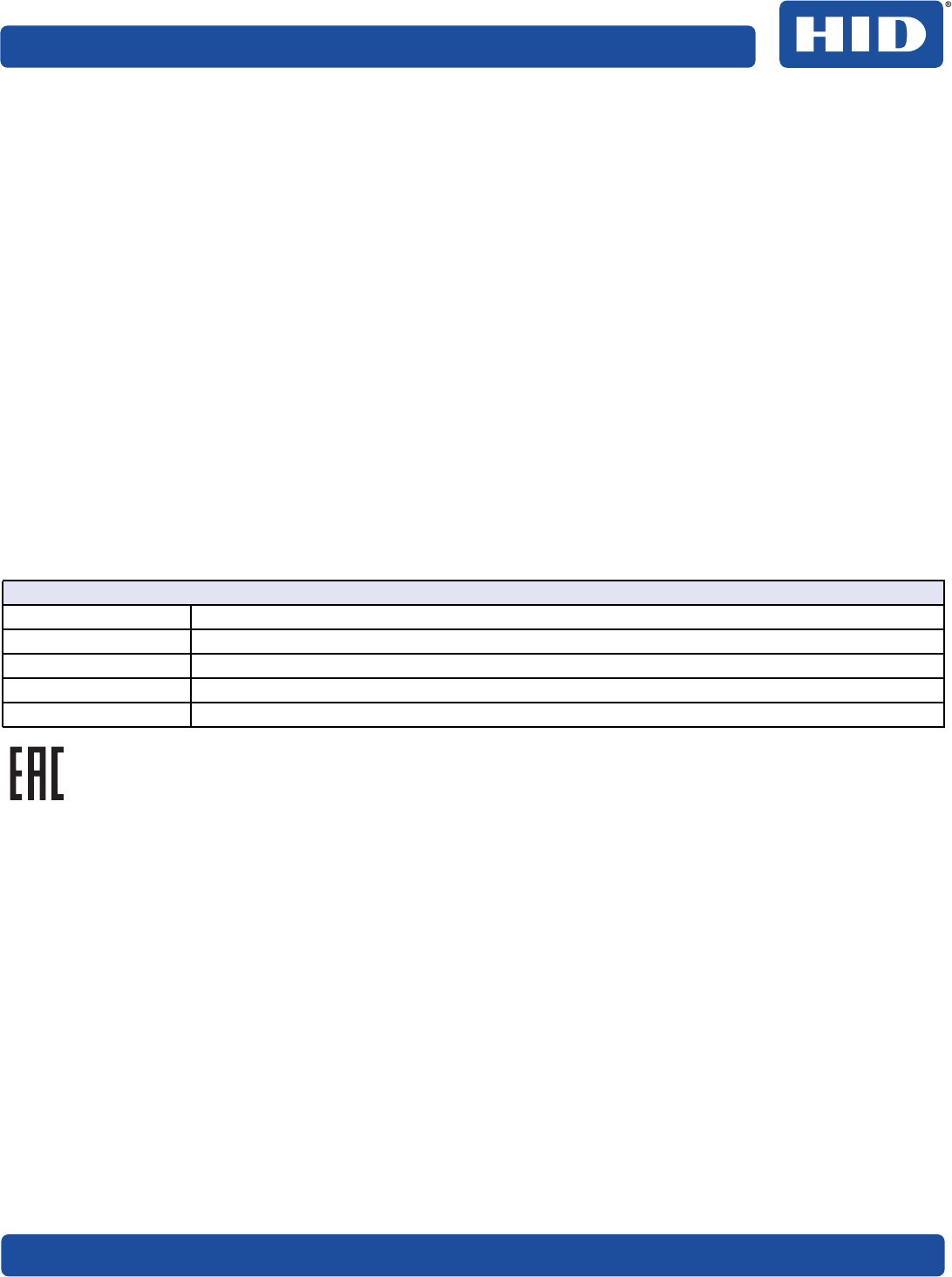
September 2018 3
PLT-02931, Rev. A.0
̴͇͏͓͔͕͉͇͔͌͏͕͈͕͚͕͉͇͔͌͗͋͏ͦ
͉͙͔͕͇͙͖̽͌͐͑͗͗͏͔͙͌͗
̳͕͋͌͒ͣ
+'3
̴͕͓͇͙͗͏͉͔͔͕͓͓͕͐͌͗͋͌͒͢͏;
̴͇͎͔͇͔͌͞͏͕͈͕͚͕͉͇͔͌͗͋͏ͦ
̶͇͙͌ͣ͞͏͎͕͈͇͍͔͗͌͏͔͇͖͇͙͐͒͘͏͕͉͑͢͜͏͔͙͋͌͏͛͏͇͑͝͏͕͔͔͇͙͑͗͢͜
̷͙͌͐͏͔͊͏͔͇͖͍͔͗ͦ͌͏ͦ
̩͖͓͔͔͕͕͙͕͇͕̩͖͓͔͔͕͕͙͕͇̪͌͗͌͌͊͑͋͌͗͌͌͊͑͝
̶͕͗͏͎͉͕͋͏͙͇͌͒ͣ͋͗͌͘
+,'*OREDO&RUSRUDWLRQ
)O\LQJ&ORXG'ULYH6XLWH
(GHQ3UDLULH0186$
̸͙͇͔͇͖͕͗͗͏͕͍͔͋͌͘͜͏ͦ
̸͇͔͕͉̱͋͌͒͏͙͇͌
̷̸̹̹m̵͈͎͕͖͇͔͕͙͌͘͘͏͔͏͎͕͉͕͙͔͕͕͕͈͕͚͕͉͇͔͑͒ͣ͊͗͋͏ͦ}̷͚͙͉͔͌͌͟͏̸͓̱̹͌
͕͙͊ഥ
̷̸̹̹m͙͕͓͇͔̈́͒͌͑͗͊͏͙͔͇͕͉͓͙ͦ͌͘͘͏͓͕͙͙͔ͣ͌͘͜͏͌͑͘͞͏͙͉͗͌͋͘͘͜}̷͚͙͉͔͌͌͟͏̸͓̱̹͌
͕͙͊ഥ
̫͇͙͇͏͎͕͙͕͉͔͊͒͌͏͚͇͎͇͔͇͔͇͓͇ͦ͑͗͑͏͕͉͕͈͕͚͕͉͇͔͗͑͌͗͋͏ͦ
̶͙͇͉͗͌͋͘͏̷͙͉͕͌͒ͣ͘͘͏͕̻͇͐͑͐͌͋͌͗͘͝͏͏
̴͇͎͉͇͔͏͌ ̵̵̵m̫͕͛͏͔}
̧͋͗͌͘ ̷̵̻̳͕͕͉͇͕͈͎͑͑ͦ͒͌͗͑͘͘͘͏̨͇͕͔͕͐͗͐ͦ͗͑͘͏͔͕
̱͕͔͙͇͙͔͕͑͌͒͏͕͝ ̴̲̪͕͚͈͕͉͇͒
̹͕͔͌͒͌͛
HPDLO ORFDOGHFODUDQW#JPDLOFRP

PLT-02931, Rev. A.0
This page is intentionally left blank.
4September 2018

Contents
September 2018 5
Section 1: Specifications. . . . . . . . . . . . . . . . . . . . . . . . . . . . . . . . . . . . . . . . . . . . . . . . . . . . . . . . . . . . . 9
1.1 Regulatory compliance . . . . . . . . . . . . . . . . . . . . . . . . . . . . . . . . . . . . . . . . . . . . . . . . . . . . . . . . . . . 9
1.1.1 United States . . . . . . . . . . . . . . . . . . . . . . . . . . . . . . . . . . . . . . . . . . . . . . . . . . . . . . . . . . . . . . . 10
1.1.2 Canada . . . . . . . . . . . . . . . . . . . . . . . . . . . . . . . . . . . . . . . . . . . . . . . . . . . . . . . . . . . . . . . . . . . . 10
1.1.3 Taiwan. . . . . . . . . . . . . . . . . . . . . . . . . . . . . . . . . . . . . . . . . . . . . . . . . . . . . . . . . . . . . . . . . . . . . . 11
1.1.4 Japan. . . . . . . . . . . . . . . . . . . . . . . . . . . . . . . . . . . . . . . . . . . . . . . . . . . . . . . . . . . . . . . . . . . . . . . 11
1.1.5 Korea. . . . . . . . . . . . . . . . . . . . . . . . . . . . . . . . . . . . . . . . . . . . . . . . . . . . . . . . . . . . . . . . . . . . . . . 11
1.2 Safety messages-United States. . . . . . . . . . . . . . . . . . . . . . . . . . . . . . . . . . . . . . . . . . . . . . . . . . . 12
1.3 Safety messages-French Canada . . . . . . . . . . . . . . . . . . . . . . . . . . . . . . . . . . . . . . . . . . . . . . . . . 13
1.4 Safety messages-Taiwan . . . . . . . . . . . . . . . . . . . . . . . . . . . . . . . . . . . . . . . . . . . . . . . . . . . . . . . . 14
1.5 Safety messages-China . . . . . . . . . . . . . . . . . . . . . . . . . . . . . . . . . . . . . . . . . . . . . . . . . . . . . . . . . . 15
1.6 Technical specifications . . . . . . . . . . . . . . . . . . . . . . . . . . . . . . . . . . . . . . . . . . . . . . . . . . . . . . . . . 16
Section 2: Setup and installation. . . . . . . . . . . . . . . . . . . . . . . . . . . . . . . . . . . . . . . . . . . . . . . . . . . . . . 19
2.1 Selecting a good location . . . . . . . . . . . . . . . . . . . . . . . . . . . . . . . . . . . . . . . . . . . . . . . . . . . . . . . . 19
2.2 Moisture condensation . . . . . . . . . . . . . . . . . . . . . . . . . . . . . . . . . . . . . . . . . . . . . . . . . . . . . . . . . . 19
2.3 Unpacking and inspection . . . . . . . . . . . . . . . . . . . . . . . . . . . . . . . . . . . . . . . . . . . . . . . . . . . . . . 20
2.4 Installing the HDP film . . . . . . . . . . . . . . . . . . . . . . . . . . . . . . . . . . . . . . . . . . . . . . . . . . . . . . . . . . 20
2.5 Installing the print ribbon . . . . . . . . . . . . . . . . . . . . . . . . . . . . . . . . . . . . . . . . . . . . . . . . . . . . . . . . 24
2.6 Installing the cleaning roller . . . . . . . . . . . . . . . . . . . . . . . . . . . . . . . . . . . . . . . . . . . . . . . . . . . . . . 26
2.7 Installing blank cards into the input card hopper . . . . . . . . . . . . . . . . . . . . . . . . . . . . . . . . . . . 28
2.7.1 General card information . . . . . . . . . . . . . . . . . . . . . . . . . . . . . . . . . . . . . . . . . . . . . . . . . . . . 29
2.8 Printer power. . . . . . . . . . . . . . . . . . . . . . . . . . . . . . . . . . . . . . . . . . . . . . . . . . . . . . . . . . . . . . . . . . 30
2.9 Driver installation instructions . . . . . . . . . . . . . . . . . . . . . . . . . . . . . . . . . . . . . . . . . . . . . . . . . . . . 31
Section 3: Printing preferences . . . . . . . . . . . . . . . . . . . . . . . . . . . . . . . . . . . . . . . . . . . . . . . . . . . . . . 37
3.1 File menu tab. . . . . . . . . . . . . . . . . . . . . . . . . . . . . . . . . . . . . . . . . . . . . . . . . . . . . . . . . . . . . . . . . . . 38
3.1.1 Basic setup page . . . . . . . . . . . . . . . . . . . . . . . . . . . . . . . . . . . . . . . . . . . . . . . . . . . . . . . . . . . 39
3.1.2 Card view page . . . . . . . . . . . . . . . . . . . . . . . . . . . . . . . . . . . . . . . . . . . . . . . . . . . . . . . . . . . . . .41
3.1.3 Help page . . . . . . . . . . . . . . . . . . . . . . . . . . . . . . . . . . . . . . . . . . . . . . . . . . . . . . . . . . . . . . . . . . 42
3.1.4 Exit options . . . . . . . . . . . . . . . . . . . . . . . . . . . . . . . . . . . . . . . . . . . . . . . . . . . . . . . . . . . . . . . . 42
3.1.5 Details window . . . . . . . . . . . . . . . . . . . . . . . . . . . . . . . . . . . . . . . . . . . . . . . . . . . . . . . . . . . . . 43
3.2 Advanced menu tab. . . . . . . . . . . . . . . . . . . . . . . . . . . . . . . . . . . . . . . . . . . . . . . . . . . . . . . . . . . . 44

6September 2018
PLT-02931, Rev. A.0
3.2.1 Information panel . . . . . . . . . . . . . . . . . . . . . . . . . . . . . . . . . . . . . . . . . . . . . . . . . . . . . . . . . . . 54
3.2.2 Card image area . . . . . . . . . . . . . . . . . . . . . . . . . . . . . . . . . . . . . . . . . . . . . . . . . . . . . . . . . . . . 55
3.3 Encoding menu tab . . . . . . . . . . . . . . . . . . . . . . . . . . . . . . . . . . . . . . . . . . . . . . . . . . . . . . . . . . . . . 56
3.3.1 Magnetic encoder setup configuration . . . . . . . . . . . . . . . . . . . . . . . . . . . . . . . . . . . . . . . . 57
3.3.2 ISO track locations . . . . . . . . . . . . . . . . . . . . . . . . . . . . . . . . . . . . . . . . . . . . . . . . . . . . . . . . . . 58
3.3.3 Sending track information . . . . . . . . . . . . . . . . . . . . . . . . . . . . . . . . . . . . . . . . . . . . . . . . . . . 59
3.3.4 Test magnetic encoder . . . . . . . . . . . . . . . . . . . . . . . . . . . . . . . . . . . . . . . . . . . . . . . . . . . . . . .61
3.3.5 Test smart card encoding . . . . . . . . . . . . . . . . . . . . . . . . . . . . . . . . . . . . . . . . . . . . . . . . . . . . 62
3.4 Utilities tab. . . . . . . . . . . . . . . . . . . . . . . . . . . . . . . . . . . . . . . . . . . . . . . . . . . . . . . . . . . . . . . . . . . . 64
3.4.1 Clean printer . . . . . . . . . . . . . . . . . . . . . . . . . . . . . . . . . . . . . . . . . . . . . . . . . . . . . . . . . . . . . . . 65
3.4.2 Calibrate sensors . . . . . . . . . . . . . . . . . . . . . . . . . . . . . . . . . . . . . . . . . . . . . . . . . . . . . . . . . . . 67
3.4.3 Update manager . . . . . . . . . . . . . . . . . . . . . . . . . . . . . . . . . . . . . . . . . . . . . . . . . . . . . . . . . . . . 68
3.4.4 Test print . . . . . . . . . . . . . . . . . . . . . . . . . . . . . . . . . . . . . . . . . . . . . . . . . . . . . . . . . . . . . . . . . . 69
3.4.5 Self tests . . . . . . . . . . . . . . . . . . . . . . . . . . . . . . . . . . . . . . . . . . . . . . . . . . . . . . . . . . . . . . . . . . . 70
3.4.6 PRN viewer. . . . . . . . . . . . . . . . . . . . . . . . . . . . . . . . . . . . . . . . . . . . . . . . . . . . . . . . . . . . . . . . . 72
3.4.7 Color assist. . . . . . . . . . . . . . . . . . . . . . . . . . . . . . . . . . . . . . . . . . . . . . . . . . . . . . . . . . . . . . . . . 73
3.4.8 Internal printer settings. . . . . . . . . . . . . . . . . . . . . . . . . . . . . . . . . . . . . . . . . . . . . . . . . . . . . . 75
3.4.9 Driver defaults . . . . . . . . . . . . . . . . . . . . . . . . . . . . . . . . . . . . . . . . . . . . . . . . . . . . . . . . . . . . . . .81
Section 4: HID Printer Status Monitor . . . . . . . . . . . . . . . . . . . . . . . . . . . . . . . . . . . . . . . . . . . . . . . . . 83
4.1 Configuration tab . . . . . . . . . . . . . . . . . . . . . . . . . . . . . . . . . . . . . . . . . . . . . . . . . . . . . . . . . . . . . . 84
4.2 System event log tab. . . . . . . . . . . . . . . . . . . . . . . . . . . . . . . . . . . . . . . . . . . . . . . . . . . . . . . . . . . . 85
4.3 Support tab . . . . . . . . . . . . . . . . . . . . . . . . . . . . . . . . . . . . . . . . . . . . . . . . . . . . . . . . . . . . . . . . . . . 86
Section 5: Ethernet option . . . . . . . . . . . . . . . . . . . . . . . . . . . . . . . . . . . . . . . . . . . . . . . . . . . . . . . . . . 87
5.1 Introduction . . . . . . . . . . . . . . . . . . . . . . . . . . . . . . . . . . . . . . . . . . . . . . . . . . . . . . . . . . . . . . . . . . . . 87
5.2 Technical specification . . . . . . . . . . . . . . . . . . . . . . . . . . . . . . . . . . . . . . . . . . . . . . . . . . . . . . . . . . 87
5.3 Functional specification . . . . . . . . . . . . . . . . . . . . . . . . . . . . . . . . . . . . . . . . . . . . . . . . . . . . . . . . . 88
5.4 Network services . . . . . . . . . . . . . . . . . . . . . . . . . . . . . . . . . . . . . . . . . . . . . . . . . . . . . . . . . . . . . . 89
5.4.1 Print server. . . . . . . . . . . . . . . . . . . . . . . . . . . . . . . . . . . . . . . . . . . . . . . . . . . . . . . . . . . . . . . . . 89
5.4.2 Web server. . . . . . . . . . . . . . . . . . . . . . . . . . . . . . . . . . . . . . . . . . . . . . . . . . . . . . . . . . . . . . . . . 89
5.5 Ethernet web pages. . . . . . . . . . . . . . . . . . . . . . . . . . . . . . . . . . . . . . . . . . . . . . . . . . . . . . . . . . . . 89
5.5.1 Accessing the home page . . . . . . . . . . . . . . . . . . . . . . . . . . . . . . . . . . . . . . . . . . . . . . . . . . . 89
5.5.2 Home page. . . . . . . . . . . . . . . . . . . . . . . . . . . . . . . . . . . . . . . . . . . . . . . . . . . . . . . . . . . . . . . . . 90
5.5.3 Changes to the settings . . . . . . . . . . . . . . . . . . . . . . . . . . . . . . . . . . . . . . . . . . . . . . . . . . . . . .91
5.5.4 Configuring the network settings . . . . . . . . . . . . . . . . . . . . . . . . . . . . . . . . . . . . . . . . . . . . . 92
5.5.4.1 TCP/IP settings . . . . . . . . . . . . . . . . . . . . . . . . . . . . . . . . . . . . . . . . . . . . . . . . . . . . . . . . . 93
5.5.4.2 SNMP settings . . . . . . . . . . . . . . . . . . . . . . . . . . . . . . . . . . . . . . . . . . . . . . . . . . . . . . . . . . 94
5.5.4.3 Discovery settings . . . . . . . . . . . . . . . . . . . . . . . . . . . . . . . . . . . . . . . . . . . . . . . . . . . . . . 96

September 2018 7
PLT-02931, Rev. A.0
5.5.5 Preferences . . . . . . . . . . . . . . . . . . . . . . . . . . . . . . . . . . . . . . . . . . . . . . . . . . . . . . . . . . . . . . . . 97
5.5.5.1 Change password . . . . . . . . . . . . . . . . . . . . . . . . . . . . . . . . . . . . . . . . . . . . . . . . . . . . . . . 98
5.5.5.2 Language selection . . . . . . . . . . . . . . . . . . . . . . . . . . . . . . . . . . . . . . . . . . . . . . . . . . . . . 99
5.6 Troubleshooting . . . . . . . . . . . . . . . . . . . . . . . . . . . . . . . . . . . . . . . . . . . . . . . . . . . . . . . . . . . . . . . 100
5.6.1 Accessing the IP address of the printer. . . . . . . . . . . . . . . . . . . . . . . . . . . . . . . . . . . . . . . 100
5.6.2 Verifying the printer connection . . . . . . . . . . . . . . . . . . . . . . . . . . . . . . . . . . . . . . . . . . . . . 100
5.6.3 Verifying the printer IP address. . . . . . . . . . . . . . . . . . . . . . . . . . . . . . . . . . . . . . . . . . . . . . 100
5.6.4 Verifying that the PC can access the printer using the ping command . . . . . . . . . . . . 101
5.6.5 Printing a test page . . . . . . . . . . . . . . . . . . . . . . . . . . . . . . . . . . . . . . . . . . . . . . . . . . . . . . . . . 101
5.7 Frequently asked questions . . . . . . . . . . . . . . . . . . . . . . . . . . . . . . . . . . . . . . . . . . . . . . . . . . . . . 102
5.8 Glossary of terms . . . . . . . . . . . . . . . . . . . . . . . . . . . . . . . . . . . . . . . . . . . . . . . . . . . . . . . . . . . . . . 105
Section 6: Troubleshooting . . . . . . . . . . . . . . . . . . . . . . . . . . . . . . . . . . . . . . . . . . . . . . . . . . . . . . . . 107
6.1 Error message tables . . . . . . . . . . . . . . . . . . . . . . . . . . . . . . . . . . . . . . . . . . . . . . . . . . . . . . . . . . . 107
6.1.1 How to use the error message tables. . . . . . . . . . . . . . . . . . . . . . . . . . . . . . . . . . . . . . . . . 107
6.1.2 Troubleshooting with the printer display error message table. . . . . . . . . . . . . . . . . . . 108
6.1.3 Troubleshooting the printer error message table . . . . . . . . . . . . . . . . . . . . . . . . . . . . . . . 113
6.2 Resolving common errors. . . . . . . . . . . . . . . . . . . . . . . . . . . . . . . . . . . . . . . . . . . . . . . . . . . . . . . 117

PLT-02931, Rev. A.0
This page is intentionally left blank.
8September 2018
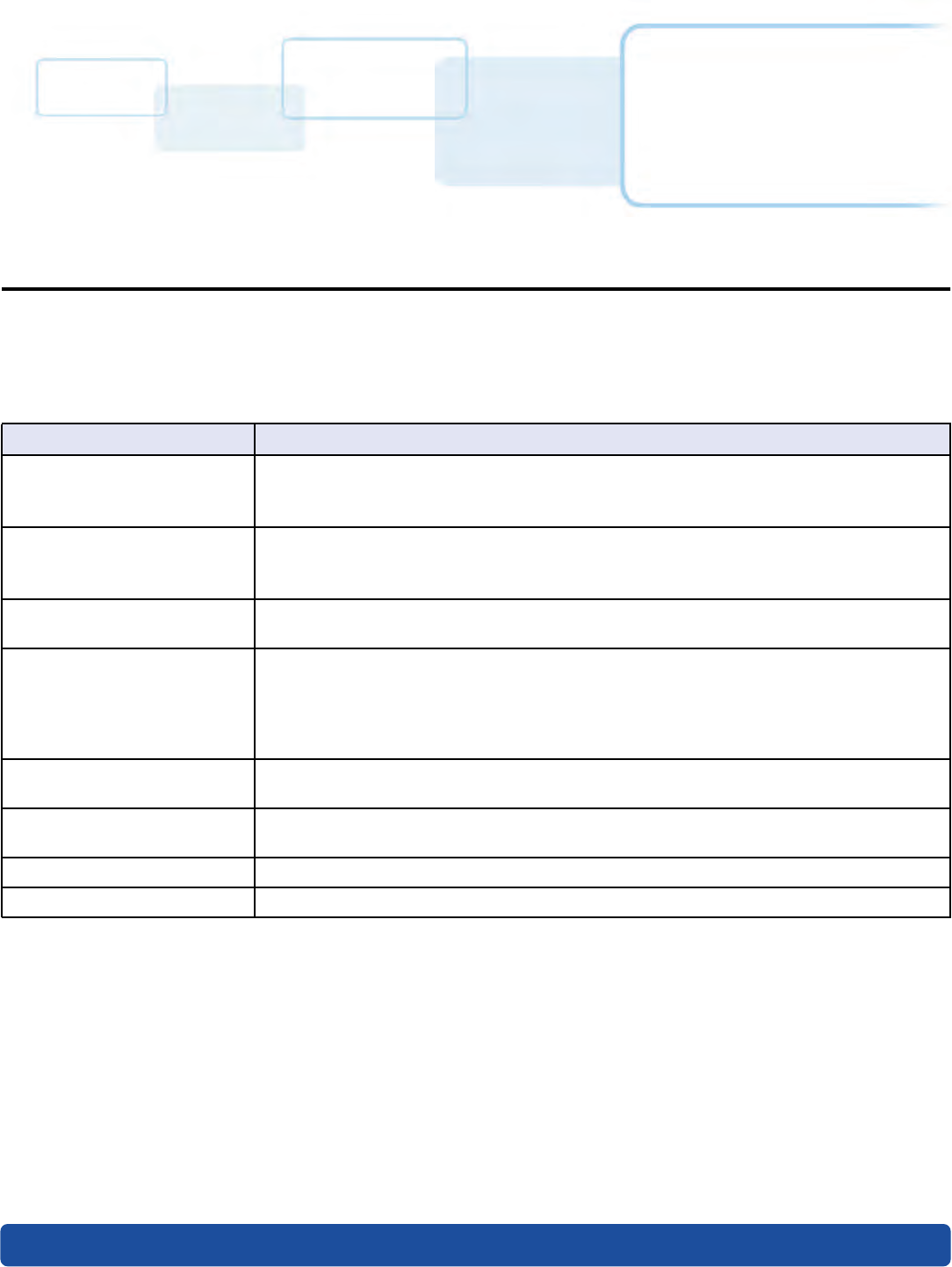
Section
1
September 2018 9
1 Specifications
This section provides specific information on the Regulatory Compliances, Agency Listings, Technical
Specifications and Functional Specifications for the HDP®6600 card printer.
1.1 Regulatory compliance
Agency Regulatory Compliance
UL The card printer is listed under UL 60950-1 (2nd edition) Information Technology
Equipment.
File Number: E145118
CSA The printer manufacturer has been authorized by UL to represent the card printer as
CSA Certified under CSA Standard C22.2 No. 60950-1-07 2nd edition
File Number: E145118
FCC The card printer complies with the requirements in Part 15 of the FCC rules for a Class
A digital device.
CE The card printer has been tested and complies with EN300-330, EN301-489,
EN60950-1:2006 + A11:2009 + A1:2010 +A12:2011 + A2:2013, EN50581, and EN62479.
Note: Based on this testing, the printer manufacturer certifies that the card printer
complies with the following of the European Community and has placed the CE
mark on the card printer: RED 2014/53/EU, ROHS 2015/863/EU
Emissions and Immunity
Standards
FCC Part 15 Class A, RSS-GEN, RSS 210, CNS 13438, EN55032 Class A, EN55024,
EN6100-3-2, EN6100-3-3, EN300-330, EN301-489, GB9254, GB17625
Safety Standards UL IEC 60950-1 (2nd edition), CSA C22.2 No. 60950-1-07 (2nd edition), EN60950-1,
GB4943, CNS14336
Additional Agency Listings CCC, BSMI, KC, EAC, BIS, MIC, RCM
Environmental GreenCircle Certified Energy Savings
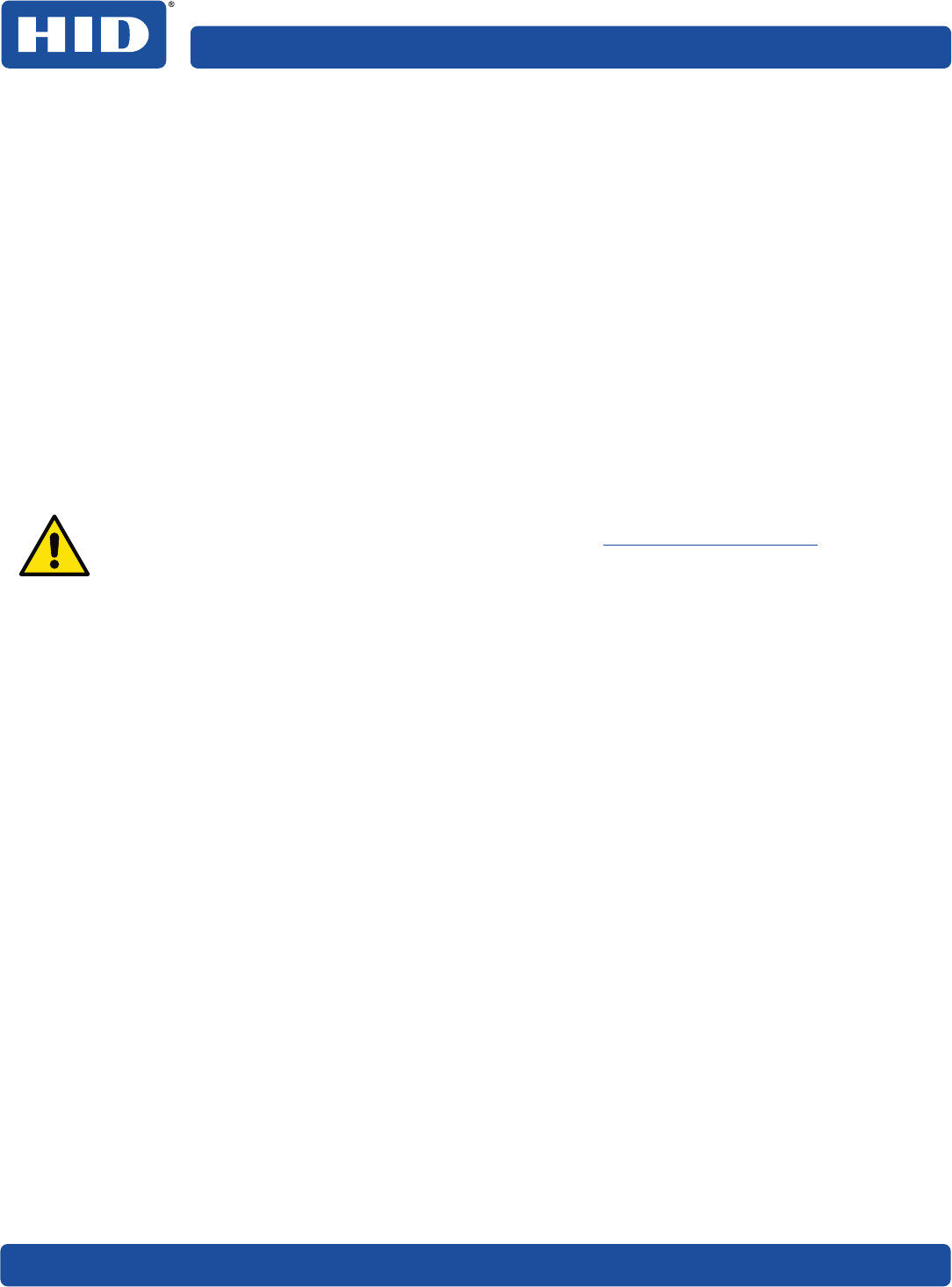
10 September 2018
Specifications PLT-02931, Rev. A.0
1.1.1 United States
This device complies with Part 15 of the FCC rules. Operation is subject to the following conditions:
႑This device may not cause harmful interference.
႑This device must accept any interference received, including interference that may cause undesired
operation.
Note: This equipment has been tested and found to comply with the limits for a Class A digital device,
pursuant to Part 15 of the FCC Rules. These limits are designed to provide reasonable protection
against harmful interference when the equipment is operated in a commercial environment. This
equipment generates, uses, and can radiate radio frequency energy and, if not installed and used in
accordance with the instruction manual, may cause harmful interference to radio communications.
Operation of this equipment in a residential area is likely to cause harmful interference; in which case,
correction of the interference is at the users expense.
Important: Changes or modifications to an intentional or unintentional radiator not expressly approved
by the party responsible for compliance could void the user’s authority to operate the
equipment.
1.1.2 Canada
This device complies with Industry Canada license-exempt RSS standard(s). Operation is subject to the
following two conditions: (1) this device may not cause interference, and (2) this device must accept any
interference, including interference that may cause undesired operation of the device.
Le présent appareil est conforme aux CNR d'Industrie Canada applicables aux appareils radio exempts de
licence. L'exploitation est autorisée aux deux conditions suivantes : (1) l'appareil ne doit pas produire de
brouillage, et (2) l'utilisateur de l'appareil doit accepter tout brouillage radioélectrique subi, même si le
brouillage est susceptible d'en compromettre le fonctionnement.
Warning:
This product can expose you to chemicals including Diisononyl Phthalate (DINP), which is known to the
State of California to cause cancer. For more information go to www.P65warnings.ca.gov.

September 2018 11
PLT-02931, Rev. A.0 Specifications
1.1.3 Taiwan
倢⨚㆞崜巘⚗㫋⃚⇝┮ᗁ⺓櫊榊㳮᧨槭倢峀♾᧨⏻⚇ᇬ⟕壮㒥∎䞷劔⧖ᗇ㈦㝔呹帙
ᕡ櫊ᗁᇬ┯⮶┮ᗁ㒥帙ᕡ☮岼岗⃚䔈㊶♙┮厌ᇭ⇝┮ᗁ⺓櫊榊㳮⃚∎䞷ᗇ㈦㈀檎歪
咹⸘⏷♙㞍⚗㽤抩≰᧷倢䤋䚍㦘㞍䚍廰㣑᧨㑘ᙗ☂⋫䞷᧨₵㟈⠓咂䎰㞍㣑㡈
㈦儋儛∎䞷ᇭⓜ檔⚗㽤抩≰᧨㖖∬榊≰㽤尞⸩⇫㯼⃚䎰偩榊抩≰ᇭ⇝┮ᗁ⺓櫊榊㳮
檗㉜♦⚗㽤抩≰㒥ぴ㯼ᇬ䱠⸇♙携ᘡ䞷榊㽱ᙧ⺓㊶榊㳮岼⌨⃚㞍ᇭ
1.1.4 Japan
ሶቑ孔函ቒ偞╨䦐ቑ⨚㆞㖖⸩ት♦ሴሧቡሼᇭ
偞╨䦐㖖⸩䟹⚆ቒ䶻 $&[[[[[ ⚆ቊሼ
㦻完❐ቒ榊㽱ት∎䞷ሺቂ 5),'㳮⣷ቑ崼ቢ♥ቭዘ㦇ሰ手ቢ孔函ቊሼᇭ
ቀቑቂቤ∎䞷ሼቮ䞷抣ዘ⫃㓏ቫቆቒᇬ◊䣑㳮⣷㈀檎ትራቮ㋟ቯሯሥቭቡሼ
1.1.5 Korea
넩韥韥鱉꽺ꓩ끞 $ 鞾 놹녅볁놶뼞韥韥ꈑ볅ꎙ녅鿅鱉ꩡ끞녅鱉넩뇅냹늱넍뼍겑韭ꗉꄱꐥ 閵뇊뀭넍덵꾢꾅
ꩡ끞뼍鱉阸냹ꑞ놶냱ꈑ
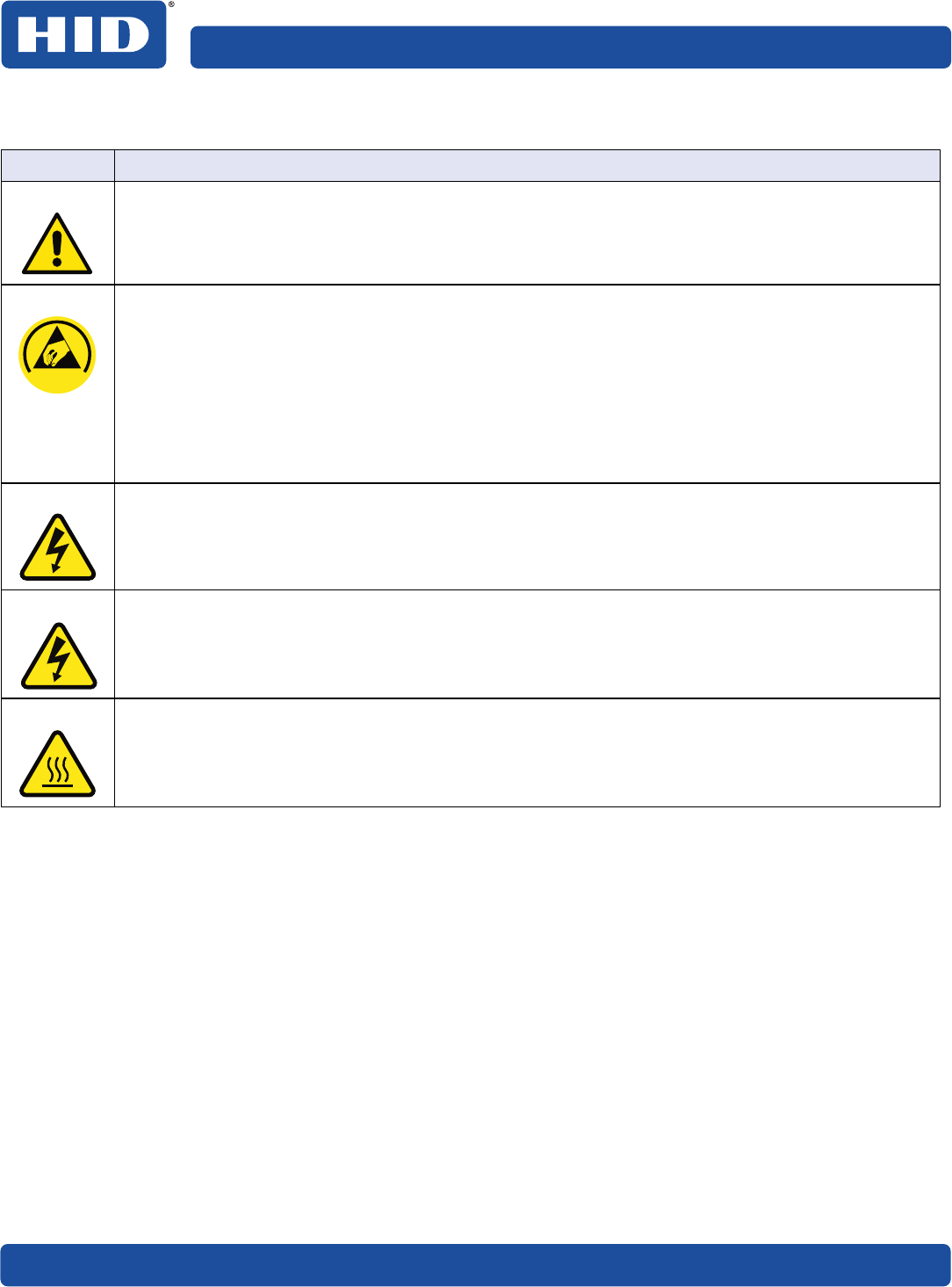
12 September 2018
Specifications PLT-02931, Rev. A.0
1.2 Safety messages-United States
Symbol Critical Instructions for Safety Purposes
Danger: Failure to follow these guidelines results in personal injury or death. To prevent personal injury or death,
reference the following safety messages before performing an operation:
႑Always remove the power cord prior to performing repair procedures, unless otherwise specified.
႑Ensure only qualified personnel perform these procedures.
ESD: This device is electro statically sensitive. Damage to the device may occur if it is exposed to static
electricity discharges. To prevent damage, reference the following safety messages before performing
an operation:
႑Observe all established Electrostatic Discharge (ESD) procedures while handling cables in or
near the circuit board and printhead assemblies.
႑Always wear an appropriate personal grounding device.
႑Always remove the ribbon and cards from the printer before making any repairs, unless otherwise
specified.
႑Remove jewelry and thoroughly clean hands before working on the printer.
Caution:
This symbol warns of an electrical hazard that could result in personal injury or death.
Caution:
For safety purposes, do not use Ethernet for a direct connection outside of the building.
Warning:
This symbol warns of a hot surface that could result in personal injury.
E S D
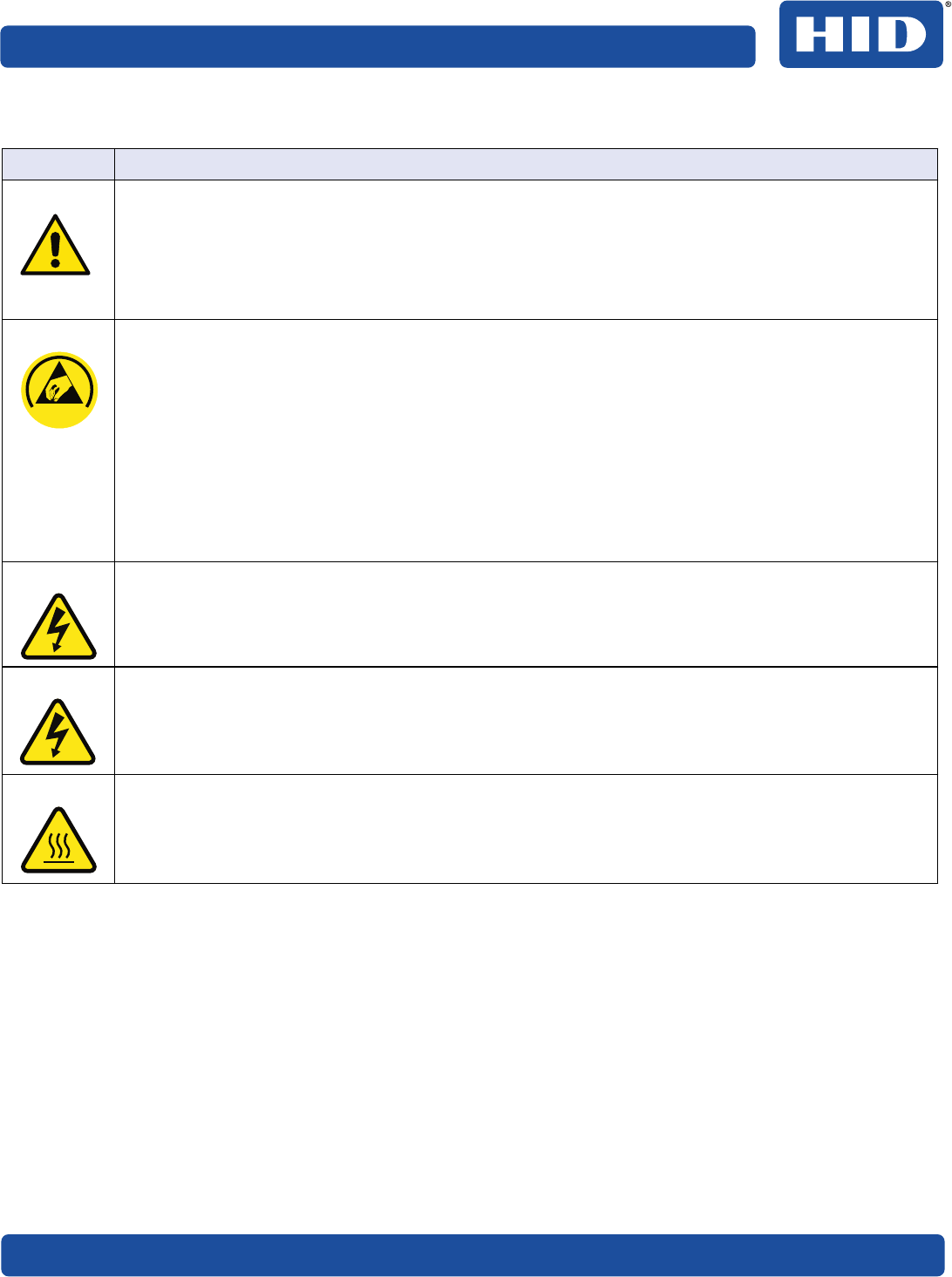
September 2018 13
PLT-02931, Rev. A.0 Specifications
1.3 Safety messages-French Canada
Symbol Instructions critiques visant la Sécurité
Danger: Si ces directives ne sont pas suivies les résultats peuvent être des lésions corporelles ou la mort.
Pour éviter des lésions corporelles ou la mort:
႑Rapportez-vous aux avis suivants de sécurité avant de procéder à une opération.
႑Retirez toujours le câble d’alimentation avant d’effectuer des procédures de réparation, sauf
spécification contraire.
႑Assurez-vous qu’uniquement des personnes qualifiées réalisent des procédures.
ESD: Ce dispositif est sensible à l’électricité statique. Il peut souffrir des dommages s’il est exposé à des
décharges électrostatiques.
Pour éviter des dommages:
႑Rapportez-vous aux messages suivants avant de procéder à une opération.
႑Suivez toutes les procédures de Décharges Electrostatiques (ESD) en vigueur durant le
maniement des câbles dans ou à proximité des Ensembles de Cartes de Circuit Imprimé et Tête
d’Impression.
႑Portez toujours un dispositif de mise à la terre personnelle appropriée.
႑Retirez toujours le ruban et les Cartes de l’Imprimante avant d’effectuer toute réparation, sauf
spécification contraire.
႑Retirez tous bijoux et lavez soigneusement vos mains avant de travailler à l’Imprimante.
Attention:
Ce symbole est un avis de péril électrique passible de résulter en lésion corporelle ou mort.
Attention:
Pour des motifs de sécurité, n’utilisez pas Ethernet pour une connexion directe hors du bâtiment.
Warning:
This symbol warns of a hot surface that could result in personal injury.
E S D
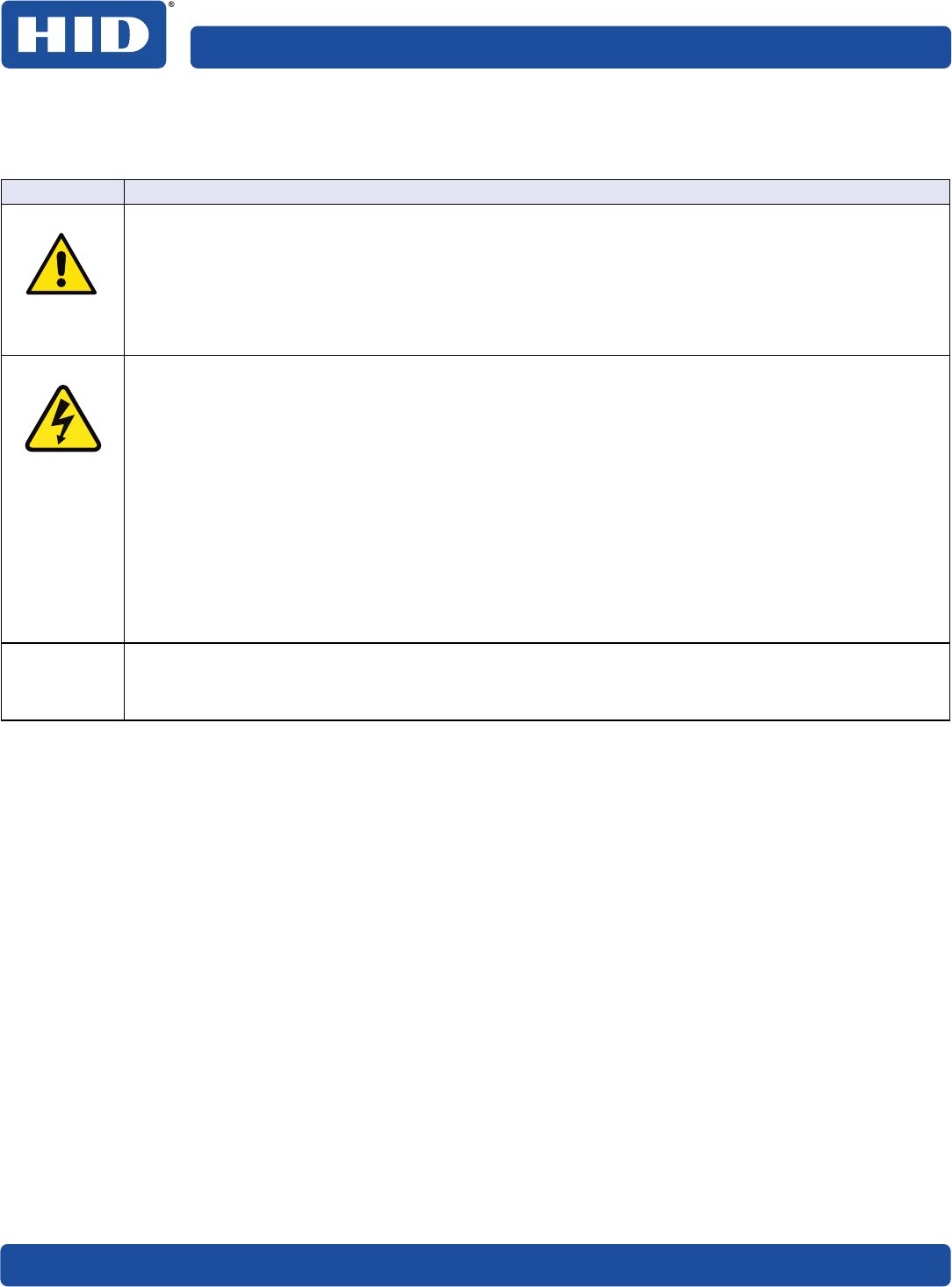
14 September 2018
Specifications PLT-02931, Rev. A.0
1.4 Safety messages-Taiwan
僐浣₼㠖⺓櫊䤋⺓♙⸘⏷㖖ⅳ⸘⏷岙㋾᧤⺞㉒㴱㩴᧥
㲨岧 摜尐䤓⸘⏷ℚ檔崹㢝
☀椹 㦹㖘䏶崹㢝⸘孬♾厌抯㒟ⅉ❰⍆ℰᇭ
⦷♾厌䞱䞮䇪⦷⸘⏷⟞櫛䤓⦿㡈㦘巵䯉㲨岧ᇭ
᧤Ⱁふ⦥㓏䯉᧥ᇭ
䍉ℕ挎⏜ⅉ❰⍆⹂᧨⦷拁嫛㦘㷳巵䯉㲨岧䤓㝜⇫ⓜ᧨嵚⏗♒劒⸘⏷彖岙㙟䯉ᇭ
䍉ℕ挎⏜ⅉ❰⍆⹂᧨⦷㼡㦘䔈⒴崹㢝䤓㍔㽐ₚ᧨≽䚕ⓜ嵚桫㘘榊䄟栚桫ᇭ
⺞㉒ 㷳岼⌨⺜槫榊㈗㟞㎮ᇭⰑ㨫♦Ⓙ槫榊㟍榊᧨岼⌨㦒㚜⭭ᇭ
⦷♾厌䞱䞮䇪⦷槫榊⸘⏷⟞櫛䤓⦿㡈㦘巵䯉㲨岧ᇭ
᧤Ⱁふ⦥㓏䯉᧥ᇭ
䍉ℕ挎⏜㚜⭭岼⌨᧨⦷拁嫛㦘㷳巵䯉㲨岧䤓㝜⇫ⓜ᧨嵚⏗♒劒⸘⏷彖岙㙟䯉ᇭ
䍉ℕ挎⏜㚜⭭岼⌨᧨⦷㘡㟍榊恾㨎✛◿Ⓠ檼勾⚗孬函孰槱㒥棓扠䤓榊偩㣑᧨嵚㽷㎞屏㓏㦘䤓槫榊㟍榊岼
⌨ᇭ
䍉ℕ挎⏜㚜⭭岼⌨᧨嵚椷㣑⇸㓃⚗拸䤓㘴⦿孬函᧤㹣Ⱁ᧶㓚古ₙ㓃⊚浧❐役䤓㘴⦿㓚古ヅⅴ⏜♦Ⓙ♾厌
䤓⍆⹂᧥ᇭ
䍉ℕ挎⏜㚜⭭岼⌨᧨Ⱁ㨫㼡㦘䔈㸙崹㢝᧨⦷⋩↊⇤≽䚕ⓜ᧨嵚♥ₚ◿嫷㳮ₙ䤓唁ヅ✛◰ᇭ
䍉ℕ挎⏜㚜⭭岼⌨᧨⦷∎䞷◿嫷㳮⃚ⓜ᧨嵚㛧ₚ㒡㖖✛㓚ₙ殍❐᧨₵Ⅳ便䂔㾦㓚ₙ䤓㽈厑ᇭ
巵⛙∎䞷劔
抨㢾䟁櫭䤓彖岙䞱❐᧨⦷⻔⇞䤓䜿⬒₼∎䞷㣑᧨♾厌㦒抯㒟⺓櫊㞍᧨⦷抨䲽㍔㽐ₚ᧨∎䞷劔㦒嬺尐㻑㘰
♥㩟K拸䠅䤓⺜䷥㘹㡌
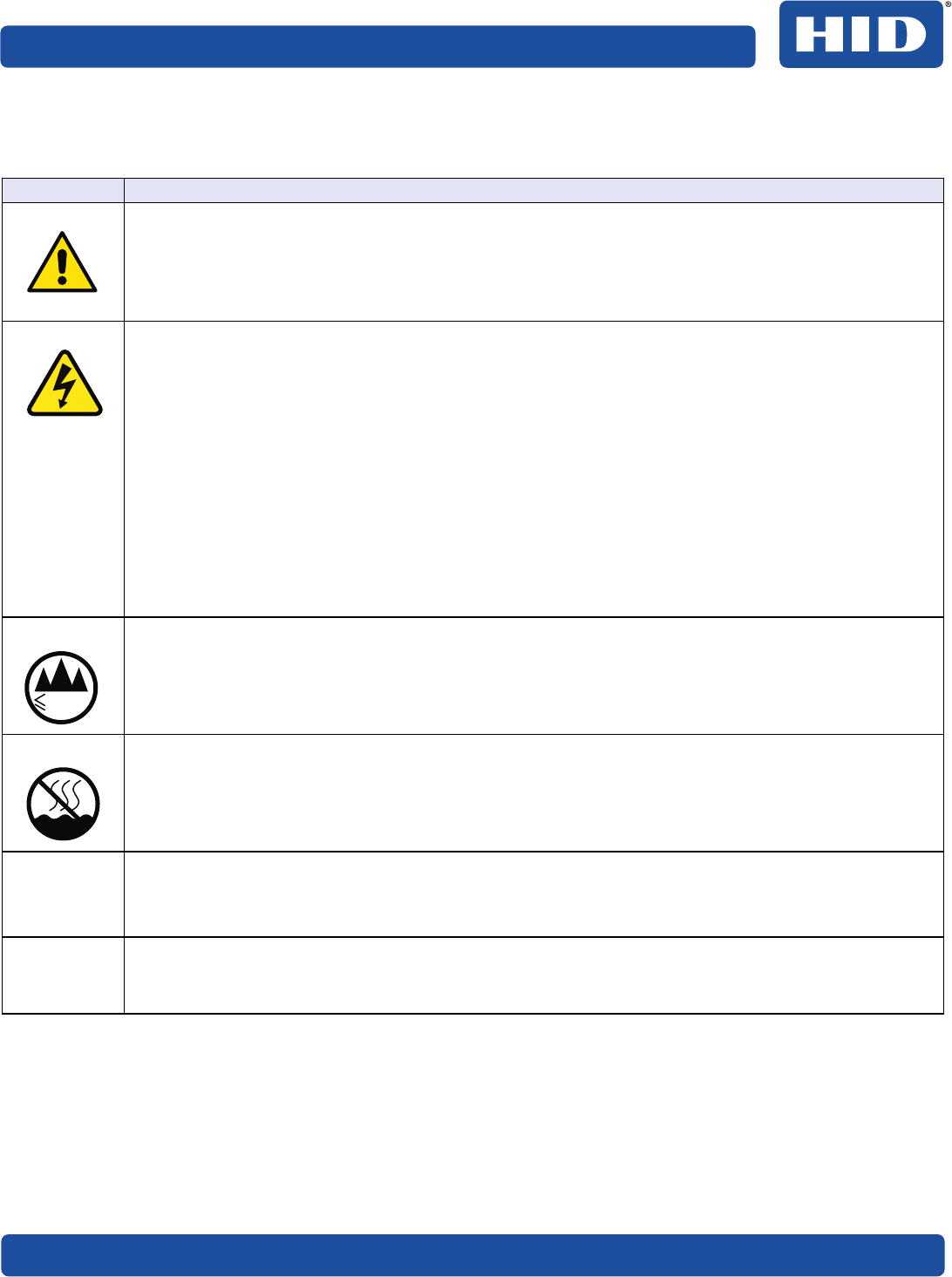
September 2018 15
PLT-02931, Rev. A.0 Specifications
1.5 Safety messages-China
⸘⏷䀗㋾᧤庆Ⅳ兕梔床᧥
䶵⚆ 䀘♙⸘⏷䤓摜尐扖䲚
☀棸 Ⱁ㨫ₜ挄㈹扨K⸘孔㖖◦扪嫛㝜⇫᧨♾厌↩⺋咃摜↳᧨䞩咂㸊ℰᇭ
♾厌ㆤ♠⸘⏷桽欧䤓≰㋾䟀巵⛙䶵⚆᧤Ⱁふ⦍㓏䯉᧥㧴嫷䯉ᇭ
ℕ䫽≬ⅉ愺⸘⏷᧨⦷㓶嫛ⓜ槱サ㦘㷳䶵⚆䤓㝜⇫⃚ⓜ᧨庆⏗梔床ₚ槱䤓⸘⏷䀗㋾ᇭ
ℕ䫽≬ⅉ愺⸘⏷᧨棳槭♵㦘屓⸩᧨⚵⒨⦷㓶嫛冃≽扖䲚ⓜ᧨ⱚ兗ㄣ㠼䟄䄟ᇭ
⺞㉒ 㷳幍槨䟄㟞㎮幍ᇭⰑ㨫㥃槁⦷槨䟄䟄㿐ₚ᧨♾厌↩㗮⧞幍ᇭ
♾厌ㆤ♠槨䟄⸘⏷桽欧䤓≰㋾䟀巵⛙䶵⚆᧤Ⱁふ⦍㓏䯉᧥㧴嫷䯉ᇭ
ℕ棁㷱幍㒥⅚德♦㗮᧨⦷㓶嫛ⓜ槱サ㦘㷳䶵⚆䤓㝜⇫⃚ⓜ᧨庆⏗梔床ₚ槱䤓⸘⏷䀗㋾ᇭ
ℕ棁㷱幍㒥⅚德♦㗮᧨庆⦷⮓䚕䟄恾㨎✛㓢◿⯃捷ↅ₼㒥棓扠䤓䟄冕㢅᧨挄⸗㓏㦘屓⸩䤓槨䟄㟍䟄
(6'扖䲚ᇭ
ℕ棁㷱幍㒥⅚德♦㗮᧨庆ⱚ兗⇸サ抑㇢䤓₹ⅉ㘴⦿幍᧤√Ⱁ᧨め㘴⦿挎⏜⒉䘿䇫⦷㗮⧞䤓浧德摞古
サ᧥ᇭ
ℕ棁㷱幍㒥⅚德♦㗮᧨棳槭♵㦘屓⸩᧨⚵⒨⦷㓶嫛↊⇤冃≽扖䲚ⓜ᧨ⱚ兗ㄣ⺕唁サ✛幐◰㓢◿㧉⒕
䱊ᇭ
ℕ棁㷱幍㒥⅚德♦㗮᧨⦷㝜⇫㓢◿㧉ⓜ᧨庆♥ₚ㓚㖖✛㓚ₙ䤓䙯⸬毿䓸᧨ㄅ⺕㓚ₙ䤓㽈䂜✛㻰䂜㈊ㄤ
䂔㾦ᇭ
⅔抑䞷ℝ䀆㕣 Pⅴₚ⦿◉⸘⏷∎䞷
Use only at altitudes not more than 2000m above sea level.
⅔抑䞷ℝ槭䍼サ㺣⊨㧰ↅₚ⸘⏷∎䞷
䘾⬒≬㔳 ₼⦌ 5R+6
䘾≬∎䞷㦮㢾⪉ℝ㦻ℶ❐䞷ℝ┭⏻䘾⬒ᇭ
Environmental Protection Use Period is based on the product being used in an office environment.
巵⛙᧶
㷳 $ 儶ℶ❐᧨⦷䞮㿊䘾⬒₼᧨年ℶ❐♾厌↩抯㒟㡯兎䟄㓿ᇭ⦷扨䱜㍔⑄ₚ᧨♾厌榏尐䞷㓆⺈␅㓿摖
♥♾嫛䤓㘹㡌ᇭ
2000m
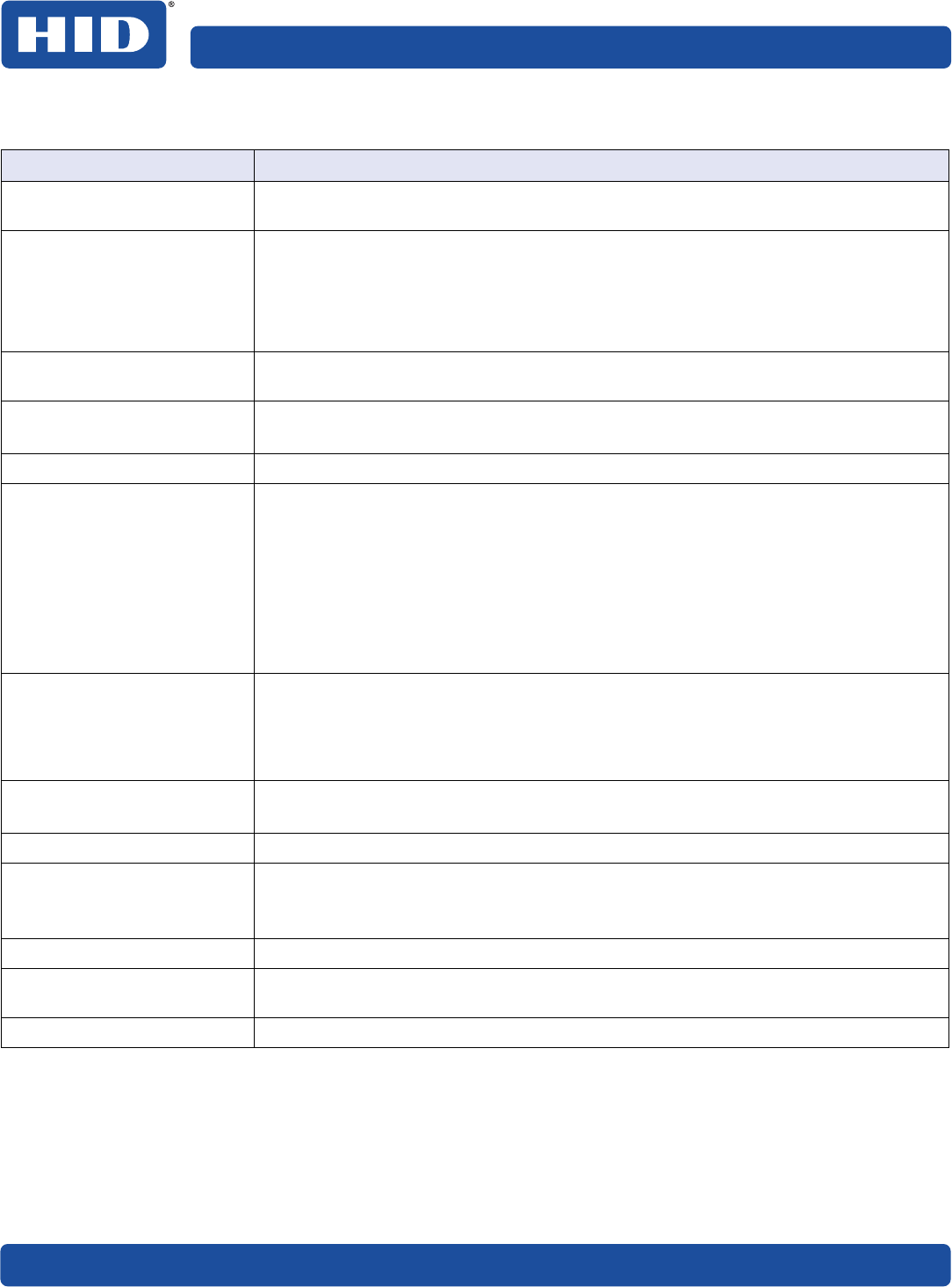
16 September 2018
Specifications PLT-02931, Rev. A.0
1.6 Technical specifications
Component Description
Card cleaning Replaceable cleaning roller (included with each print ribbon). Recommended cleaning
cycle after 2,000 cards.
Card materials and types ႑Press polished PVC
႑Composite (PET/PVC with PVC as an outer layer)
႑Laminated PVC (credit card construction)
႑100% PETG
႑100% Polycarbonate
Card sizes supported These card printers accept standard CR-80 sized cards (3.370" L x 2.125" W / 85.6 mm
L x 54 mm W) with a thickness of 30 mil.
Dimensions (H x W x D) Printer: 11.50" x 14.50" x 12" (292 mm x 368 mm x 305 mm)
Printer with dual-sided module: 11.50" x 19.75" x 12" (292 mm x 501 mm x 305 mm
Display OLED graphical display
Encoding options Magnetic stripe:
႑ISO compliant, dual high/low coercivity, Tracks 1, 2 and 3
႑JIS II mag
႑Custom and raw
Contact and contactless smart card:
႑Contact—OMNIKEY® 5122
႑Contactless—OMNIKEY 5127 CK Mini
႑Programmer—OMNIKEY 5127 CK SI
HID Global certified supplies Note: The HDP6600 printer requires highly specialized print ribbons to function
properly. To maximize printer life, reliability, printed card quality and durability,
you must use only HID Global certified supplies. For this reason, your HID Global
warranty is void, where not prohibited by law, if you use non-HID Global certified
supplies. To order additional materials, please contact your authorized reseller.
Hopper capacity—input ႑100 cards, 30 mil—standard hopper
႑200 cards, 30 mil—dual-input hopper (optional)
Hopper capacity—output 200 card output hopper capacity, 30 mil
Interface ႑USB 2.0 (high speed)
႑Ethernet with internal print server
႑Interfacing information for E-card options
HDP film options Clear film, 1,500 prints
HDP film storage
temperature
77° F (25° C) or lower for no longer than 1.5 years.
Memory 1 GB
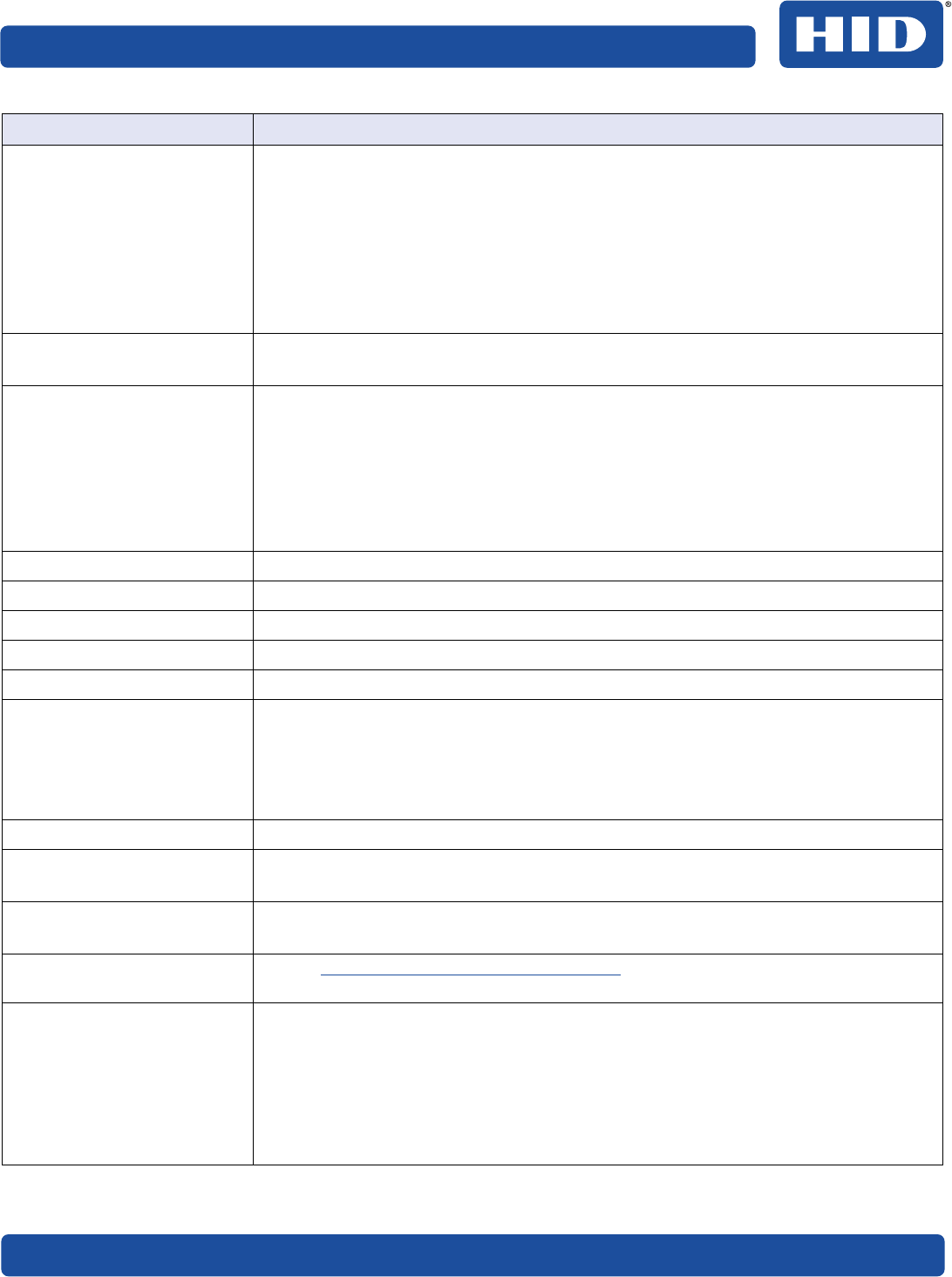
September 2018 17
PLT-02931, Rev. A.0 Specifications
Microsoft Windows
compatibility
႑Windows 7 (32- and 64-bit)
႑Windows 8 / 8.1 (32- and 64-bit)
႑Windows 10 (32- and 64-bit)
႑Windows Server 2008 R1 (32- and 64-bit)
႑Windows Server 2008 R2 (64-bit only)
႑Windows Server 2012
႑Windows Server 2012 R2
႑Windows Server 2016
Operating conditions Operating temperature: 65 to 90° F (18 to 32° C)
Humidity: 20 to 80% non-condensing
Options ႑Dual-sided module
႑Magnetic stripe encoder
႑Contact encoder
႑Contactless encoder
႑Programmer encoder
႑Printer cleaning kit
႑Flattener
Print area Over-the-edge on CR-80 cards
Print colors Up to 16.7 million and 256 shades per pixel
Print method HDP dye-sublimation / resin thermal transfer
Print nodes HDP6600 DPI print head only
Print resolution 600 DPI
Print ribbon options Prints or images:
႑YMCK*—750 prints
႑YMCKK*—600 prints
*Indicates the ribbon type and the number of ribbon panels printed.
Key: Y = Yellow, M =Magenta, C = Cyan, and K = Resin Black
Print speed YMCK—Up to 230 cards per hour/16 seconds per card
Power source voltage,
current & frequency
Supply voltage / Current: 100 to 240V AC, 3.5A maximum
Supply frequency: 50 Hz and 60 Hz
Ship weight Printer: 20.20 lbs (9.16 kg)
Printer with dual-sided module: 24.50 lbs (11.11 kg)
System requirements Access https://www.support.microsoft.com and search for your Microsoft Windows
OS system requirements.
Warranty Printer: Three-year (one-year On-Call Express, US only)
႑Three-year factory warranty
႑Covers parts and depot repair
႑First year On-Call-Express (loaner printer US only)
႑Second year On-Call-Express available for a fee. This must be purchased before
the first-year On-Call-Express expires.
Printhead: Lifetime; unlimited pass with HID Global certified card
Component Description

Specifications PLT-02931, Rev. A.0
This page is intentionally left blank.
18 September 2018
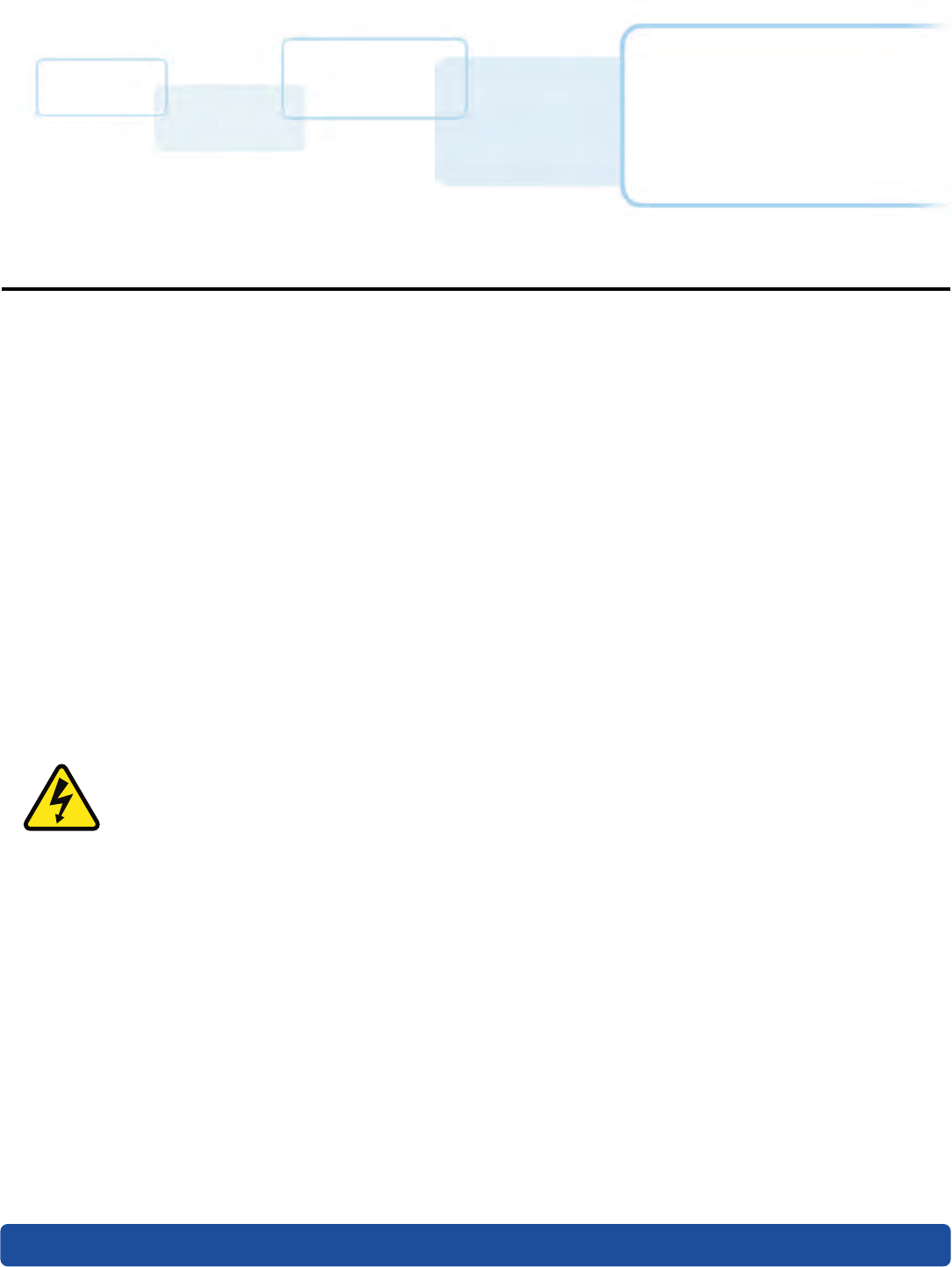
Section
2
September 2018 19
2 Setup and installation
This section describes the setup and installation for the HDP®6600 card printer.
2.1 Selecting a good location
The following guidelines help to ensure optimal printing performance:
႑Place the unit in a location with adequate air circulation to prevent internal heat buildup.
႑Use the dimensions of the printer as a guideline for the minimum clearances to the unit.
႑Allow for adequate clearance in front of the unit to accommodate the unit with its covers open.
႑Do not install the unit near heat sources such as radiators or air ducts or in a place subject to direct
sunlight, excessive dust, mechanical vibration, or shock.
2.2 Moisture condensation
If the unit is brought directly from a cold to a warm location or is placed in a a very damp room, moisture may
condense inside the unit. Should this occur, print quality may not be optimal.
Leave the unit unplugged in a warm, dry room for several hours before using to allow any moisture to
evaporate.
Caution: For safety purposes, Ethernet is not intended for a direct connection outside of the building.
Attention: Pour des raisons de sécurité, Ethernet n'est pas conçu pour une connexion directe à l'extérieur
du bâtiment.
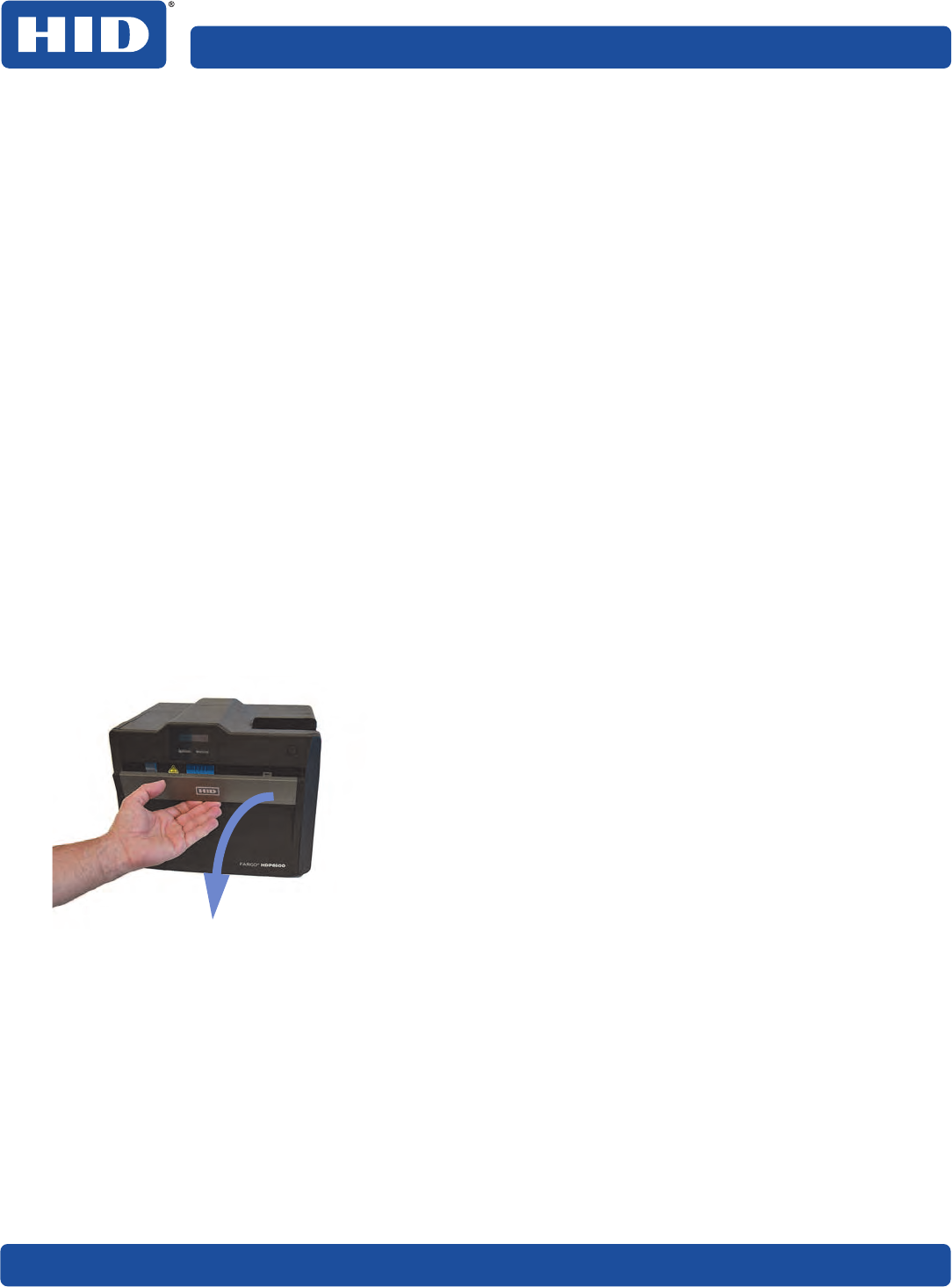
20 September 2018
Setup and installation PLT-02931, Rev. A.0
2.3 Unpacking and inspection
While unpacking the printer, inspect the carton to ensure that damage did not occur during shipping.
Make sure that all supplied accessories are included with the unit:
႑US/EU power cable
႑Card input cartridge
႑Card output hopper
႑Ferrite
႑USB cable
Make sure you have these accessories that are supplied separately:
႑HDP film
႑Print ribbon
႑Cards
2.4 Installing the HDP film
FARGO® High Definition printers require highly specialized supplies to function properly. This printer uses a
refillable HDP film drawer. To maximize the printer durability, reliability and printed card quality, you must use
only FARGO-certified supplies. If not using FARGO-certified supplies, your FARGO warranty is void, where
not prohibited by law.
1. Open the front door.
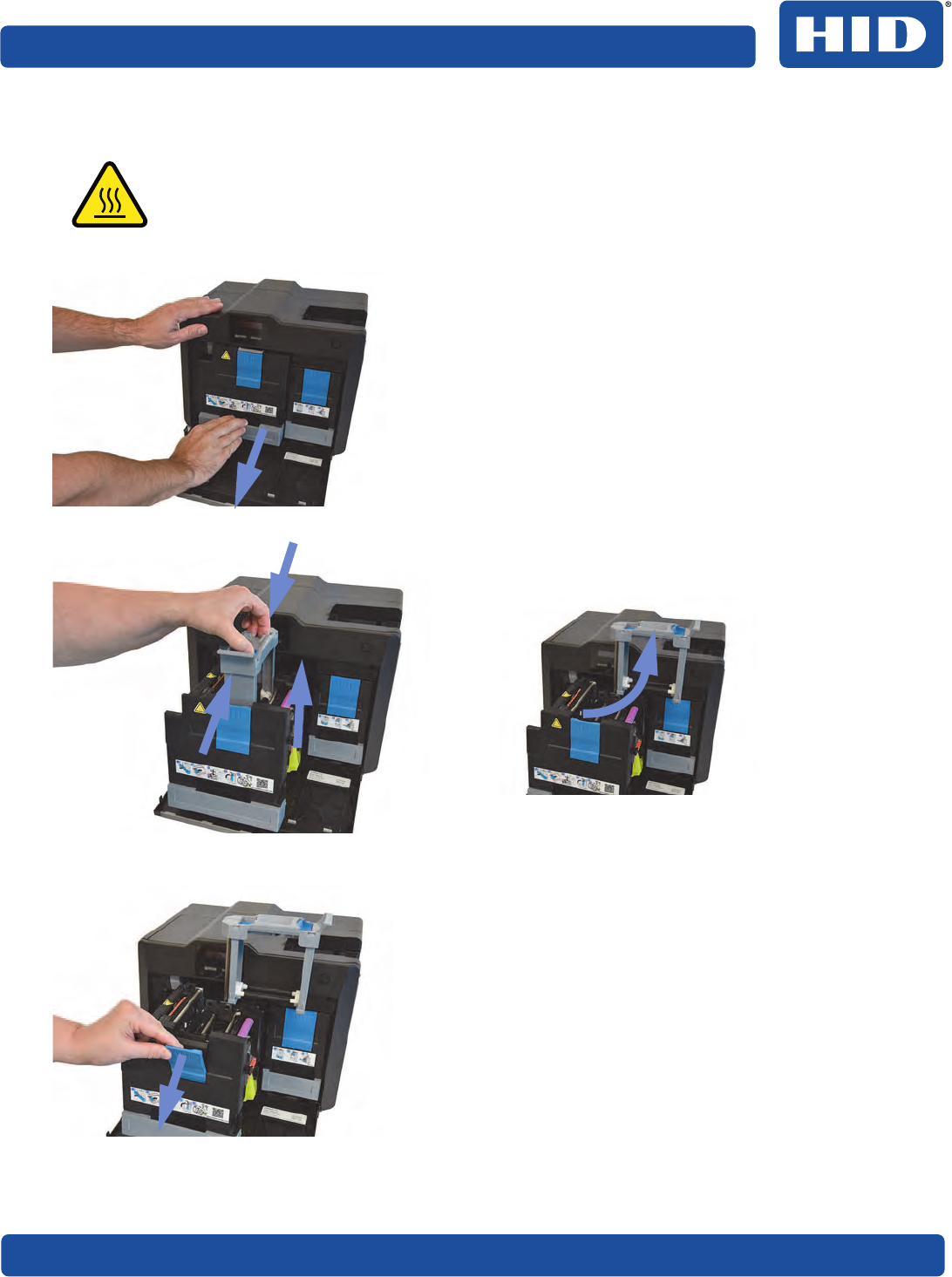
September 2018 21
PLT-02931, Rev. A.0 Setup and installation
2. Slide out the HDP film drawer by pulling on the gray handle.
3. Unlatch and raise the accumulator unit. Twist the accumulator unit 90° to the right.
4. Pull down the HDP film loading handle.
Caution: Be careful not to touch the hot holler surface identified with this symbol.
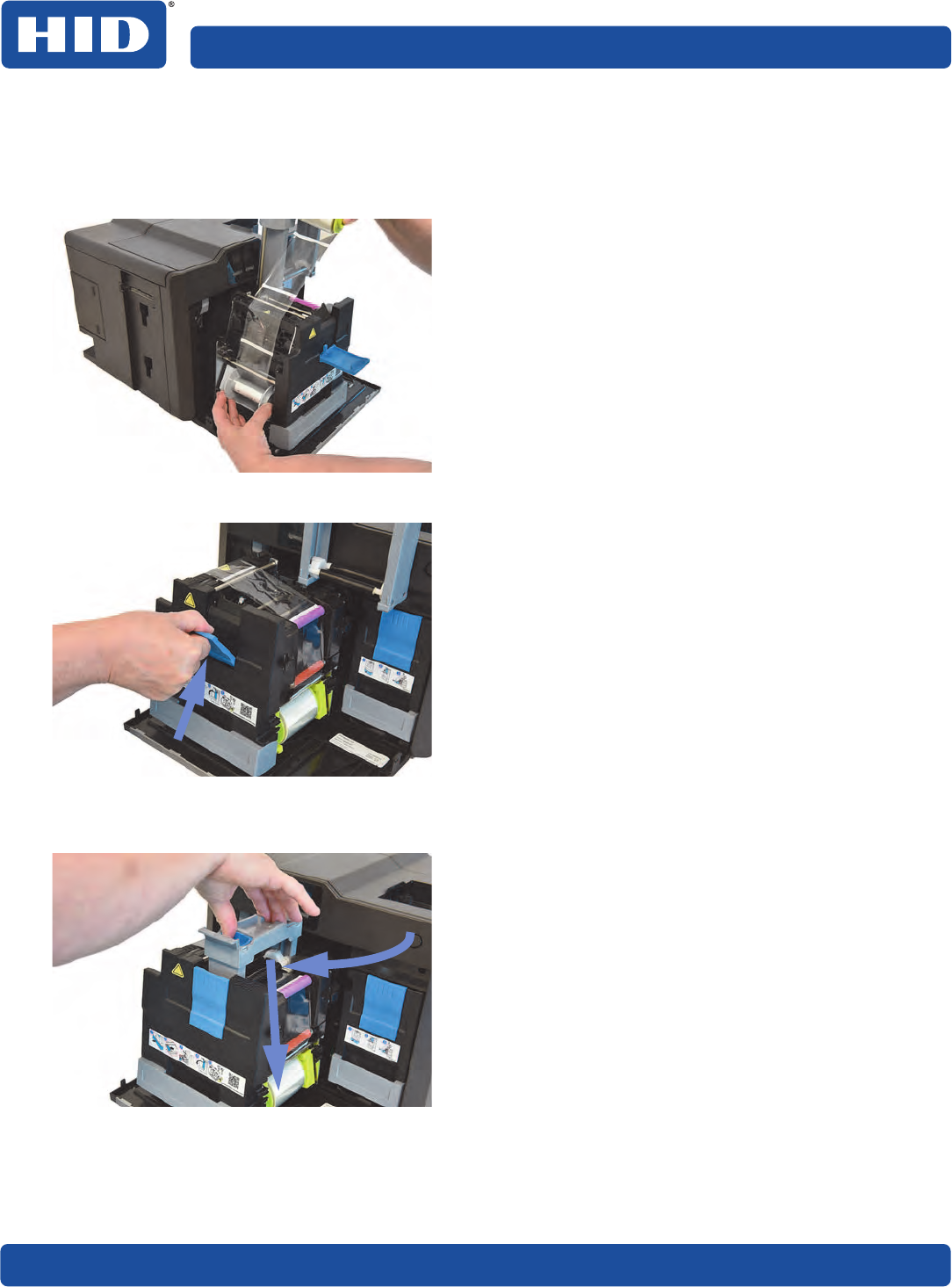
22 September 2018
Setup and installation PLT-02931, Rev. A.0
5. Load the HDP film, ensuring that each spool is correctly fitted to the corresponding color cartridge, and
the film is not loose.
Note: Used film should have used panels to the left of the purple roller and new panels to the right of
the purple roller.
6. Push up the HDP film loading handle.
7. Twist the accumulator unit 90 to the left. Push down in the center of the accumulator unit until it clicks
into place.
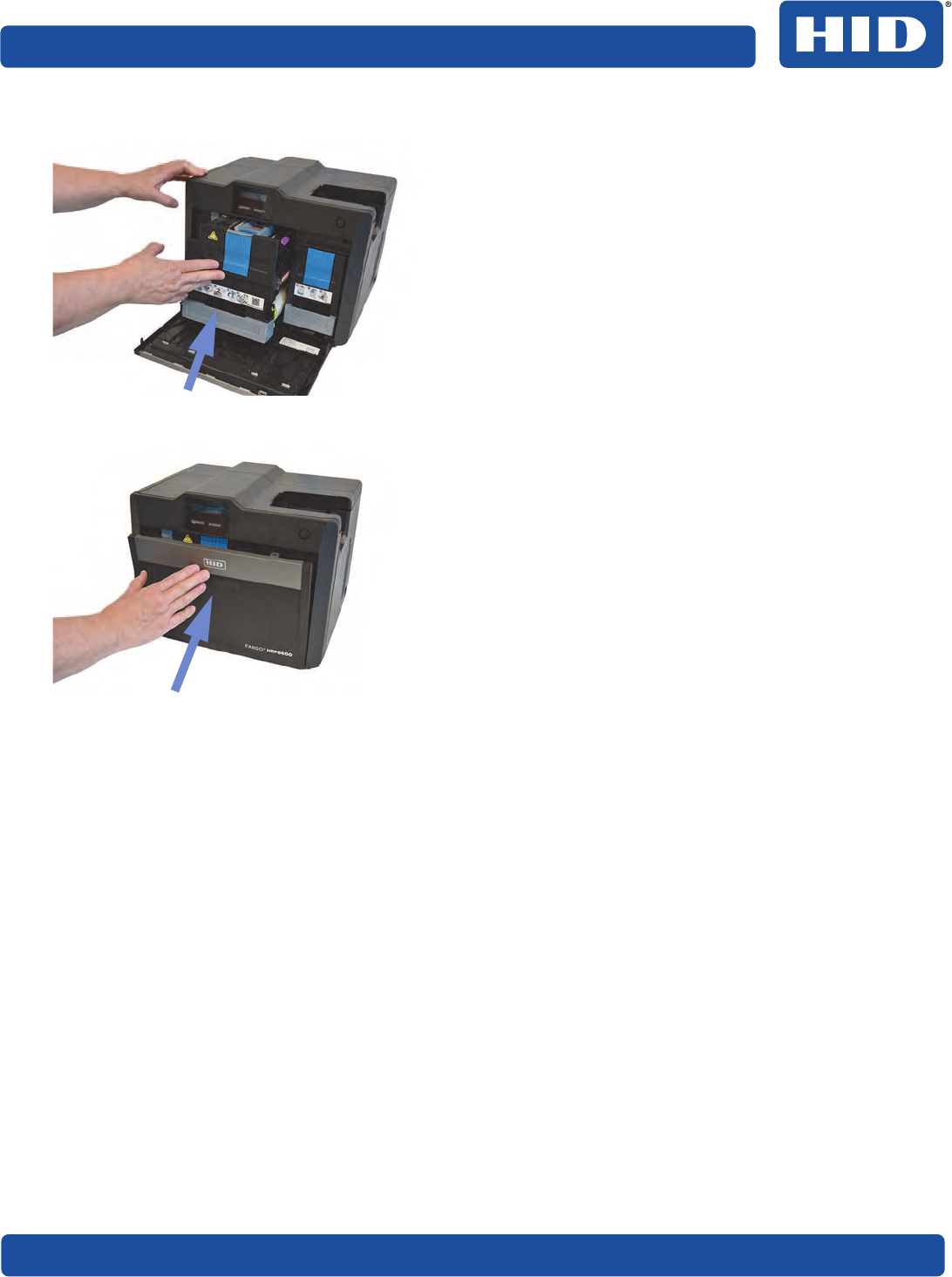
September 2018 23
PLT-02931, Rev. A.0 Setup and installation
8. Slide the HDP film drawer in until the gray handle clicks/latches.
9. Close the printer front cover.
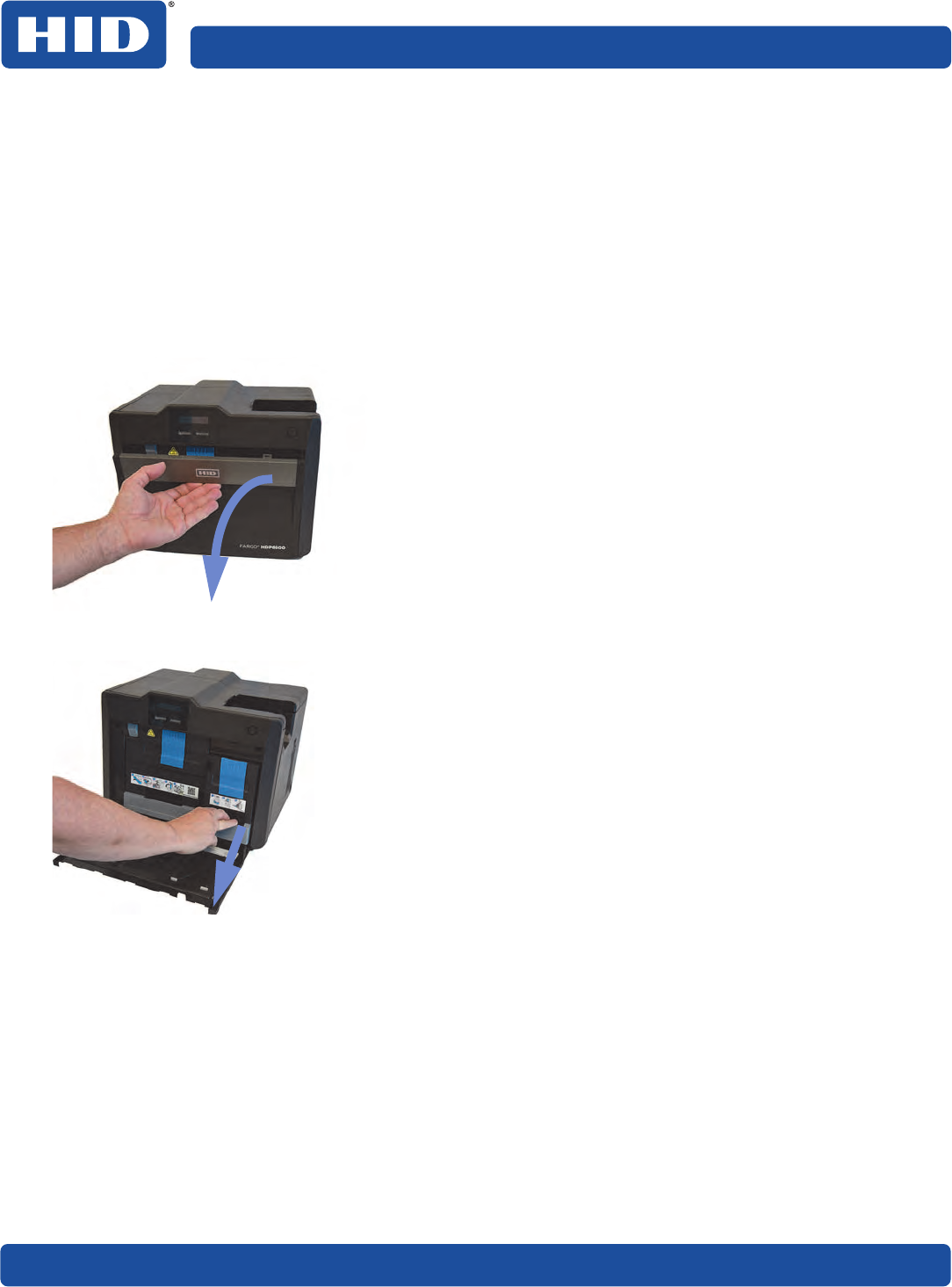
24 September 2018
Setup and installation PLT-02931, Rev. A.0
2.5 Installing the print ribbon
Important: Do not connect the power supply or communication cable (USB or Ethernet) at this stage.
FARGO High Definition printers require highly specialized supplies to function properly. This printer uses a
refillable ribbon drawer. To maximize the printer durability, reliability and printed card quality, you must use
only FARGO-certified supplies. If not using FARGO-certified supplies, your FARGO warranty is void, where
not prohibited by law.
Each print ribbon includes a replaceable cleaning roller. The recommended cleaning cycle is after every 2,000
cards printed.
1. Open the printer front cover.
2. Slide out the ribbon drawer by pulling on the gray handle.
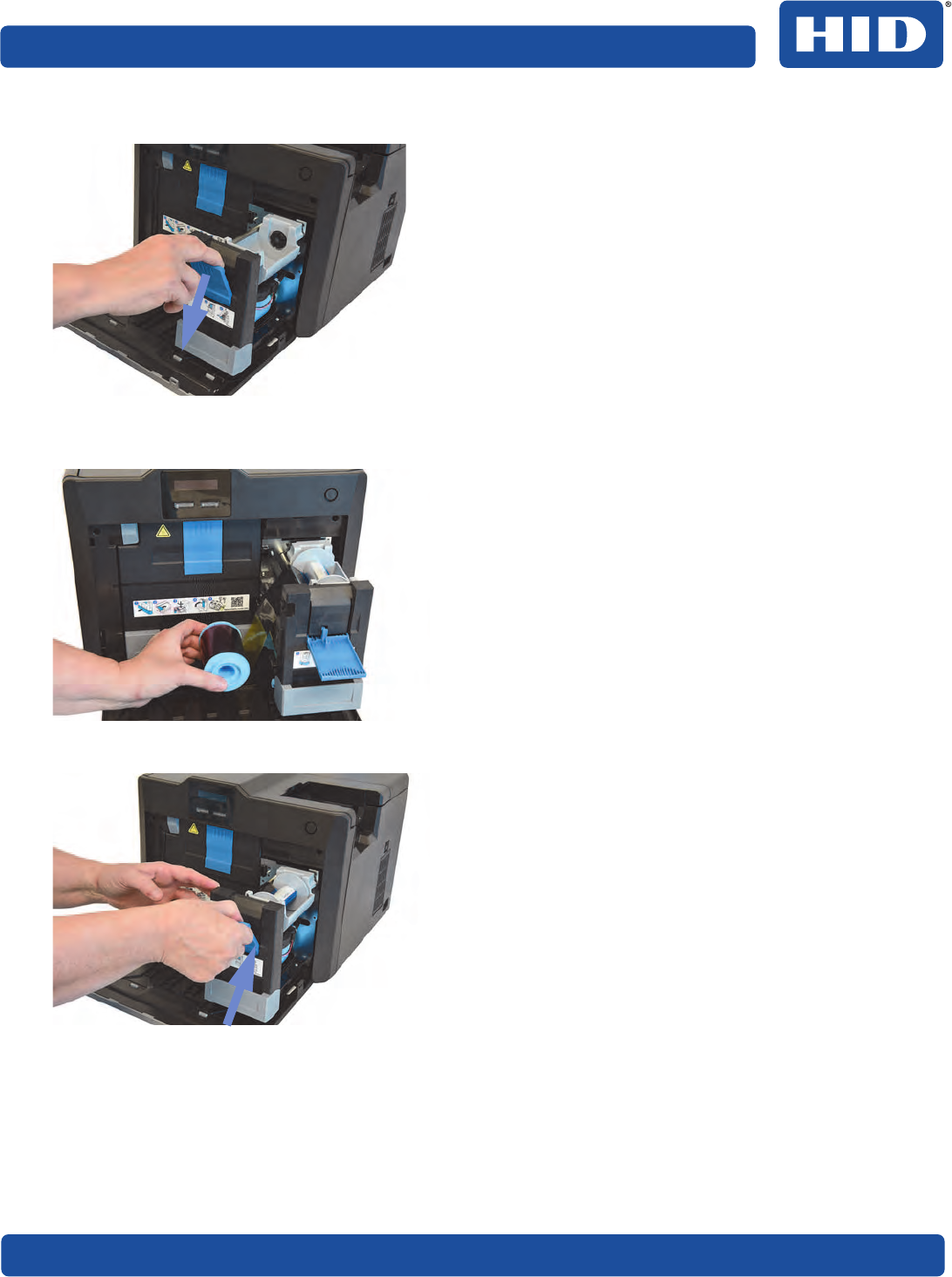
September 2018 25
PLT-02931, Rev. A.0 Setup and installation
3. Pull down the loading handle.
4. Load the ribbon, ensuring that each spool is correctly fitted to the corresponding color cartridge, and
the ribbon is not loose.
5. Push up the ribbon loading handle.
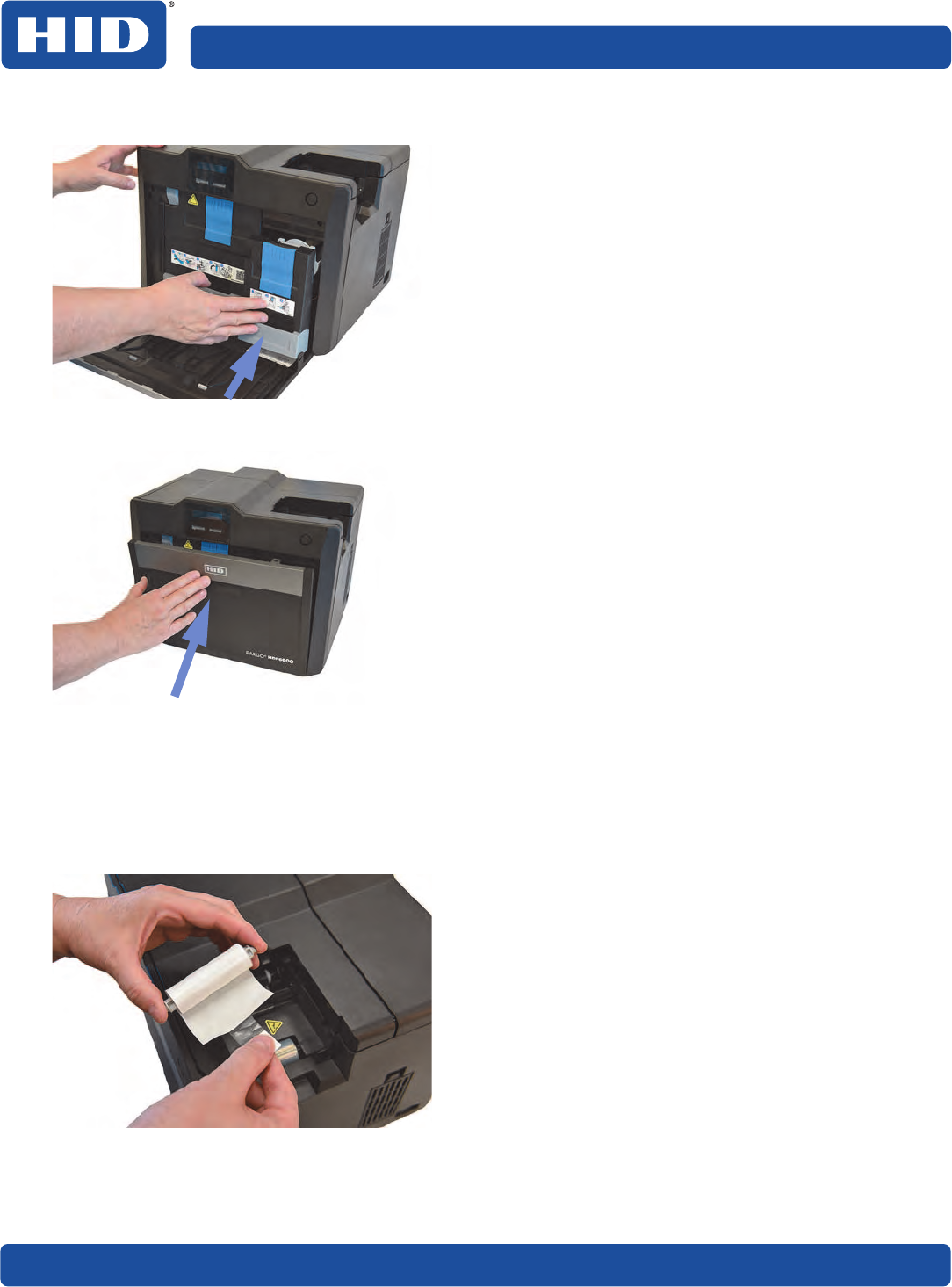
26 September 2018
Setup and installation PLT-02931, Rev. A.0
6. Slide in the ribbon drawer until the handle clicks/latches.
7. Close the printer front cover.
2.6 Installing the cleaning roller
Every HDP print ribbon contains a cleaning roller. Each time a new HDP print ribbon is inserted, a new
cleaning roller should be installed.
1. Remove the protective sleeve from the cleaning roller.
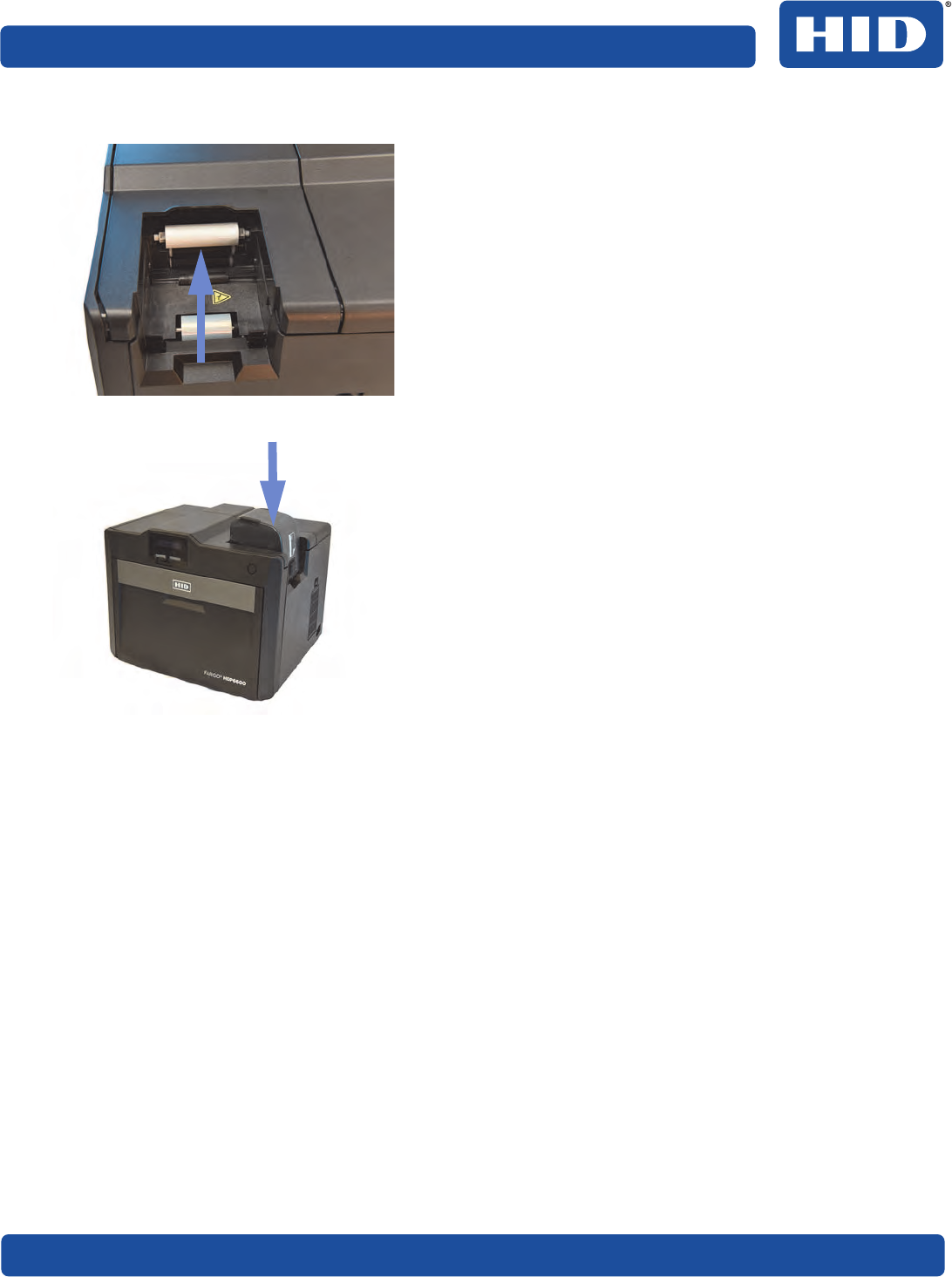
September 2018 27
PLT-02931, Rev. A.0 Setup and installation
2. Insert the cleaning roller into the card input area.
3. Attach the card input cartridge to the printer.
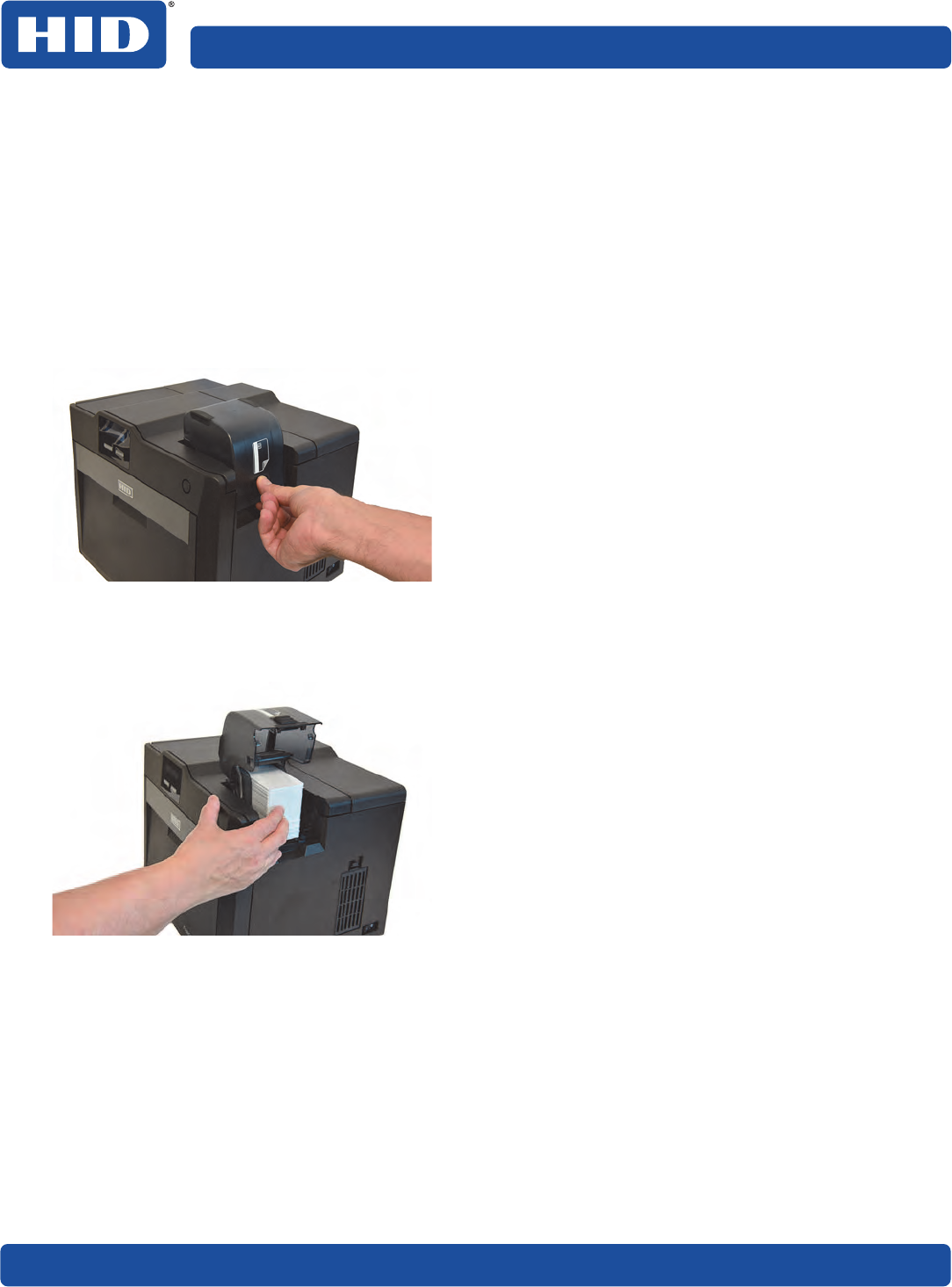
28 September 2018
Setup and installation PLT-02931, Rev. A.0
2.7 Installing blank cards into the input card hopper
Load the cards with the print side down and (if applicable) the magnetic stripe up and towards the front of
the printer.
Notes:
႑FARGO UltraCard® Premium card types are recommended (see Section 2.7.1 General card information).
႑Cards eject into the output hopper or reject hopper.
႑Each input hopper holds 100 cards.
1. Press the button to open the card input cartridge.
2. Load blank cards then close the card input cartridge.
Note: If using cards with a magnetic stripe, load the cards with the stripe facing up and towards the
front of the printer.
3. Close the input card hopper door.
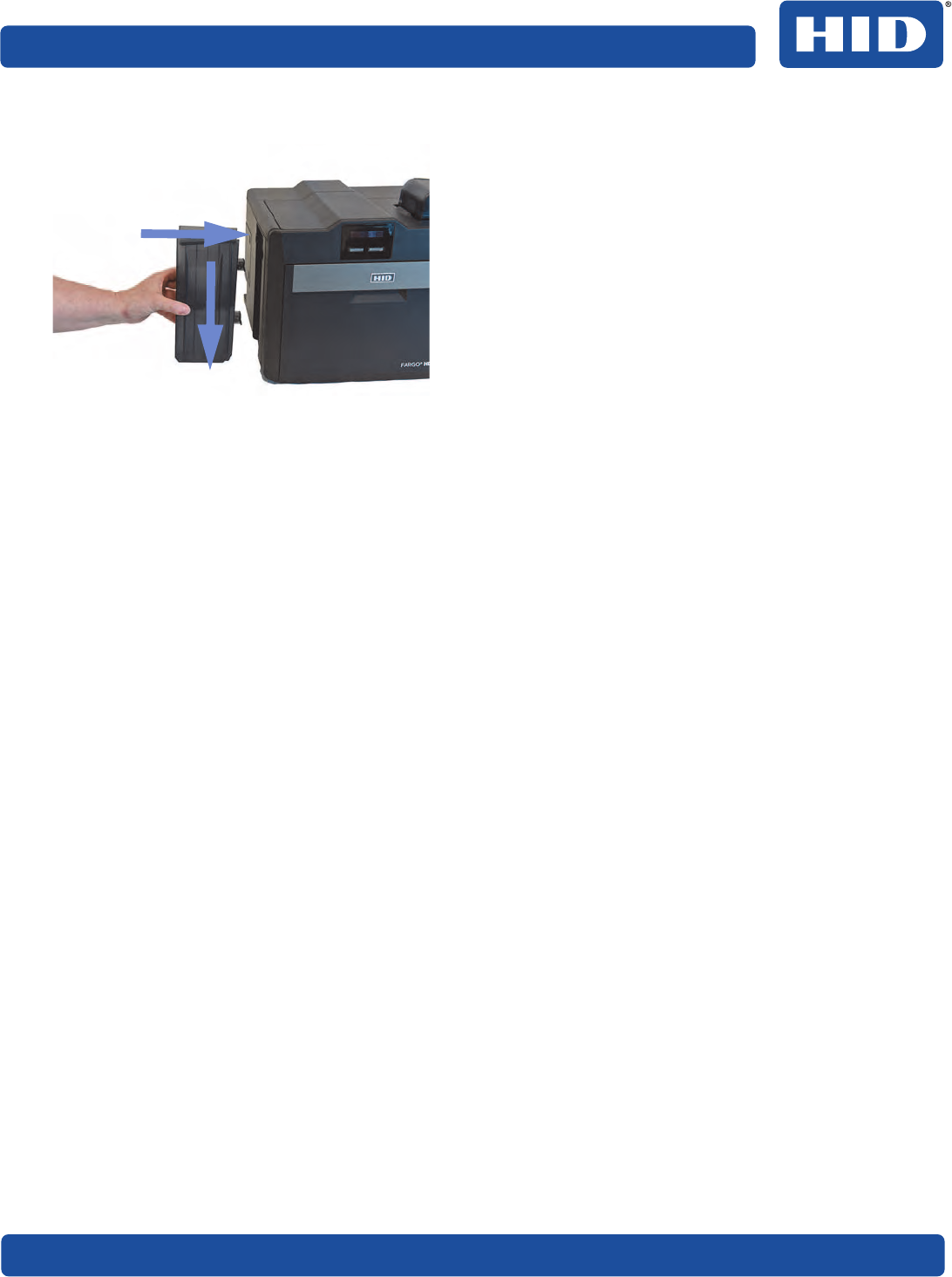
September 2018 29
PLT-02931, Rev. A.0 Setup and installation
4. Attach the card output hopper to the printer.
2.7.1 General card information
Important: For the best results and ISO card specification compliance, composite PVC is recommended
over straight PVC.
႑The printer prints onto any card with a clean level, and polished PVC surface.
႑Suitable cards must have a polished PVC surface free of fingerprints, dust, or any other types of
embedded contaminants.
႑For best results, HID recommends UltraCard, UltraCard stock has a glossy PVC laminate on top and
bottom and is optically inspected to provide the cleanest, most scratch and debris-reduced cards
possible. Two types of UltraCard card stock are available.
႑UltraCard stock has a PVC core and offers medium card durability.
႑UltraCard Premium stock has a 40% polyester core and offers high durability (recommended).
Both types of UltraCards produce printed images with a glossy, photo-quality finish.
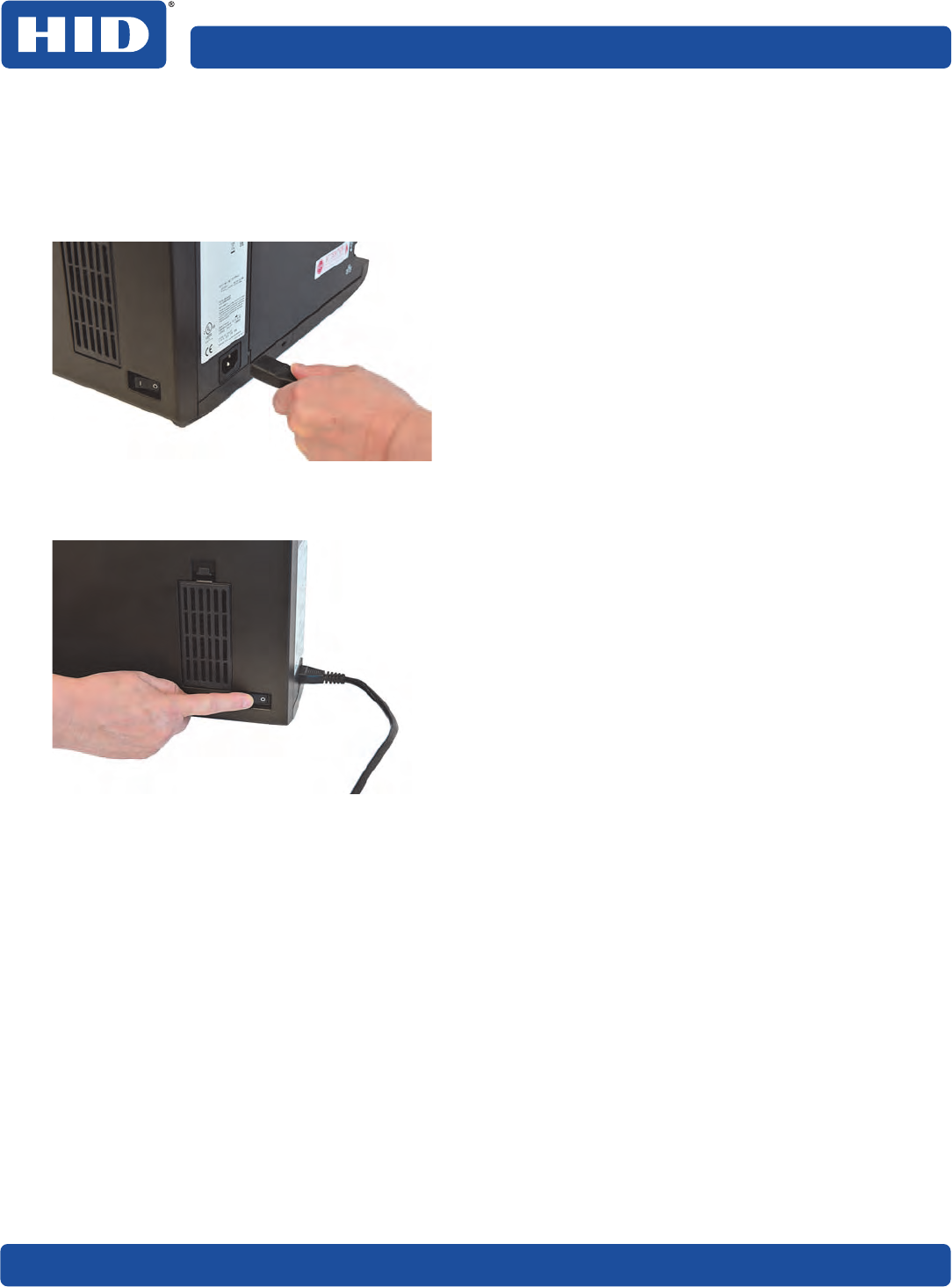
30 September 2018
Setup and installation PLT-02931, Rev. A.0
2.8 Printer power
Important: Do not connect the printer USB cable until prompted during the printer driver installation.
To connect power to the printer:
1. Plug the power cable into the back of the printer.
2. Plug the wall power cable into a standard 100-240 VAC power outlet.
3. Switch on the printer.
Note: If the physical switch is left on and the printer is left idle, the printer enters a low power state.
When a print job is sent, the printer restores full power and the print job commences.
Important: If connecting by Ethernet, add the ferrite (supplied with the printer) before plugging in the
Ethernet cable.
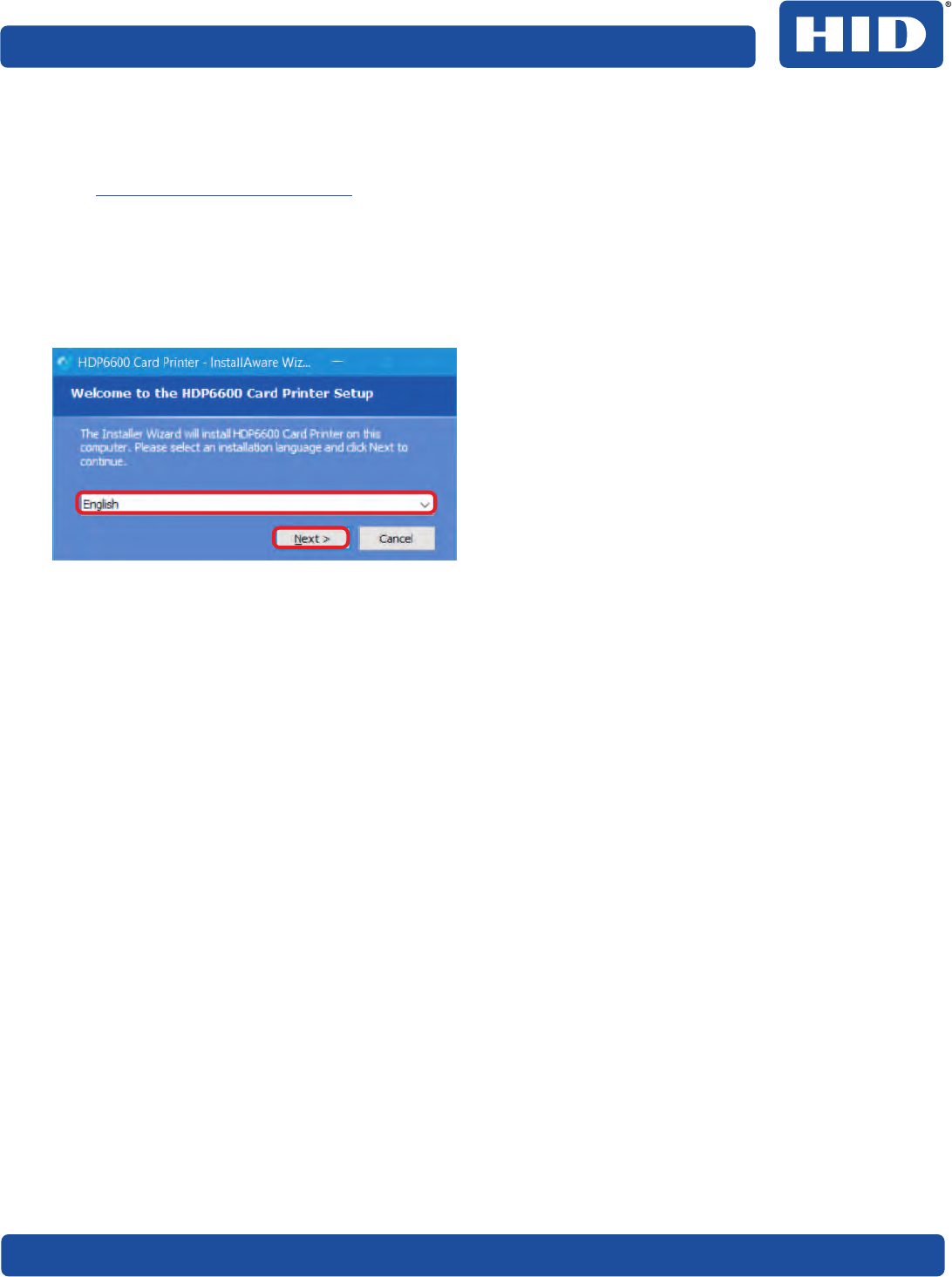
September 2018 31
PLT-02931, Rev. A.0 Setup and installation
2.9 Driver installation instructions
To download and install the HDP6600 driver file:
1. Visit www.hidglobal.com/drivers and search for HDP6600.
2. Click DOWNLOAD from the search results and click I ACCEPT to accept the End User License
Agreement.
3. Once the driver file has downloaded, double-click the .exe file to install the HDP6600 driver.
4. The installer verifies the contents of the setup package and the installation begins. Follow the on-screen
instructions to complete the driver installation. Select your required language. Click Next.
5. The Welcome to HDP6600 Card Printer Install screen is displayed. Click Next.
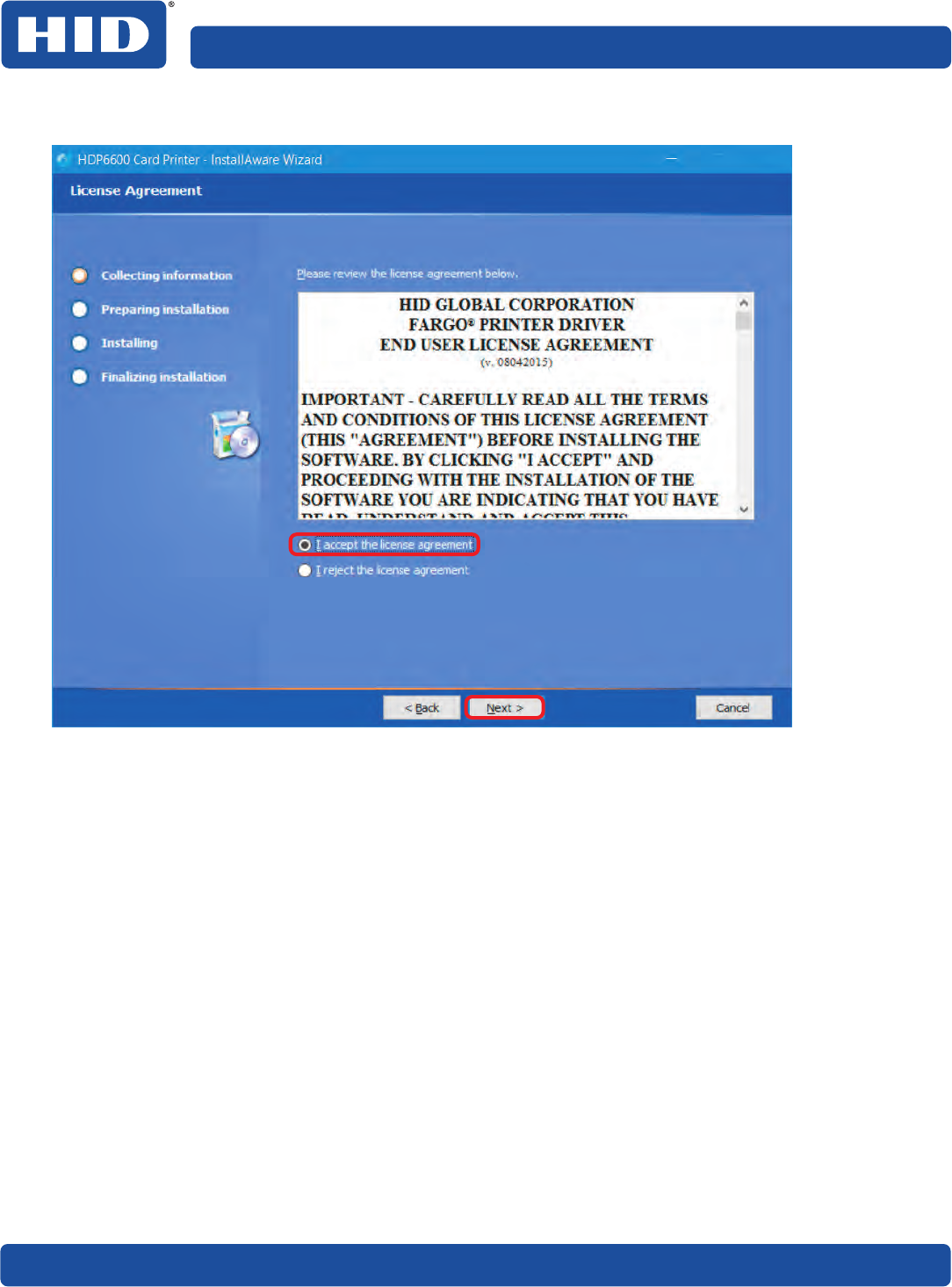
32 September 2018
Setup and installation PLT-02931, Rev. A.0
6. Read the license terms and conditions. Select I accept the license agreement and click Next.
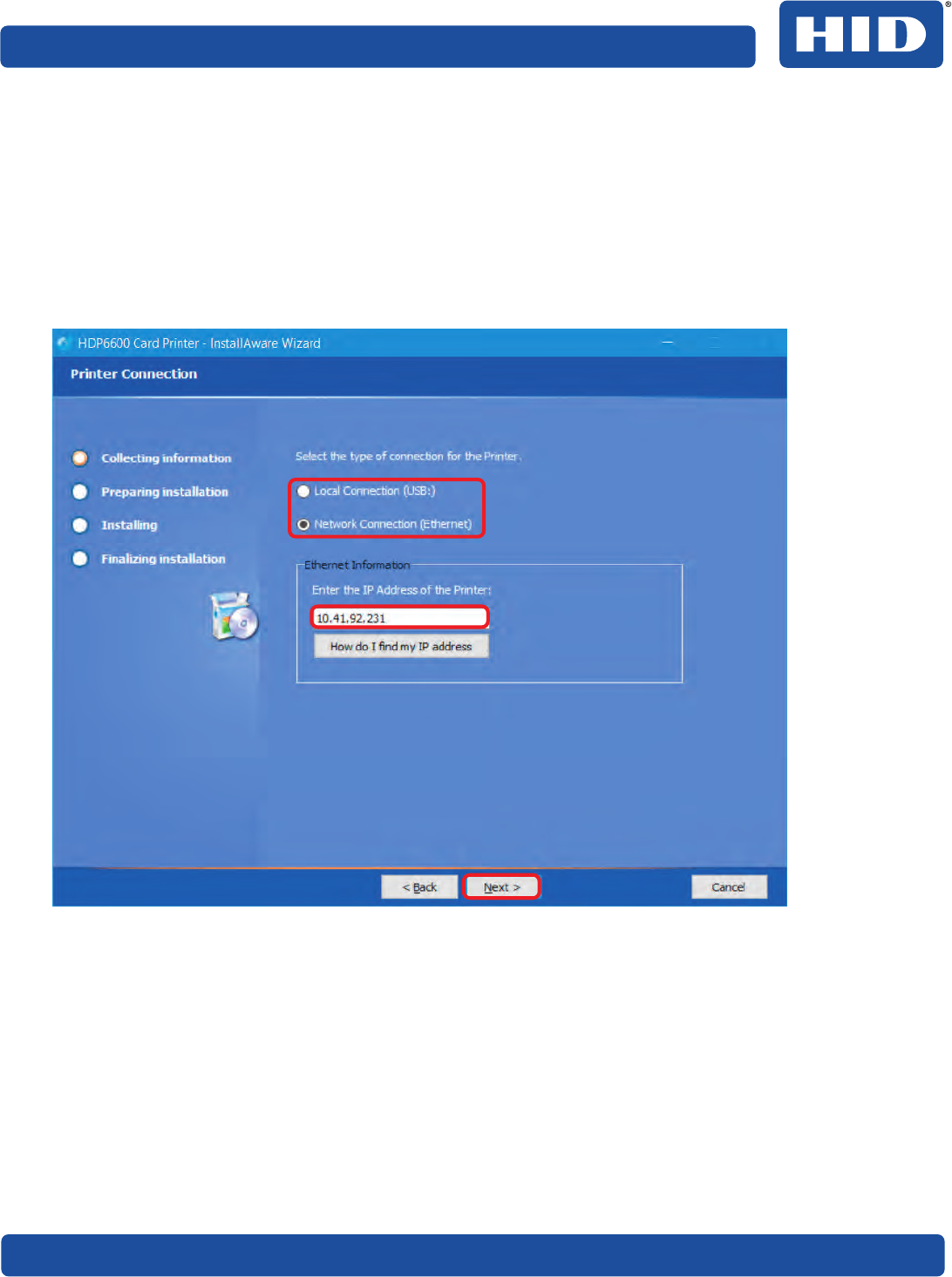
September 2018 33
PLT-02931, Rev. A.0 Setup and installation
7. Select the type of connection for the printer.
႑If you are connecting to a local connection, select Local Connection (USB) and click Next.
႑If you are connecting to a network, select Network Connection (Ethernet) and do the following:
a. Connect the Ethernet cable to the printer.
b. Enter the IP address of the printer.
a. Connect the printer to a power source and turn it on.
b. Click Next.
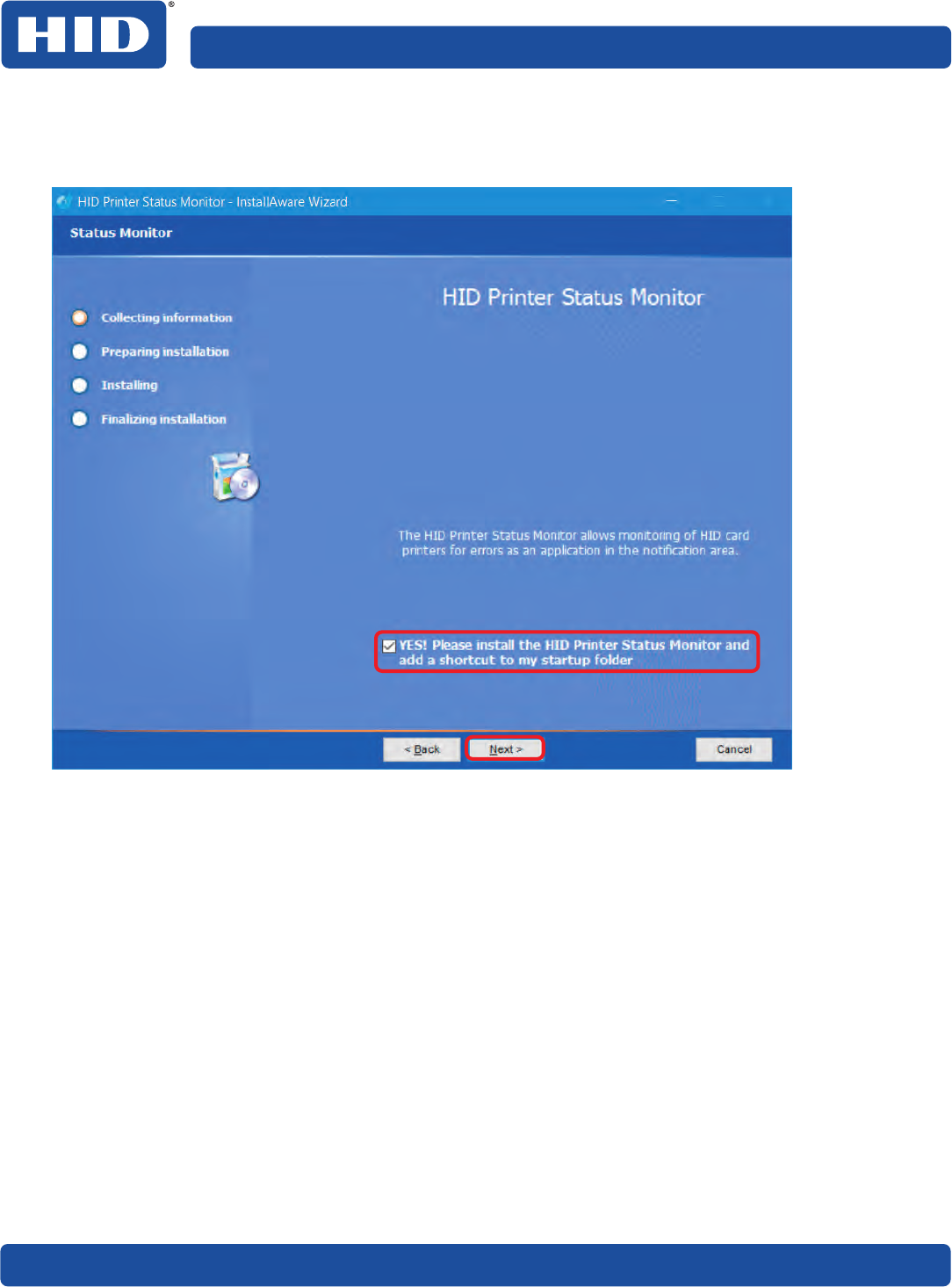
34 September 2018
Setup and installation PLT-02931, Rev. A.0
8. The HID Printer Status Monitor can be installed with the driver. This is recommended and the checkbox
is selected by default. The HID Status Monitor is used to provide information about the printers
connected to this computer. Click Next.
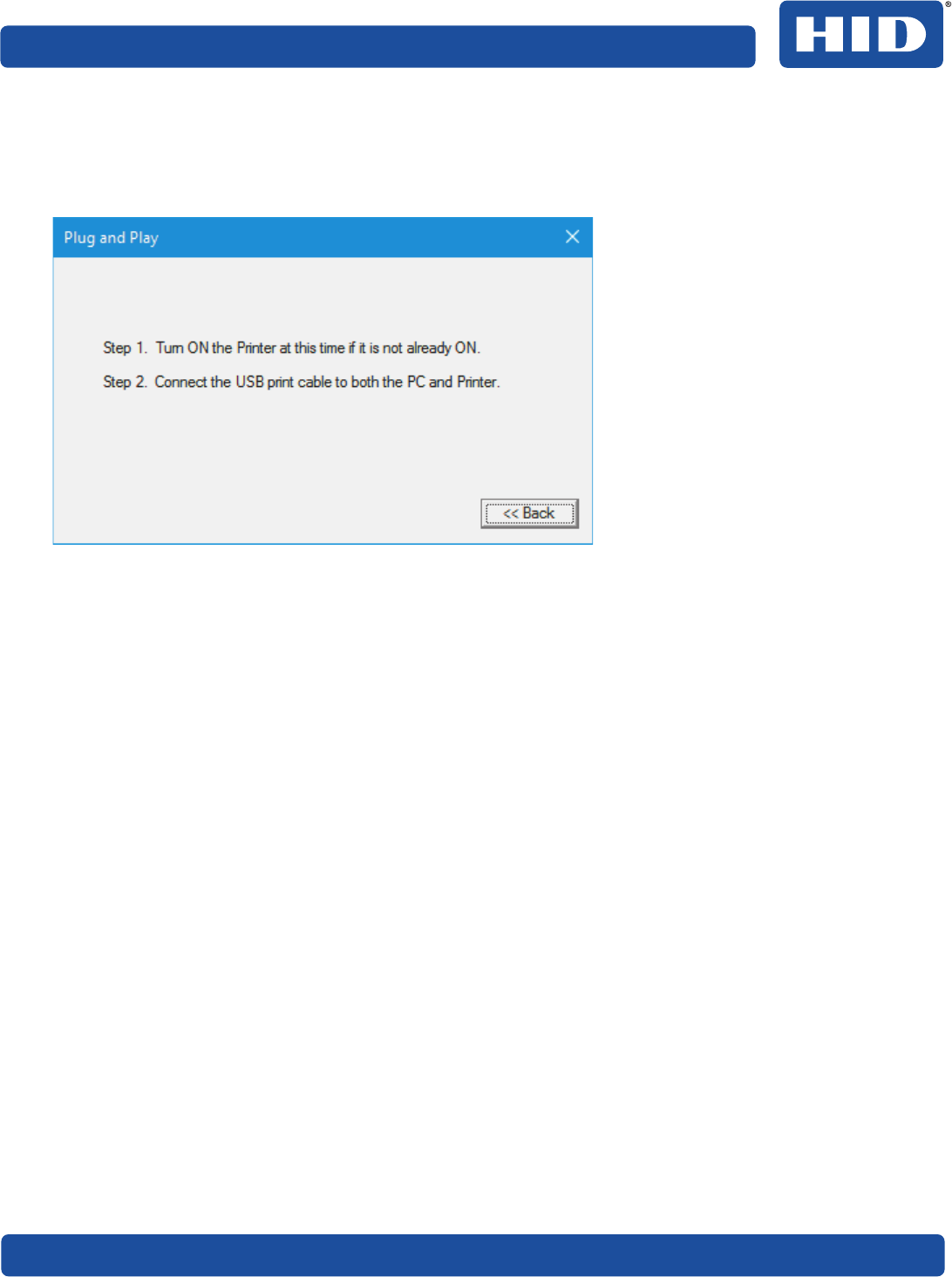
September 2018 35
PLT-02931, Rev. A.0 Setup and installation
9. The Ready to Install window is displayed. Click Next to begin the installation.
10.If you are using a local connection (USB), the Plug and Play window is displayed to prompt you to turn
on the printer and connect the USB print cable. When the connections are recognized, the installation
continues.
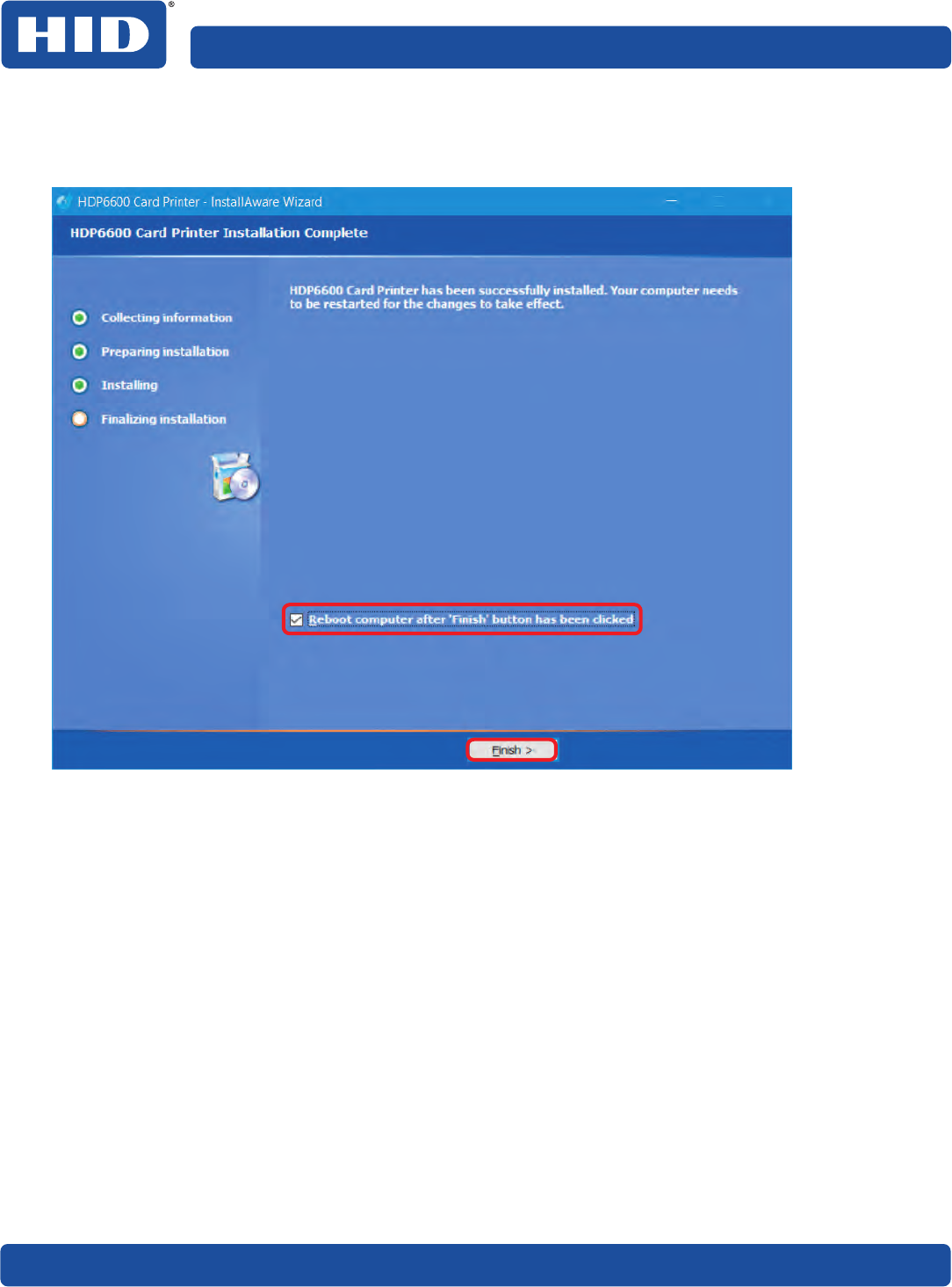
36 September 2018
Setup and installation PLT-02931, Rev. A.0
11. When the installation is completed, the PC may need to be restarted for the changes to take effect. If
the check box to Reboot the computer is displayed, select the check box to restart your computer and
click Finish.
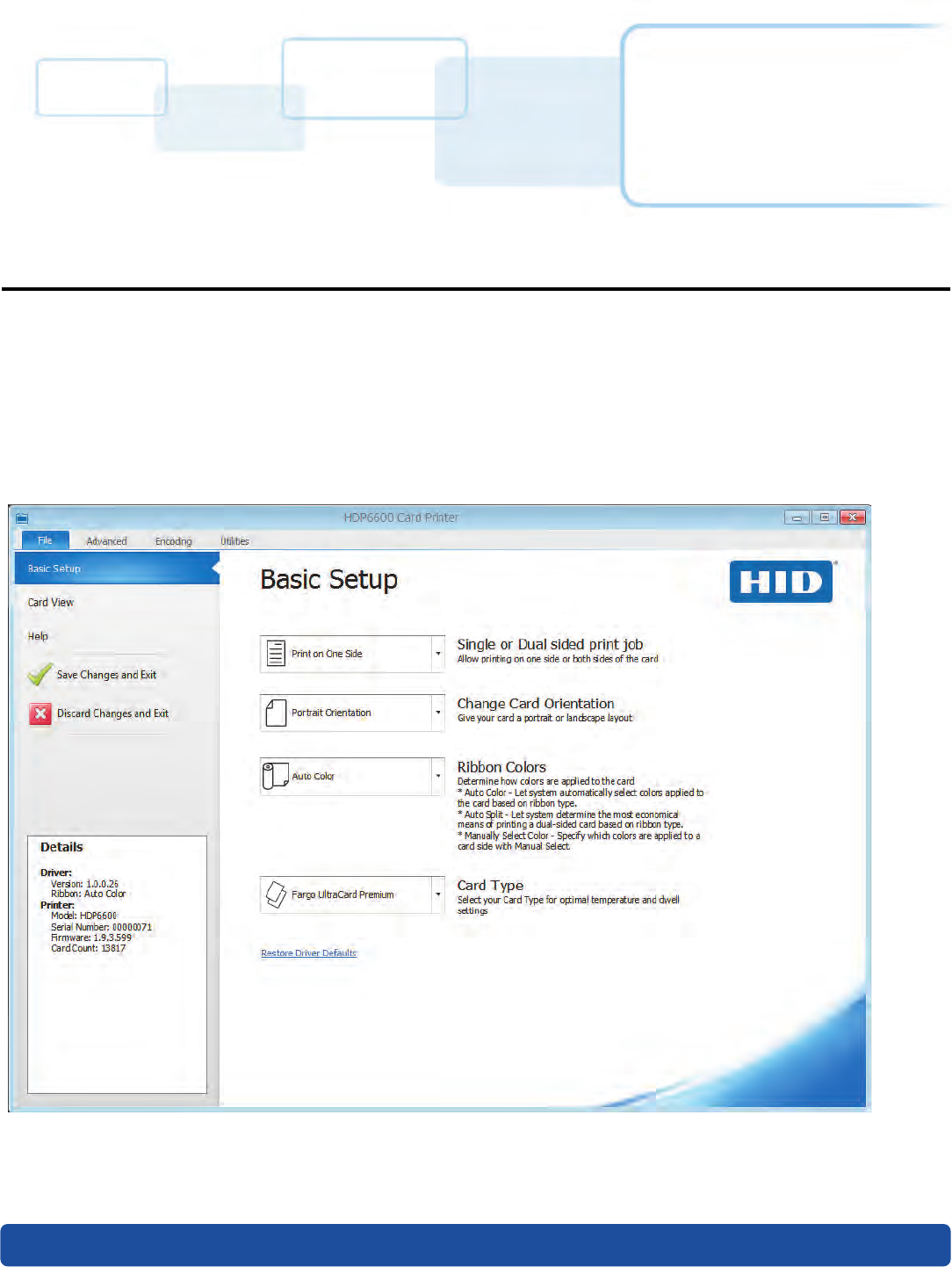
Section
3
September 2018 37
3 Printing preferences
All print driver operations and printing preferences are managed through the HDP®6600 Card Printer Printing
Preferences. Accessing the printing preferences varies by Microsoft Windows operating system. For example,
if you are running Microsoft Windows 10, the printing preferences are accessed by selecting Settings >
Devices > HDP6600 Card Printer > Manage > Printing preferences.
All information is controlled through the File, Advanced, Encoding, and Utilities menu tabs. When you first
access the preferences, the File menu is opened to the Basic Setup page.
The File menu allows you to save and restore system settings, set up global printer settings, and establish
printer setting profiles.

38 September 2018
Printing preferences PLT-02931, Rev. A.0
3.1 File menu tab
This tab allows you to view driver details and basic printer specifications. You can also restore driver default
settings, save changes to your preferences, or discard changes before exiting the printing preferences.
The File menu includes selections for the following pages and two exit options:
႑Basic Setup - Displays selections for printer settings, ribbon specifications, card type, and a link for
restoring driver defaults.
႑Card View - Displays a representation of the currently selected card options.
႑Help - Displays links to available help files and videos for the maintenance of the HDP6600 card printer.
႑Save Changes and Exit - Saves any changes made within the HDP6600 Card Printer Printing
Preferences screens and exits the program.
႑Discard Changes and Exit - Cancels any changes made within the HDP6600 Card Printer Printing
Preferences screens and exits the program.
႑Details - Displays the driver version number and ribbon color as well as the printer specifications for
model, serial number, firmware, and card count. This information is displayed on all pages and menu
tabs throughout the interface.
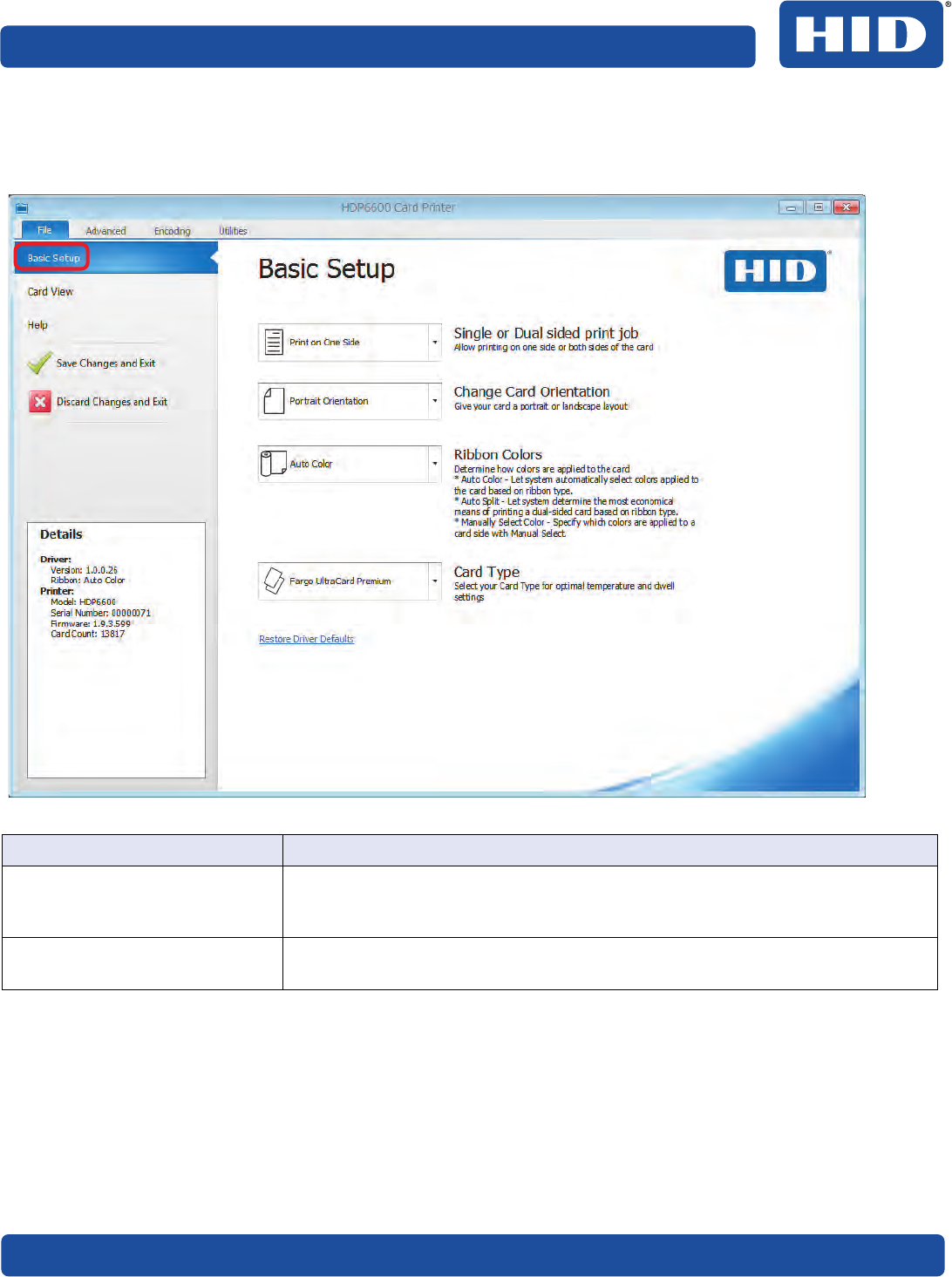
September 2018 39
PLT-02931, Rev. A.0 Printing preferences
3.1.1 Basic setup page
This page displays selections for printing on one or both sides of a card, card orientation, ribbon colors, and
card types. It also includes a Details pane and a link for restoring the driver defaults.
Field Definition
Single or Dual sided print job Defines whether to print on one side or both sides. If a dual-sided module is not
detected, this selection is not available.
Selections available are: Print on One Side or Print on Both Sides.
Change Card Orientation Defines whether the card orientation is vertical or horizontal.
Selections available are Landscape or Portrait.
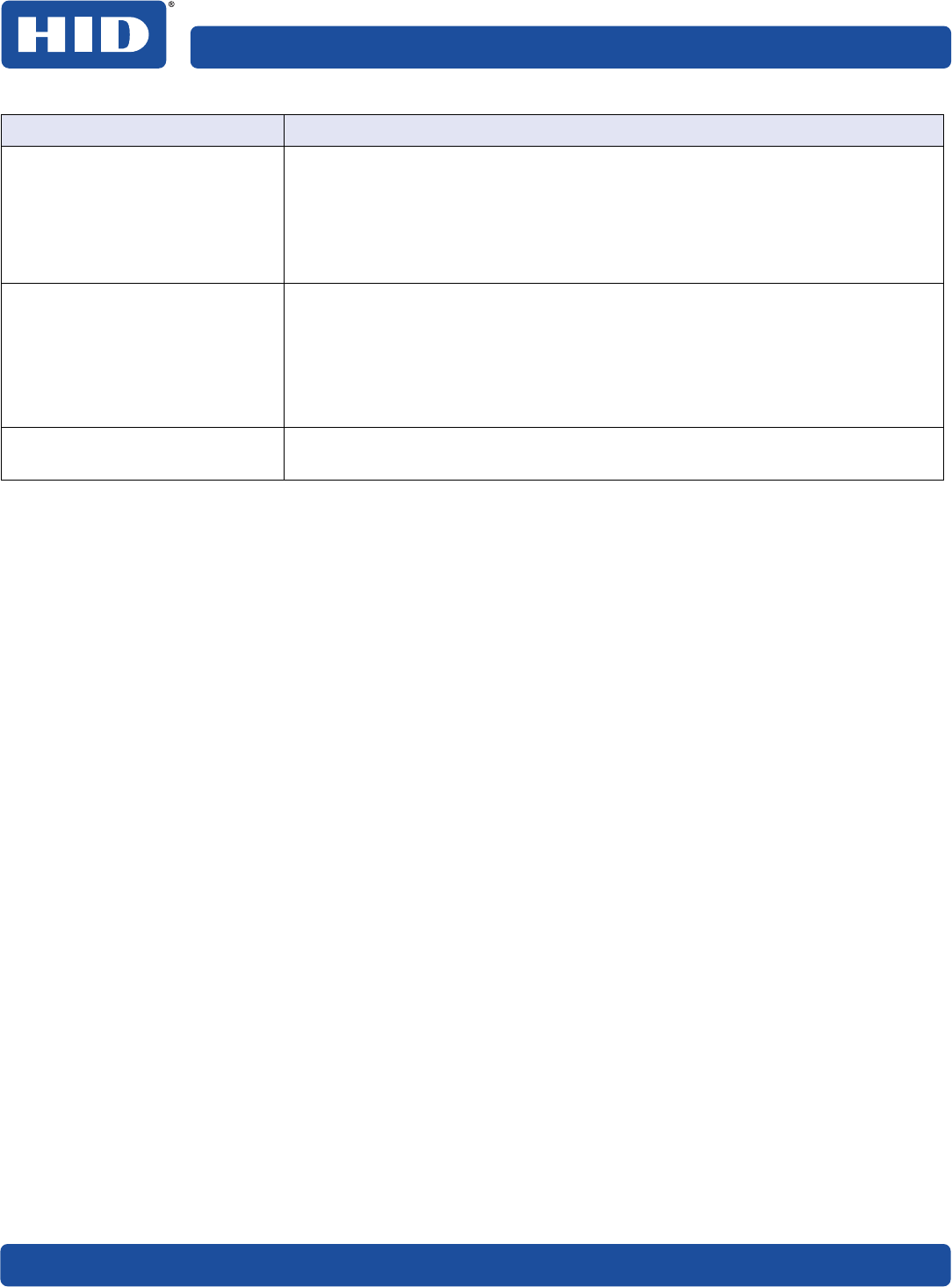
40 September 2018
Printing preferences PLT-02931, Rev. A.0
Ribbon Colors Automatically or manually select the colors that print. Options are:
႑Auto Color: The system automatically selects the colors applied to the card
based on the ribbon type.
႑Auto Split: The system determines the most economical means of printing
a dual-sided card based on the ribbon type.
႑Manual Select: You can specify which colors are applied to a card side.
Card Type Specify the card type for optimal temperature and dwell settings. Options are:
႑FARGO® UltraCard® Premium (default card type)
႑FARGO UltraCard
႑FARGO UltraCard PC
႑HID Tech Card Composite
႑HID Tech Card PVC
Restore Driver Defaults Displays a prompt to reset all selections in the driver file to the default settings.
Click Yes to reset or No to cancel.
Field Definition
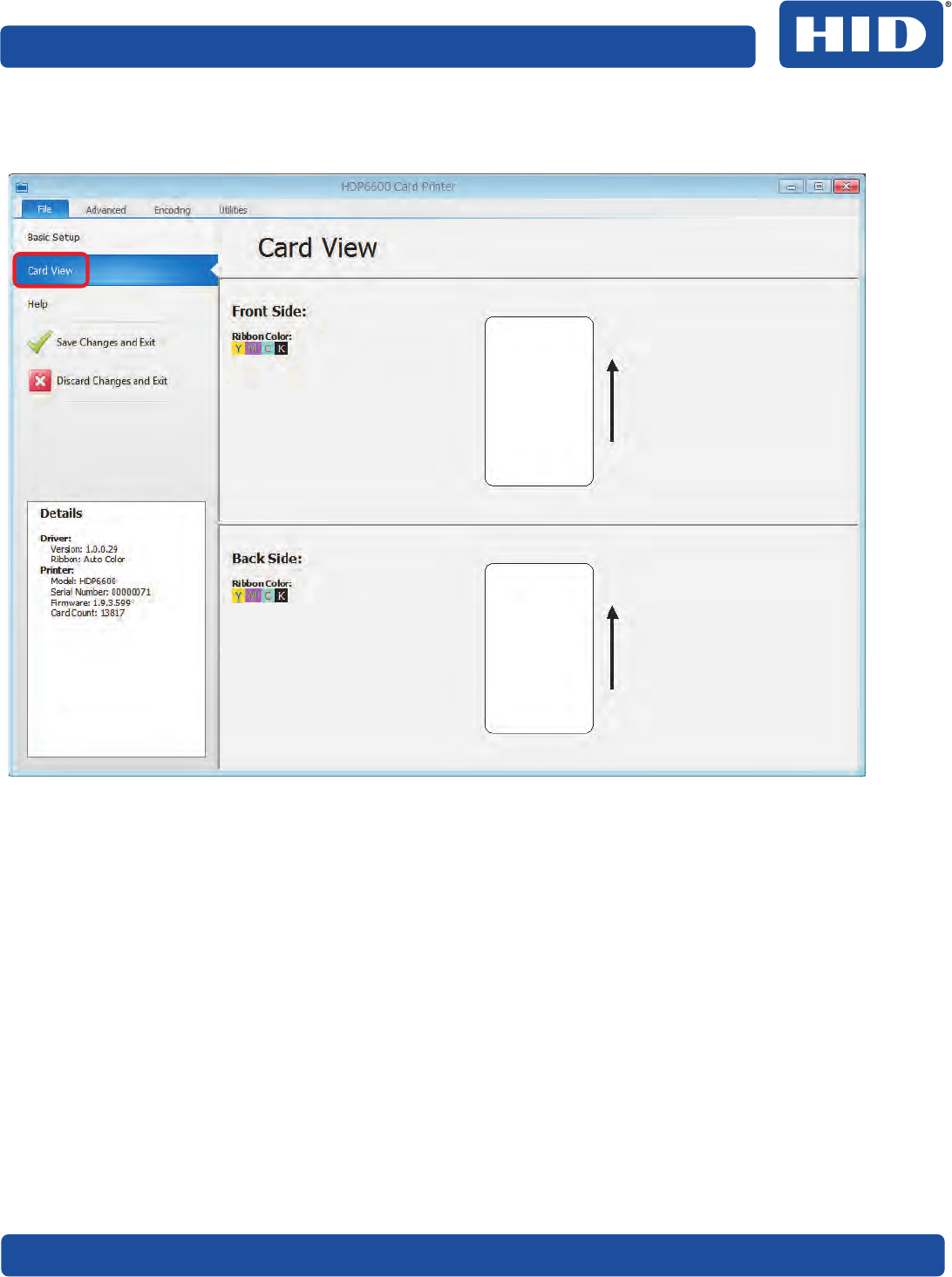
September 2018 41
PLT-02931, Rev. A.0 Printing preferences
3.1.2 Card view page
This page displays a representation of the currently selected card options.
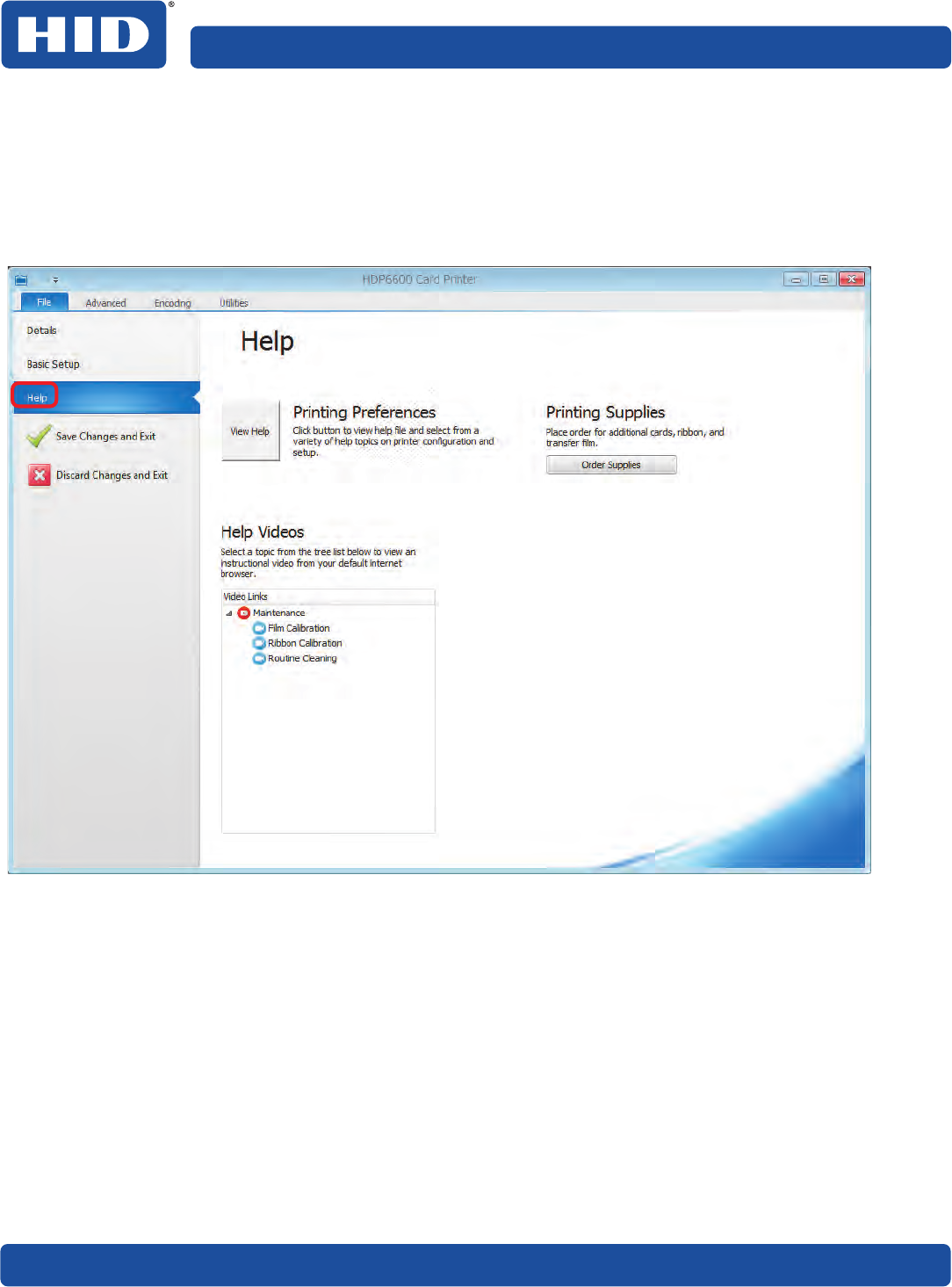
42 September 2018
Printing preferences PLT-02931, Rev. A.0
3.1.3 Help page
This page displays links to:
႑Available help files for the printing preferences
႑Order printing supplies
႑Instructional videos for the maintenance of the HDP6600 card printer
3.1.4 Exit options
To exit the Printing Preferences, choose one of the following:
႑Save Changes and Exit - Saves any changes made within the HDP6600 card printer printing
preferences screens and exits the program.
႑Discard Changes and Exit - Cancels any changes made within the HDP6600 card printer printing
preferences screens and exits the program.
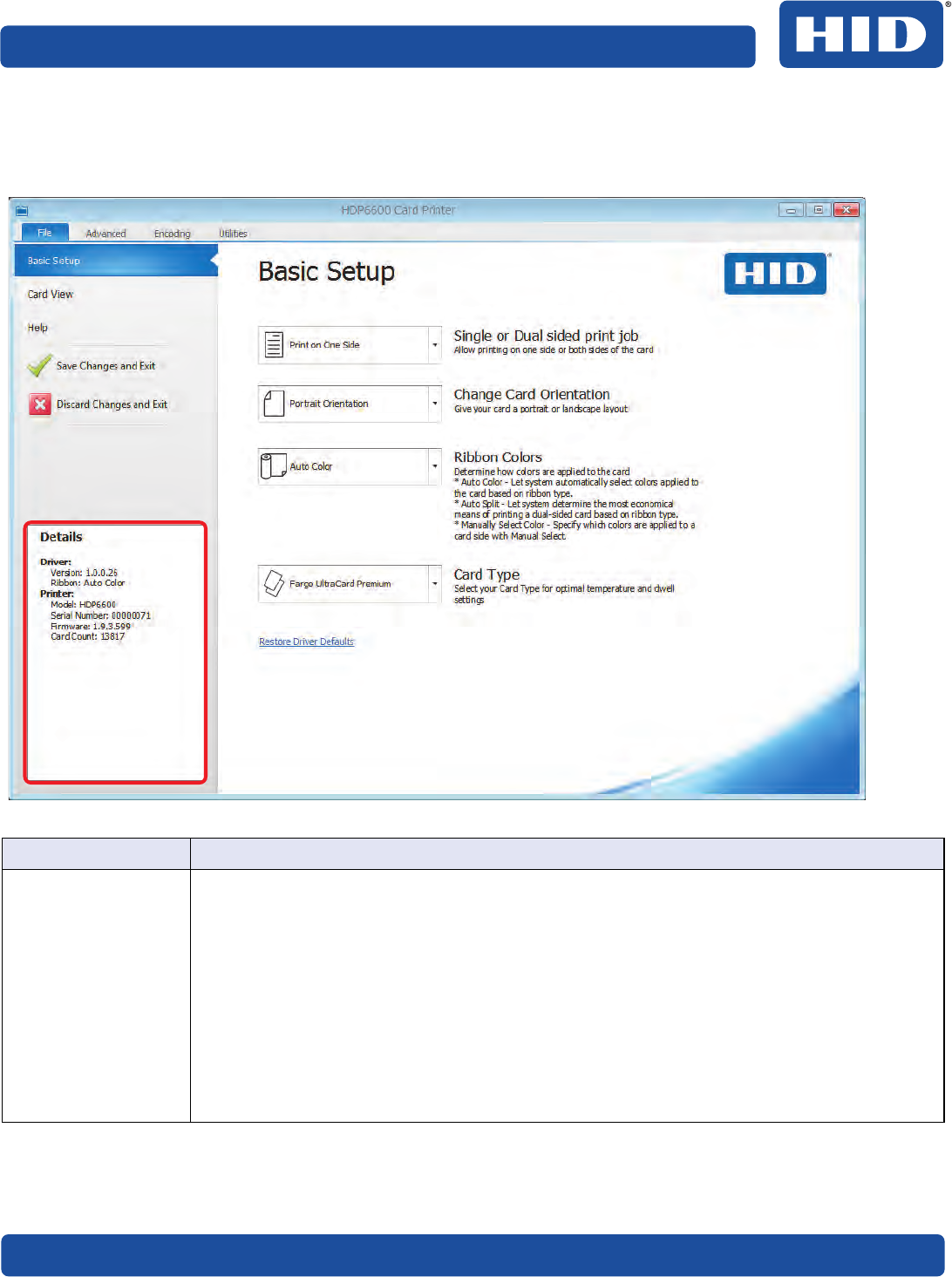
September 2018 43
PLT-02931, Rev. A.0 Printing preferences
3.1.5 Details window
This window displays basic information about the driver and the printer connected to your PC. This
information is also displayed on all pages and menu tabs throughout the interface.
Field Definition
Details Displays the driver and printer information.
Driver:
႑Version: The installed printer driver version.
႑Ribbon: The detected ribbon color.
႑Mode: This is displayed if a dual-sided module is detected and if the card is set to flip
before being printed.
Printer:
႑Model: The printer model.
႑Serial Number: The serial number of the printer.
႑Firmware: The installed firmware version.
႑Card Count: The number of cards printed.
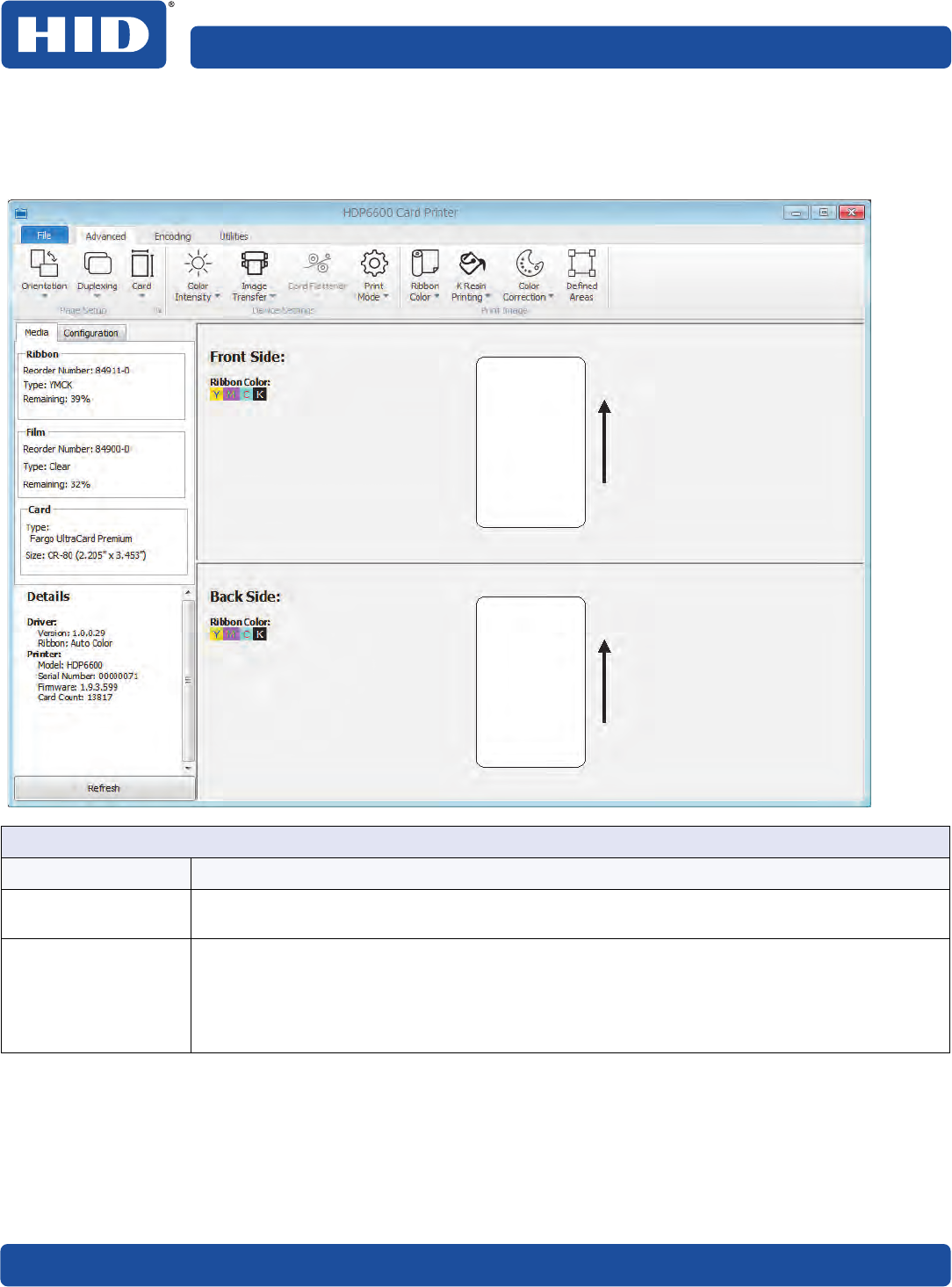
44 September 2018
Printing preferences PLT-02931, Rev. A.0
3.2 Advanced menu tab
This tab allows you to select page setup options, printing options, diagnostic settings, and calibration
settings.
Page Setup
Menu option Description
Orientation Sets the card orientation. Select Portrait to print the card vertically. Select Landscape to print
horizontally.
Duplexing Note: This option is grayed out if a dual-sided module is not detected.
Single Sided: Select this option to print only on one side of the card. This includes printing on
the backside of preprinted cards that must have their magnetic stripe or smart card chip
encoded.
Dual Sided: This option is used for cards printed on both sides.
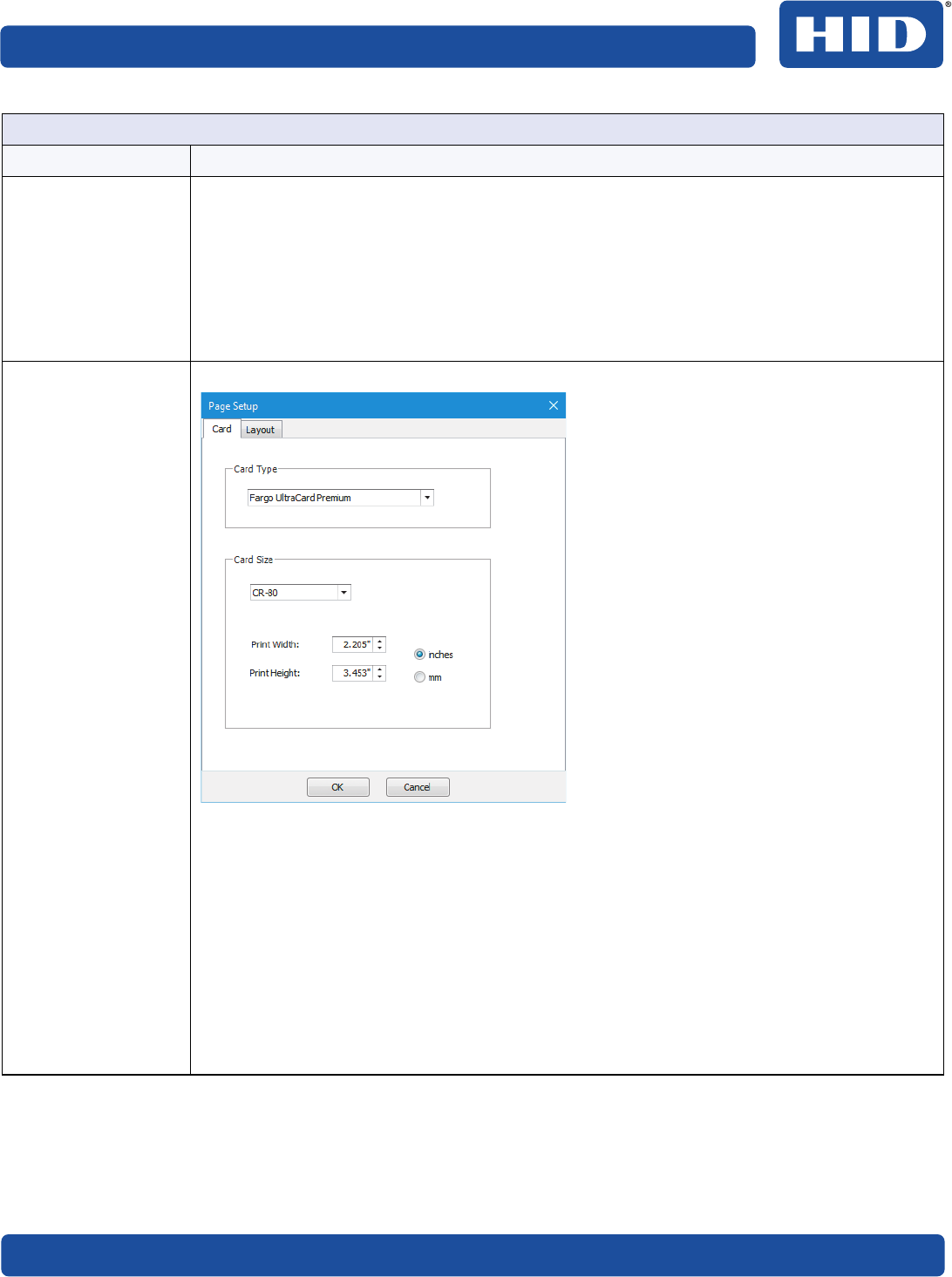
September 2018 45
PLT-02931, Rev. A.0 Printing preferences
Card Selects the type of card to print and optionally set up the card size and offset the print layout.
Options are:
Type: Select the type of card to print:
႑FARGO UltraCard Premium (default)
႑FARGO Ultracard
႑FARGO Ultracard PC
႑HID Tech Card Composite
႑HID Tech Card PVC
More Card Settings: Opens the Page Setup window to define the card type and size.
Select a Card Type to print:
႑FARGO UltraCard Premium (default)
႑FARGO Ultracard
႑FARGO Ultracard PC
႑HID Tech Card Composite
႑HID Tech Card PVC
Select a Card Size:
႑CR-80: This is the default. This card printer accepts standard CR-80 sized cards
(3.41" x 2.165", 86.6 mm x 55 mm).
႑Custom: This selection is used to create a custom card size. Use the Print Width/Print
Height adjustment arrows to set the dimensions of the total print area for each card size.
Set the option for inches or mm.
Page Setup
Menu option Description
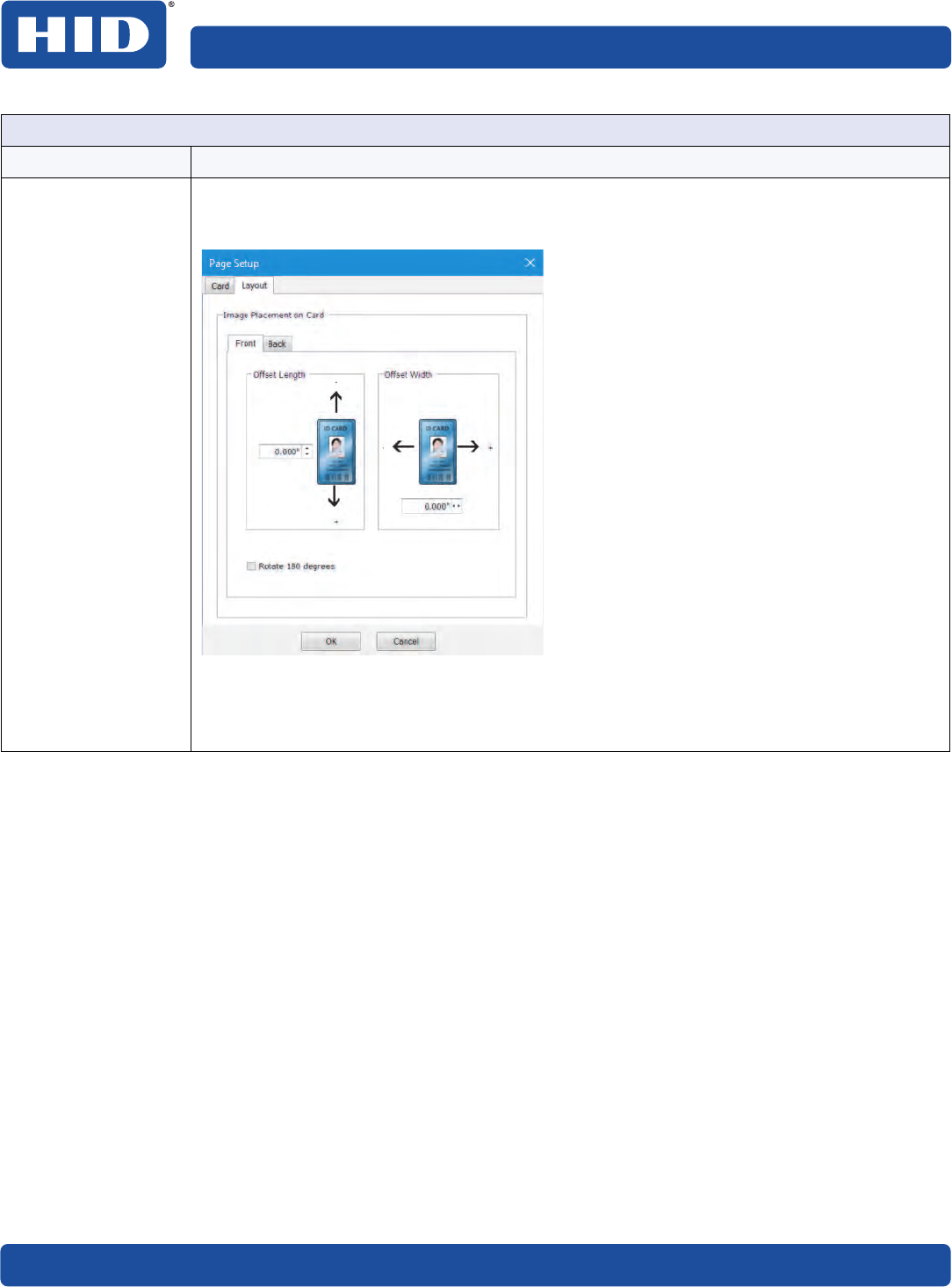
46 September 2018
Printing preferences PLT-02931, Rev. A.0
Select the Layout tab to set the Offset Length and Offset Width for the image placement on
the front and back of the card.
Note: If Duplexing is set to Single Sided, the Back tab is not available on this window.
Adjust the image position values by clicking the Offset Length and Offset Width adjustment
arrows. The image position changes according to the selection of portrait or landscape.
Rotate 180 Degrees: Select this option to rotate the image on the front or back 180 degrees
when printed.
Page Setup
Menu option Description
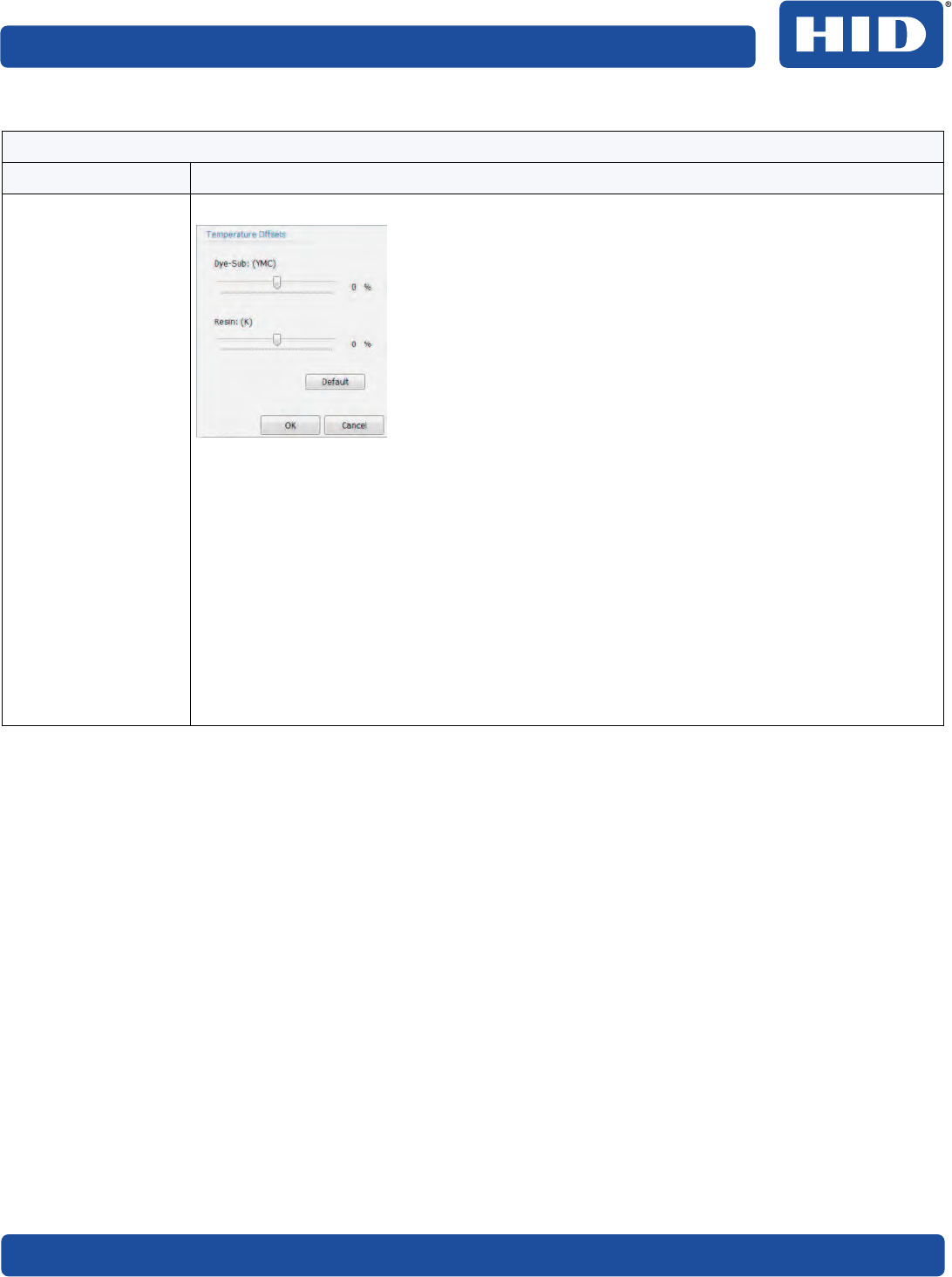
September 2018 47
PLT-02931, Rev. A.0 Printing preferences
Device Settings
Menu option Description
Color Intensity Controls the overall darkness and lightness of the printed color.
Dye-Sub (YMC): This slider controls the overall darkness and lightness of the dye-sub printed
image. Any adjustments only affect those images printed with dye-sublimation (YMC-type)
ribbon panels.
႑Moving the slider to the left causes less heat to be used; the prints are lighter.
႑Moving the slider to the right cause more heat to be used; the prints are darker.
Resin (K): The heat is controlled for both front and back of cards. This control can be helpful
for fine-tuning the sharpness of resin text and bar codes.
This slider controls amount of heat the printer uses when printing with the resin black panel.
႑Moving the slider to the left causes less heat to be used; the resin images are lighter or
less saturated.
႑Moving the slider to the right causes more heat to be used; the resin images are darker
or more saturated.
Default: Returns the listed percentages to the factory settings.
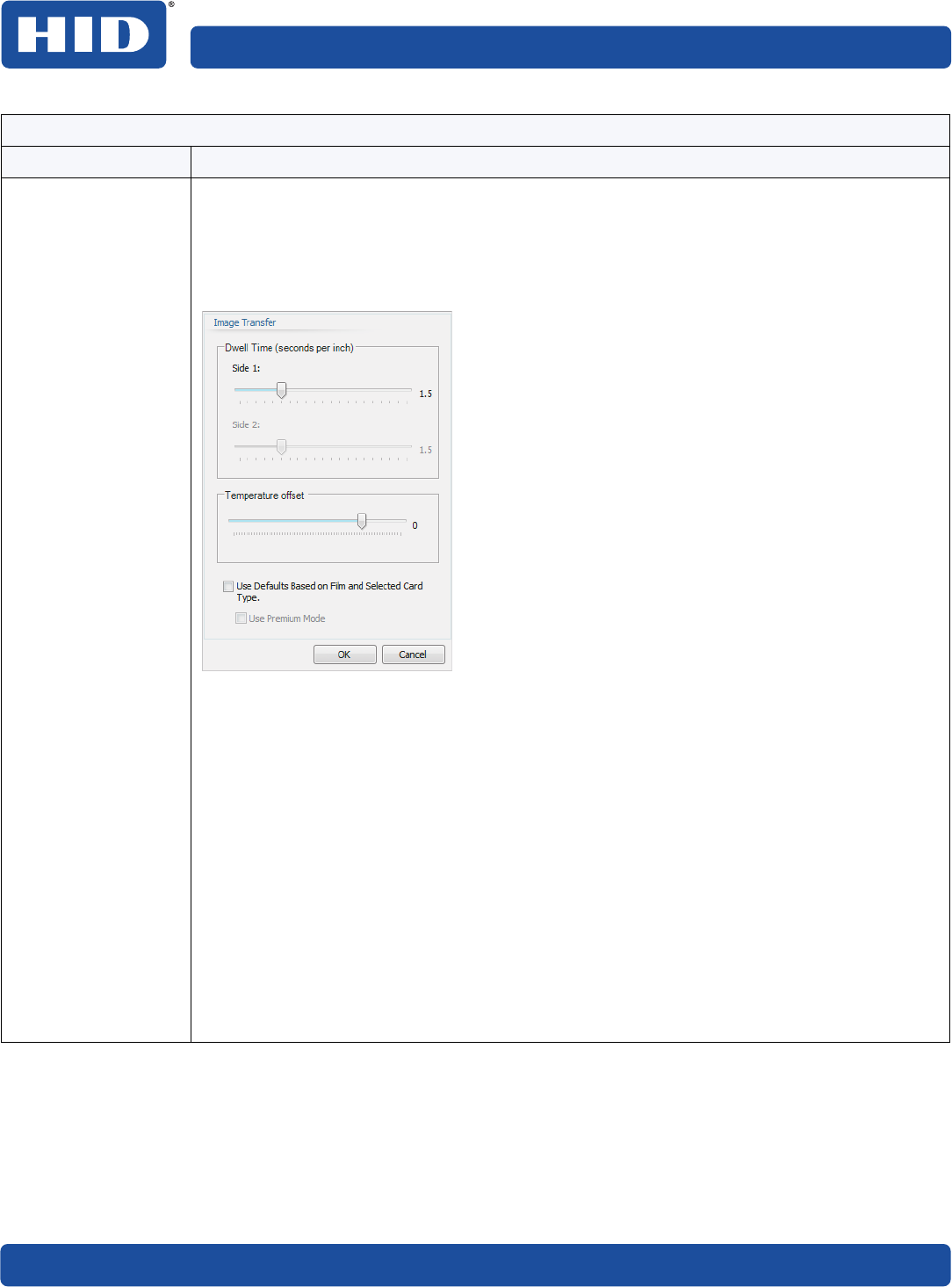
48 September 2018
Printing preferences PLT-02931, Rev. A.0
Image Transfer This setting controls the speed and temperature at which printed images are transferred from
the film to the card. These settings may vary depending on the card type.
When the Use Defaults Based on the Film and Selected Card Type option is selected, the
printer driver automatically optimizes these settings according to the card type and film type
previously selected. Changes made to the Dwell Time and Temperature offset settings are
saved for the selected card type option upon exiting the printer driver setup.
Dwell Time (seconds per inch): Sets the speed at which the printed image is transfered from
the HDP film to the card in seconds per inch for each side of the card.
႑Lower limit = 1 second per inch
႑Upper limit = 3 seconds per inch
Temperature offset: Sets the temperature at which the printed image is transferred from the
HDP film to the card.
႑Lower limit: -50
႑Upper limit: +15
Use Defaults Based on the Film and Selected Card Type: This option is automatically selected.
The printer driver software has default temperature and dwell time settings that deliver the
best transfer for these card types. These defaults are automatically configured, based on the
card type, ribbon type, and whether printing single- or dual-sided.
Note: If you select the wrong option, the incorrect dwell time and temperature may be used
during the image transfer process which results in poor adhesion of the HDP film or card
warping.
Use Premium Mode: Select this option to reduce the transfer temperature and speed to
enhance the image quality.
Device Settings
Menu option Description
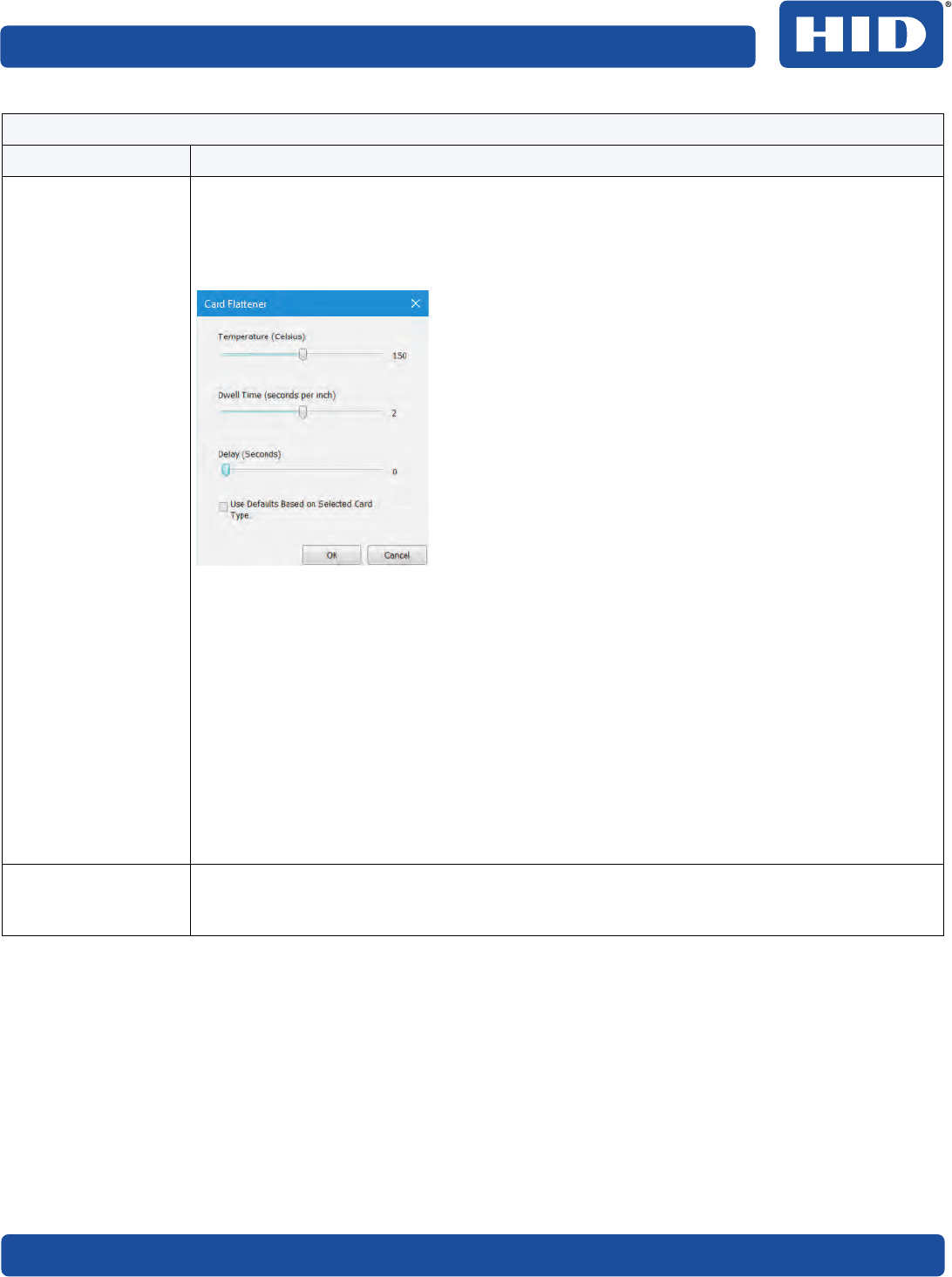
September 2018 49
PLT-02931, Rev. A.0 Printing preferences
Card Flattener This option is available only for single-sided card printing and is grayed out if a card flattener is
not detected. Available options are:
Enabled: Select this option to enable the flattener.
Advanced Settings: This option is grayed out unless the Enabled option is selected. When
selected, the Card Flattener window is displayed.
Temperature (Celsius):
႑Lower limit: -50
႑Upper limit: +50
Dwell Time (seconds per inch): Sets the Dwell Time for the flattening process.
႑Lower limit = 1 second per inch
႑Upper limit = 3 seconds per inch
Delay (Seconds): Sets the Delay for the flattening process.
႑Lower limit = 0
႑Upper limit = 15
Use Defaults Based on Selected Card Type: This option is automatically selected. Clear this
box to set the options in this window.
Note: If you select the wrong option, the incorrect dwell time and temperature may be used in
the flattening process which may result in card warping.
Print Mode If Flip Card Before Print is selected, the reverse side of the card is printed first.
Note: This option is available only for dual-sided card printing and is grayed out if a dual-sided
module is not detected.
Device Settings
Menu option Description
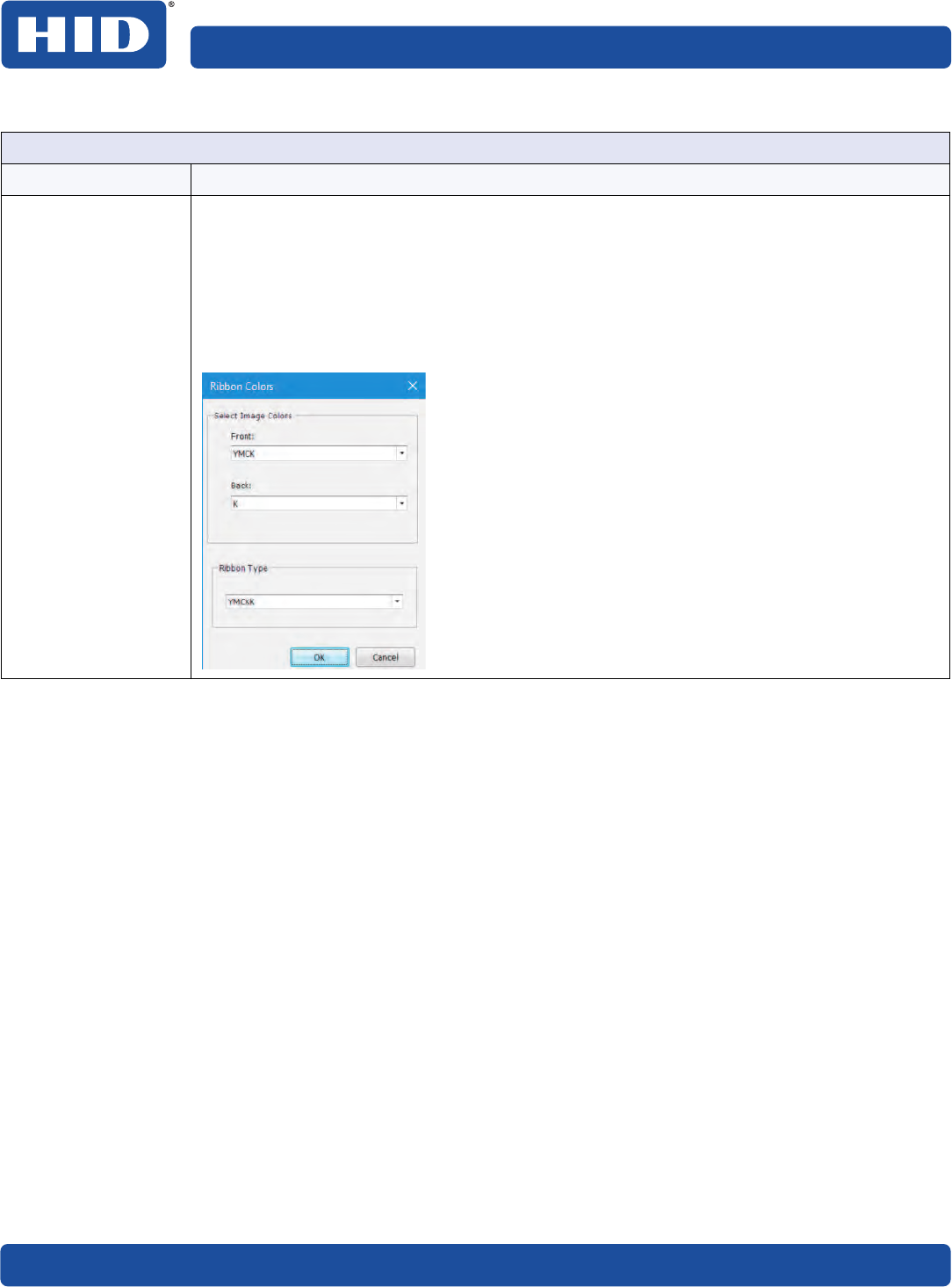
50 September 2018
Printing preferences PLT-02931, Rev. A.0
Print Image
Menu option Description
Ribbon Color This option allows the printer to automatically select the colors to print or allows you to specify
card colors. This setting is determined by the ribbon detected in the printer and the selection
of single- or dual-sided printing.
Auto Color: Automatically detects the ribbon type and splits the panel set when applicable.
When Auto Color is selected, Manual Select is disabled.
Auto Split: If a dual-sided module is detected, prints YMCK on the front and K on the back.
Manual Select: Displays the Ribbon Colors window for you to select from the list of available
colors.
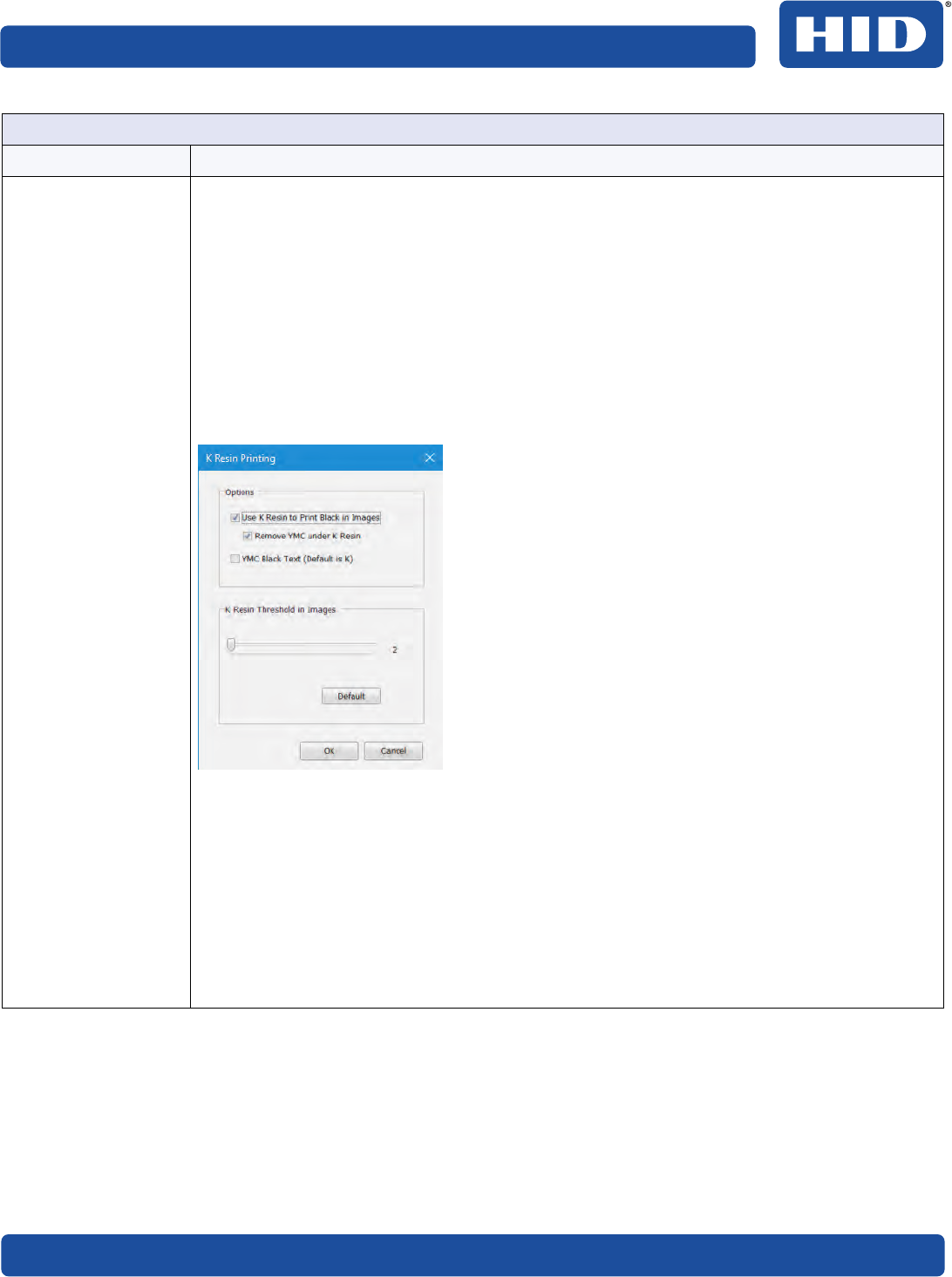
September 2018 51
PLT-02931, Rev. A.0 Printing preferences
K Resin Printing This option controls where the resin black (K) panel of a full-color ribbon is printed. Resin black
text is desirable due to its sharp, saturated color. Available options are:
Dither Type:
႑Graphics
႑Photos
More Settings: This option is available when Ribbon Color is set to Auto Color or
Manual Select. This option is only available with YMC-K panel combinations. This option opens
the K Resin Printing window and provides the ability to:
႑Print black in image using K-panel resin (white background)
႑Print black in image using K-panel resin (color background)
႑Remove resin from image in selected area (keep out). See the Defined Areas option.
႑Print black in selected area of image. See the Defined Areas option.
Use K Resin to Print Black in Images: Prints black in images using K-panel resin (white or color
backgrounds) and automatically selects Print YMC under K Resin.
Print YMC under K Resin: Clear this check box to print black in image using K-panel resin
(white or color backgrounds).
YMC Black Text (Default is K): This option prints black text with YMC instead of K.
K Resin Threshold in Images: When Use K Resin to Print Black in Images is selected, this
option sets the K resin usage limit.
႑Lower limit = 1
႑Upper limit = 255
Default: Click this button to return the listed threshold to the factory setting.
Print Image
Menu option Description
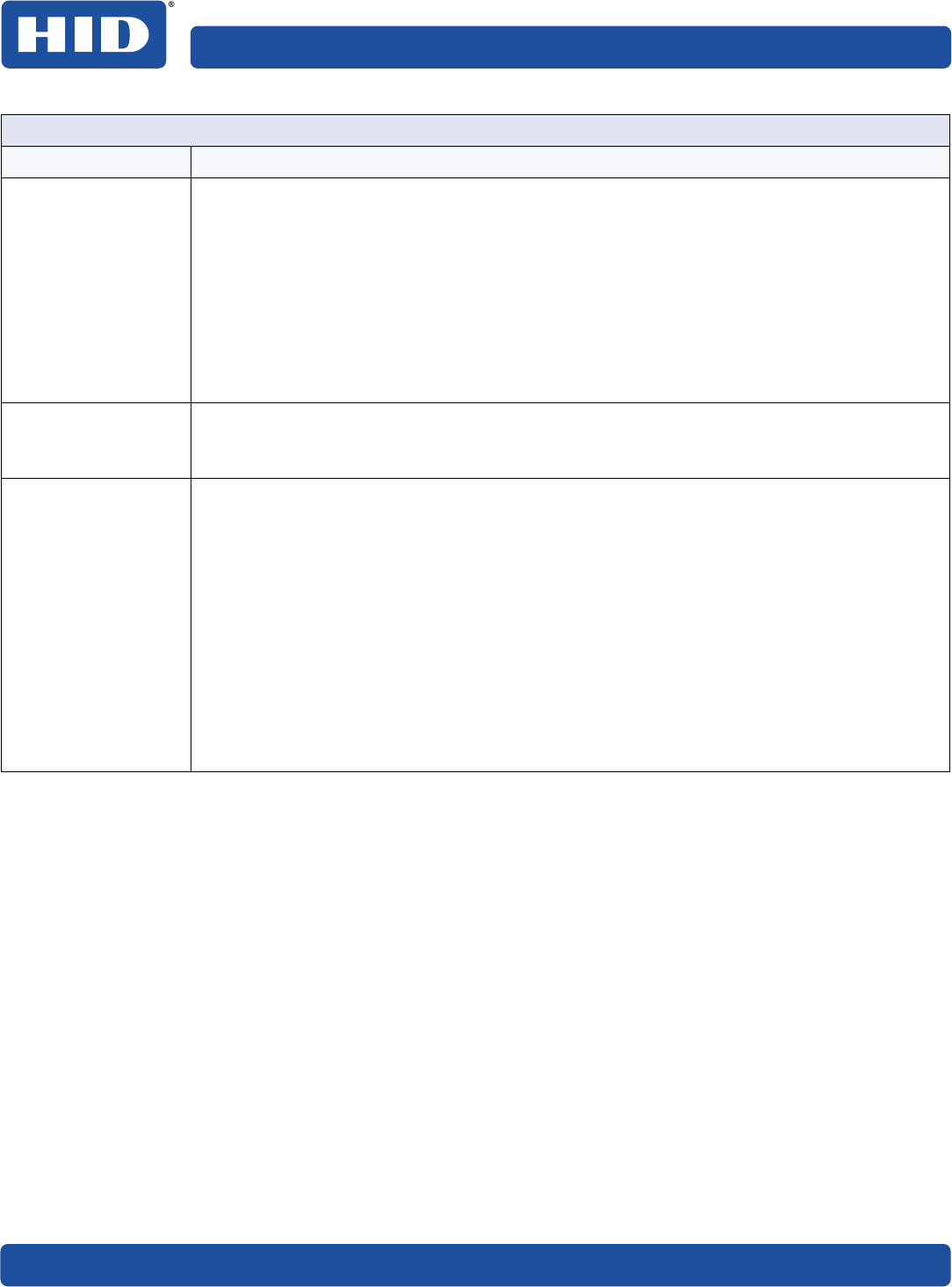
52 September 2018
Printing preferences PLT-02931, Rev. A.0
Use K Resin to Print Black in Images: Prints black in images using K-panel resin (white or color
backgrounds) and automatically selects Print YMC under K Resin.
Print YMC under K Resin: Clear this check box to print black in image using K-panel resin
(white or color backgrounds).
YMC Black Text (Default is K): This option prints black text with YMC instead of K.
K Resin Threshold in Images: When Use K Resin to Print Black in Images is selected, this
option sets the K resin usage limit.
႑Lower limit = 1
႑Upper limit = 255
Default: Click this button to return the listed threshold to the factory setting.
Color Correction Default: Sets the optimal and most accurate color setting for this device.
Legacy: Attempts to duplicate the HDP5000 color settings.
None: Uses the uncorrected output from the printhead.
Defined Areas Adds and removes defined areas for K resin and color correction.
Enable Defined Area: Select the type of area to add. Each defined area is represented by the
following colors:
K Resin:
႑Active: Gray
႑Keep Out: Cyan
Color Correction:
႑Active: Green
႑Keep Out: Yellow
Set Alignment PRN: Click this button to retrieve a saved print file to verify the defined
locations on your card.
Add Area: Defines additional areas. Select K Resin or Color Correction from the drop-down
list.
Print Image
Menu option Description
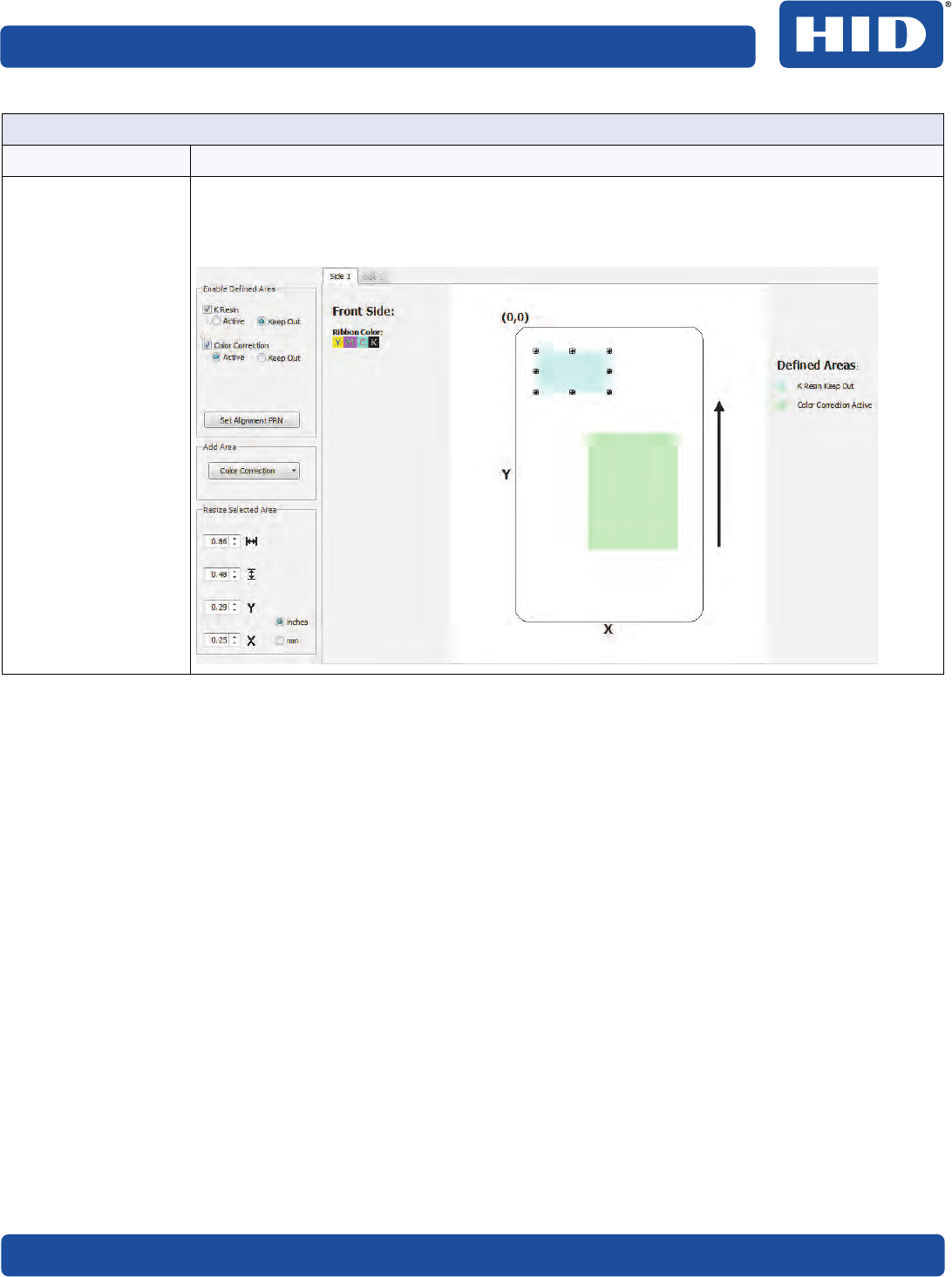
September 2018 53
PLT-02931, Rev. A.0 Printing preferences
Resize Selected Area: Defined areas can be moved or re-sized by selecting the area and either
dragging one of the handles to the desired size or by manually setting the horizontal, vertical,
X, and Y coordinates.
To remove defined areas, select the area and press Delete.
Print Image
Menu option Description
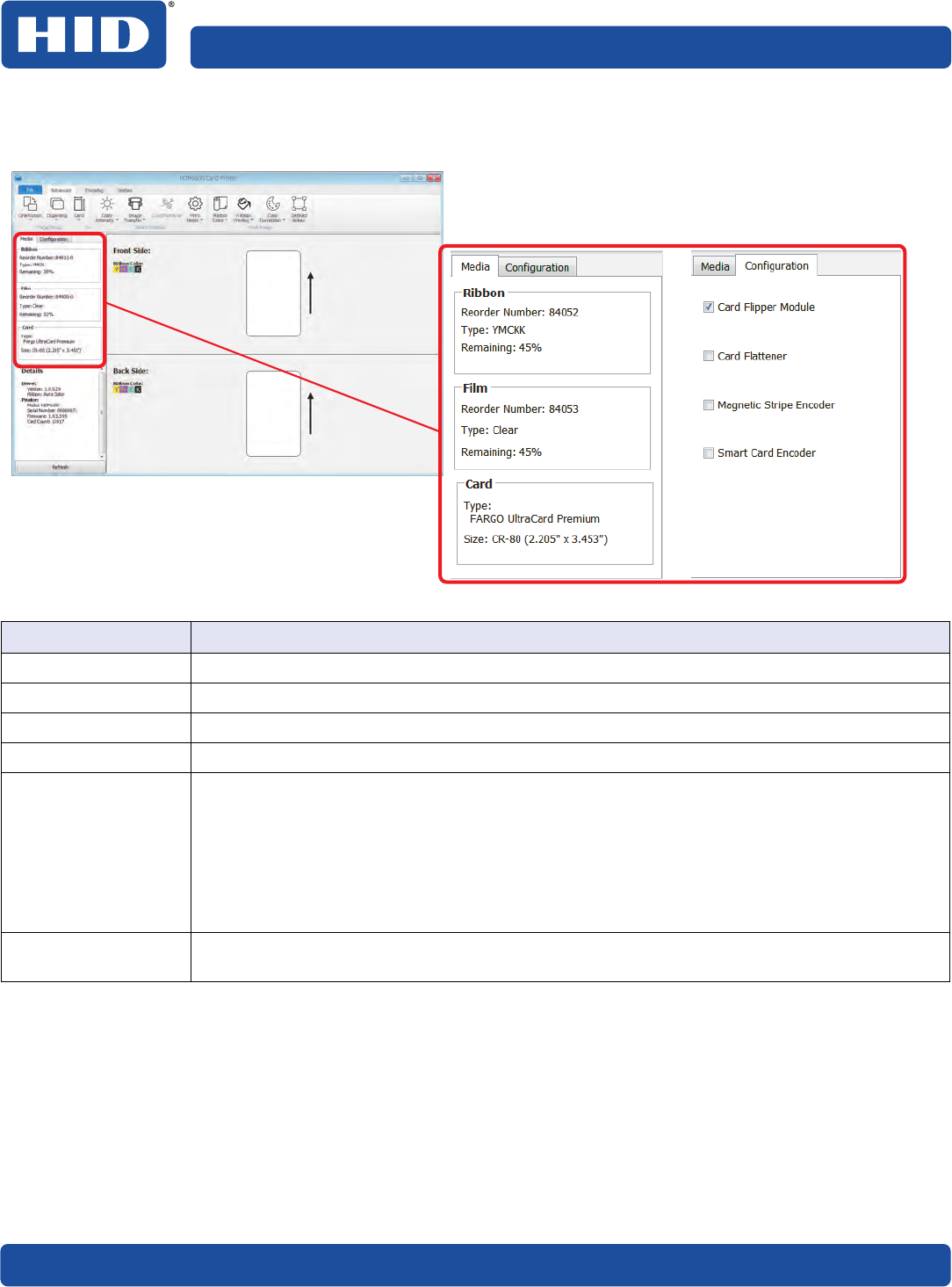
54 September 2018
Printing preferences PLT-02931, Rev. A.0
3.2.1 Information panel
This panel is displayed on the left side of the Advanced, Encoding, and Utilities menu tabs.
Field Definition
Media tab Automatically detects the materials in the printer such as the ribbon, film, and cards.
Ribbon Displays the reorder number, type, and remaining ribbon level detected.
Film Displays the reorder number, type, and remaining film level detected.
Card Displays the card type and card size detected in the printer.
Configuration tab Displays any automatically detected features in your printer. Features are present when check
boxes are selected. If communication with the printer does not exist, these configuration items
can be manually selected. Available options are:
႑Card Flipper Module (dual-sided module)
႑Card Flattener
႑Magnetic Stripe Encoder
႑Smart Card Encoder
Details Displays the driver and printer information. See Section 3.1.5 Details window for a description
of these fields.
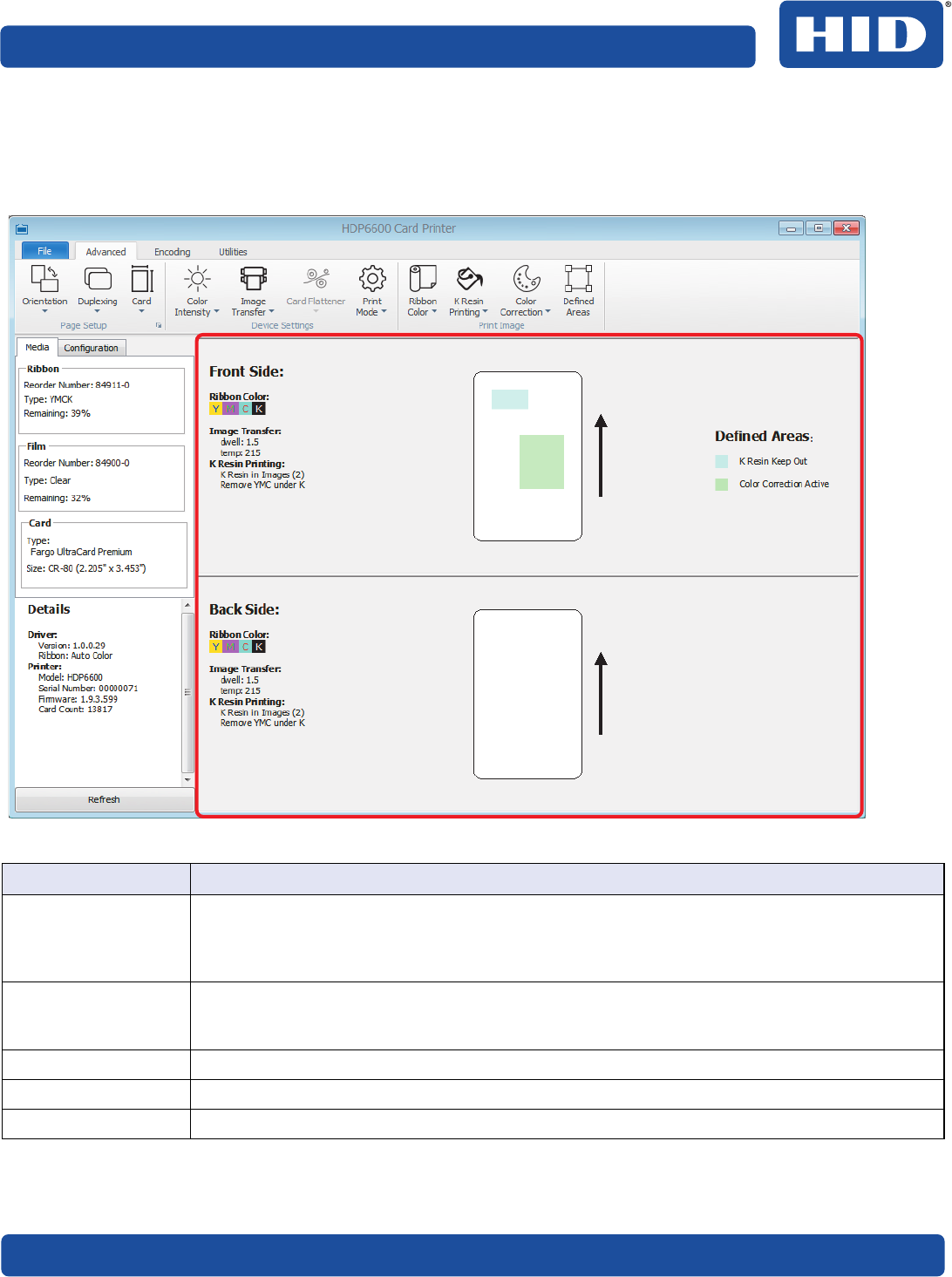
September 2018 55
PLT-02931, Rev. A.0 Printing preferences
3.2.2 Card image area
The card image area displays a representation of the card options currently selected. The options shown
include card side, ribbon color descriptor, image transfer settings, defined areas legend (if specified), and
single-sided or dual-sided print area images.
Field Definition
Front Side/Back Side Displays a single- or dual-sided card in a portrait or landscape orientation. This is determined
by the selections made in the Page Setup area on the Advanced tab. If Single Sided is selected,
this window displays all fields for Front Side. If Dual Sided is selected, this window displays all
fields for Front Side and Back Side.
Ribbon Color Displays the color descriptors for the card side. These are the detected ribbon colors. In
addition, objects visually display how the ribbon is split (as shown in Advanced tab > Ribbon
Color).
Image Transfer Displays any customized Image Transfer settings.
K Resin Printing Displays any defined K resin printing areas.
Print Direction Specifies the direction the card travels through the printer.
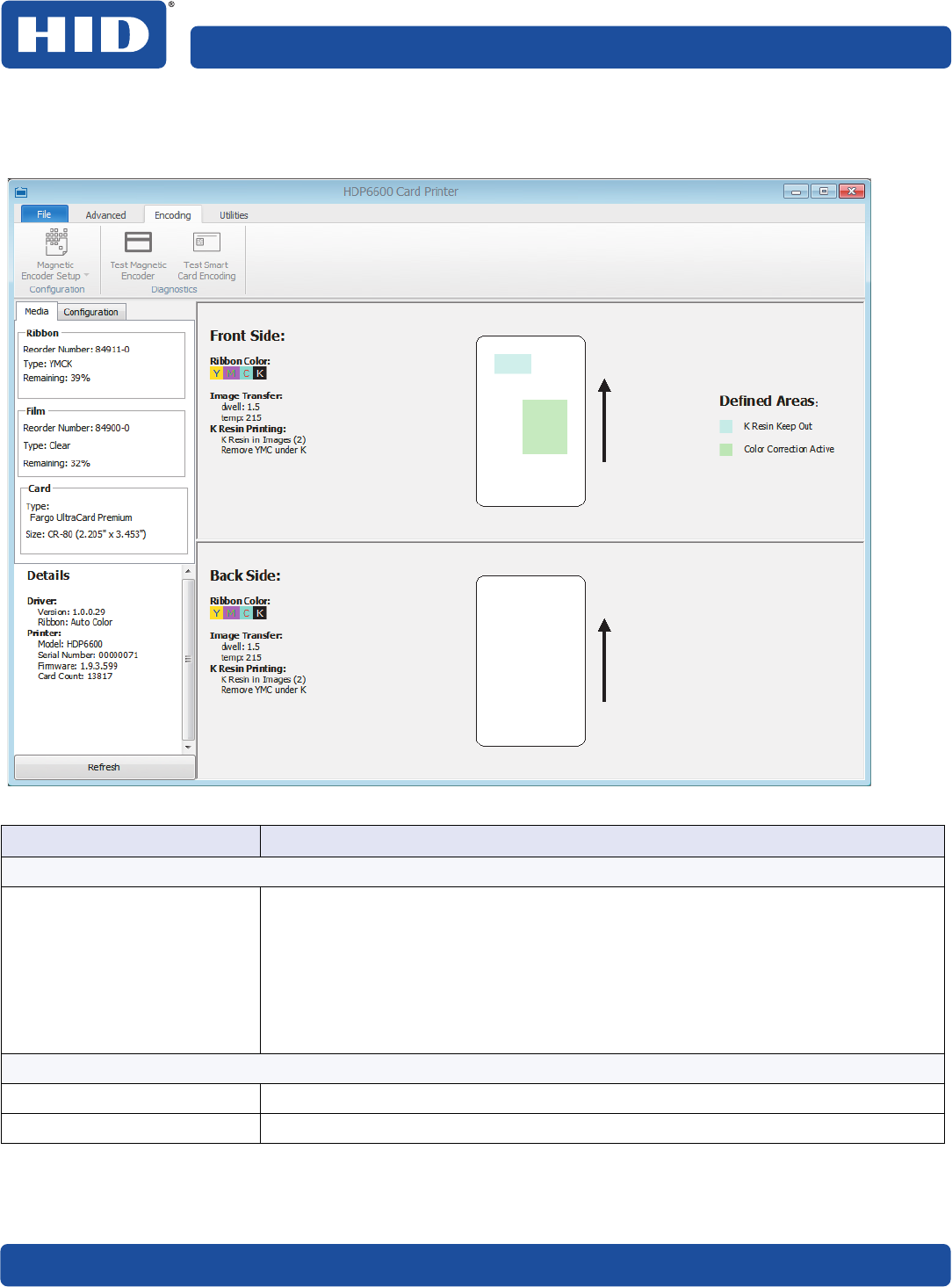
56 September 2018
Printing preferences PLT-02931, Rev. A.0
3.3 Encoding menu tab
This tab contains the options for controlling the magnetic stripe encoding process.
Field Definition
Configuration
Magnetic Encoder Setup Specifies magnetic encoder setup. Available options are:
႑ISO (default)
႑Custom
႑JSII
႑Raw Binary
႑More Settings displays the Mag Encode window.
See Section 3.3.1 Magnetic encoder setup configuration.
Diagnostics
Test Magnetic Encoder Tests magnetic encoder in the printer. See Section 3.3.4 Test magnetic encoder.
Test Smart Card Encoding Tests smart card encoder in the printer. See Section 3.3.5 Test smart card encoding.
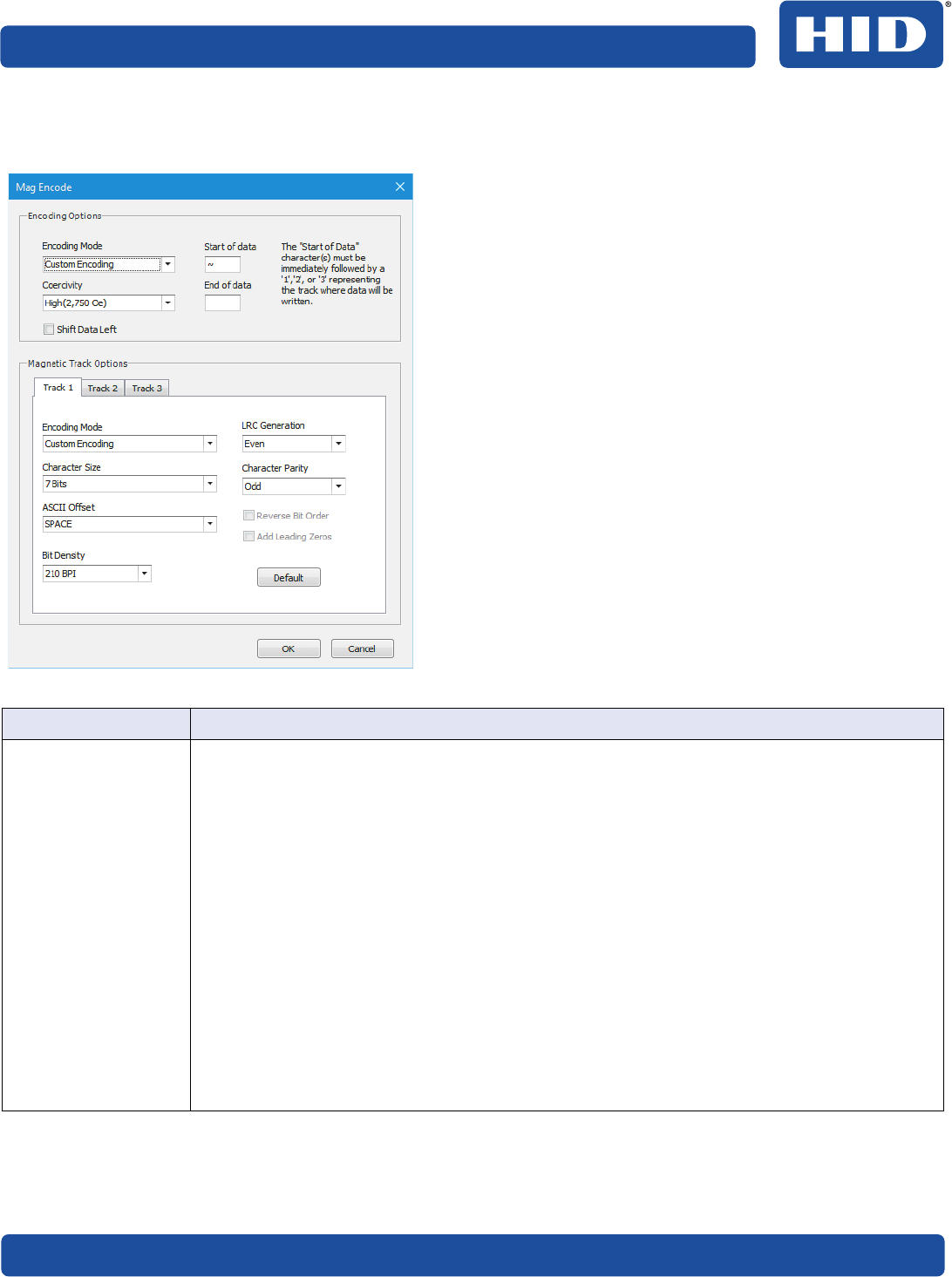
September 2018 57
PLT-02931, Rev. A.0 Printing preferences
3.3.1 Magnetic encoder setup configuration
The Mag Encode window contains options for controlling the magnetic stripe encoding process.
Field Description
Encoding Options Set the Encoding Mode and Coercivity or modify the ISO standards for Tracks 1, 2 and 3.
႑ISO Encoding: sends a formatted set of characters to the encoding module. The
magnetic track tabs are inactive and display ISO defaults for each track. This is the
default. See Section 3.3.2 ISO track locations.
႑Custom Encoding: all magnetic track options are active and can be changed.
႑Raw Binary Encoding: sends a raw binary string rather than a formatted set of
characters to the encoding module. Some magnetic track options are enabled.
႑JIS II Encoding: specific standards are used. The magnetic track tabs are inactive and
display JIS II defaults for each track.
Coercivity: Select the Coercivity option (Oersted [Oe]) for the Magnetic Stripe type for the
Card Type.
႑Super High Coercivity = 4,000 Oe
႑High Coercivity = 2,750 Oe (HID high coercivity UltraCard IIIs are 2750 Oe)
႑Medium Coercivity = 600 Oe
႑Low Coercivity = 300 Oe
Shift Data Left: This option shifts the recorded magnetic data to the left-hand side of the
magnetic stripe on the card. This is used when cards require insert type readers.
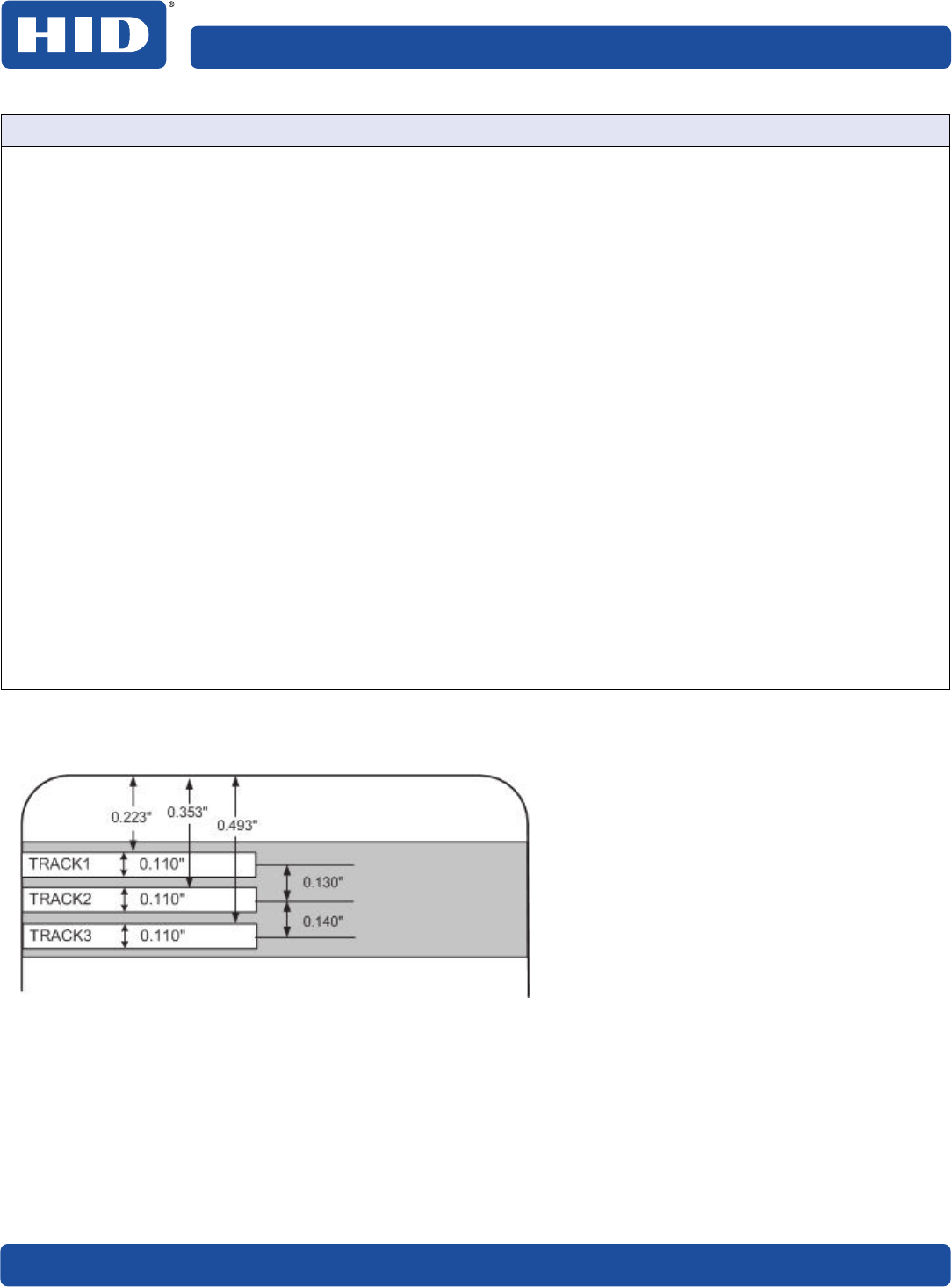
58 September 2018
Printing preferences PLT-02931, Rev. A.0
3.3.2 ISO track locations
The magnetic encoding module encodes onto tracks in accordance with an ISO/IEC 7811-2 magnetic stripe.
Magnetic Track
Options
If these options are enabled, the user can specify how tracks are to be configured. All tracks
display the same options.
Encoding Mode: Displays the encoding mode selected.
Character Size: Sets the character data size (bits per character) used to encode the magnetic
data on the currently selected track.
Note: This character size includes the parity bit (if enabled).
When the drop-down list is enabled, selections vary for the selected encoding mode:
႑Custom encoding: 5 and 7 bits
႑Raw binary encoding: 4 and 8 bits
ASCII Offset: Sets the character ASCII offset used to encode the magnetic data on the
currently selected track. Options are: NULL, SPACE, and ZERO.
Note: This character-offset value is subtracted from the ASCII value of each magnetic stripe
data character prior to encoding on the track.
Bit Density: Sets the bit recording density (bits per inch) used to encode the magnetic data on
the currently selected track. Options are: 75 and 210 BPI.
LRC Generation: Sets the LRC generation mode used to encode the magnetic data on the
currently selected track. Options are: No LRC, Even Parity, and Odd Parity.
Character Parity: Sets the encoding mode used to encode the magnetic data on the currently
selected track. Options are: No Parity, Even Parity, and Odd Parity.
Reverse Bit Order: This option is used to reverse the character bits for the encryption of data
in specific programs.
Add Leading Zeros: This option is used to add a set number of leading zeros to the magnetic
string to move the starting point of the encoded data in specific programs for encryption of
data.
Default: Resets defaults for the current track.
Field Description
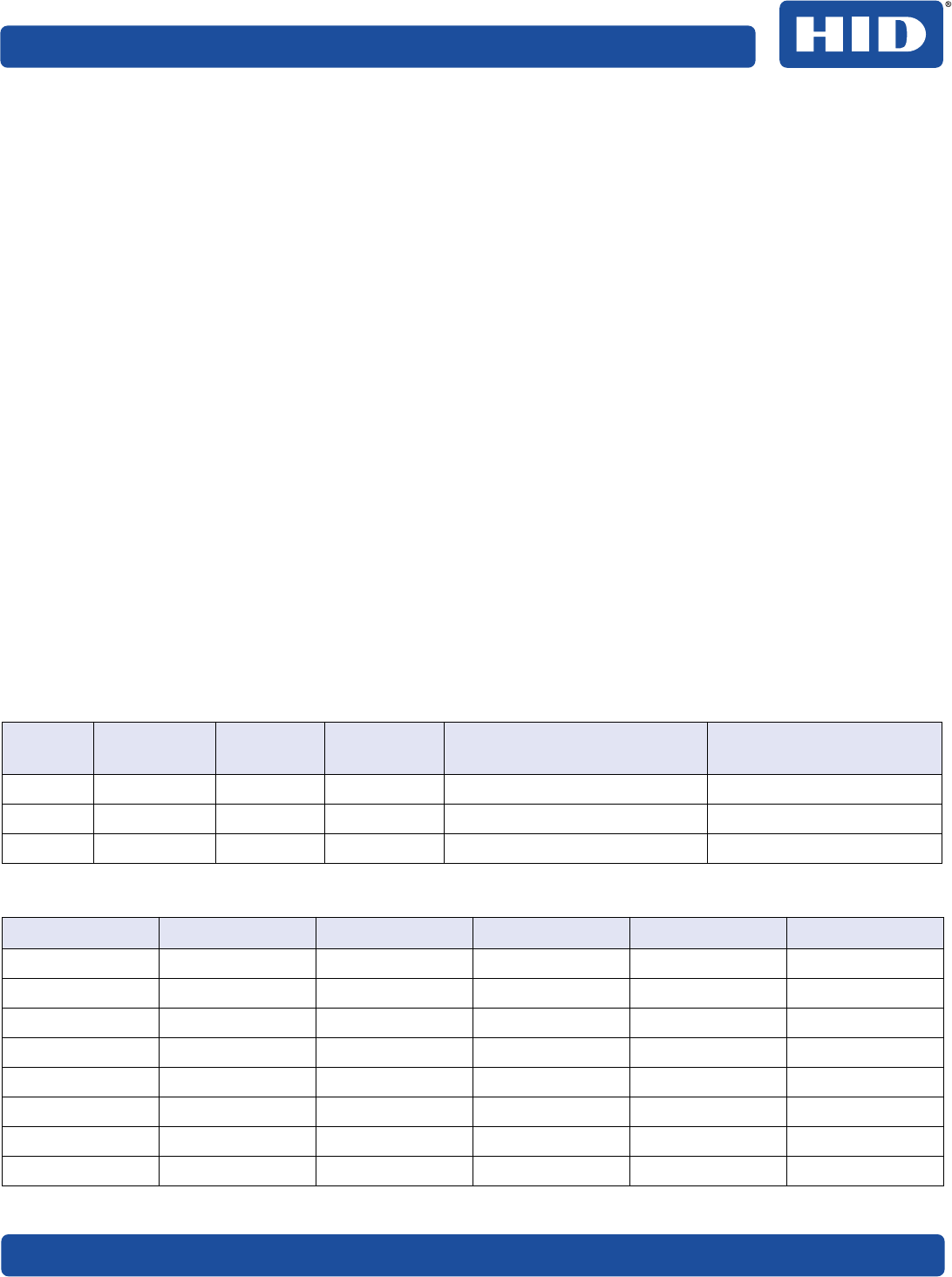
September 2018 59
PLT-02931, Rev. A.0 Printing preferences
3.3.3 Sending track information
Magnetic track data is sent in the form of text strings from the application software to the printer driver.
The printer driver must be able to differentiate between magnetic track data and the rest of the printable
objects, specific characters must be added to encode the magnetic data. These characters specify the data
that is to be encoded, the tracks to encode, and marks the start and stop of the data string.
In some cases, these specific characters are automatically added to the string of track data by ID software
applications.
In most cases the user must carefully add these characters to the string of data. If these characters are not
added to the track data, the text intended for the magnetic track appears as printed text on the card. To
avoid this, track information must be entered as described here.
When entering track data, the ~ (tilde) character is entered first, followed by the track number (1, 2 or 3) on
which the data should encode. This is followed by the data to be encoded.
The first character of this data string must be the track's specific Start Sentinel (SS) and the last character
must be the specific End Sentinel (ES).
The characters or data in between the SS and ES can include all of the valid characters specific to each track.
႑The number of these characters, however, is limited by each track's maximum character capacity.
႑When segmenting track data, the appropriate Field Separator (FS) must be used. The ASCII code and
character table shows the SS, ES, FS and the valid characters defined for each track.
Reviewing the sample string
Track 1: ~1%JULIEANDERSON^1234567890?
Track 2: ~2;1234567890987654321?
Track 3: ~3;1234567890987654321?
ASCII code and character table
Track Start
Sentinel
End
Sentinel
Field
Separator
Valid Characters Maximum Number of
Characters
Track 1 % ? ^ ASCII 32–95 (See the table) 78
Track 2 ; ? = ASCII 48–63 (See the table) 39
Track 3 ; ? = ASCII 48–63 (See the table) 106
ASCII Code Character ASCII Code Character ASCII Code Character
32 space 54 6 76 L
33 ! 55 7 77 M
34 56 8 78 N
35 # 57 9 79 O
36 $ 58 : 80 P
37 % 59 ; 81 Q
38 and 60 < 82 R
39 ‘ 61 = 83 S
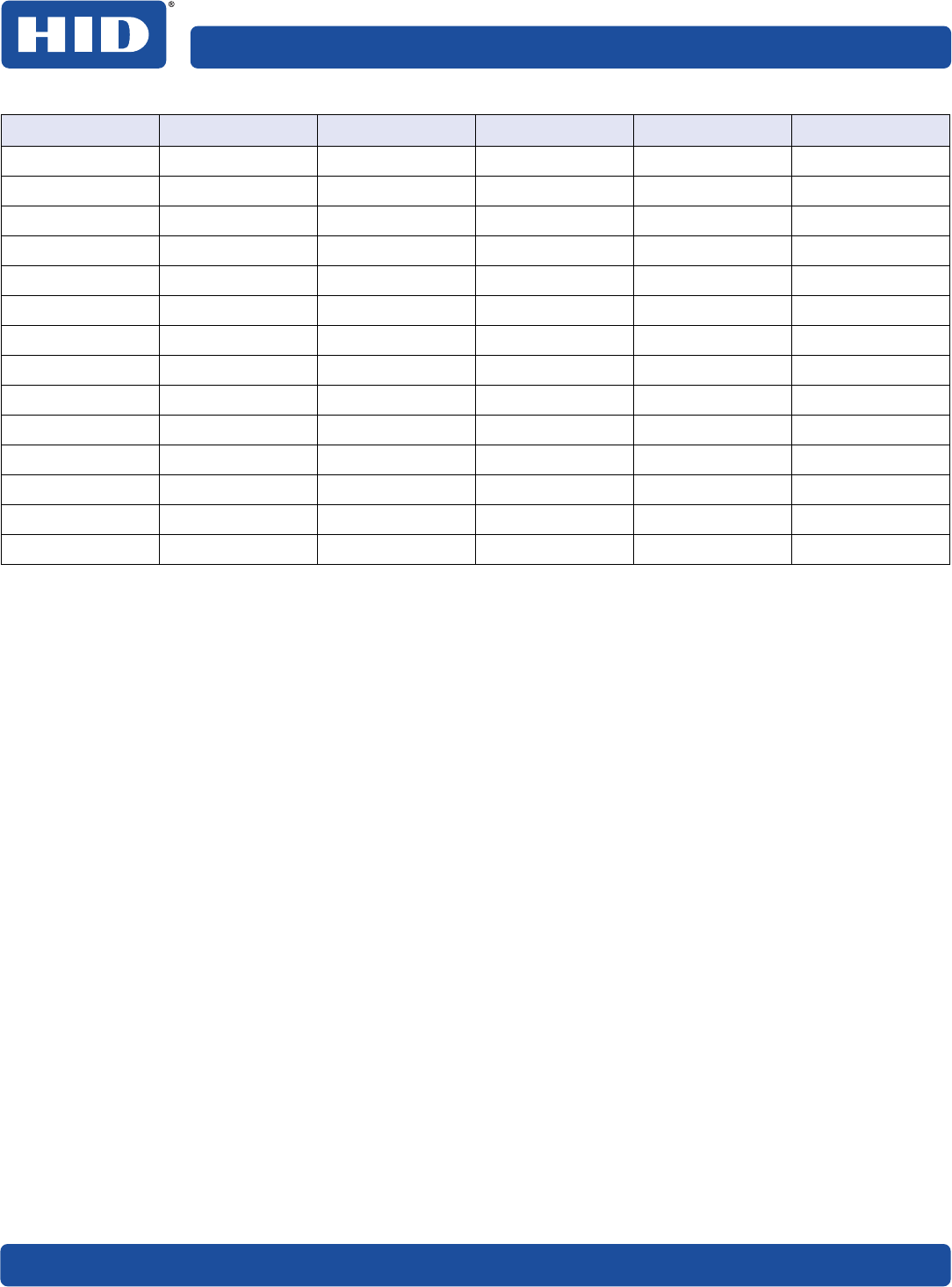
60 September 2018
Printing preferences PLT-02931, Rev. A.0
40 ( 62 > 84 T
41 ) 63 ? 85 U
42 * 64 @ 86 V
43 + 65 A 87 W
44 ‘ 66 B 88 X
45 - 67 C 89 Y
46 . 68 D 90 Z
47 / 69 E 91 [
48 0 70 F 92 \
49 1 71 G 93 ]
50 2 72 H 94 ^
51 3 73 I 95 _
52 4 74 J
53 5 75 K
ASCII Code Character ASCII Code Character ASCII Code Character
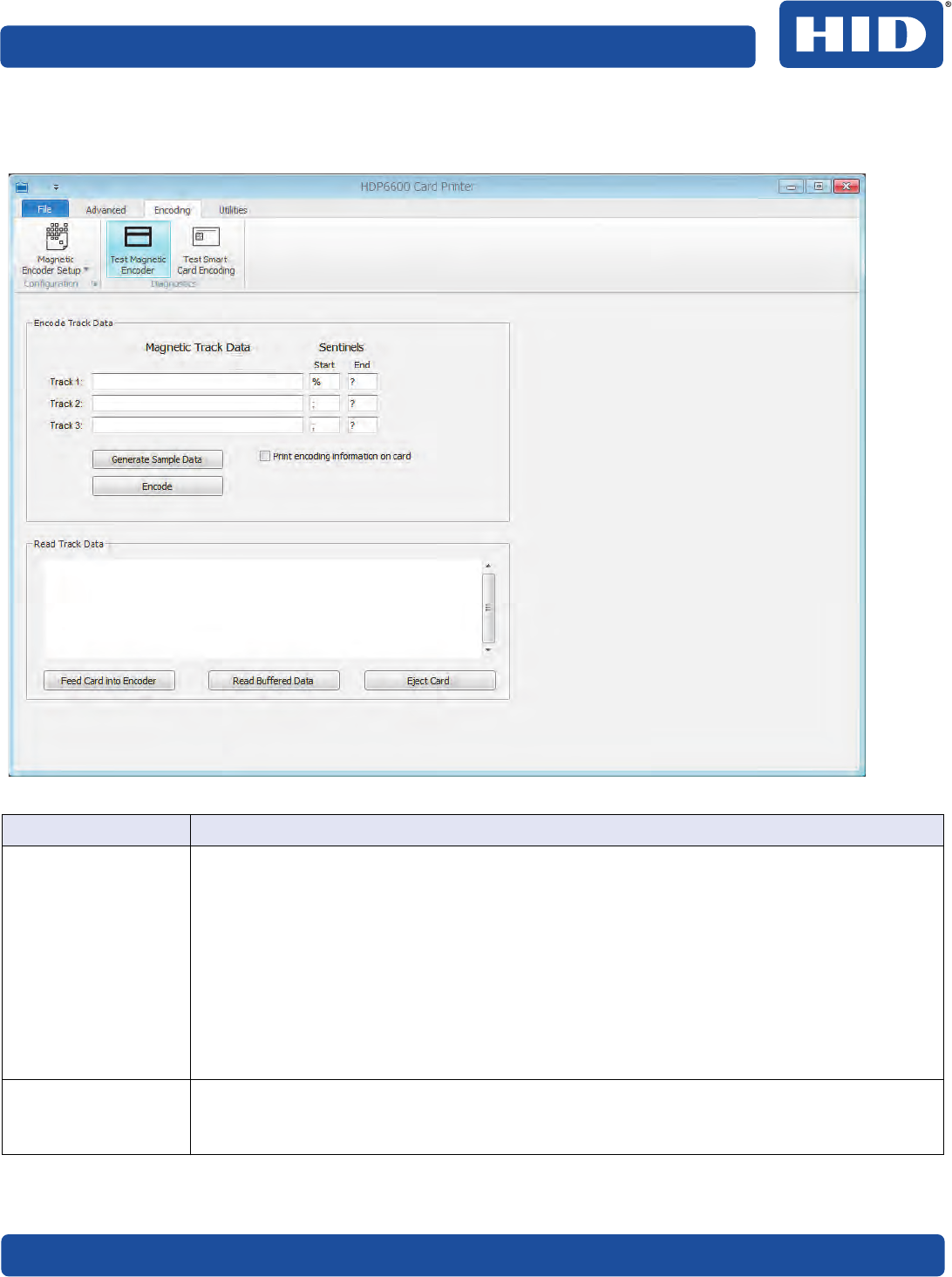
September 2018 61
PLT-02931, Rev. A.0 Printing preferences
3.3.4 Test magnetic encoder
Exercises the printer’s magnetic encoding functionality independent of image or application.
Field Description
Encode Track Data Magnetic Track Data:
႑Track 1:
႑Track 2:
႑Track 3:
Sentinels:
႑Start:
႑End:
General Sample Data:
Encode:
Print encoding information on card:
Read Track Data Feed Card into Encoder:
Read Buffered Data:
Eject Card:
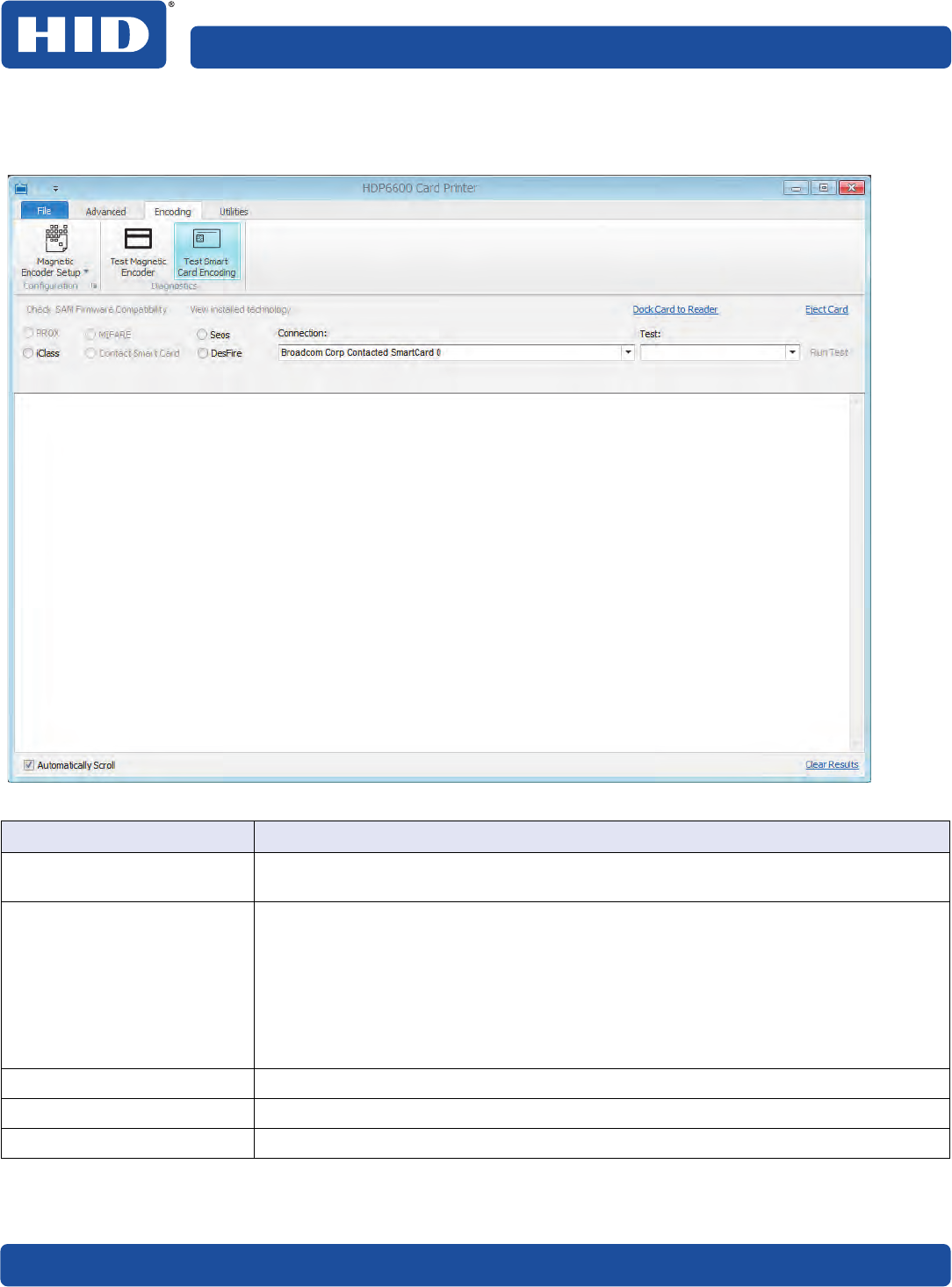
62 September 2018
Printing preferences PLT-02931, Rev. A.0
3.3.5 Test smart card encoding
Provides the ability to test the smart card encoder in the printer.
Field Description
Check SAM Firmware
Compatibility
View installed technology Available options are:
႑PROX
႑iCLASS/iCLASS SE
႑MIFARE
႑Contact Smart Card
႑Seos
႑DesFire
Dock Card to Reader Select this link to instruct the printer to dock the card to the magnetic encoder.
Eject Card Select this link after the test has been performed to eject the card from the printer.
Connection Select the type of encoder from the list.
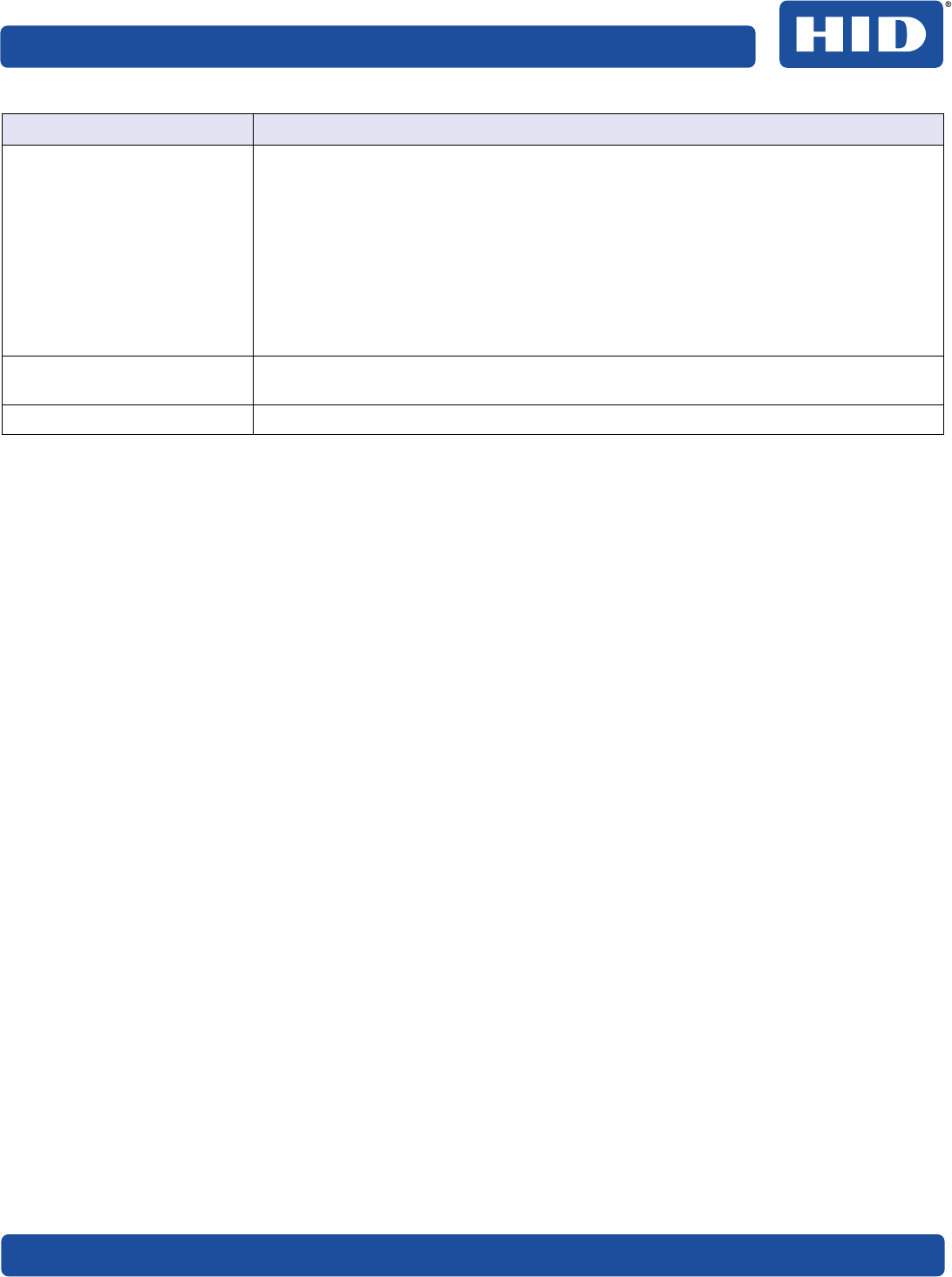
September 2018 63
PLT-02931, Rev. A.0 Printing preferences
Test Select the test you wish to run. Available options are:
႑Perform Reader Test
႑Get Vendor Name
႑Get Vendor IFD Version
႑Get Vendor IFD Type
႑Get Reader System Name
႑Get Reader Friendly Name
႑Get Reader Max Data Rate
Click Run Test to perform the test.
Automatically Scroll Select this box to allow the test results in the status window to automatically scroll as
new information is obtained.
Clear Results Select this link to clear the test results in the status window.
Field Description
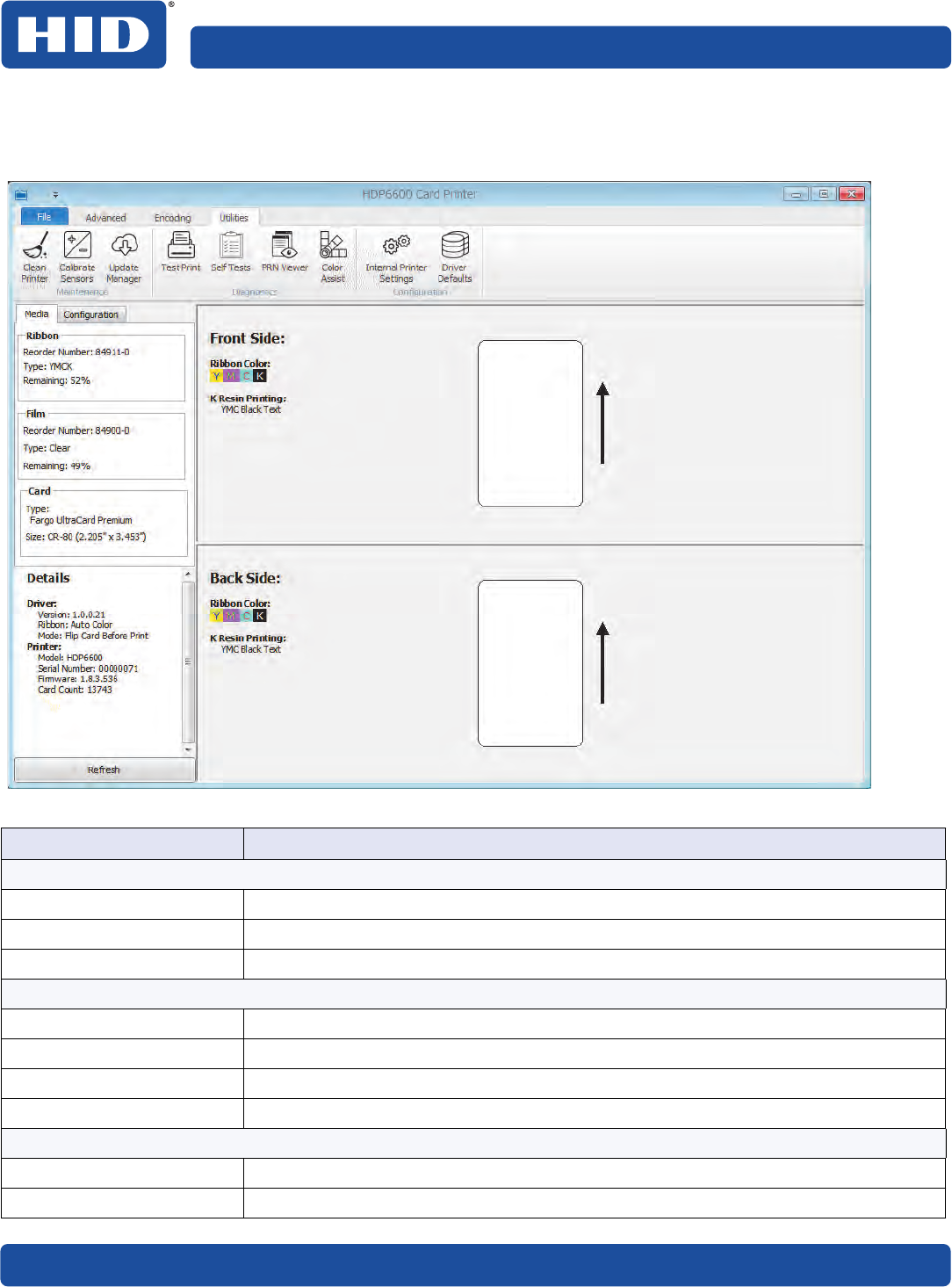
64 September 2018
Printing preferences PLT-02931, Rev. A.0
3.4 Utilities tab
This tab provides several maintenance, diagnostic, and configuration settings for your printer.
Field Definition
Maintenance
Clean Printer Specifies how to clean the printer using a cleaning card.
Calibrate Sensors Specifies how to calibrate the ribbon and film sensors.
Update Manager Checks, manages, and downloads updates for printer firmware and drivers.
Diagnostics
Test Print Sends sample cards to the printer using the current driver settings.
Self Tests Sends commands to activate on-board self-tests in the printer.
PRN Viewer Views a print file (PRN) as an image or send the file to the printer.
Color Assist Create swatches of sample colors that can be printed and used for color matching.
Configuration
Internal Printer Settings Modifies settings stored in the printer.
Driver Defaults Saves and restores printer instance default settings.
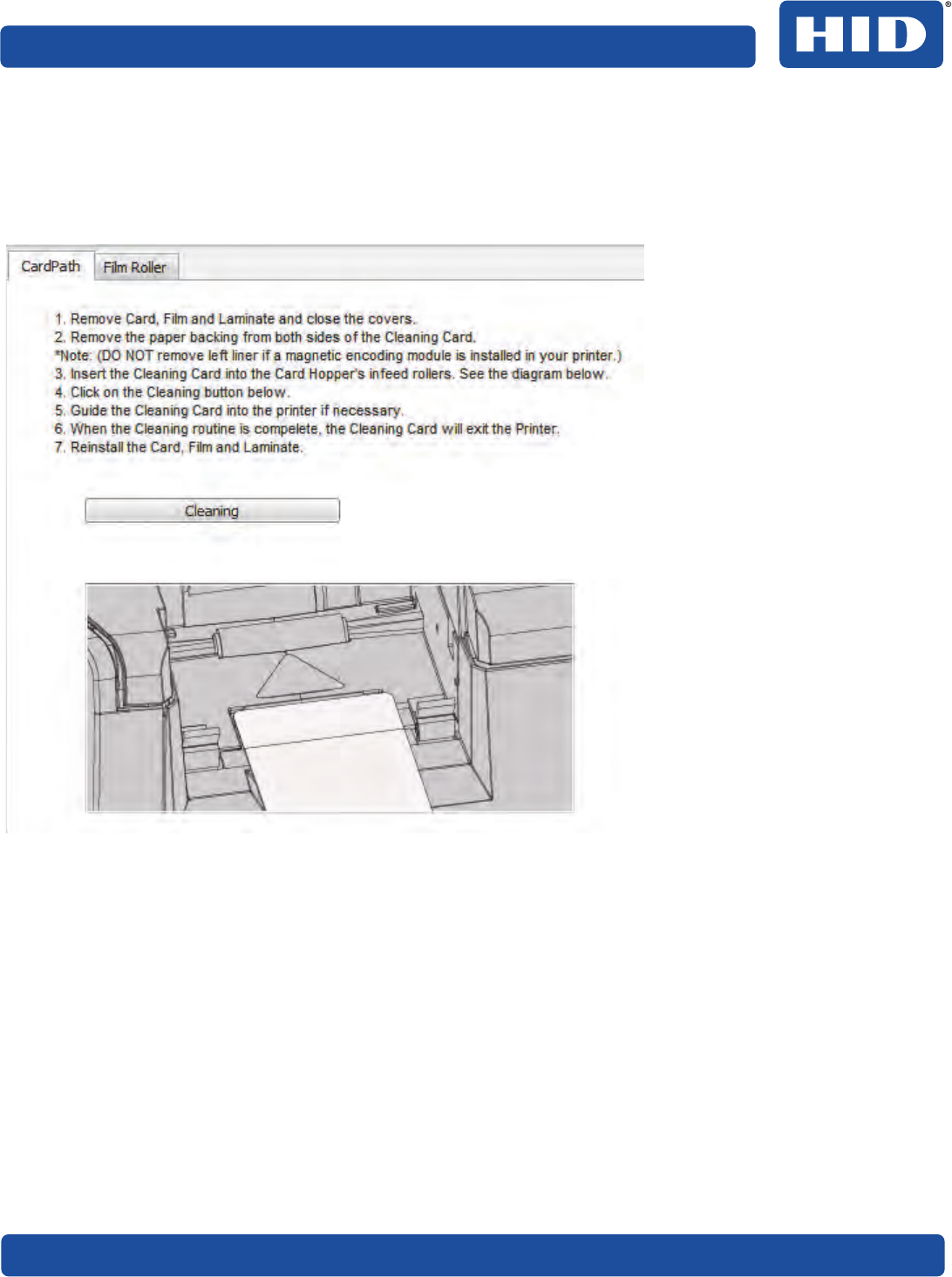
September 2018 65
PLT-02931, Rev. A.0 Printing preferences
3.4.1 Clean printer
Follow the instructions on the page to clean the printer. The cleaning routine begins after all current print jobs
have completed.
The CardPath option sends the cleaning routine to the printer. Follow the instructions on the page to clean
the card path.
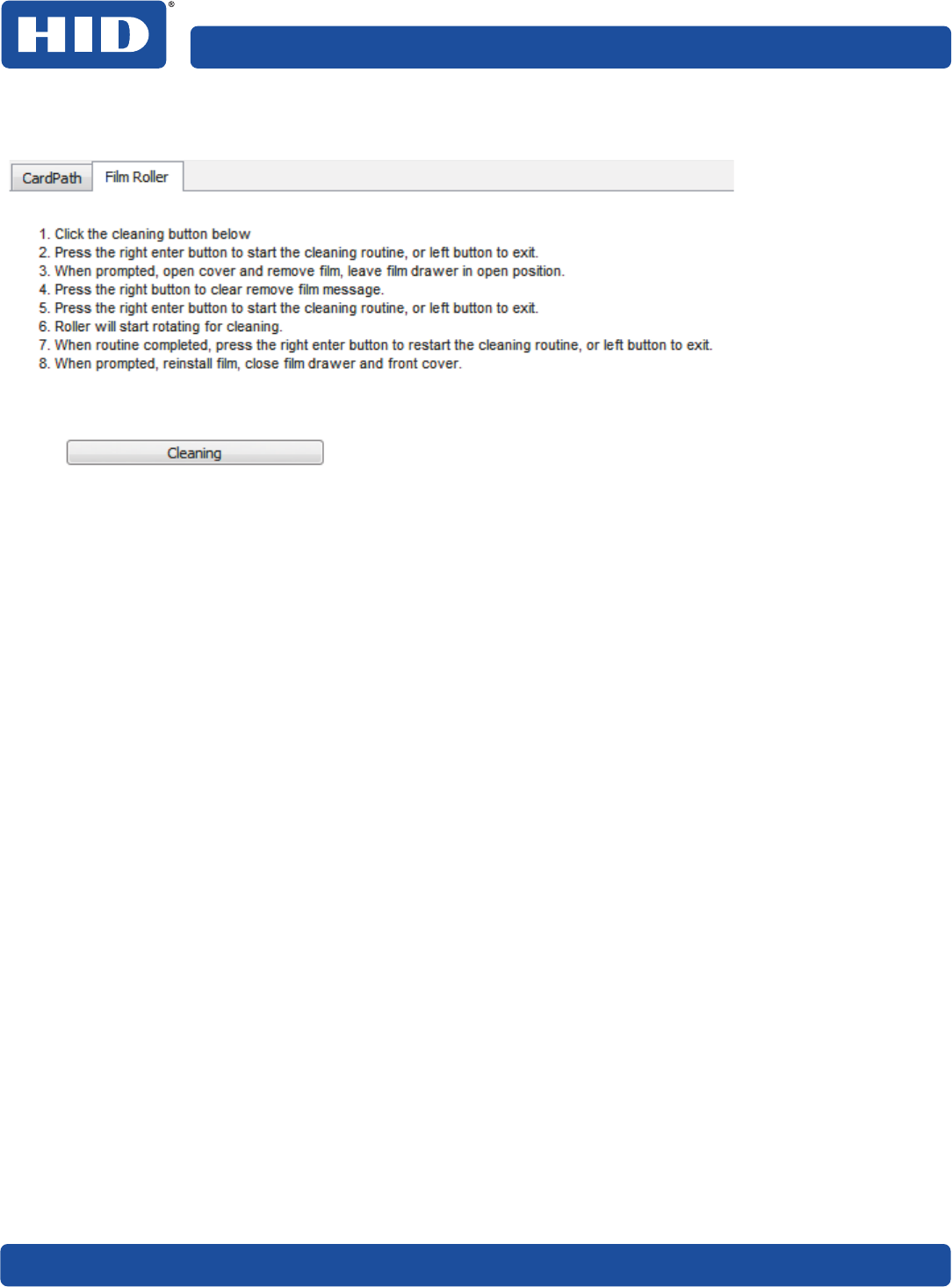
66 September 2018
Printing preferences PLT-02931, Rev. A.0
The Film Roller option sends the cleaning routine to the printer. Follow the instructions on the page to clean
the film roller.
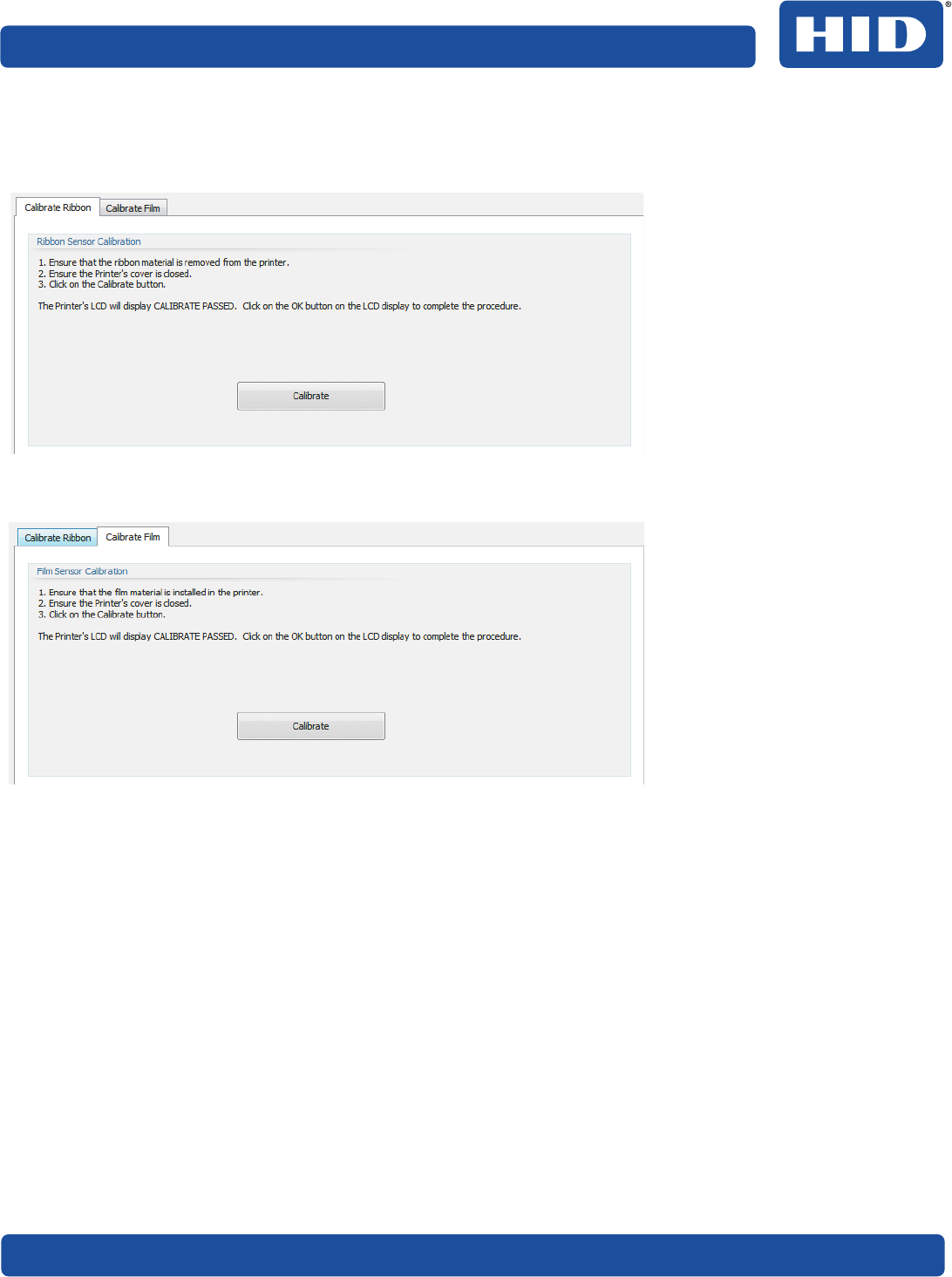
September 2018 67
PLT-02931, Rev. A.0 Printing preferences
3.4.2 Calibrate sensors
The Calibrate Ribbon option sends the calibrate ribbon command to the printer. Follow the instructions on
the page for calibration of the ribbon sensor.
The Calibrate Film option sends the calibrate film command to the printer. Follow the instructions on the
page for calibration of the film sensor.
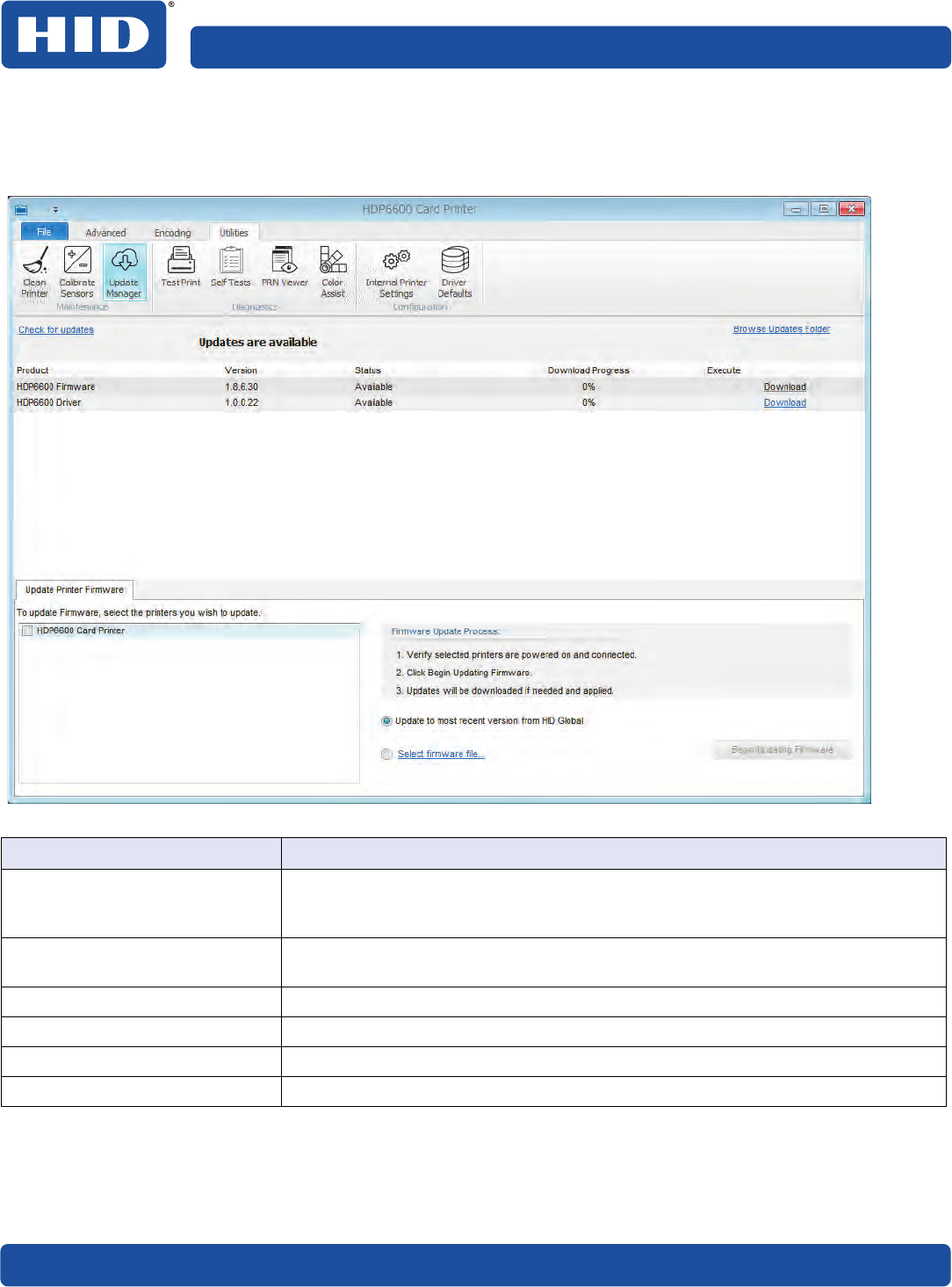
68 September 2018
Printing preferences PLT-02931, Rev. A.0
3.4.3 Update manager
This selection allows you to check, manage, browse, and download updates for printer firmware and drivers. Each update
is identified by product, version, status, and download progress.
Field Description
Check for updates Click this link to check for any available firmware and printer driver updates.
Available updates are displayed by product, version, status, and download
progress.
Browse Updates Folder Opens a window to browse the updates folders stored on your PC or available
network.
Update Printer Firmware tab Lists available HID printers connected to your computer.
Firmware Update Process Describes the steps to update your printer firmware.
Select firmware file Opens a window to browse for saved firmware files.
Begin Updating Firmware Click this button to begin updating the firmware on the selected printer.
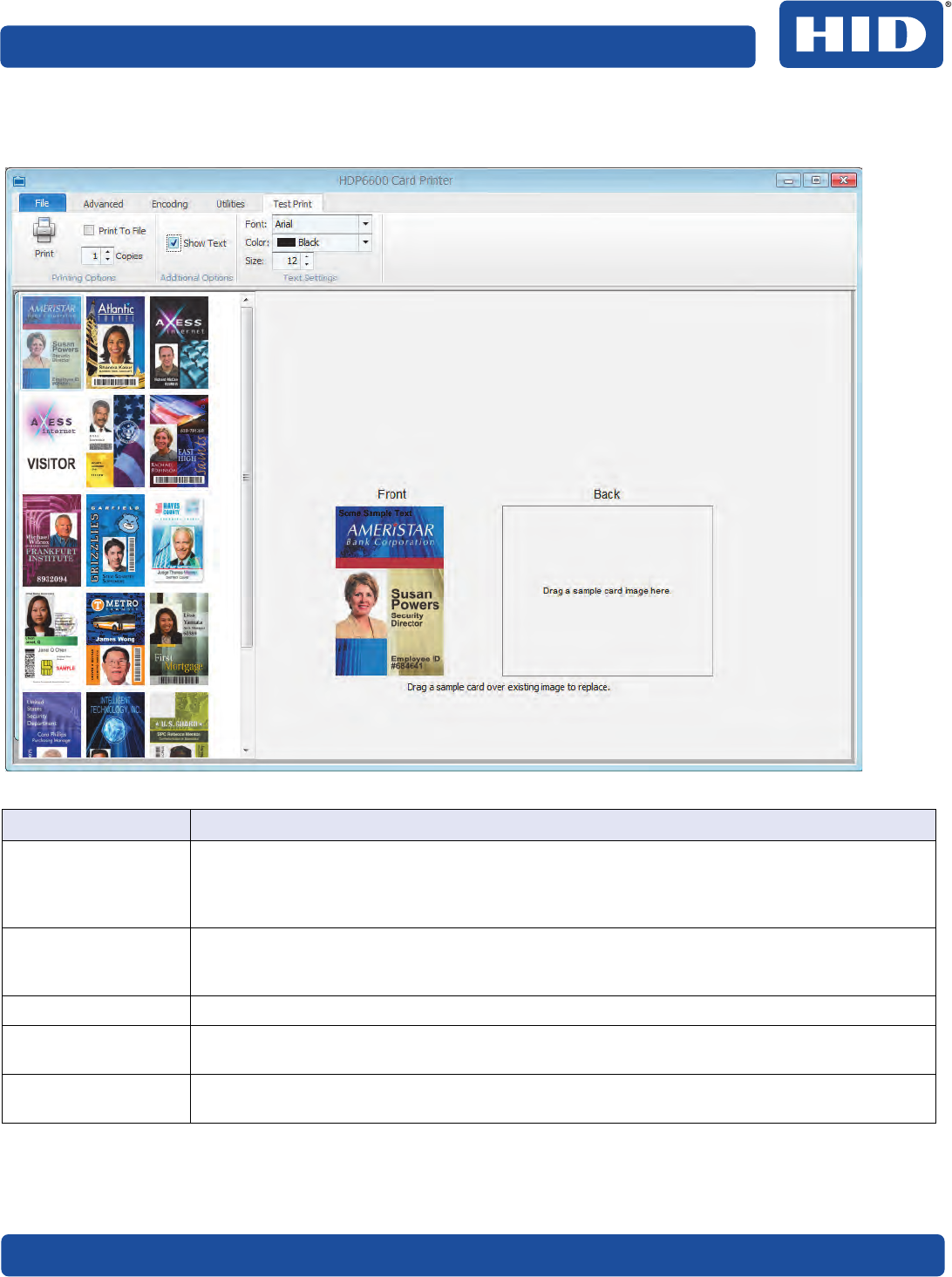
September 2018 69
PLT-02931, Rev. A.0 Printing preferences
3.4.4 Test print
Print a sample card based on the selected settings.
Field Description
Front Click and drag a sample card from the left side of the screen to the card outline on the right
side of the screen. Cards images can be changed by dragging additional sample cards to the
existing image. If a dual-sided module is detected, a Back card outline is displayed. Card
images are displayed according to the orientation set on the Advanced tab.
Print Once a sample card is selected, click this icon to print the sample card. If the Print To File
check box is selected, this option opens a new window to specify the file location and file
name.
Print To File Saves the sample card image as a .prn file.
Copies Sets the number of sample cards to print. Use the arrows to specify the number of cards to
print. Available values are 1-99.
Show Text Select this option to display Some Sample Text at the top of the sample card. When this
option is selected, the Font, Color, and Size options can be adjusted.
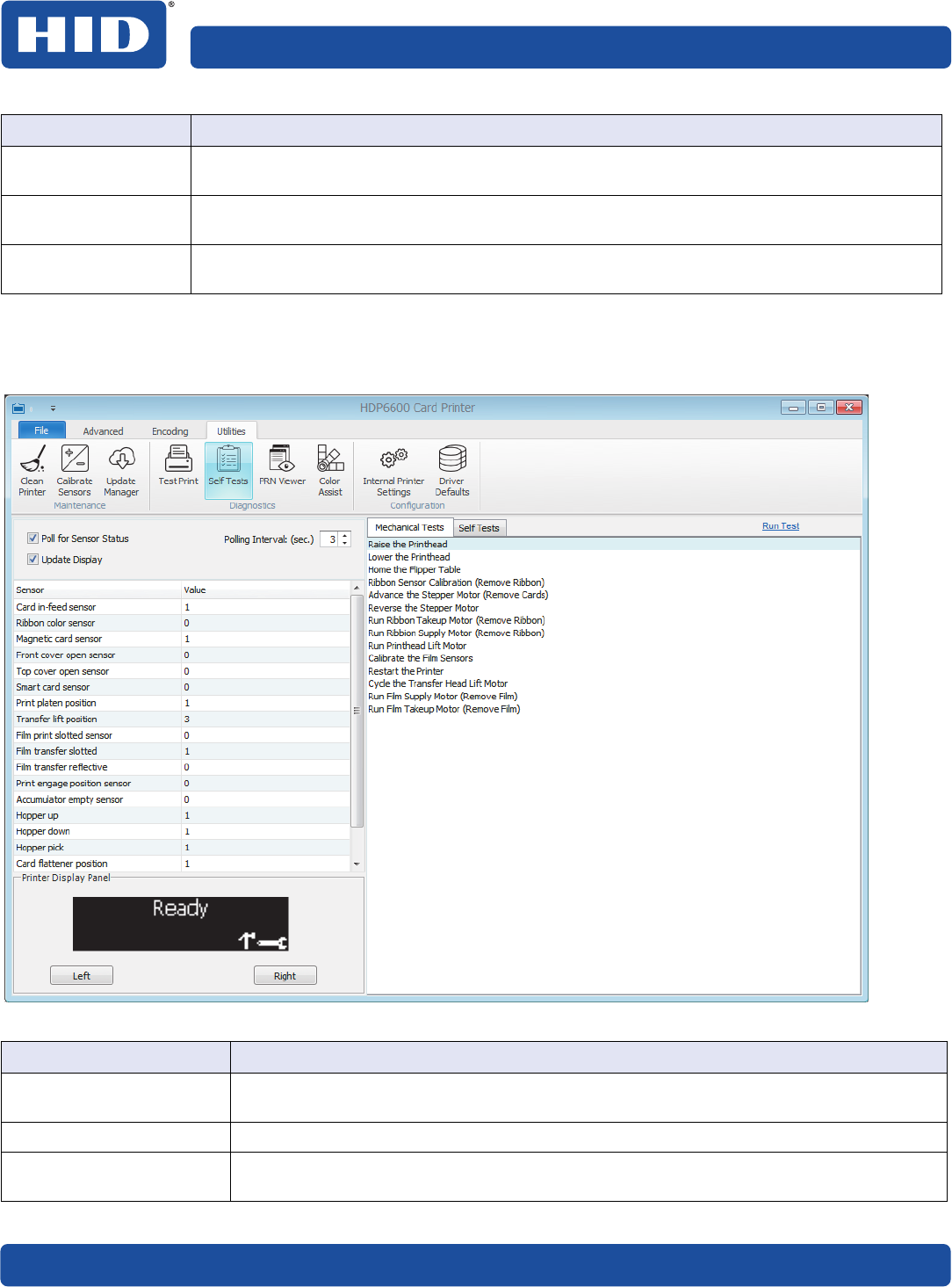
70 September 2018
Printing preferences PLT-02931, Rev. A.0
3.4.5 Self tests
Provides the ability to run control feature commands resident in the firmware to exercise motors and sensors in the
printer. These tests allow you to isolate printer functions and run them to determine operational status.
Font Changes the font of the sample text on the card. This field is available when the Show Text
option is selected.
Color Changes the color of the sample text on the card. This field is available when the Show Text
option is selected.
Size Changes the font size of the sample text on the card. This field is available when the Show
Text option is selected.
Field Description
Poll for Sensor Status When selected, each sensor is checked at the interval specified by the Polling Interval:
(sec.) field.
Update Display When selected, the Printer Display Panel reflects what is shown on the printer display.
Polling Interval: (sec.) Sets the number of seconds to wait before each check of the printer status. Available
values are 1 to 30 seconds.
Field Description
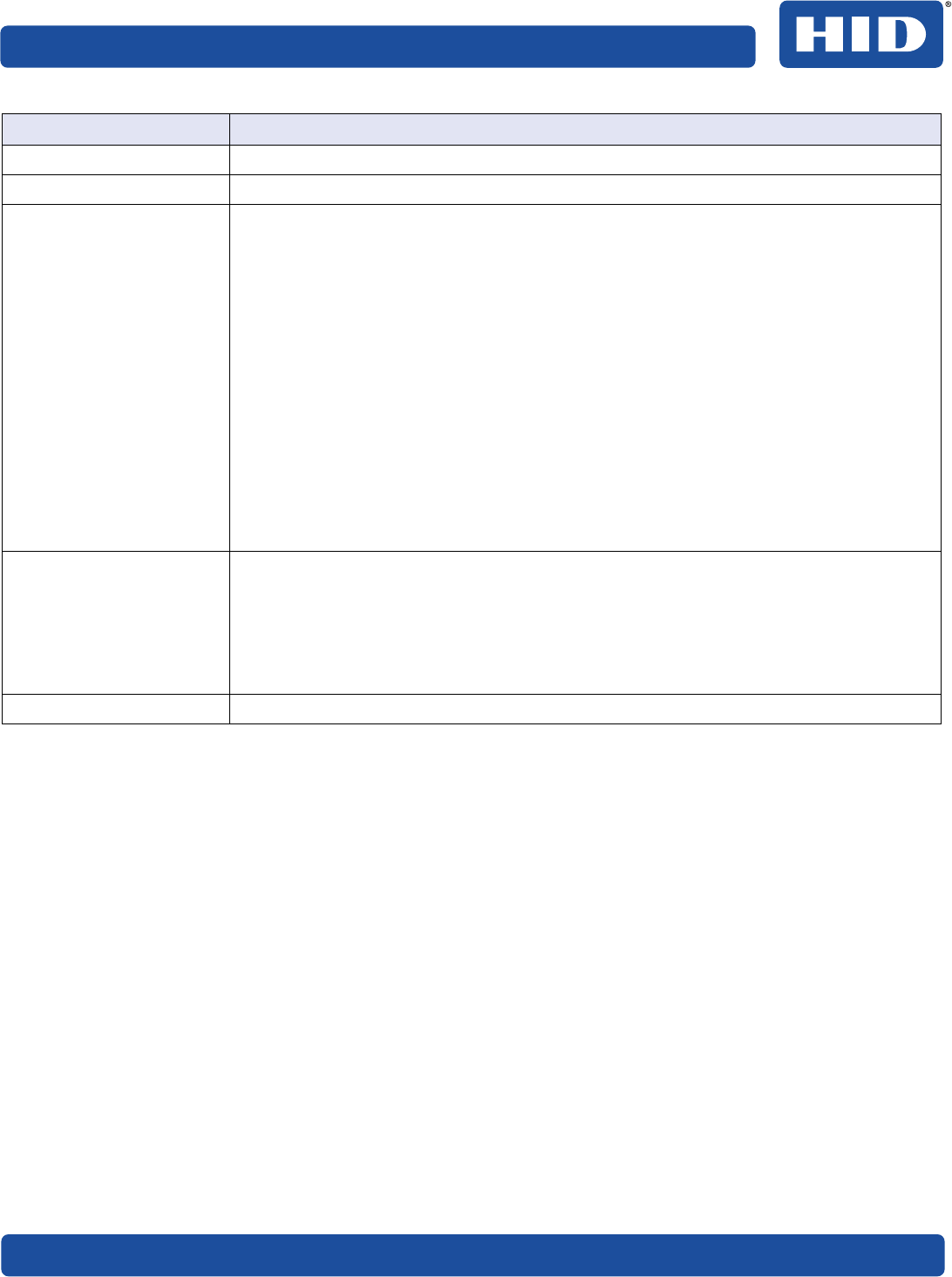
September 2018 71
PLT-02931, Rev. A.0 Printing preferences
Sensor/Value Shows the list of printer sensors and their default values.
Printer Display Panel Shows the current printer display. This window updates as the printer status changes.
Mechanical Tests Lists the available mechanical tests.
႑Raise the Printhead
႑Lower the Printhead
႑Home the Flipper Table
႑Ribbon Sensor Calibration (Remove Ribbon)
႑Advance the Stepper Motor (Remove Cards)
႑Reverse the Stepper Motor
႑Run Ribbon Take-up Motor (Remove Ribbon)
႑Run Ribbon Supply Motor (Remove Ribbon)
႑Run Printhead Lift Motor
႑Calibrate the Film Sensors
႑Restart the Printer
႑Cycle the Transfer Head Lift Motor
႑Run Film Supply Motor (Remove Film)
႑Run Film Take-up Motor (Remove Film)
Self Tests Lists the available tests.
႑Alignment Self Test
႑Device Settings Self Test
႑Resin Self Test
႑Color Photo 1
႑Color Photo 2
Run Test Click this link to run the selected mechanical or self test.
Field Description
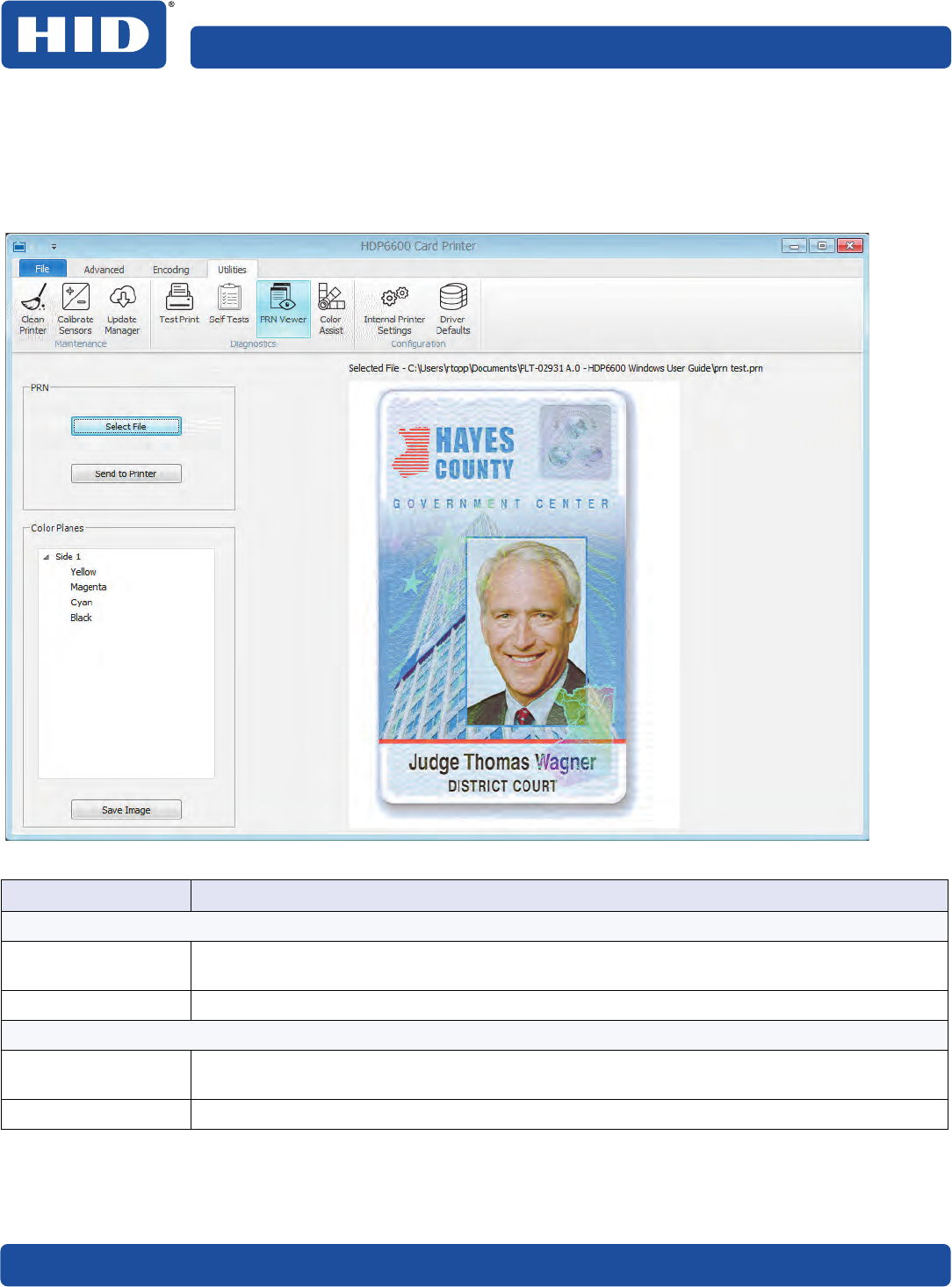
72 September 2018
Printing preferences PLT-02931, Rev. A.0
3.4.6 PRN viewer
The PRN viewer provides the ability to view a print file (PRN) as an image. You can send print files to the
printer to view proper layout, determine if image defects are part of the file going to the printer, and verify
the printer driver settings are the same as the PRN file. You can also print copies of these for samples or
troubleshooting.
Field Description
PRN
Select File Click this button to browse for any saved printer file on your computer. The path and filename
are displayed above the file image.
Send to Printer Click this button to send the file to the printer.
Color Planes
Side 1/Side 2 Open the menu to view each color plane for this card to determine if there are any image
defects.
Save Image Click this button to save any of the color planes as .bmp files.
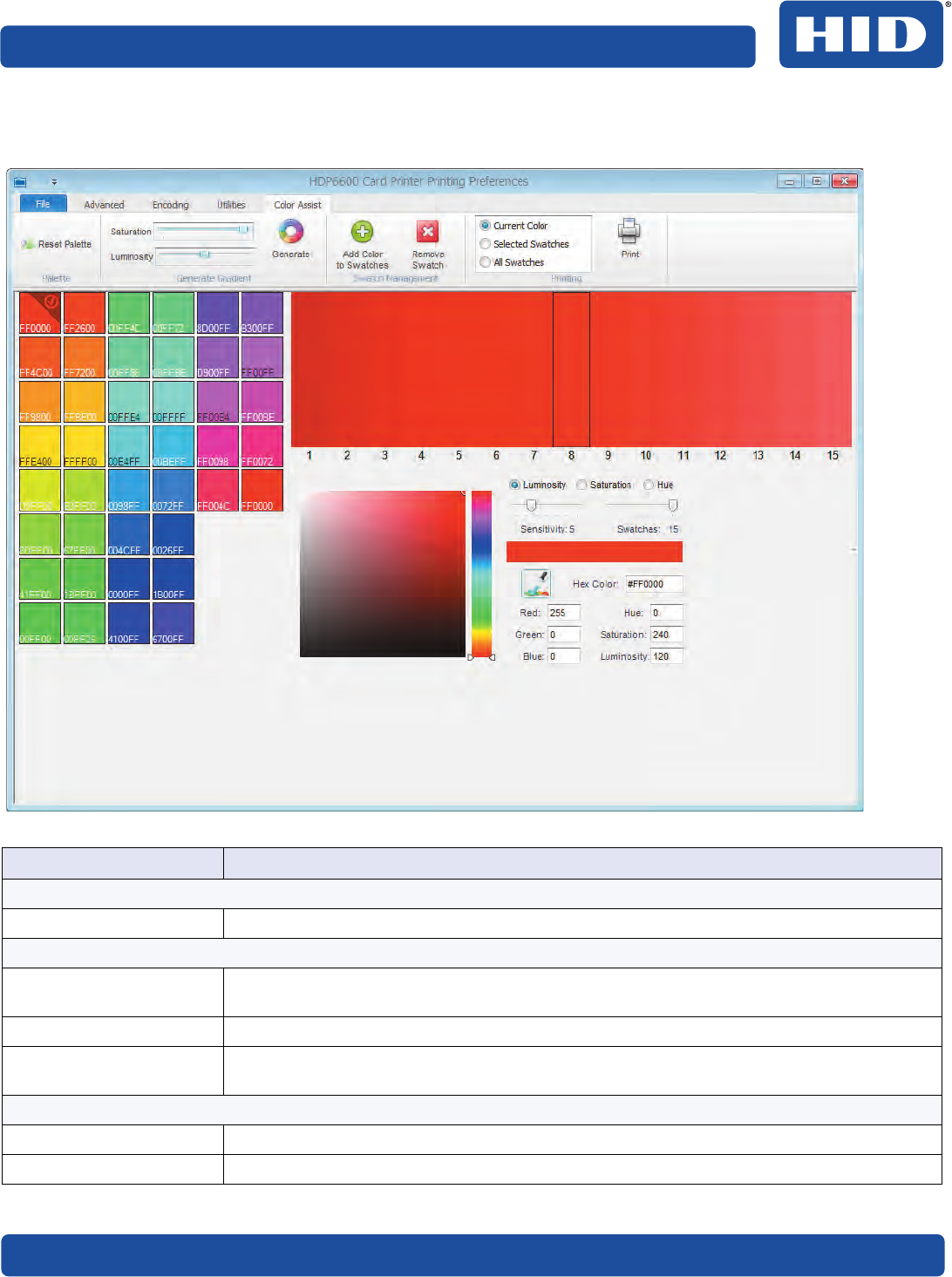
September 2018 73
PLT-02931, Rev. A.0 Printing preferences
3.4.7 Color assist
Opens the Color Assist tab to define the RGB values to accurately depict the colors to print on your cards.
Field Description
Palette
Reset Palette Resets your palette for new or future work.
Generate Gradient
Saturation Adjusts the intensity of the color. As the saturation increases, the colors appear more pure.
As the saturation decreases, the colors appear more washed out gray.
Luminosity Adjusts the brightness with a scale of white to black.
Generate Click this icon to create the color gradient of the swatches based on the Saturation and
Luminosity selected.
Swatch Management
Add Color to Swatches Click this icon to add the selected color to the visual list of color swatches.
Remove Swatch Click this icon to remove the selected color from the visual list of color swatches.
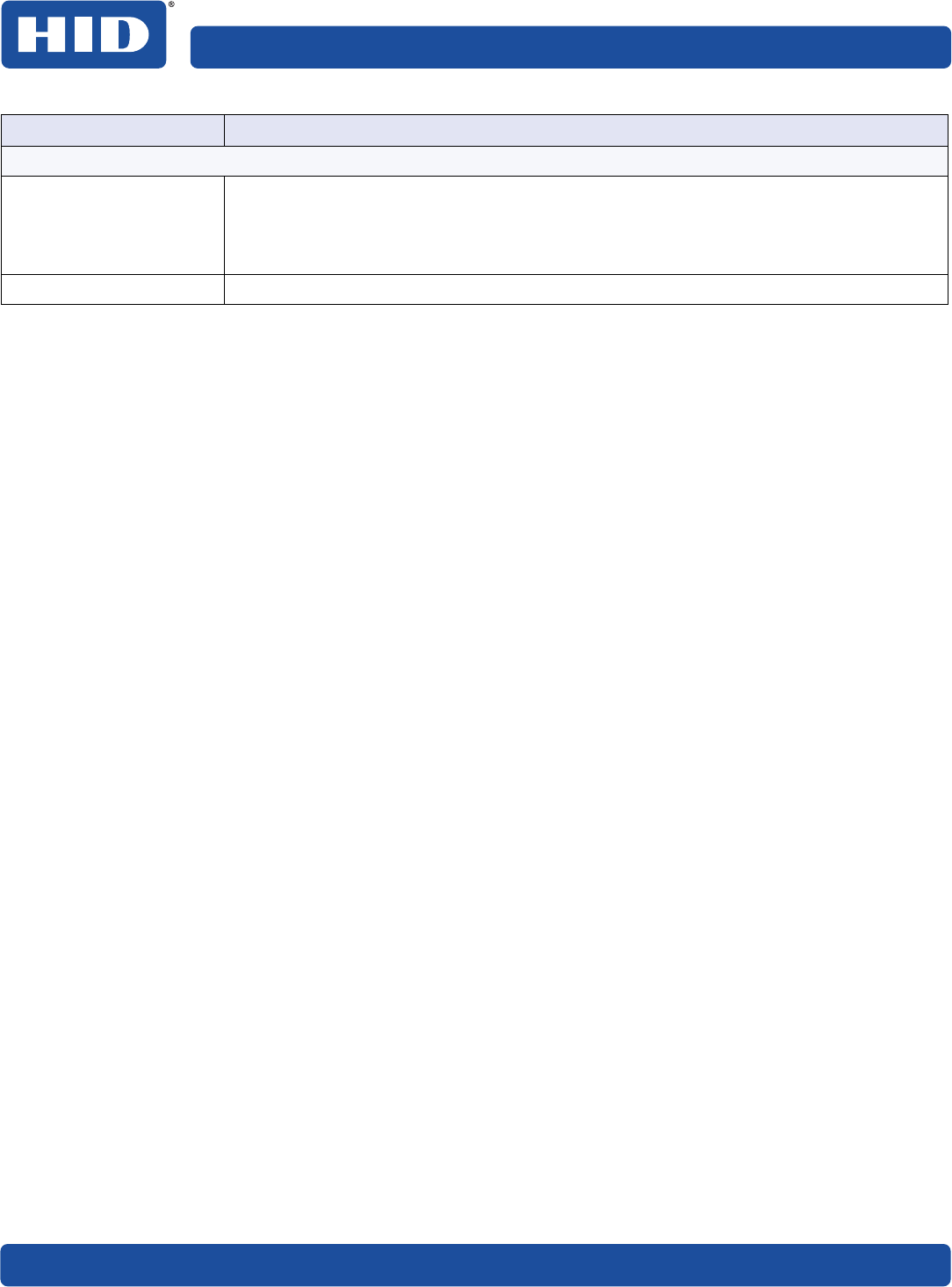
74 September 2018
Printing preferences PLT-02931, Rev. A.0
Printing
Current Color
Selected Swatches
All Swatches
Select one of these options to print:
Current Color: Prints the currently selected color swatch.
Selected Swatches: Allows you to select multiple swatches from the visual list.
All Swatches: Selects all the swatches in the visual list.
Print Prints the color swatches according to the selected option.
Field Description
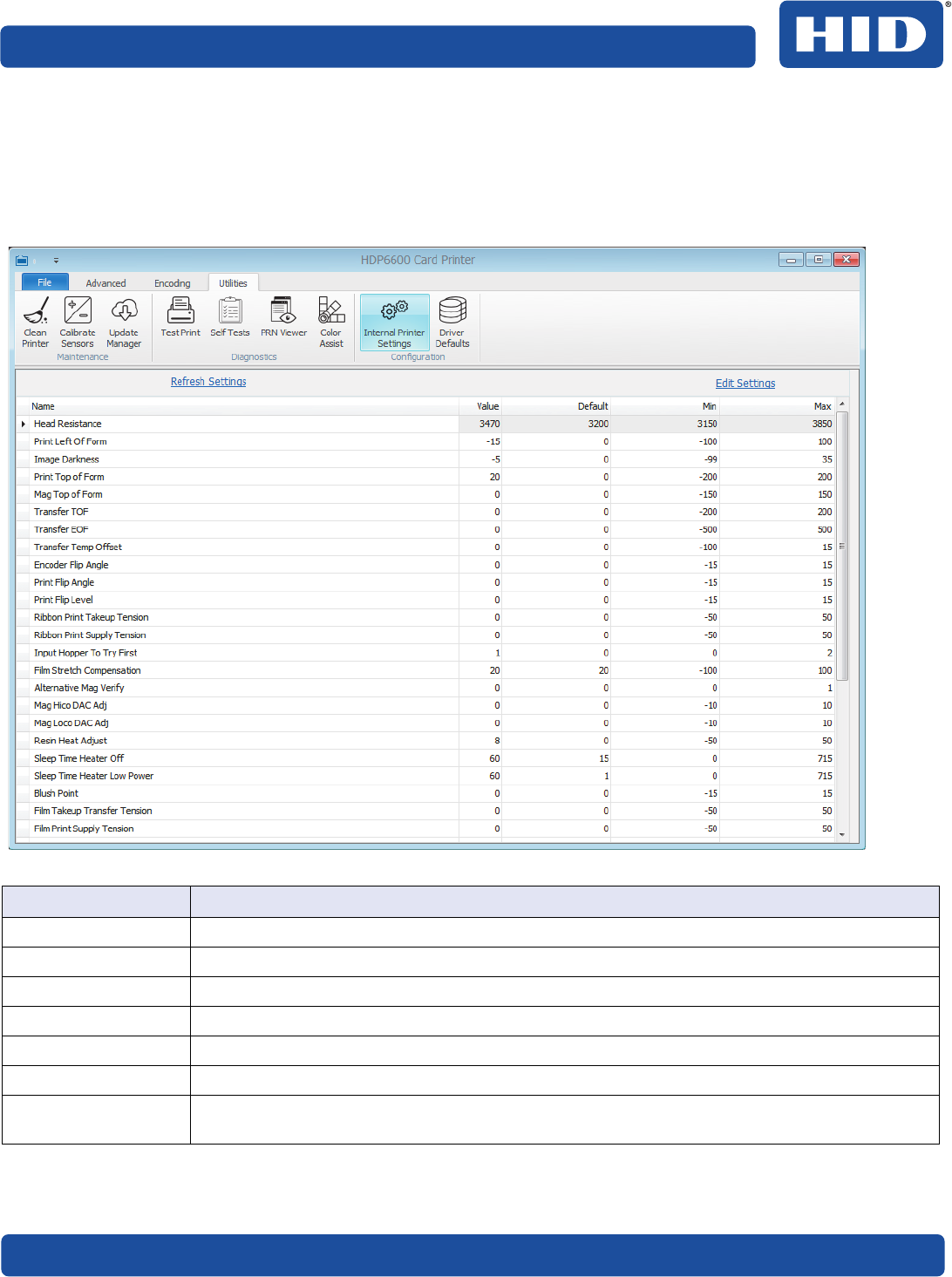
September 2018 75
PLT-02931, Rev. A.0 Printing preferences
3.4.8 Internal printer settings
Use this option for adjusting the internal printer settings. These settings have been customized for the printer
at the factory. These printer settings are HID advanced settings based on Electrically Erasable Programmable
Read-Only Memory (EEPROM).
Note: Any changes affect the settings for the firmware.
Field Description
Name Displays the label for each setting.
Value Displays the current value for the setting.
Default Displays the factory default value for the setting.
Min Displays the minimum value available for the setting.
Max Displays the maximum value available for the setting.
Refresh Settings Click this link to refresh the values.
Edit Settings
Save Settings
This link toggles between editing and saving. Click this link to edit the settings in the Value
column. When all updates have been made, click the link again to save your updates.
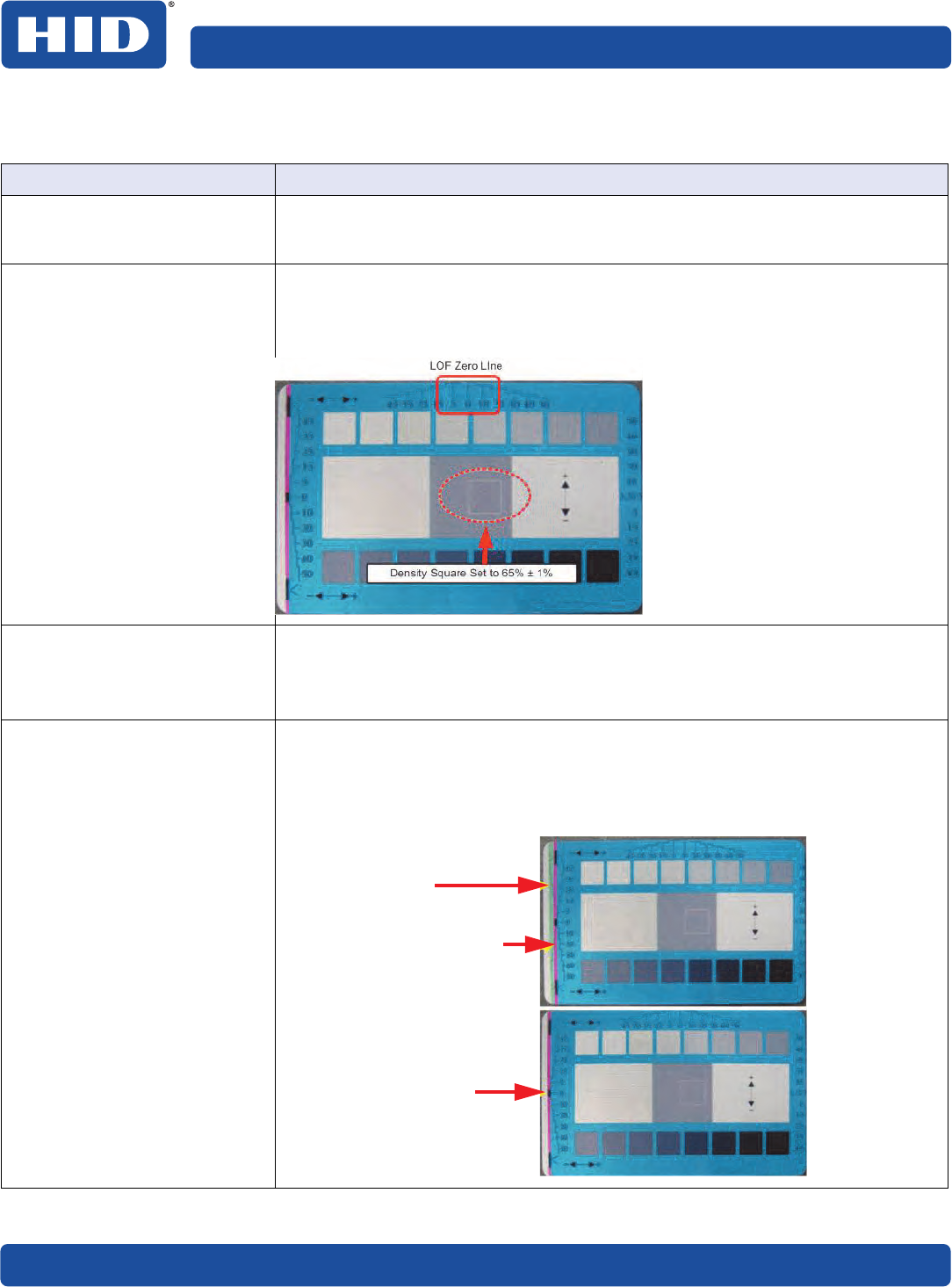
76 September 2018
Printing preferences PLT-02931, Rev. A.0
To change a setting, click the Edit Settings link. In the value column, change the numeric value in the row.
When all updates are correct, click the Save Settings link.
Setting Description
Head Resistance This is factory set. If the main board or the printhead is replaced, then adjust this
number. Locate the printhead setting number on the bottom of the printhead. The
number reads: R=XXXX.
Print Left Of Form Prints the alignment self-test card.
Adjust the Print Left of Form up or down until the border of the left of form zero
line is showing on the edge of the card.
Measure the density square. Adjust the image density to 65% ± 1%.
Image Darkness Use this option to set the overall darkness of the printed image by increasing or
decreasing the amount of heat the printhead uses while printing.
Use the up and down arrows to increase or decrease the amount of heat.
Important: If the value is set too high, the ribbon may jam or break.
Print Top of Form Print the alignment self-test card.
Adjust the Print Top of Form until the green border is eliminated and the entire
transfer alignment block is as shown in the bottom graphic
Note: Due to variation in roller alignment, the green border may appear at a slight
angle on the top of the card.
Edge of transfer
(green border)
Transfer alignment block
Image once adjusted
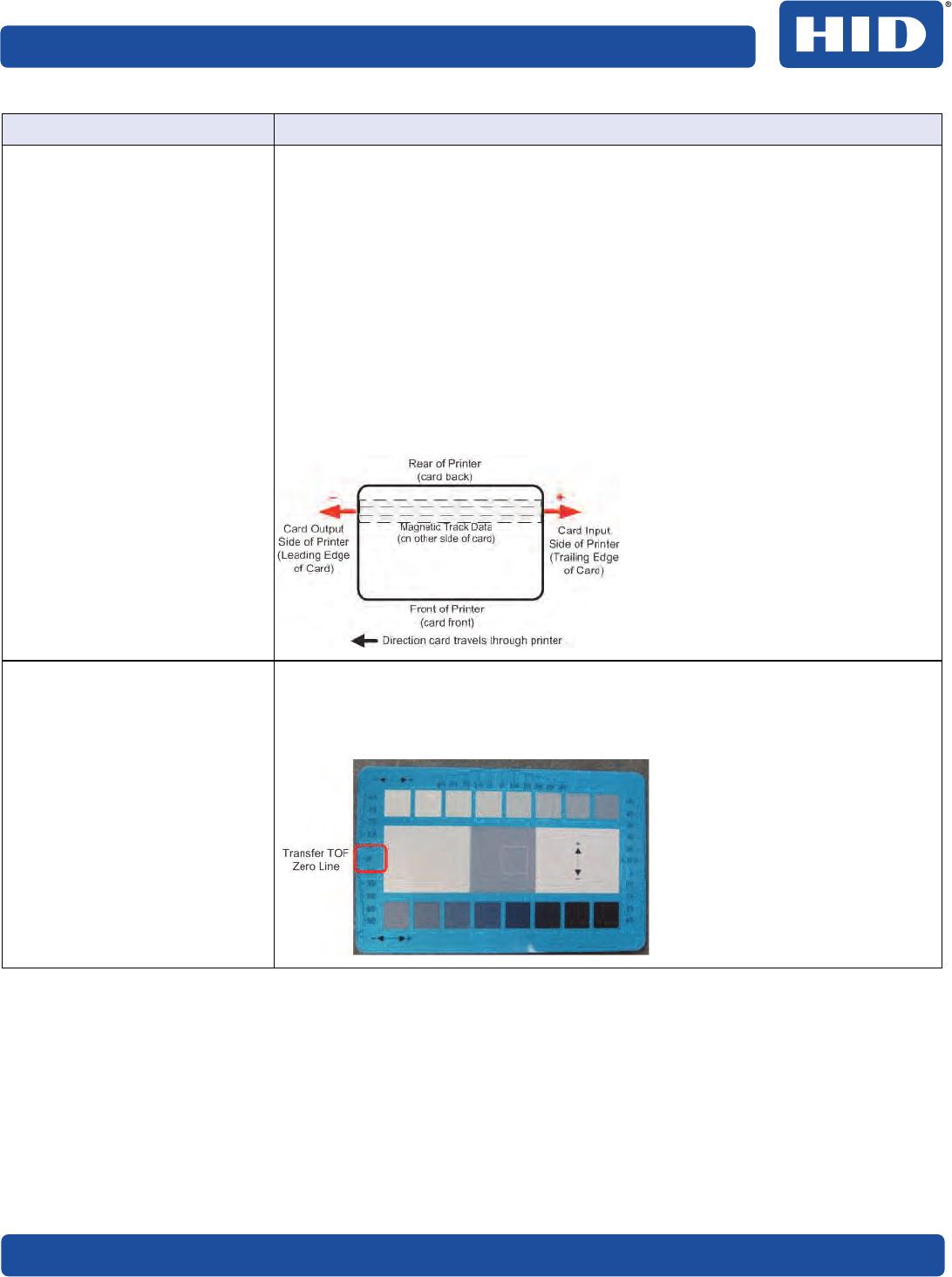
September 2018 77
PLT-02931, Rev. A.0 Printing preferences
Mag Top of Form This option is only for the built-in magnetic stripe encoder.
Use this option to shift the starting point of where the printer begins encoding the
magnetic track data on a magnetic stripe of the card.
When adjusting this value, keep in mind that a card and its magnetic stripe always
remains in the same relative position as the card travels through the printer.
Magnetic Data Direction
The arrows on these buttons indicate the direction the magnetic data moves on the
magnetic stripe on the card.
Enter a positive value to move the start of the magnetic data toward the trailing
edge of the card or the card input side of the printer.
Maximum Adjustment Range
The maximum adjustment range is 0–120. As a rule, 20 equals .030” (0.8 mm).
Note: If the negative value is set too high, the printer may start encoding before the
magnetic stripe on the card reaches the encoding head.
Transfer TOF Print the alignment self-test card.
Adjust the Transfer TOF until the TOF zero line is located on the edge of the card.
If the Transfer TOF is made too negative, the transfer roller can engage in front of
the card causing a transfer jam.
Setting Description
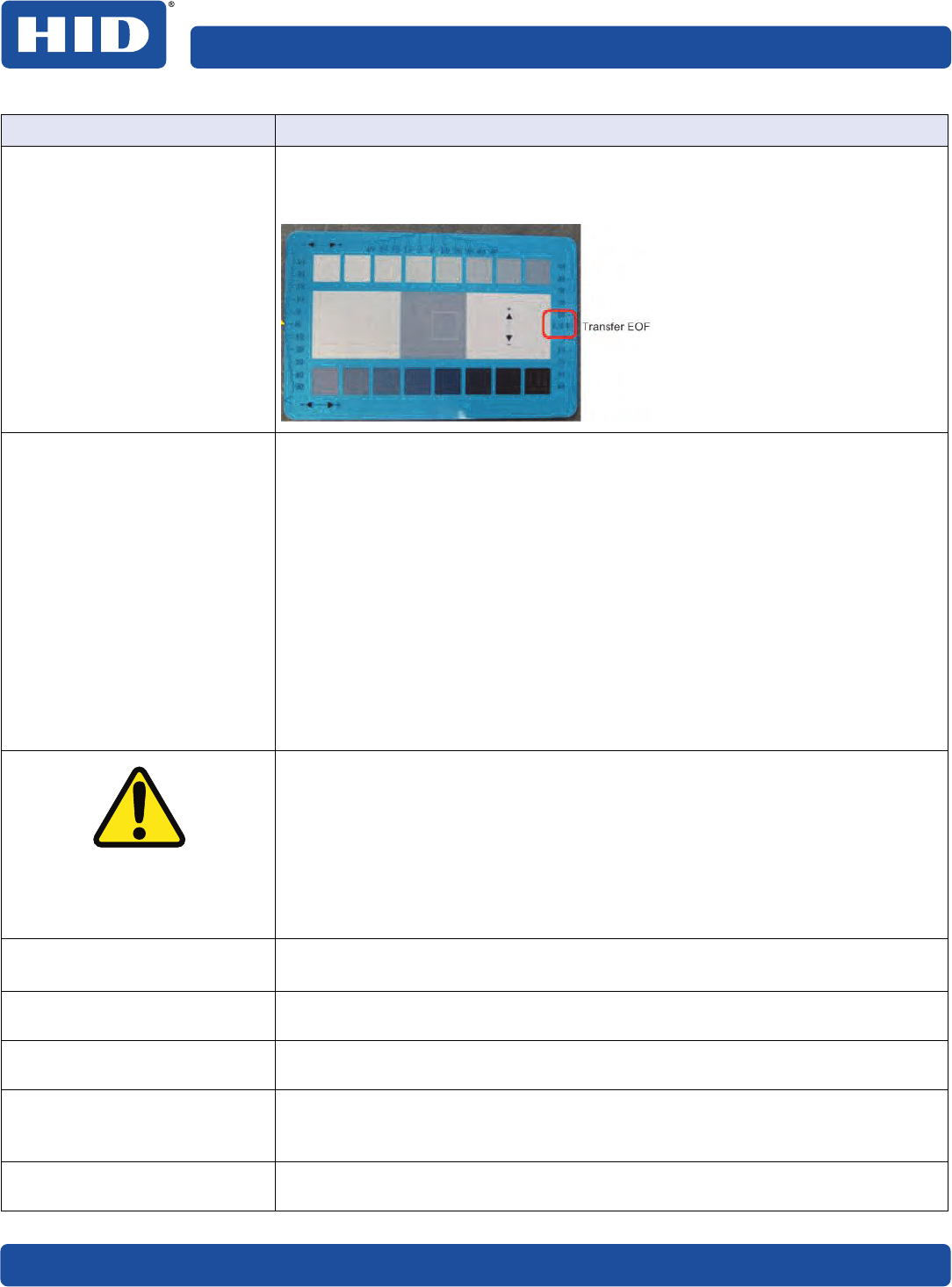
78 September 2018
Printing preferences PLT-02931, Rev. A.0
Transfer EOF Print the alignment self-test card.
Setting the Transfer EOF to a positive number causes the image length to grow.
Setting the Transfer EOF to a negative number causes the image length to shorten.
Transfer Temp Offset Both the printer and the printer software driver control the built-in transfer roller.
To change the temperature of the transfer roller, adjust the temperature through the
Image Transfer selection within the Advanced tab of the printer preferences. Once
adjusted, the new temperature setting is sent down with the next print job along
with the rest of the printer driver information.
Before printing begins, the transfer roller automatically adjusts to the new
temperature setting. This new temperature setting remains programmed within the
printer until it is once again changed within the printer driver or until the printer is
turned off.
Whenever the printer is turned OFF, the transfer roller automatically resets and
returns to the default temperature the next time the printer is turned ON.
Disconnect the printer power supply.
Technician Note: Cycling the printer power supply serves to reset the transfer roller
to its default temperature. The temperature setting within the printer driver,
however stays the same until it is changed.
DANGER: The printer transfer roller can reach temperatures exceeding 350°F
(175°C). Use extreme caution when operating the transfer roller. Never
touch the transfer roller unless the printer power has been turned off
for at least 20 minutes.
DANGER: Le rouleau de transfert de l'imprimante peut atteindre des
températures supérieures à 350°F (175°C). Soyez extrêmement
prudent lorsque vous utilisez le rouleau de transfert. Ne touchez
jamais le rouleau de transfert à moins que l'alimentation de
l'imprimante a été éteint pendant au moins 20 minutes.
Encoder Flip Angle Use this setting to fine tune the position of the flipper.
Note: Only used if encoder is present.
Print Flip Angle Use this option to set the position of the flipper so it is level with the card path after
a flip operation.
Print Flip Level Use this setting to fine tune the home position of the flipper if cards have difficulty
moving from the printer into the flipper.
Ribbon Print Take-up Tension This controls the tension of the color ribbon during printing. Adjust the ribbon
tension if ribbon wrinkle is appearing on the card.
Note: Adjustments moderately change the image length.
Ribbon Print Supply Tension This controls the supply side tension of the color ribbon during printing. Adjust the
ribbon tension if ribbon wrinkle is appearing on the card.
Setting Description
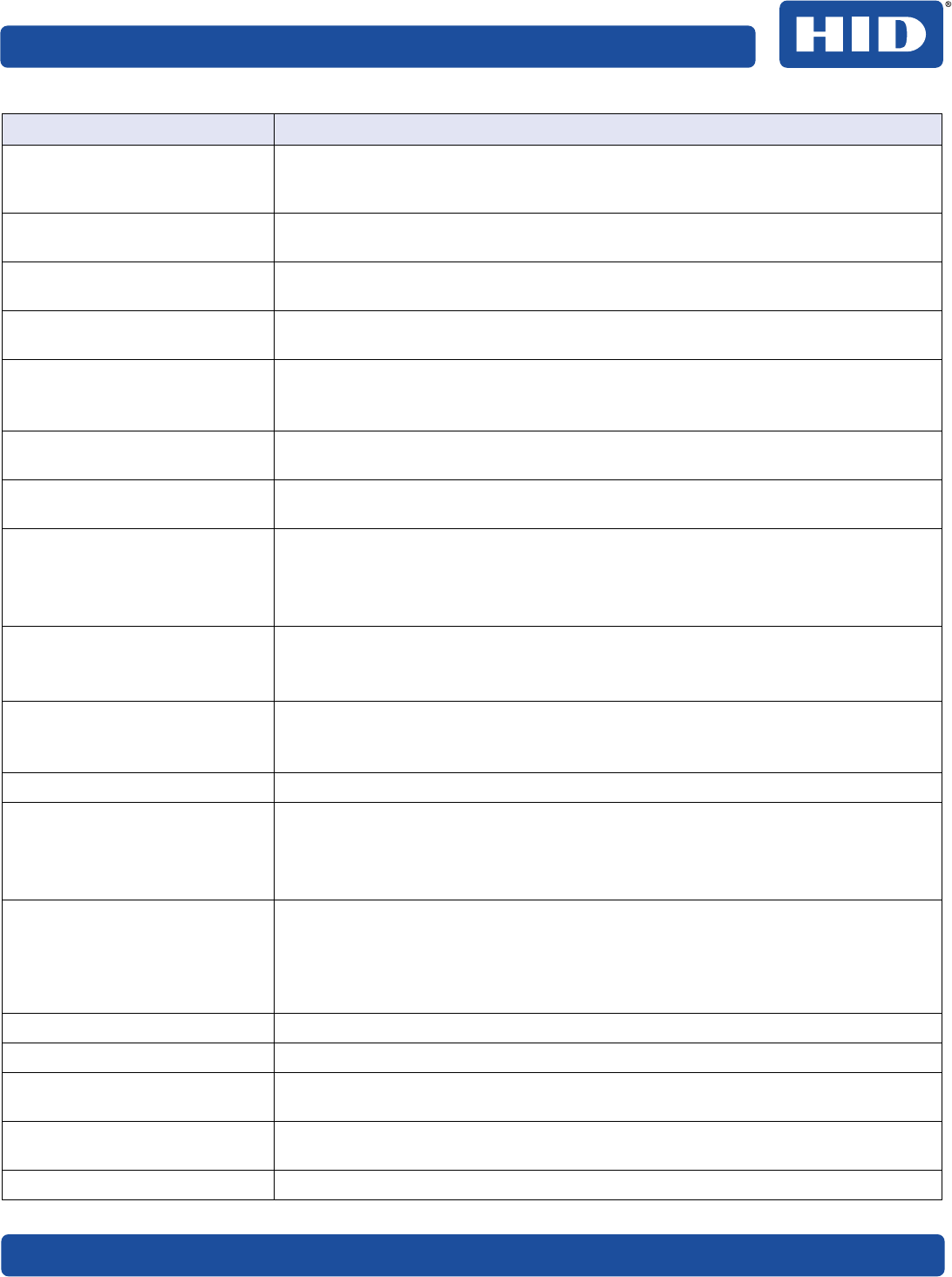
September 2018 79
PLT-02931, Rev. A.0 Printing preferences
Film Stretch Compensation When printing, the position of the image on the film can vary depending on whether
the previous film panel is used or not. Adjust this setting if the first card after an
error is shifted from the rest.
Alternative Mag Verify If set to 1, enables a quicker mag verification step of just looking for any data
encoded on the card. If set to 0 verifies all data written to the card.
Mag Hico DAC Adj Fine tunes the mag drive current for high-coercivity/super coercivity cards. Adjust if
mag verify errors start occurring with new card stock.
Mag Loco DAC Adj Fine tunes the mag drive current for low-coercivity/medium-coercivity cards. Adjust
if mag verify errors start occurring with new card stock.
Resin Heat Adjust Print the resin self-test card.
Use this adjustment for black resin text and barcodes that appear faded or too light
or dark.
Sleep Time Heater Off This setting adjusts how many minutes after the printer goes idle or enters a low
power state that the printer goes into a heater off power state.
Sleep Time Heater Low Power This setting adjusts how many minutes after the printer goes idle, the printer goes
into a low power state.
Blush Point The blush point is compensation during printing:
႑There is no dye transfer.
႑There is no light gray line on a portion of the card.
႑It should be white.
Film Takeup Transfer Tension ႑Negative adjustments can cause card jams.
႑Positive adjustments can help stop jamming.
Note: Adjustments affect flash and smudge.
Film Print Supply Tension Important: The film drive sets the baseline for the film tension and should not be
adjusted by the reseller or the end user.
Note: Adjustments moderately change the image length.
Cleaning Rate This adjustment changes the cleaning rate from 2000 to the new setting.
Transfer Heat Dissipation Level This setting adjusts when the transfer fan turns on.
႑0, 1, and 2 - Transfer fan is on only during transfer.
႑3 - Transfer fan turns on when transfer roller comes up to temp.
႑4 - Transfer fan always on when not in sleep mode.
EAT Disable Environmentally Adaptive Transfer (EAT) automatically adjusts the transfer
temperature based on the ambient air conditions within the printer.
This is an ON (1) or OFF (0) switch.
Note: Settings can increase or decrease the transfer roller temperature by as much
as 68°F (20°C) in extreme conditions.
Beep Disable This setting disables the beep the printer generates after an EE setting is updated.
eSTANDBY_TEMP This option changes the temperature used when the printer is in standby mode.
Flipper Offset Mag This setting fine tunes the position of the flipper relative to the mag encoder. Only
use if a mag encoder is installed.
Image Length Fine tunes the length of the image on the card. Increase this value if the image
length is too short. Decrease this value if the image length is too long.
Internal Encoder offset in mm Fine tunes the position of the card when docking into Bay 0.
Setting Description
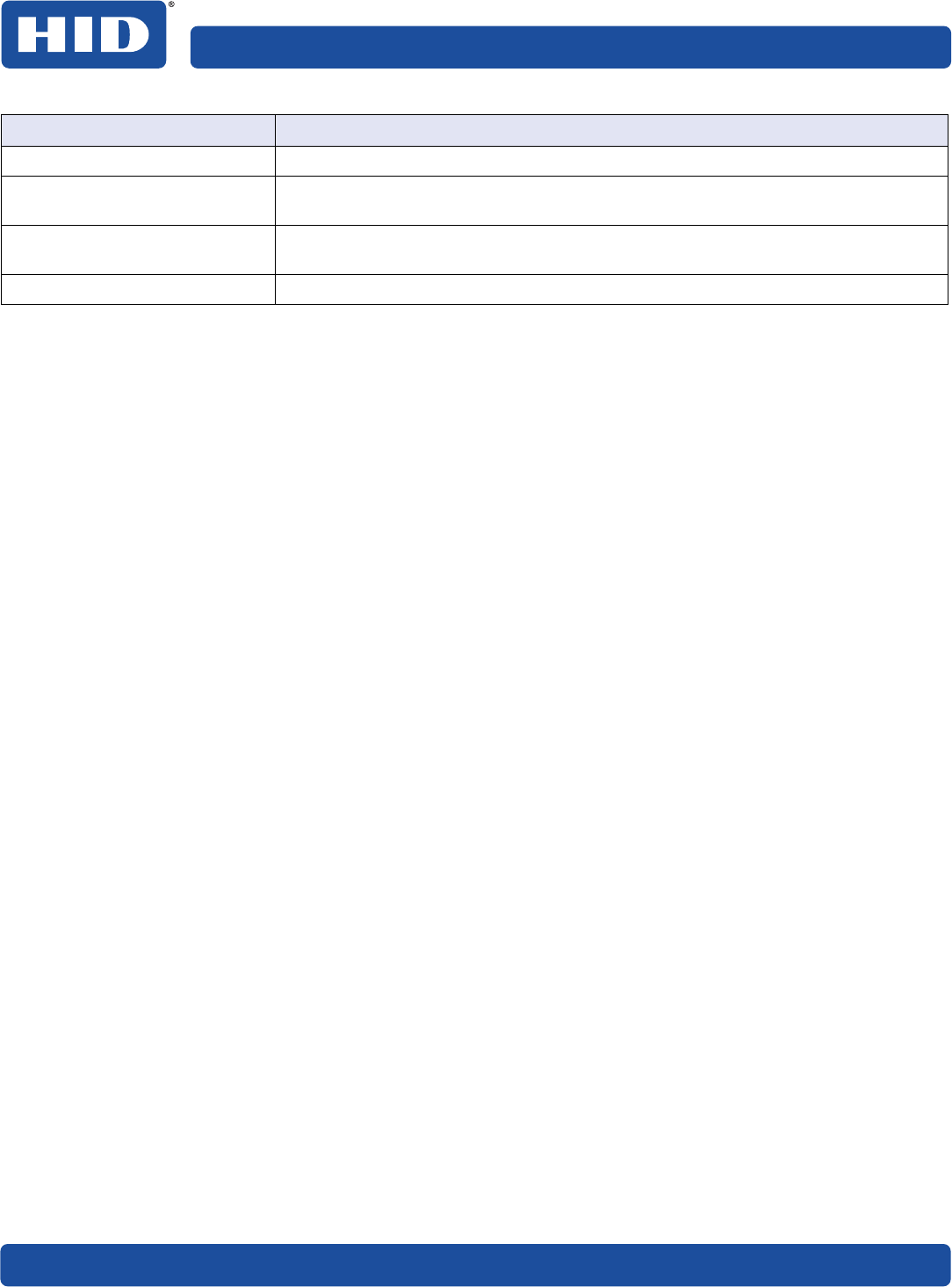
80 September 2018
Printing preferences PLT-02931, Rev. A.0
Flattener TOF offset Adjusts the position of the card when the flattener roller engages.
Job Canceling Timeout Period Slower PCs can have difficulty canceling all print jobs. Increase this value if all print
jobs do not get canceled and instead some restart printing.
Ribbon Queueing Position
Offset
Fine tunes the position of the ribbon prior to printing. Adjust if printing starts in the
previous panel or goes off into the next panel.
Mag Verify If set to 1, enables verification of encoded mag data.
Setting Description
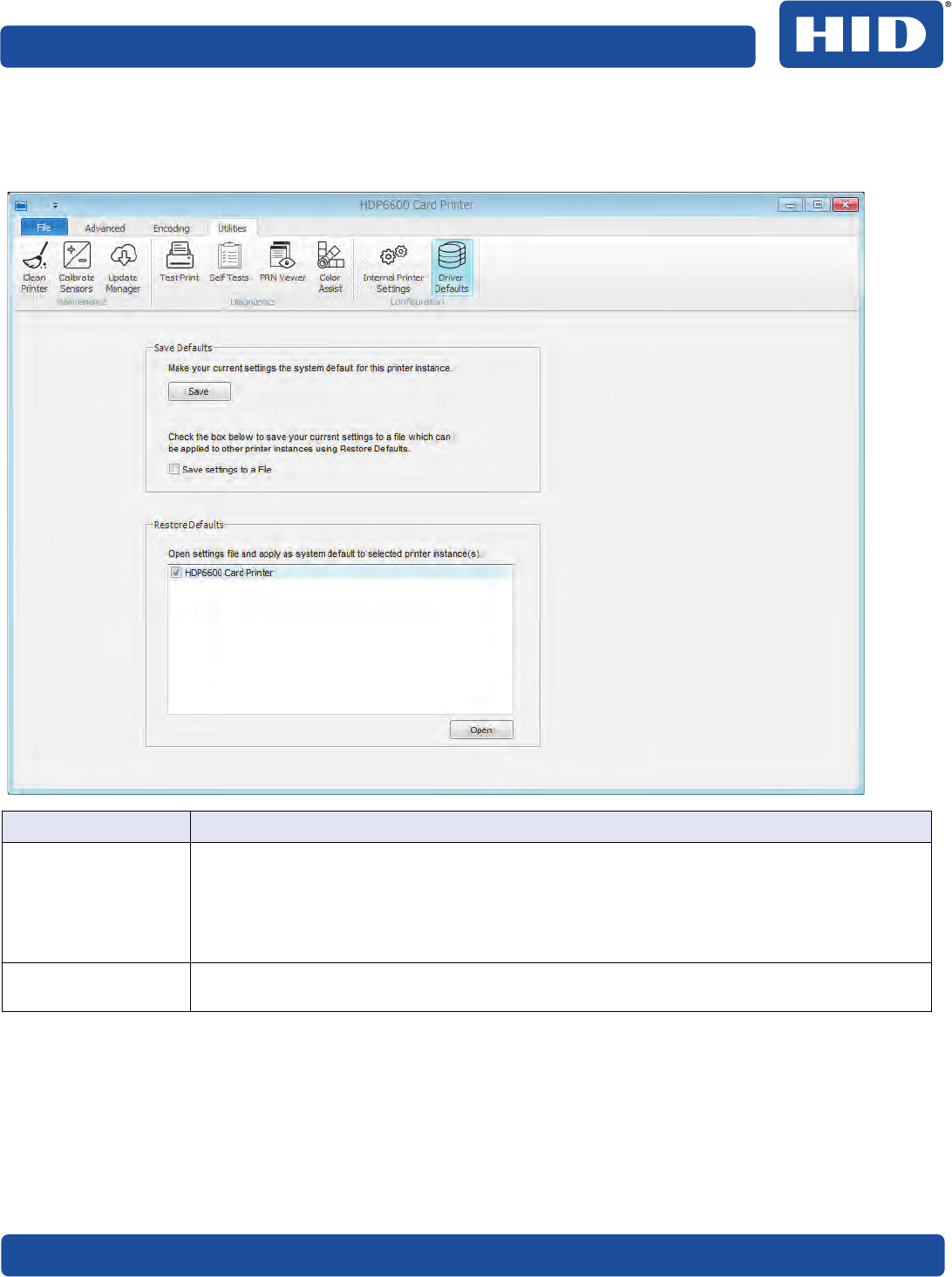
September 2018 81
PLT-02931, Rev. A.0 Printing preferences
3.4.9 Driver defaults
This setting allows you to save the current settings for this printer instance as the default. The settings can be
saved to a file and be applied to other printer instances of the same printer model.
Field Description
Save Defaults Click Save to make the current settings the system default for this printer instance.
If you want to save these settings to a file.
1. Select the check box and click Save.
2. At the prompt to confirm this action, click Yes.
3. Select a file location and name the file. Click Save.
Restore Defaults Allows you to open a saved system default file and apply it to the selected printer. The
printers must be the same model.

Printing preferences PLT-02931, Rev. A.0
This page is intentionally left blank.
82 September 2018

Section
4
September 2018 83
4 HID Printer Status Monitor
The HID Printer Status Monitor displays information about your card printer print jobs. During the installation
of the printer driver, you were prompted with the recommended option to install the HID Printer Status
Monitor.
After installation, the Status Monitor is set to launch on start up. It can be accessed through a short cut in
your startup folder or an icon in the notification area (which may be hidden). To make the HID Status Monitor
icon be more visible on your PC, you can pin it to your taskbar or use the Windows settings to always show
the icon on the taskbar.
Features of the Status Monitor include enabling and customizing desktop notifications, saving or opening a
system log event, canceling a print job, and submitting a technical support case.
The Status Monitor can monitor all printers that are connected to your PC, either through a network
connection (Ethernet) or through a USB cable. The printers are shown in a folder structure also known as a
device tree with groups of printers at the top level and printer instances in subgroups. Each node and each
instance can be configured and monitored.
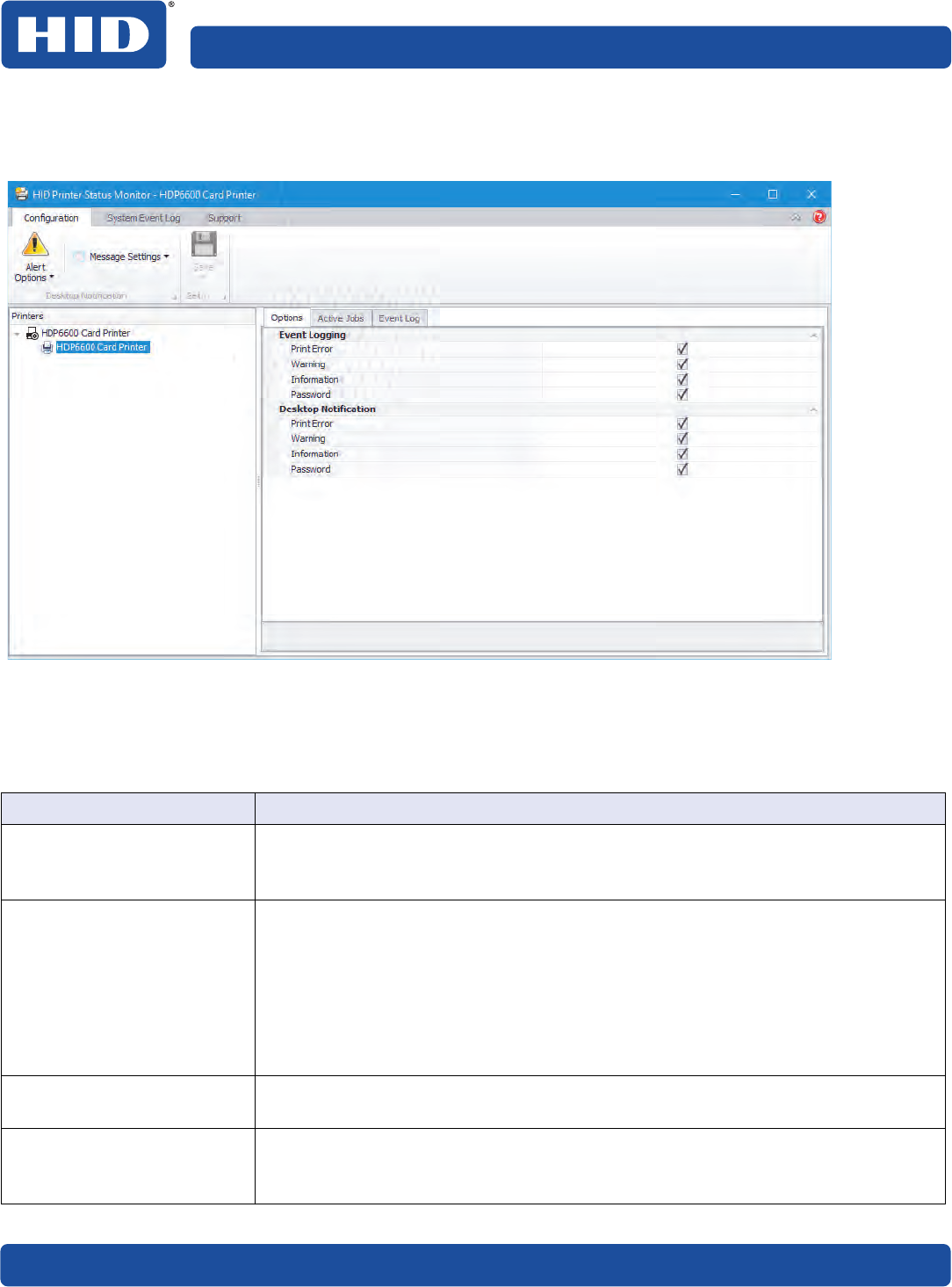
84 September 2018
HID Printer Status Monitor PLT-02931, Rev. A.0
4.1 Configuration tab
This tab allows you to set up how you are notified of print job statuses per printer instance.
You can select either the printer node or the printer instance in the device tree. If you select the printer node
on the left side of the screen, any changes to the selections on the Options tab on the right side of the screen
affect all instances of that printer type. If you select the individual printer instance, you can modify the
options individually.
Field Description
Alert Options Specifies how notification of alerts are displayed. Options are:
Desktop Message: Displays a small window on the right left side of the main screen.
Icon Alert: Displays an icon in the task bar. When an alert is active, the icon blinks.
Message Settings Sets the characteristics of the desktop message. Settings are:
Duration: Sets the amount of time the error message is displayed on your screen when
an error occurs. Available setting is 3-30 seconds. Default is 3 seconds.
Transparency: Sets the background color of the message displayed on the screen.
Values available are 0-80%. If set to a lower number, the background of the message
window is more opaque. Default is 50%.
Preview message: Displays the desktop message using the currently selected
settings.
Printer This selection is displayed when the Active Jobs tab is displayed.
Cancel All removes all jobs waiting in the print queue area.
Save Saves the selected options for this printer instance.
Save: Saves the settings that are currently set.
Save And Exit: Saves the settings and closes the HID Printer Status Monitor.
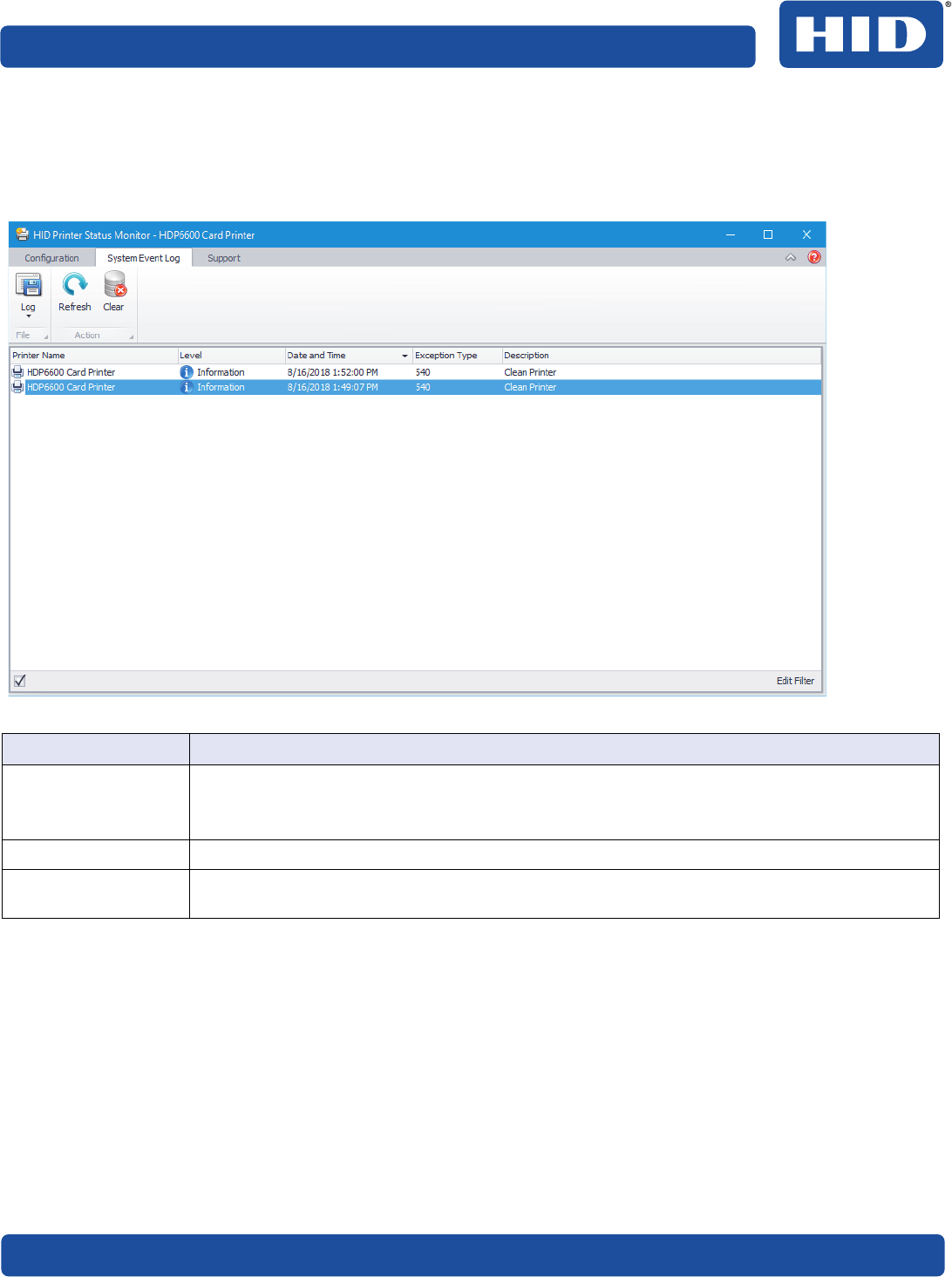
September 2018 85
PLT-02931, Rev. A.0 HID Printer Status Monitor
4.2 System event log tab
This tab lists all of the printing events (error, warning, information, or password) since the last time the log has
been cleared. The event log can be saved as an EVTX file that can be viewed with the Windows Event Viewer.
The system event log is a good way to send information to HID Technical Support.
Field Description
Log Saves the current log file or opens a saved log file. Options are:
Save As: Opens a new window to choose the location to save the event log.
Open Saved Log: Open a new windows to browse to the location of the saved event log.
Refresh Updates the system event log and redisplays the current log information.
Clear Removes all entries in the system event log. To clear the log, you may be prompted to
re-launch the Status Monitor with administrator privileges.
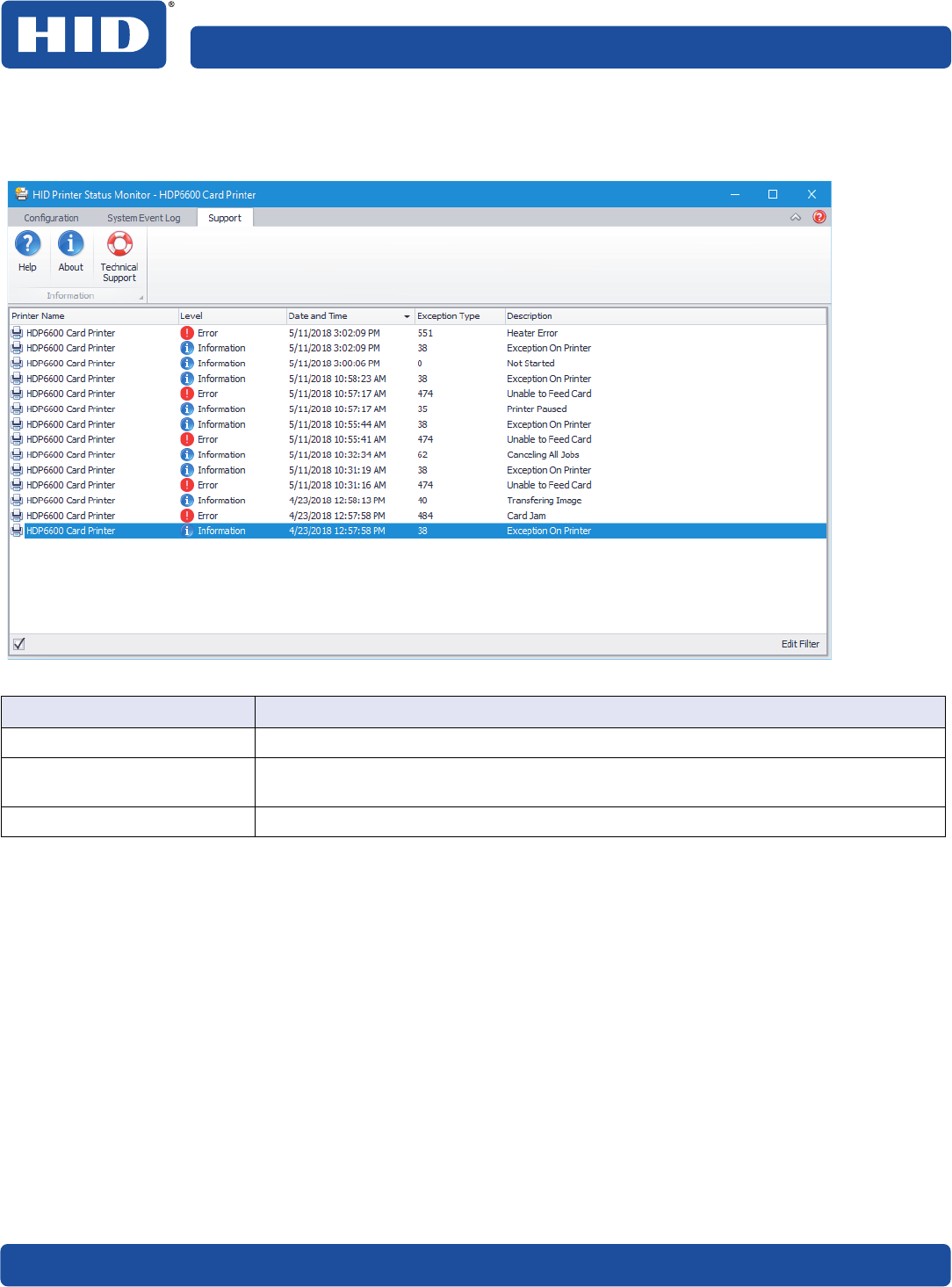
86 September 2018
HID Printer Status Monitor PLT-02931, Rev. A.0
4.3 Support tab
This tab shows the options for obtaining help with the Status Monitor application.
Field Description
Help Opens a link to the online help file.
About Opens a window that displays the print driver version and copyright information for
the HID Status Monitor.
Technical Support Opens a link to HID Technical Support to submit a technical support case.
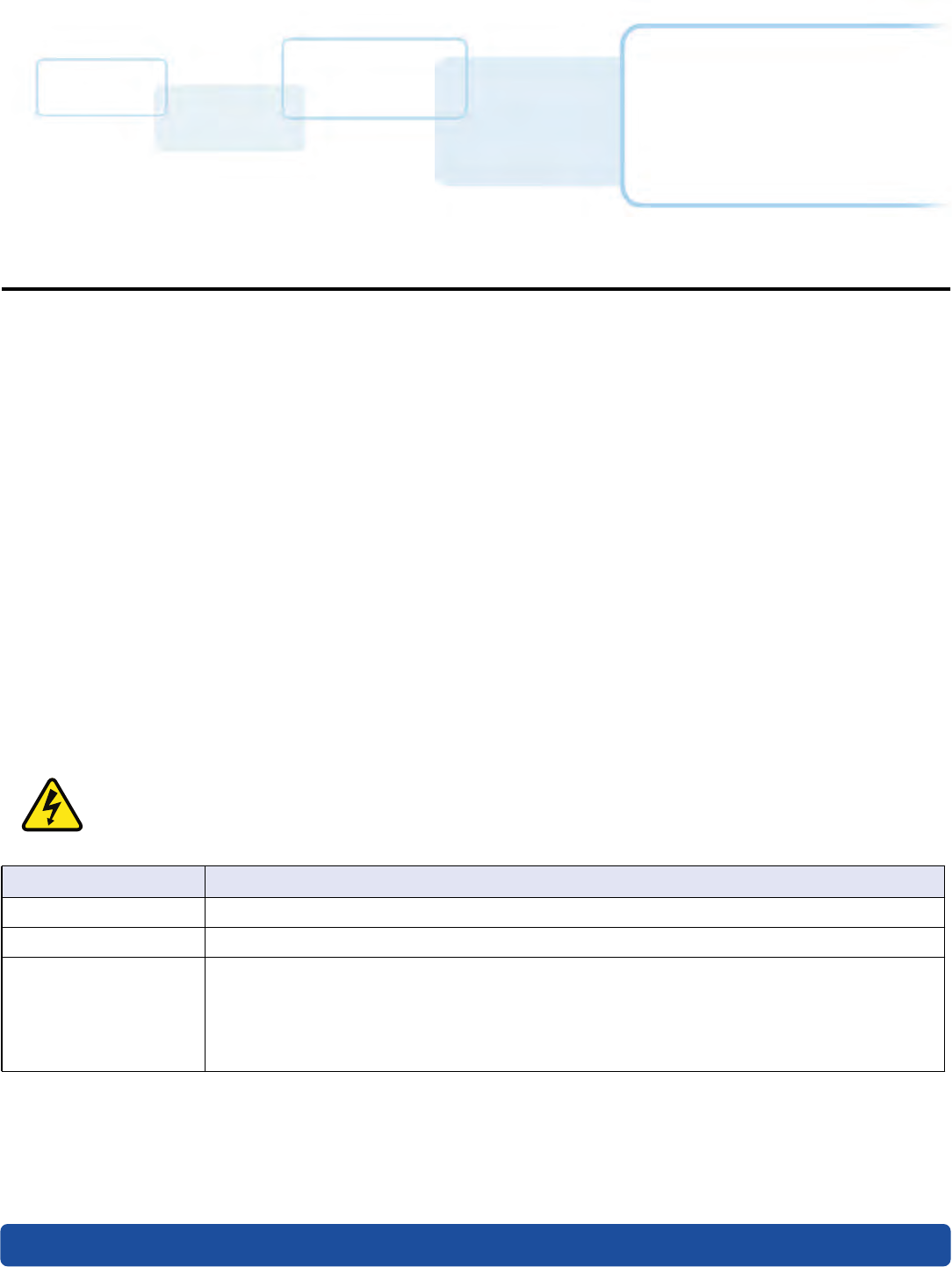
Section
5
September 2018 87
5 Ethernet option
5.1 Introduction
The Ethernet option for the FARGO® HDP®6600 High Definition Card Printer/Encoder includes the Ethernet
port and the internal printer server.
Printer Management: The printer driver provides bi-directional status information so you can monitor and
manage the printer just as you would any other networked printer.
Compatibility: The Ethernet option provides compatibility with TCP/IP and 802.3 Ethernet protocols with
an IEEE 802.3 10/100 Base-T Ethernet female RJ45 connector.
Application: The Ethernet Option applies to the card printer/encoder. With the Ethernet option properly
installed and configured, these printers are able to print in the same manner as a printer directly
connected to the PC using a USB interface.
Note: Any reference to a specific printer name is for demo purposes only. Your printer name varies according
to what you are using.
5.2 Technical specification
The system requirements for Ethernet are as follows:
Caution: For safety purposes, Ethernet is not intended for a direct connection outside the building.
Function Requirement
Network An IEEE 802.3 10/100 Base-T Ethernet network is required.
Printer A printer with the Ethernet option installed is required.
Printer configuration Since TCP/IP is used for the network communication, the printer must be configured with an
IP address and a subnet mask (before it can be seen on the network).
An additional network setting for the default gateway can also be configured, which allows
communication across the subnets.
Dynamic Host Configuration Protocol (DHCP) is also supported for auto configuration.
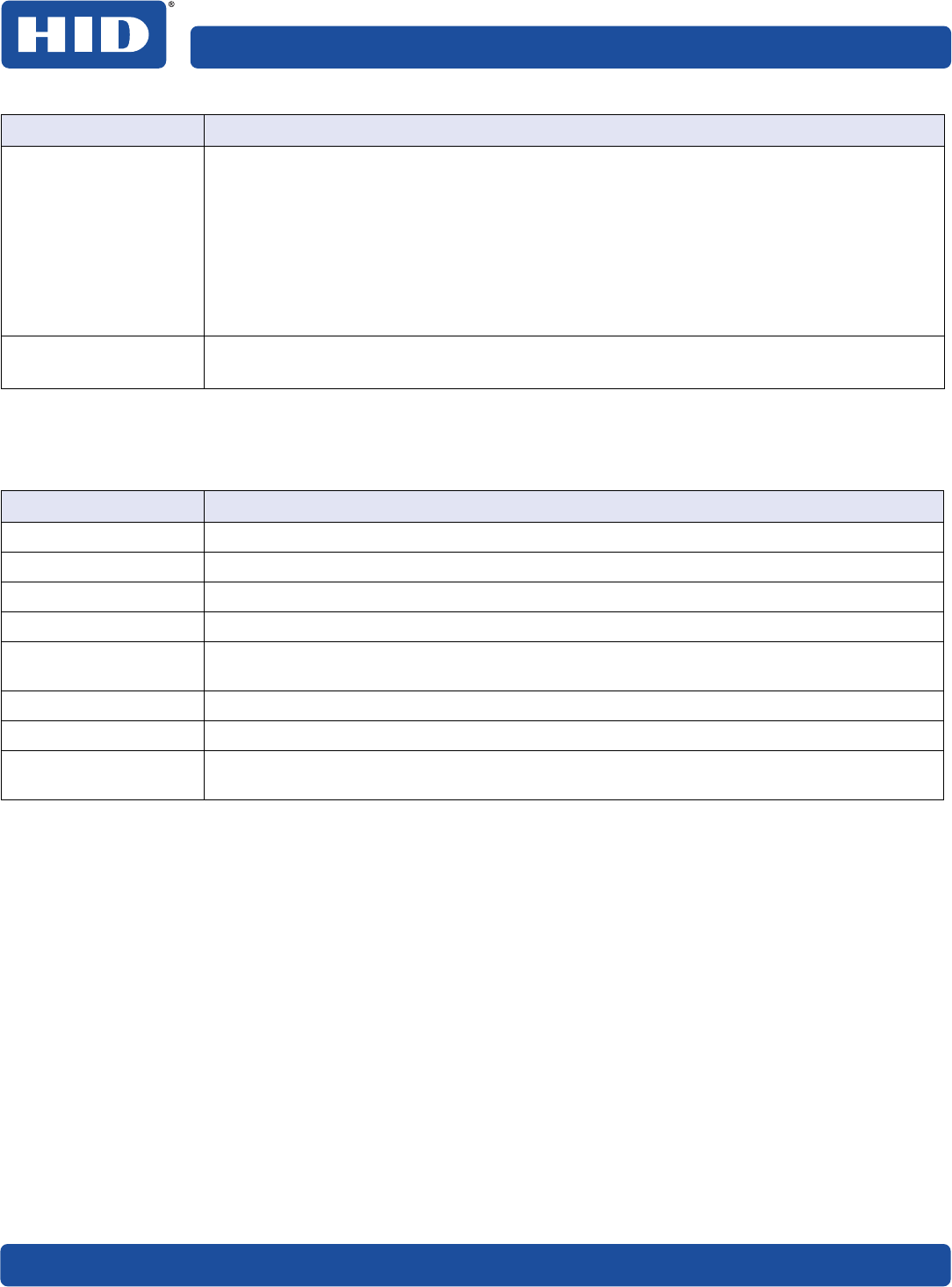
88 September 2018
Ethernet option PLT-02931, Rev. A.0
5.3 Functional specification
The Ethernet option includes the following features.
Host computer ႑Windows 7 (32- and 64-bit)
႑Windows 8 / 8.1 (32- and 64-bit)
႑Windows 10 (32- and 64-bit)
႑Windows Server 2008 R1 (32- and 64-bit)
႑Windows Server 2008 R2 (64-bit only)
႑Windows Server 2012
႑Windows Server 2012 R2
႑Windows Server 2016
Host printer driver The host PC must have installed the correct printer driver with Ethernet support.
Note: This driver must be configured for printing to the IP address of the printer.
Feature Description
Simultaneous printing Print simultaneously from multiple PCs to the network printer.
Printer feedback Status information from the network printer to the PC.
Web pages Easy printer configuration with any web browser.
Password security Provides password security for admin user only.
SNMP Provides an SNMP (Simple Network Management Protocol) agent that supports MIB-II
(Management Information Base, second version).
Upgrades Support for firmware upgrades over the network.
Troubleshooting Provides a Ping client for network troubleshooting.
SSDP Simple Service Discovery Protocol (SSDP) is used to find the printers with an Ethernet
connection on a local network.
Function Requirement
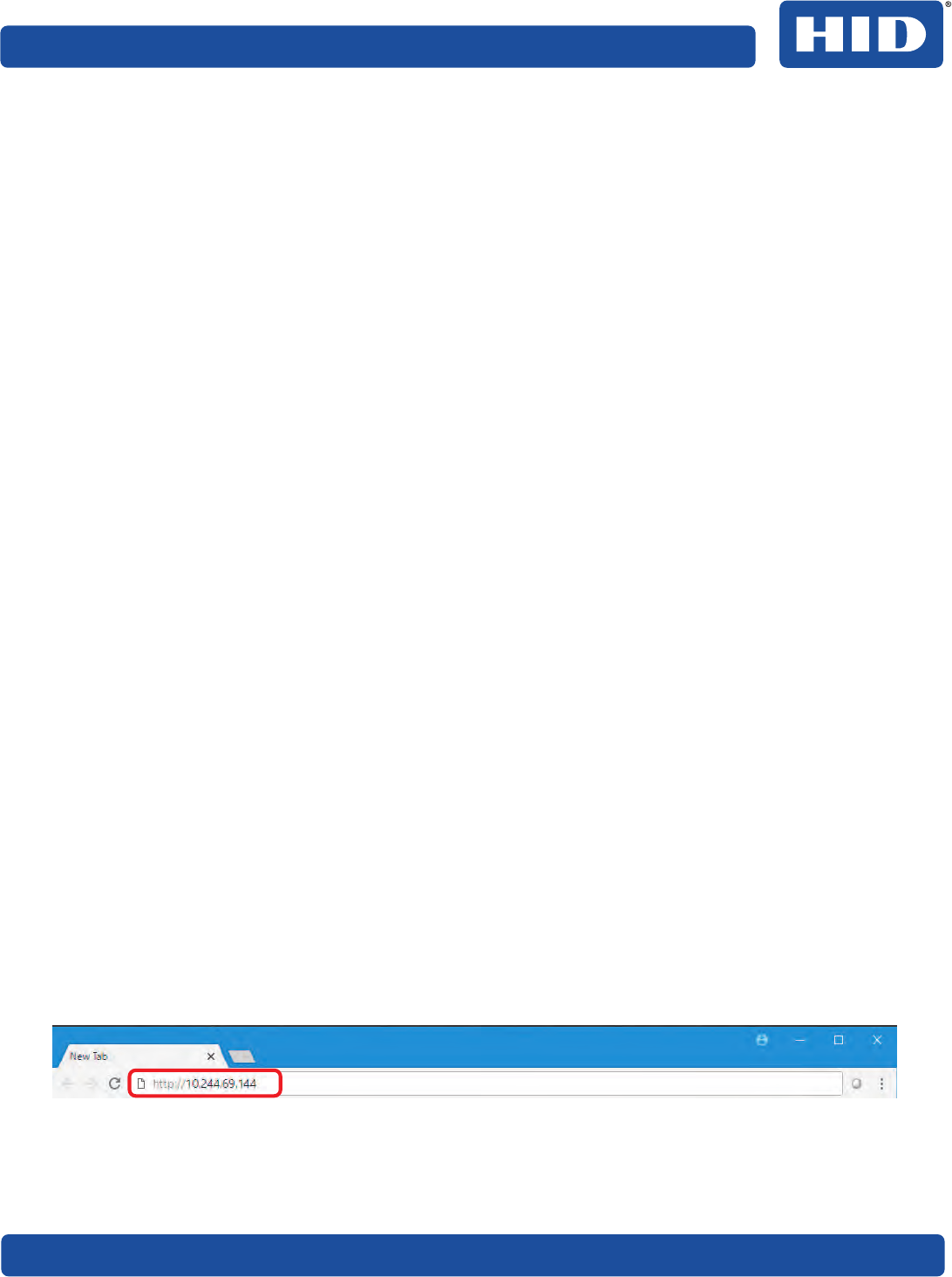
September 2018 89
PLT-02931, Rev. A.0 Ethernet option
5.4 Network services
The Ethernet option provides the following services:
႑Print server
႑Web server
Note: Other services include a Ping client, address assignment, and printer discovery.
5.4.1 Print server
The print server provides printing services via the local area network (LAN) to the client PC (in the same way
as a printer connected directly to a USB interface). The print server must be properly configured to provide
this printing capability.
႑The print server can queue up to eight client PCs while printing. Communications between each PC and
the printer are implemented over a bi-directional TCP/IP interface.
႑All clients are able to send print jobs to the printer and monitor printer jobs and errors with the
standard Windows printing system using the printer driver installed on their local PC.
Therefore you know whether or not a print job has been successful, as well any problems that have been
encountered while processing the print job.
5.4.2 Web server
An HTTP service serves web pages that are the interface through which to configure the printer.
The printer operates as a Simple Network Management Protocol (SNMP) agent to allow a network
administrator to support the network interface of the printer.
Note: A standard host MIB-II is implemented to maximize the utility of the printer on the network.
5.5 Ethernet web pages
Use the Ethernet web pages from your Ethernet-connected printer to view attributes about the printer. To
alter settings of the printer, you must have administrative rights confirmed by entering a valid user name and
password.
5.5.1 Accessing the home page
1. Open a window for your network browser application on your local PC.
2. Find the IP address of the printer. See Section 5.6.1 Accessing the IP address of the printer on how to
retrieve this information from the printer display.
3. Enter “http://” and the IP address of the printer you want to access into the address bar of the browser.
Note: The IP address changes for your printer installation.
4. Press Enter.
The Home page is displayed.
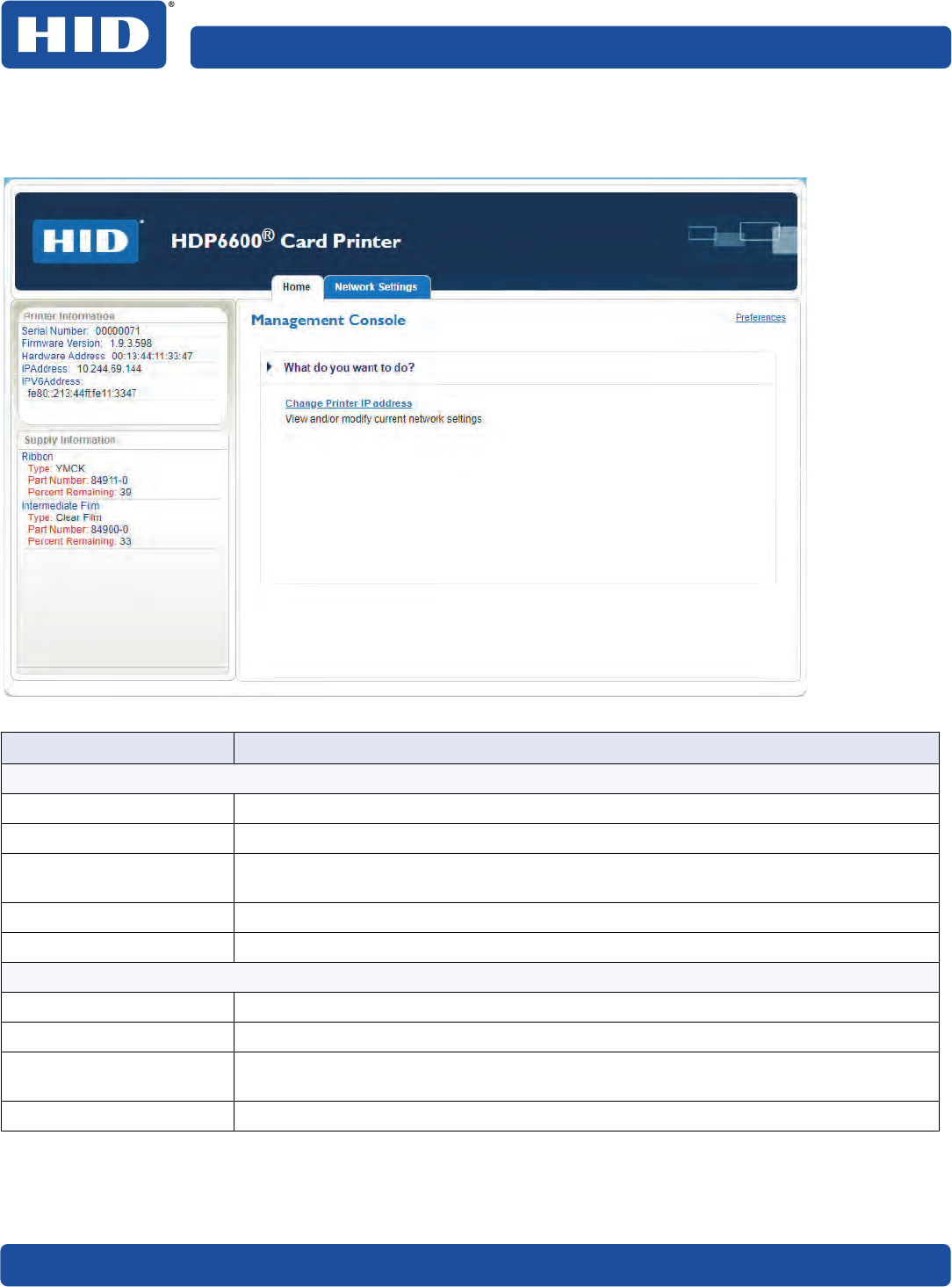
90 September 2018
Ethernet option PLT-02931, Rev. A.0
5.5.2 Home page
The Home page displays general information about the printer.
Field Description
Printer Information
Serial Number Displays the unique fixed serial number of the printer.
Firmware Version Displays the current firmware version.
Hardware Address Displays the unique fixed hardware address (MAC) of the printer, which is the unique
Ethernet device identifier.
IPAddress Internet protocol address.
IPV6Address Internet protocol address.
Supply Information
Ribbon Print ribbon. Information includes: Type, Part Number, and Percent Remaining.
Intermediate Film HDP film. Information includes: Type, Part Number, and Percent Remaining.
Change Printer IP Address Accesses the Network Settings to view or modify the current network settings. See
Section 5.5.4 Configuring the network settings.
Preferences Accesses the Preferences settings. See Section 5.5.5 Preferences.
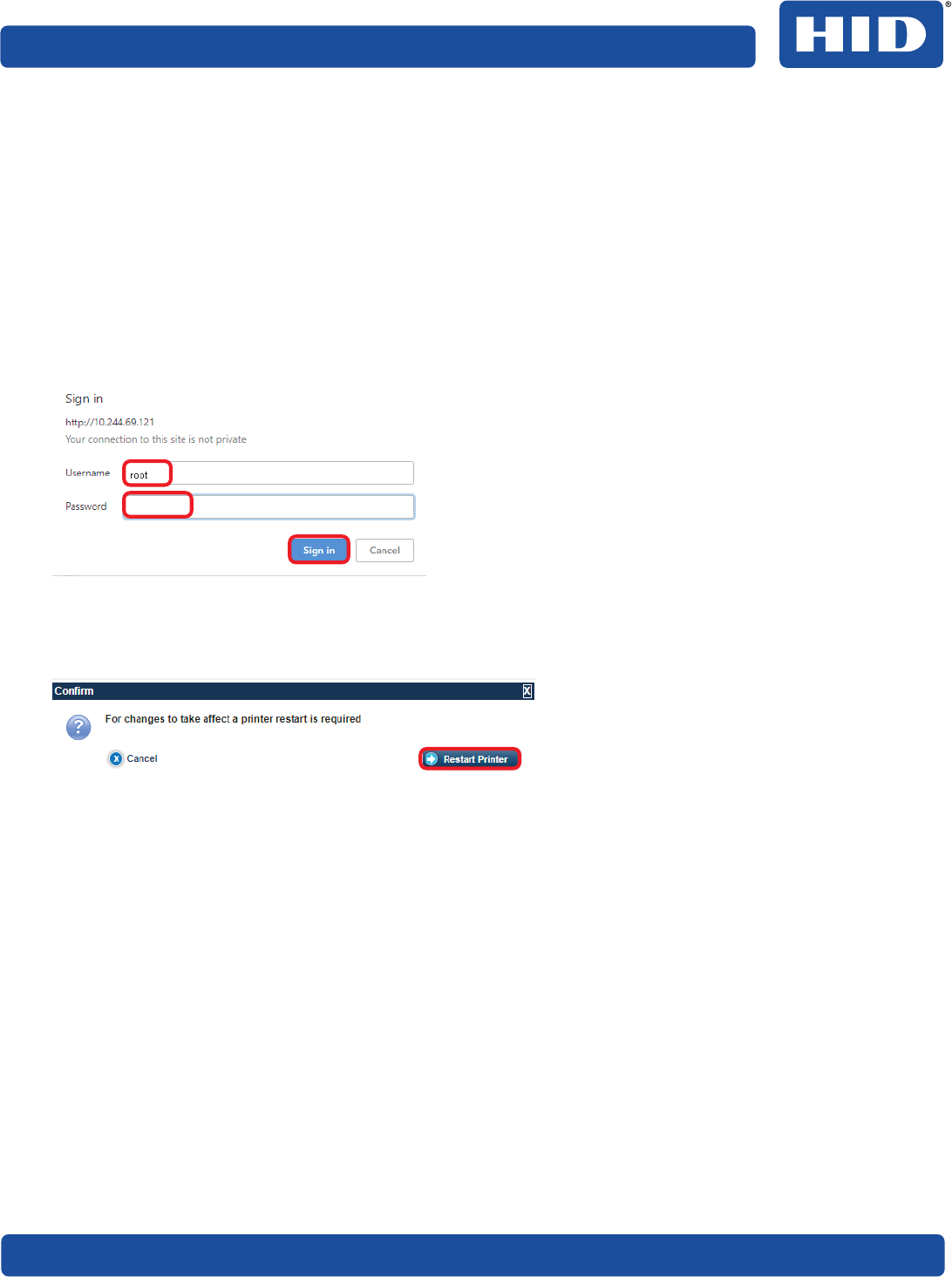
September 2018 91
PLT-02931, Rev. A.0 Ethernet option
5.5.3 Changes to the settings
When you change any setting, you may need to confirm your administrative rights by entering the user name
and password. You may also need to restart the printer to continue.
Note: The windows displayed for the user name and password varies by the browser you are using. The
information to input into the fields is the same. This example shows Google Chrome.
1. Enter the correct user name. The default user name is “root”.
2. Enter the password: The default password is blank.
To change the password, see Section 5.5.5.1 Change password.
3. Click Sign In.
4. If the user name and password is not accepted, another login prompt is displayed on the screen. Repeat
this procedure with the correct user name and password.
5. The Confirm window is displayed. Click Restart Printer.
A notification is displayed as the printer is restarted.
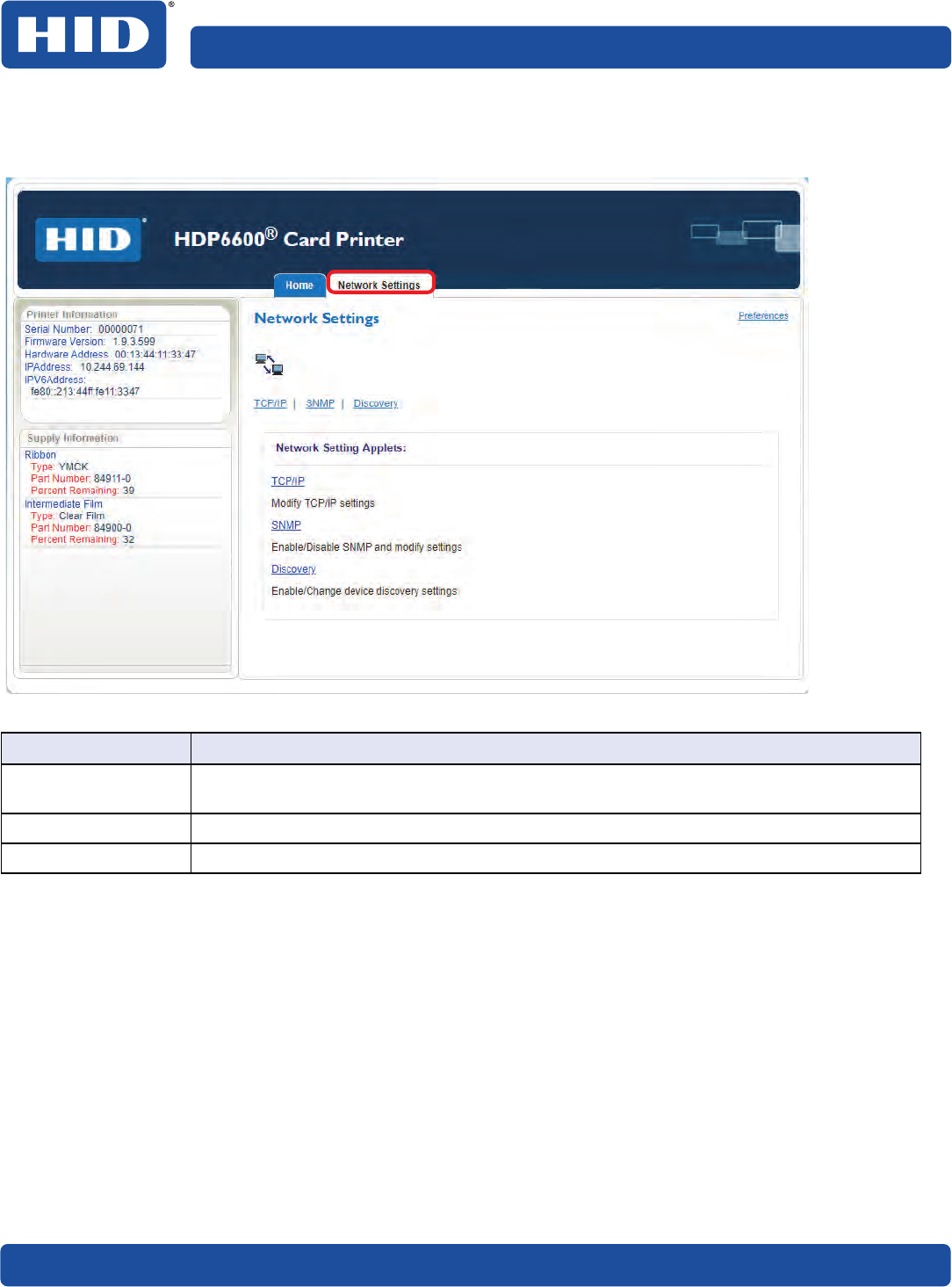
92 September 2018
Ethernet option PLT-02931, Rev. A.0
5.5.4 Configuring the network settings
Select the Network Settings tab. The Network Settings page displays the current network settings.
Field Description
TCP/IP Modify the network communications using the transmission control and internet protocol
(TCP/IP) settings.
SNMP Enables or disables the simple network management protocol (SNMP) and modify settings
Discovery Enable or change device discovery settings.
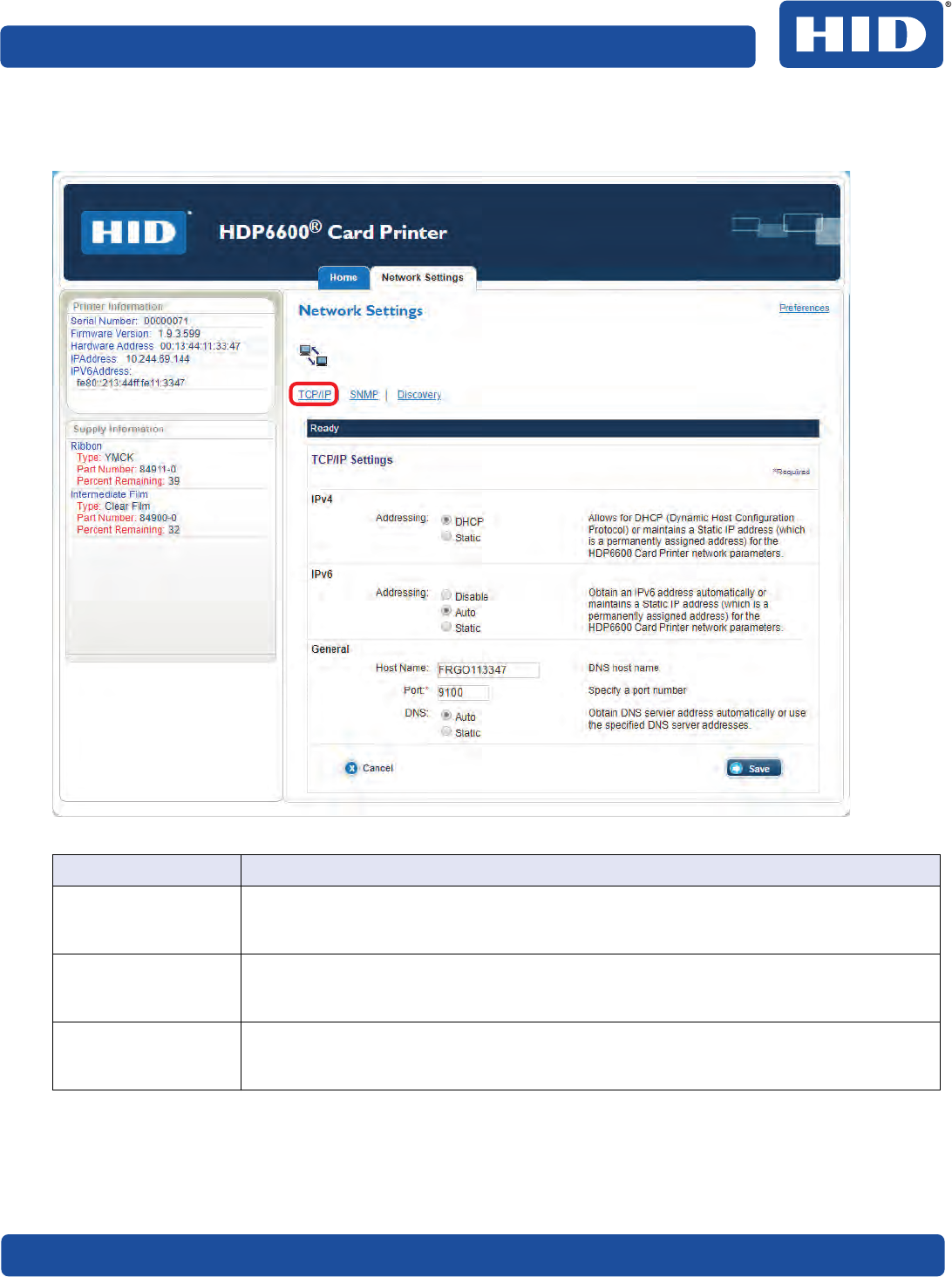
September 2018 93
PLT-02931, Rev. A.0 Ethernet option
5.5.4.1 TCP/IP settings
1. Select the TCP/IP link to display the current TCP/IP network settings.
2. Make any necessary changes and click Save.
Note: You may need to confirm your administrative rights by entering a valid user name and password.
You may also need to restart the printer to save any changes. See Section 5.5.3 Changes to the
settings.
Field Description
IPv4 Sets either a dynamic host configuration protocol or maintains a permanently assigned
IP address for the HDP6600 card printer network parameters. Available options are:
DHCP or Static.
IPv6 Sets the IPv6 address automatically, maintains a permanently assigned IP address, or
disables the IP address for the HDP6600 card printer network parameters. Available
options are: Disable, Auto, and Static.
General Sets the domain name system (DNS) name, port number, and an automatic or
permanently assigned DNS server address. Available fields are Host Name, Port
(required), and DNS options: Auto or Static.
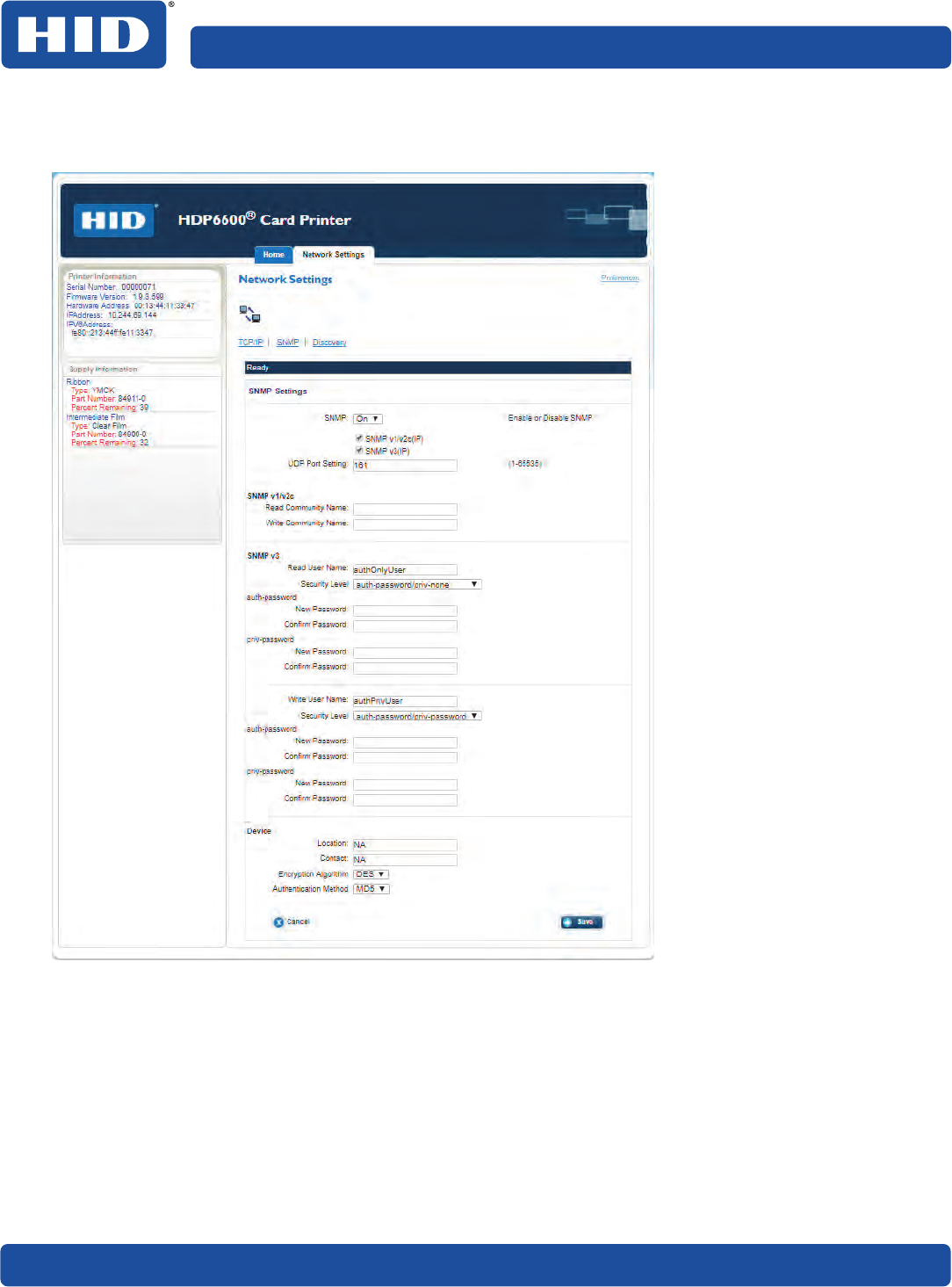
94 September 2018
Ethernet option PLT-02931, Rev. A.0
5.5.4.2 SNMP settings
1. Select the SNMP link to display the current SNMP network settings.
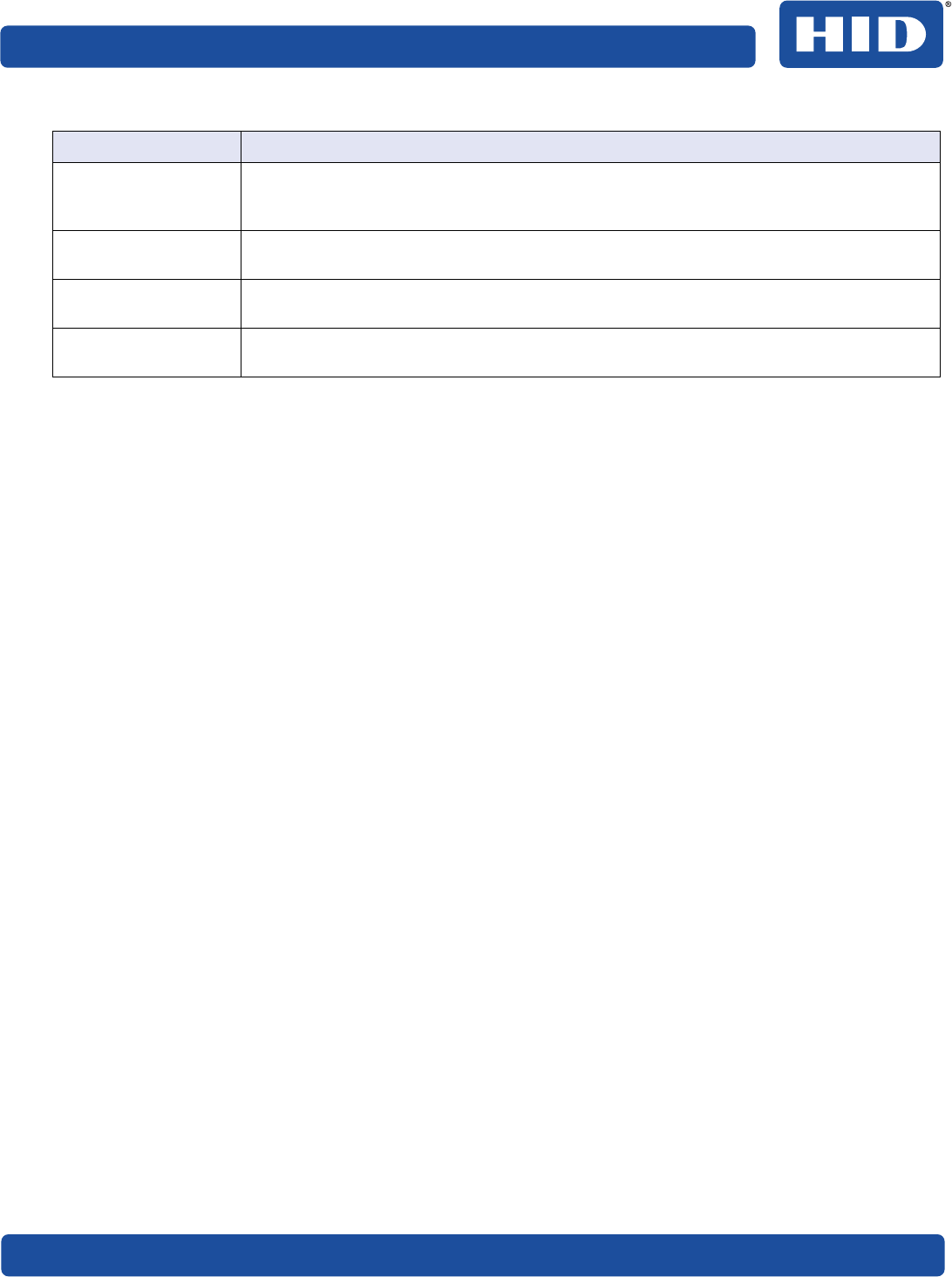
September 2018 95
PLT-02931, Rev. A.0 Ethernet option
2. Make any necessary changes and click Save.
Note: You may need to confirm your administrative rights by entering a valid user name and password.
You may also need to restart the printer to save any changes. See Section 5.5.3 Changes to the
settings.
Field Description
SNMP Settings Enable or disable simple network management protocol (SNMP). Select the version you
wish to use. Available options are SNMP v1/v2c and SNMP v3. Also specify the UDP Port
Setting.
SNMP v1/v2c Enter the Read Community Name and the Write Community Name for the SNMP v1/v2c
setting.
SNMP v3 Enter the Read User Name/Write User Name, Security Level, auth-password, and
priv-password for the SNMP v3 settings.
Device Enter the Location, Contact, Encryption Algorithm, and the Authentication Method for
this device.
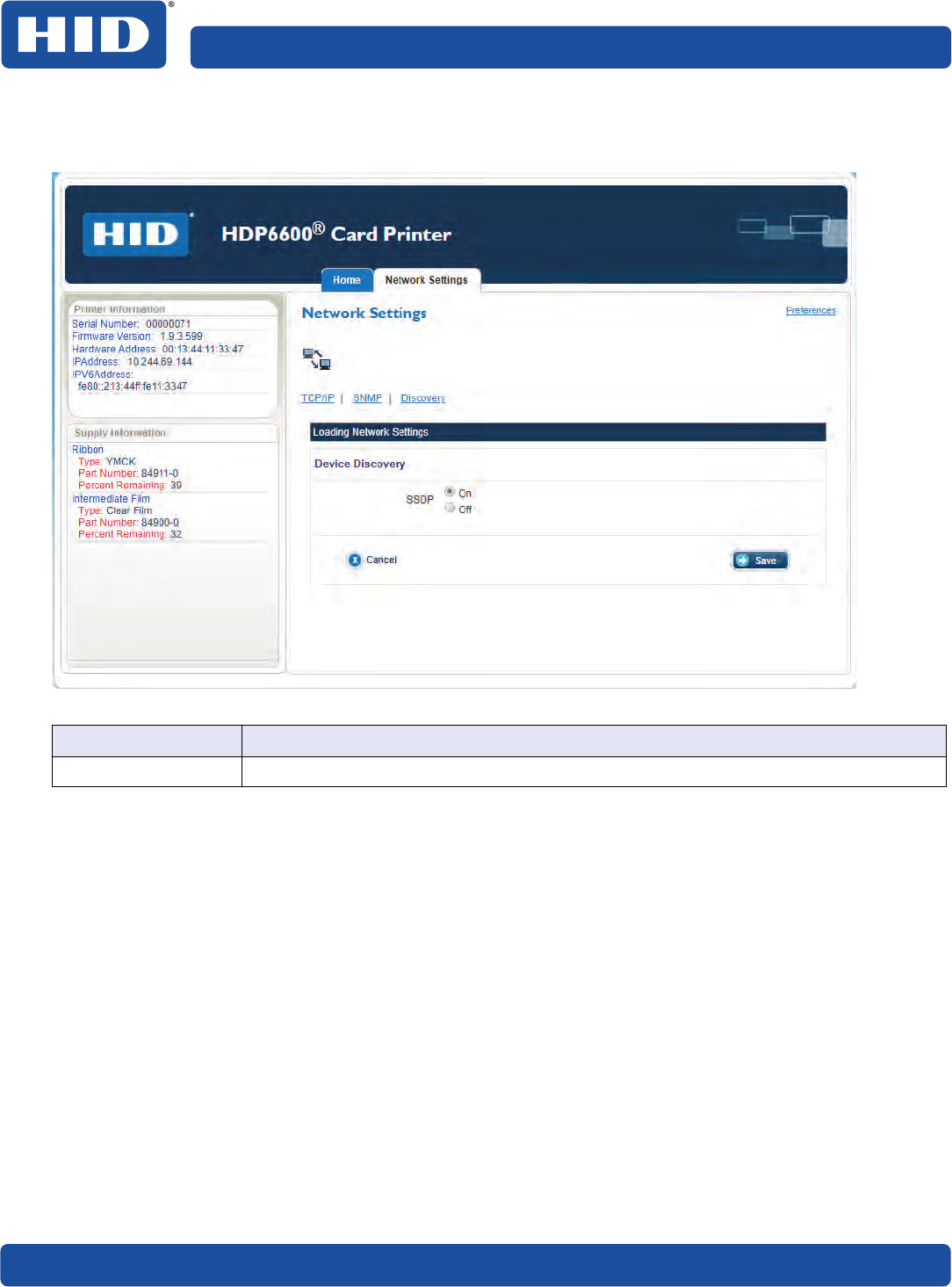
96 September 2018
Ethernet option PLT-02931, Rev. A.0
5.5.4.3 Discovery settings
1. Select the Discovery link to display the current device discovery network settings.
2. Make any necessary changes and click Save.
Note: You may need to confirm your administrative rights by entering a valid user name and password.
You may also need to restart the printer to save any changes. See Section 5.5.3 Changes to the
settings.
Field Description
Device Discovery Turns device discovery on or off.
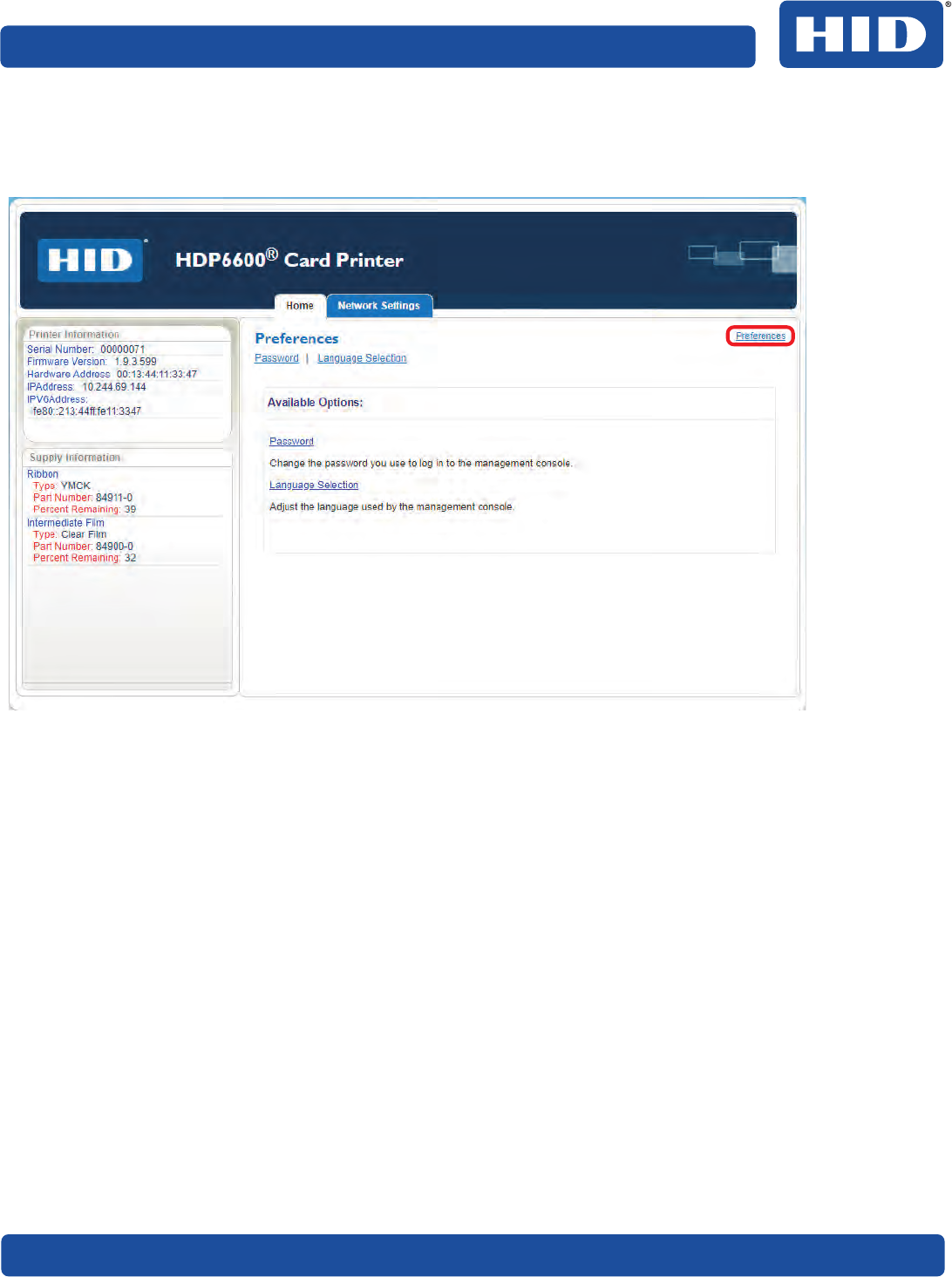
September 2018 97
PLT-02931, Rev. A.0 Ethernet option
5.5.5 Preferences
The Preferences can be accessed from any of the pages of the interface. Using the Preferences page, you can
change your web interface log in password and your language selection.
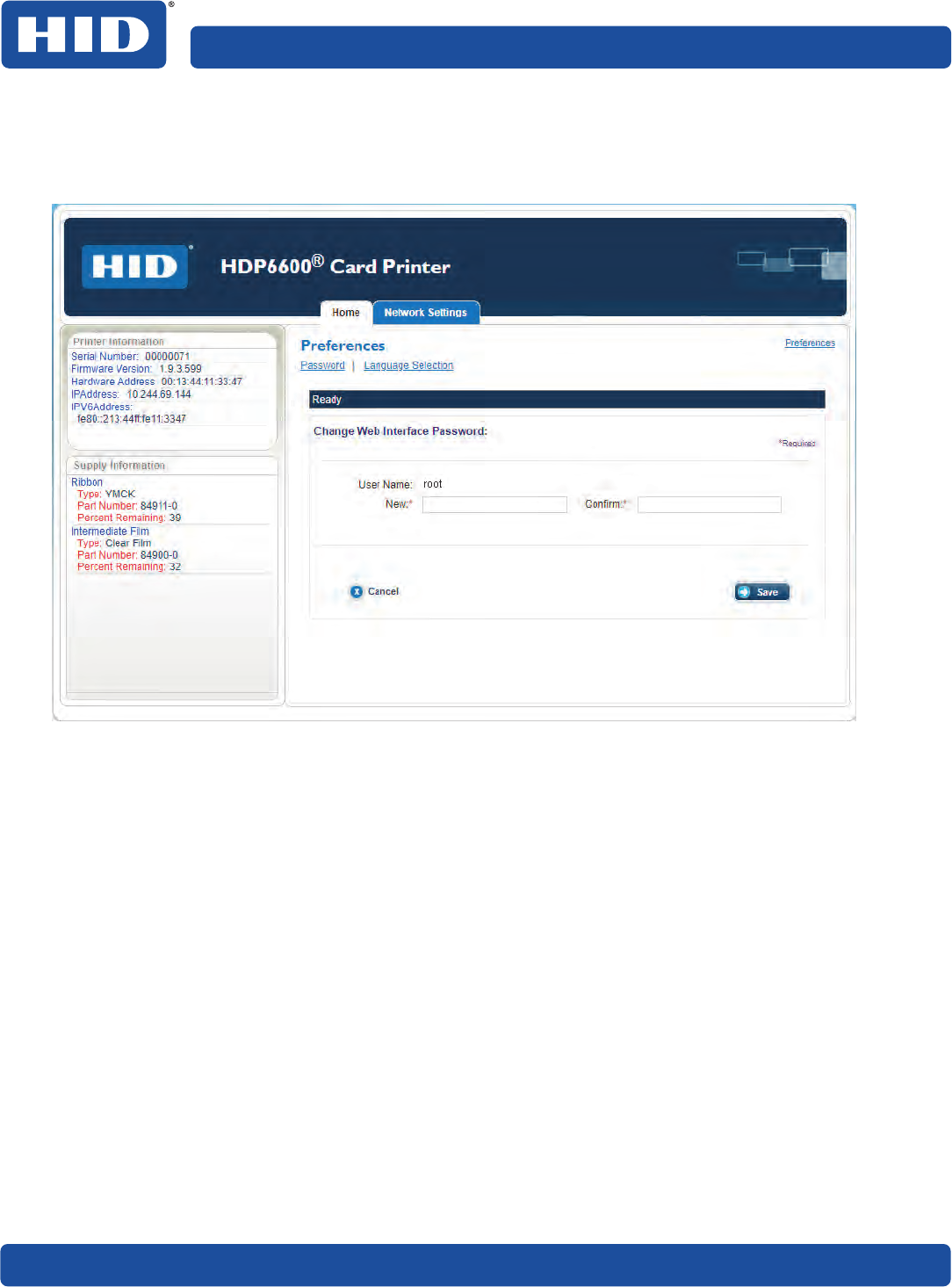
98 September 2018
Ethernet option PLT-02931, Rev. A.0
5.5.5.1 Change password
1. Click the Password link.
The Change Web Interface Password window is displayed.
2. Enter a new password. This field is required.
3. Re-enter the new password to confirm. This field is required.
4. Click Save.
Note: You may need to confirm your administrative rights by entering a valid user name and password.
You may also need to restart the printer to save any changes. See Section 5.5.3 Changes to the
settings.
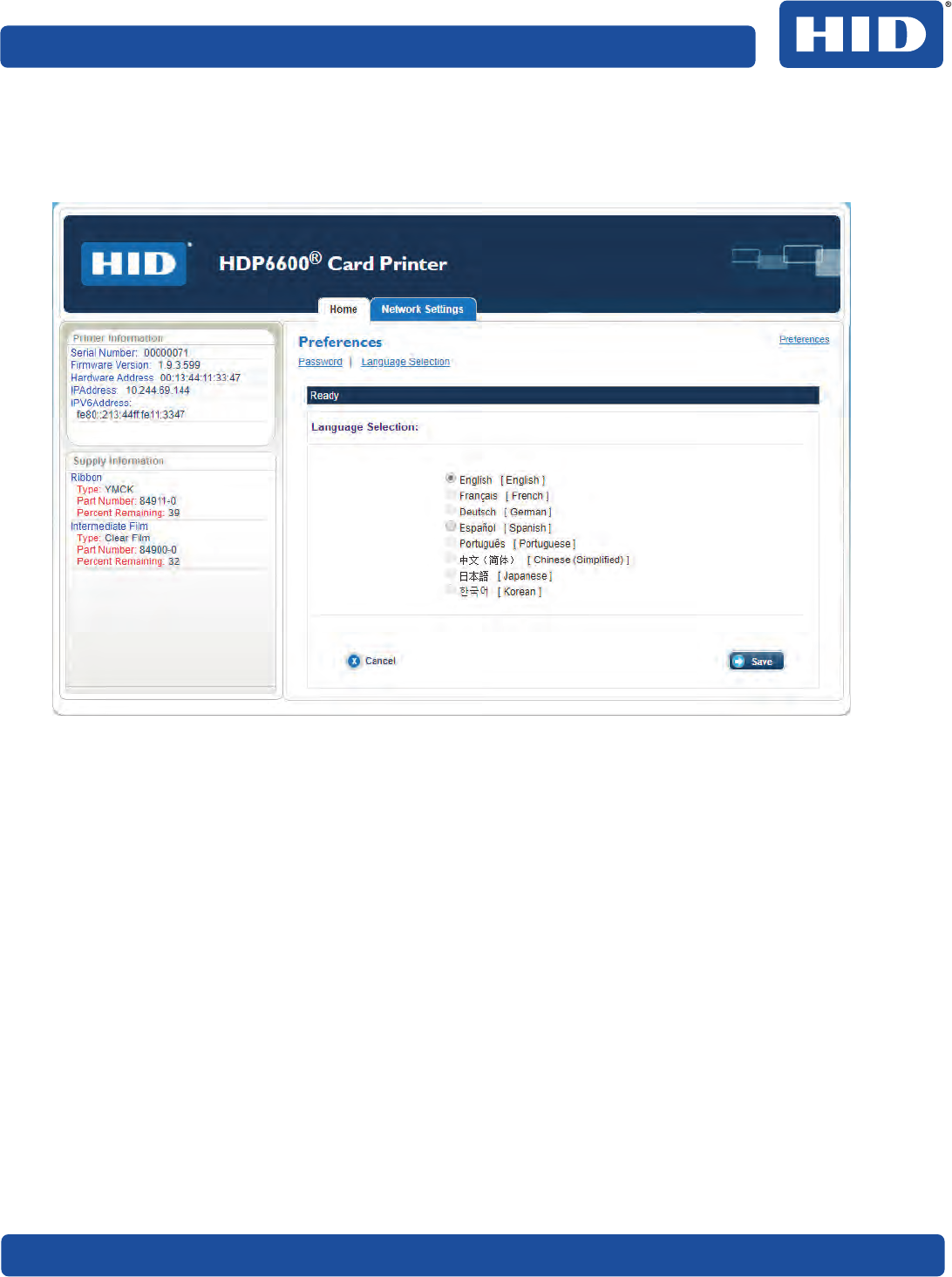
September 2018 99
PLT-02931, Rev. A.0 Ethernet option
5.5.5.2 Language selection
1. Click the Language Selection link.
The Language Selection window is displayed.
2. Select a language.
3. Click Save.
Note: You may need to confirm your administrative rights by entering a valid user name and password.
You may also need to restart the printer to save any changes. See Section 5.5.3 Changes to the
settings.
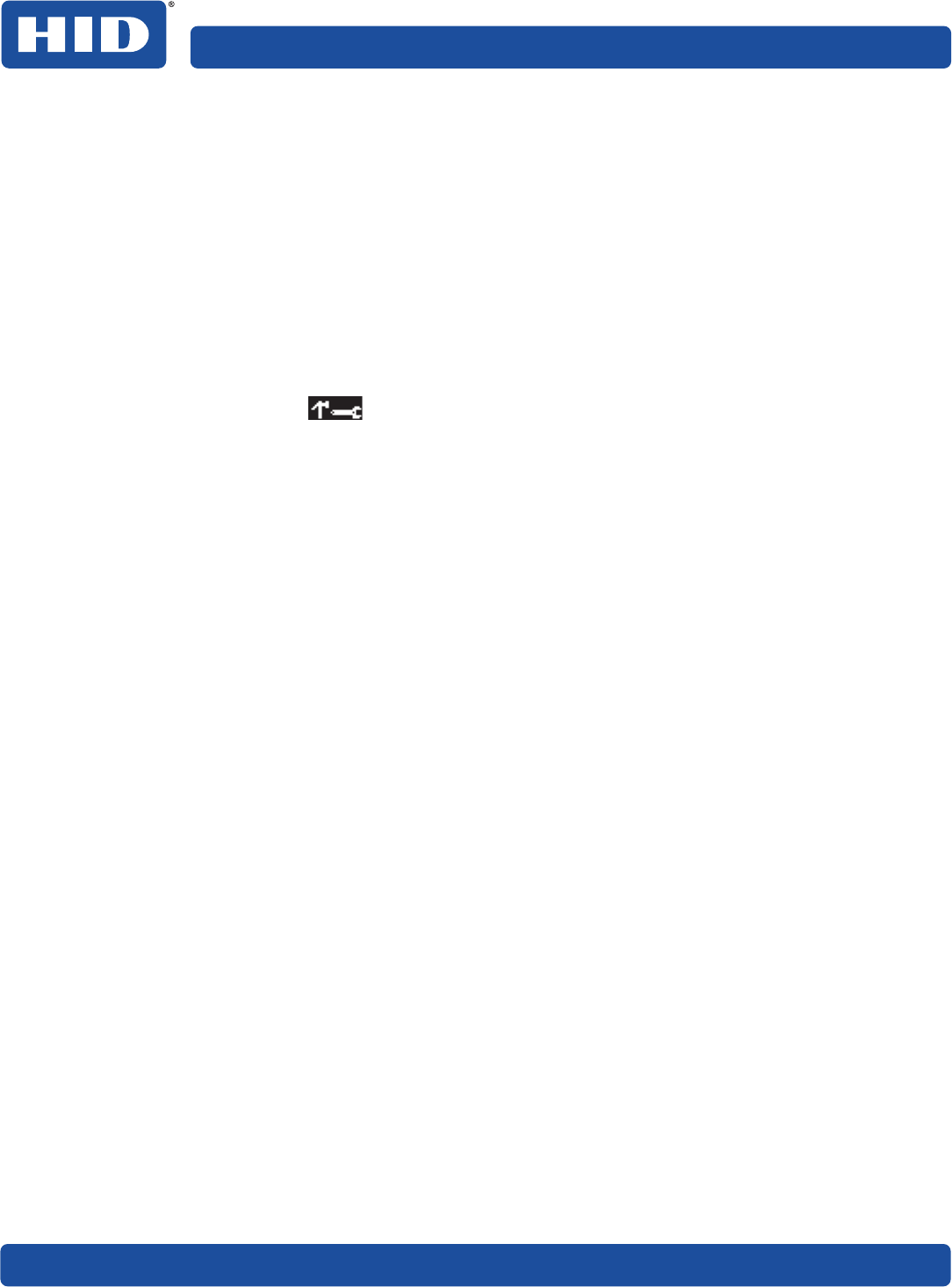
100 September 2018
Ethernet option PLT-02931, Rev. A.0
5.6 Troubleshooting
If you are having trouble connecting to your Ethernet printer or printing to it, you should go through each of
the following procedures.
5.6.1 Accessing the IP address of the printer
The additional printer display menus for an Ethernet-enabled printers are provided to view its IP address.
Follow these procedures to access the IP address of your printer.
1. Switch on the printer.
2. Ensure the printer is connected to the network.
3. Wait up to one minute to allow the printer to configure the IP address.
4. On the printer display, select > Info.
5. Scroll through the messages until the IP address is displayed as a dotted quad number, i.e. 168.192.1.1.
5.6.2 Verifying the printer connection
1. Ensure the printer has a valid network connection.
2. Verify that the printer has the green LED on solidly and that the amber LED is flashing with network
activity.
3. If the LEDs do not indicate connection, verify the network connection with another device.
4. If the connection is OK, then something may be wrong with the Ethernet option installation.
5.6.3 Verifying the printer IP address
1. Check the printer display for a valid IP address (0.0.0.0 is not valid).
႑If the IP address is valid, go to Step 4.
႑If the IP address is not valid go to Step 2.
2. If your network is using DHCP, then verify that the printer has not been configured to use a static
address (unless you have a known, unused static IP address assigned to the printer).
3. If you are using a static IP address, verify that there is no other device using the same address by
removing your printer and sending a ping to the desired address.
4. If any device responds, then you must find a different available IP address.
5. If the printer reports an IP address, verify that it matches subnet of the network where it is connected.
6. If your printer has DHCP disabled, then the static IP address may have been previously set for a
different subnet.
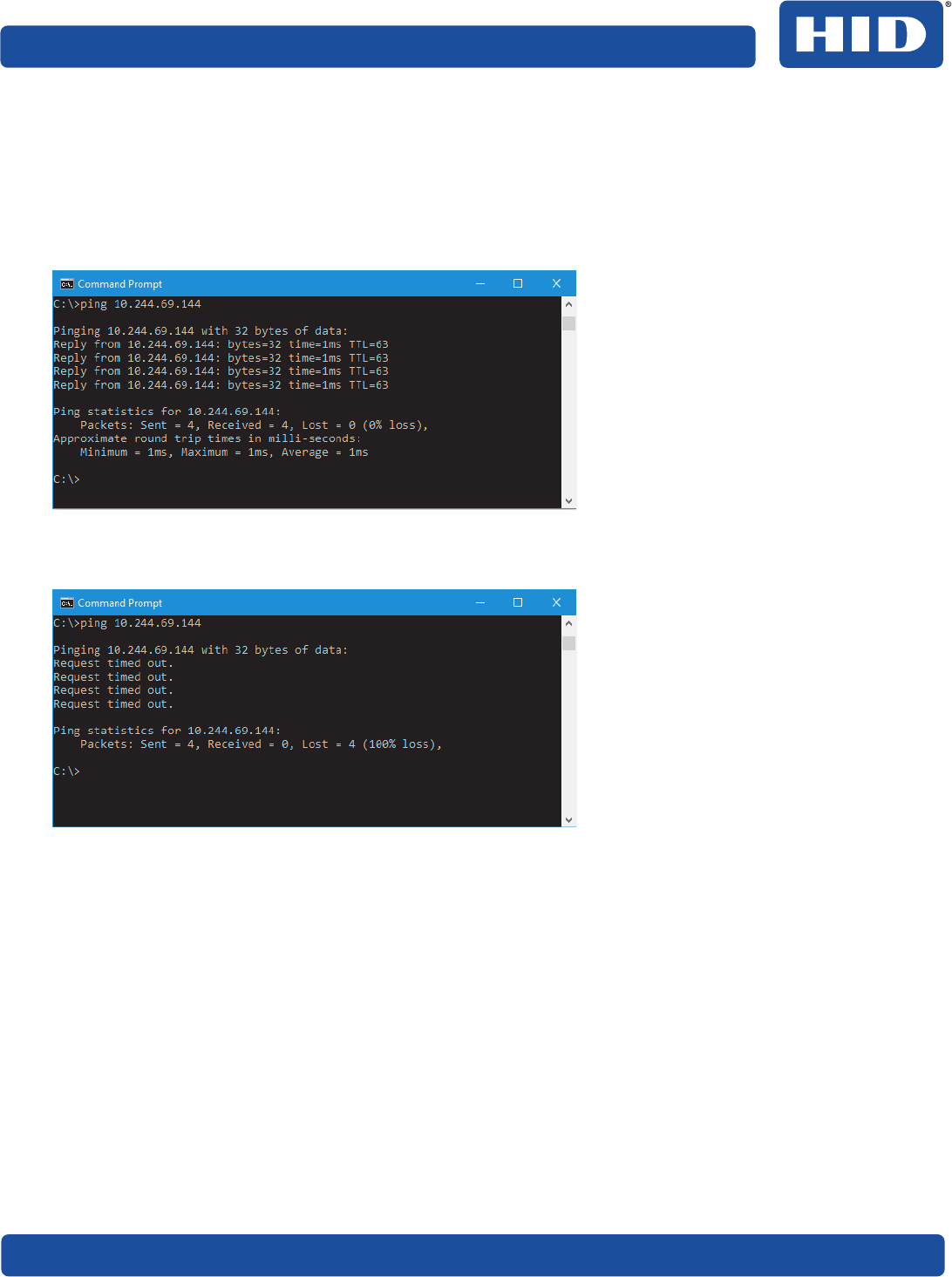
September 2018 101
PLT-02931, Rev. A.0 Ethernet option
5.6.4 Verifying that the PC can access the printer using the ping command
Follow these instructions to issue a ping command to the printer.
1. At a Command Prompt window, enter “ping [IP address]”:
For example: C:\>ping 10.244.69.144
2. A successful ping response is shown here:
3. If the response is successful, move on to the next troubleshooting procedure.
4. An unsuccessful response is shown here:
5. If the ping response is not successful, continue to Step 6.
6. Verify that the PC and the printer are connected to the same network.
7. You may be on different subnets of your network and some of the network settings for the printer are
not correct. See your network administrator for additional assistance.
Note: The subnet mask must be the same as other devices on the network, and the unique IP address
must be part of the network specified by the subnet mask.
5.6.5 Printing a test page
Try printing a test page from the printer driver properties window.
If you cannot print a test page, then consider the following possibilities:
႑There may be an error at the printer.
႑There may be a job in the Windows print queue which has stalled.
႑The printer may be paused or set to operate offline in the Windows print queue.
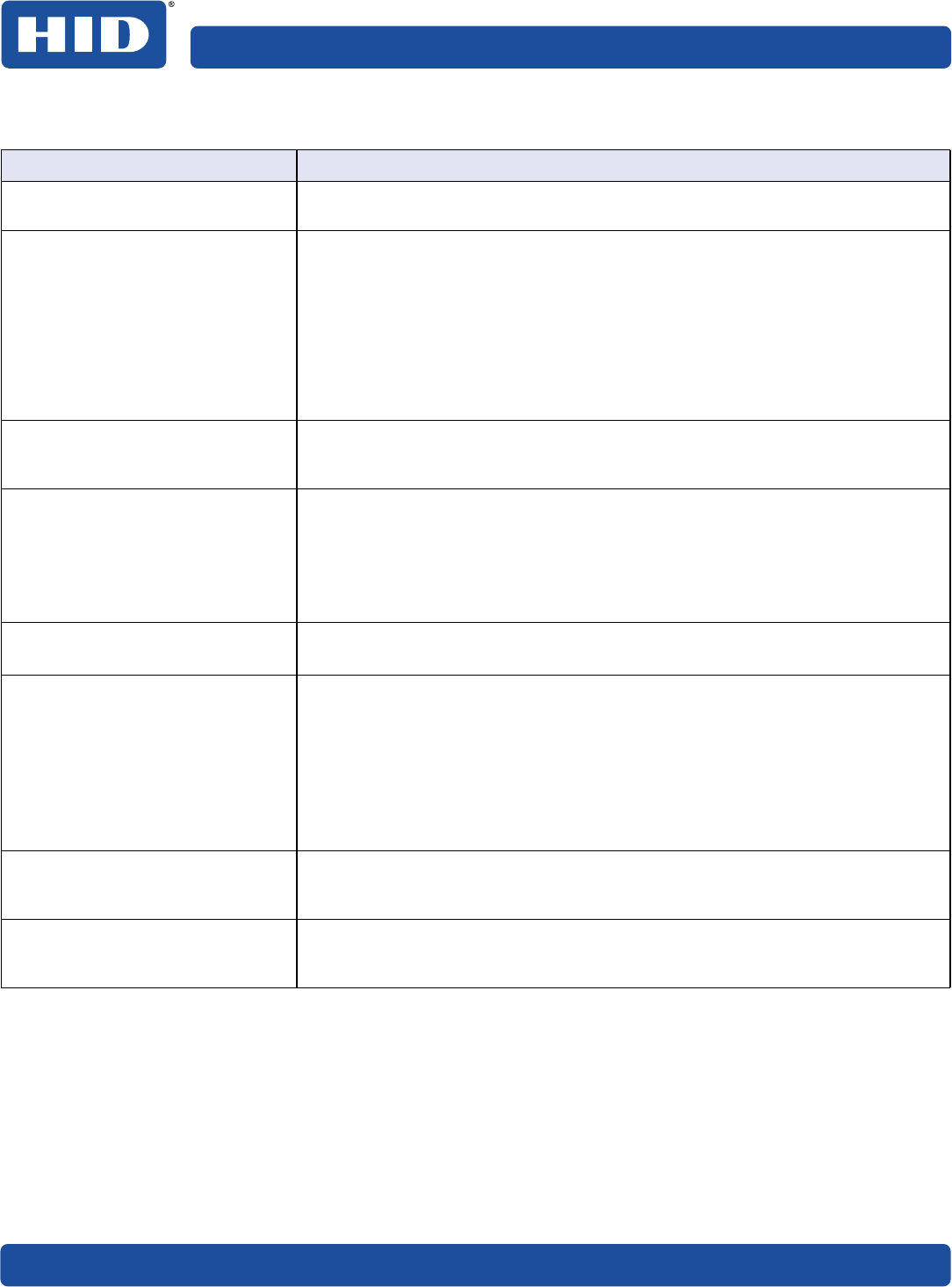
102 September 2018
Ethernet option PLT-02931, Rev. A.0
5.7 Frequently asked questions
Question Answer
How do I know if my printer has the
Ethernet option installed?
All printer models come with Ethernet installed as standard equipment.
What PC operating systems work
with my Ethernet printer?
႑Windows 7 (32- and 64-bit)
႑Windows 8 / 8.1 (32- and 64-bit)
႑Windows 10 (32- and 64-bit)
႑Windows Server 2008 R1 (32- and 64-bit)
႑Windows Server 2008 R2 (64-bit only)
႑Windows Server 2012
႑Windows Server 2012 R2
႑Windows Server 2016
How do I connect my printer to my
network?
You can connect from the RJ45 network connection on the back of your printer
to an available connection on your network (not directly to your PC). You can use
a good CAT-5 or better cable to make this connection.
How can I find the MAC address of
my Ethernet printer?
Do one of the following:
႑If you know the IP address of your printer, you can see the MAC address on
the Home page of the print server.
႑If you do not know the IP address or the printer does not work with a
usable IP address, then the MAC address is listed in the data printed on the
“Printer Settings” self-test card.
How can I find the IP address of my
Ethernet printer?
You can find it on the printer display if the Ethernet option is functioning properly.
Select Info, then click Next several times until the IP address is shown.
Can I print from my PC to multiple
Ethernet printers?
Choose Local printer… unless a shared network printer is to be installed on a
print server.
Use the Windows Add Printer Wizard to create a printer instance to
communicate to the printer at the new IP address.
If the printer port is not listed as an existing port then a new Card Printer TCP/IP
Port must be created and configured to communicate to the printer at the proper
IP address.
See the appropriate Windows documentation for additional help.
Can multiple PCs print to my
Ethernet printer?
Yes. Each PC must install the printer driver software for the specific
Ethernet-enabled printer and connect to the intended printer using the correct IP
address.
Can I print from my PC to an
Ethernet printer on a different
network segment?
Yes. If you know the IP address of the printer on any segment of your network,
you will be able to print to it.
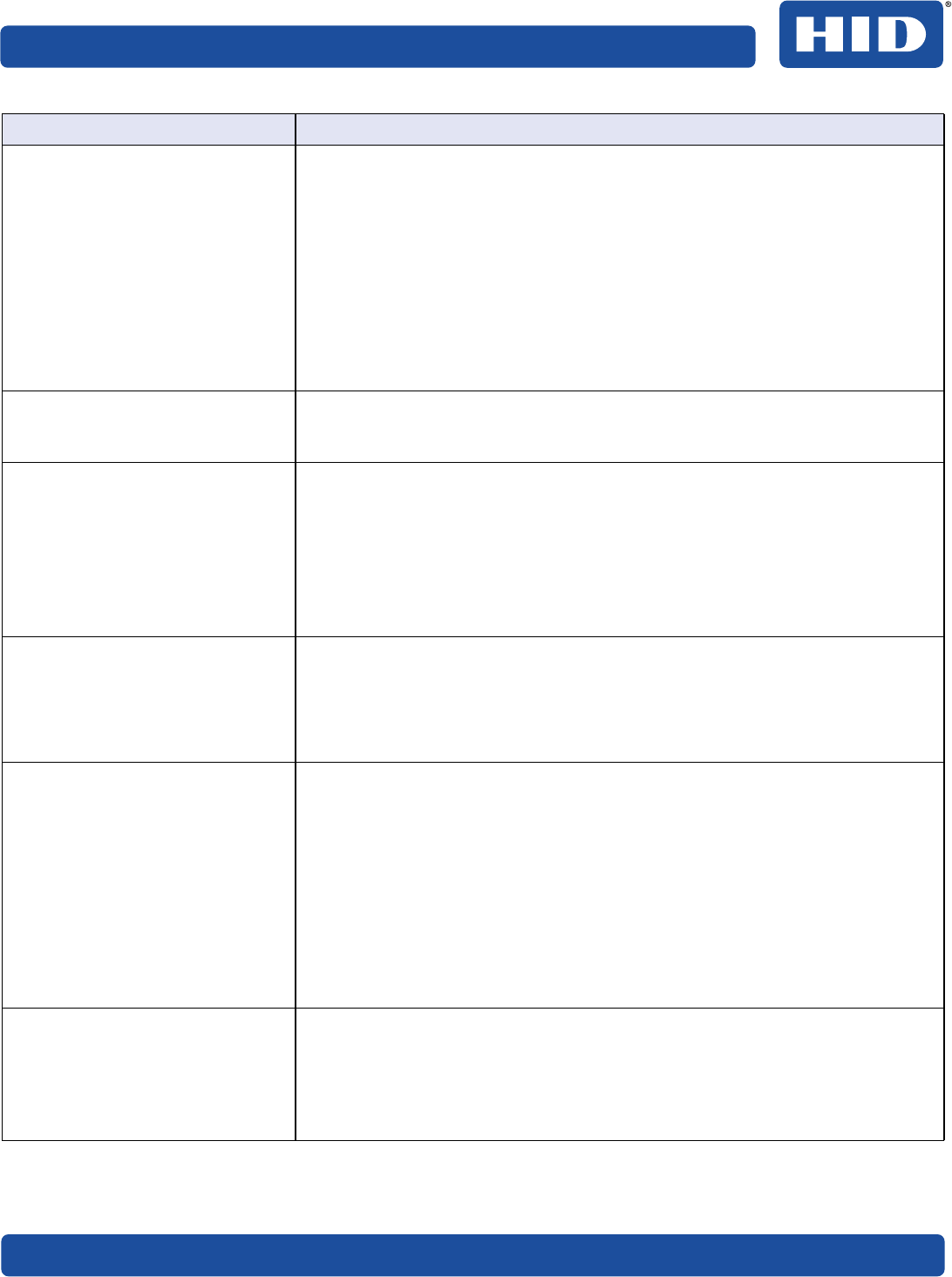
September 2018 103
PLT-02931, Rev. A.0 Ethernet option
How do I upgrade the printer
firmware in my Ethernet-enabled
printer?
This is done in the same way as a USB-connected printer. The PC doing the
upgrade must have a driver installed for the printer to be upgraded. This varies by
the level of Microsoft Windows you are running. In general,
1. Run the Driver Update Manager from the Settings > Devices > HDP6600
Card Printer > Manage > Printing Preferences.
2. Go to the Utilities tab.
3. Select Update Manager.
4. Click Check for updates.
5. Select the printer you wish to update.
6. Select the update you wish to install.
7. Click Begin Updating Firmware.
How do I upgrade the print server
firmware for my printer?
Since the print server is integrated into the main print firmware on the printer,
there is not a separate firmware upgrade for the printer server.
Note: Therefore, the upgrades are done with the main printer firmware.
What do I do if the IP address of
my printer is being changed by my
network?
Do one of the following:
႑Contact your network administrator. Ask that your current IP address be
reserved or ask that they provide a specific IP address that you can use to
configure the Ethernet interface.
႑Choose an IP address that you know is not used by any other PC, server or
network device. Use those settings to configure your printer with static
network settings.
Note: Do not do this unless you know that these settings are always available.
How do I reconfigure my PC printer
driver to connect to a different
printer or different IP address?
Choose Local printer… unless a shared network printer is to be installed on a
print server. Use the Windows Add Printer Wizard to create a printer instance to
communicate to the printer at the new IP address. If the printer port is not listed
as an existing port then a new Card Printer TCP/IP Port must be created and
configured to communicate to the printer at the proper IP address. See the
appropriate Windows documentation for additional help.
How can I verify/change the IP
address where my installed printer
driver is expecting to find my
printer?
This varies by the level of Microsoft Windows you are running. In general,
1. Open the Settings > Devices > HDP6600 Card Printer > Manage > Printer
Properties.
2. From the Ports tab, select Configure Port. The Host Name indicates the IP
address of the connected printer.
3. If this does not match your printer's IP address, you can change it from this
window.
4. Enter the correct IP address.
5. Click OK.
6. Click Apply.
7. Click Close.
How do I configure my printer's IP
settings?
Do one of the following:
႑By default, the printer is configured for dynamic IP address assignment.
That is, it will try to get its IP address and other settings from your network.
If it is given valid network settings, it use s those.
႑You can choose to configure the printer, using a static IP address and
network settings.
Question Answer
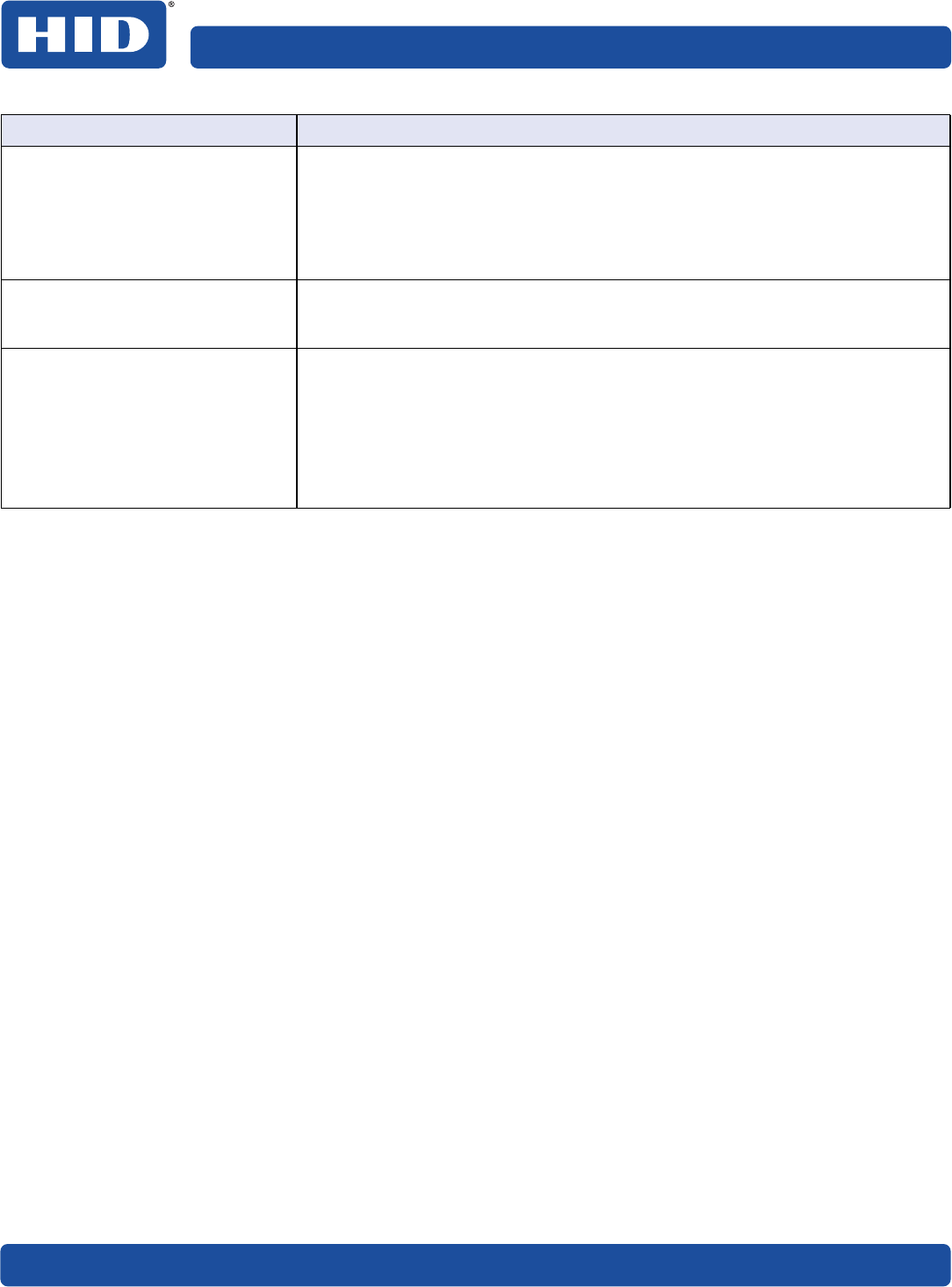
104 September 2018
Ethernet option PLT-02931, Rev. A.0
How do I choose a static IP address
for my printer?
Use the Network Settings page if you know the current IP address.
The printer also allows you to save the current network settings as static settings
using the printer display menu (Network Settings > TCP/IP ), and then switch
DHCP (dynamic IP address selection) to DISABLED.
Note: You can save static addresses. However, they are not used until you
reconfigure the printer to use those static addresses and reboot the printer.
What do the LEDs by the Ethernet
connection on the back of the
printer indicate?
The green LED indicates a valid Ethernet connection.
The amber LED indicates network activity.
How do I print a test page from
Windows to verify the Ethernet
configuration of the printer and
printer driver?
This varies by the level of Microsoft Windows you are running. In general,
1. Open the Windows Settings page.
2. Select Settings > Devices > HDP6600 Card Printer > Manage > Printer
Properties.
3. Select the General tab.
4. Ensure that the printing preferences are set correctly for the ribbon
installed in your printer. Then select Print Test Page.
Question Answer
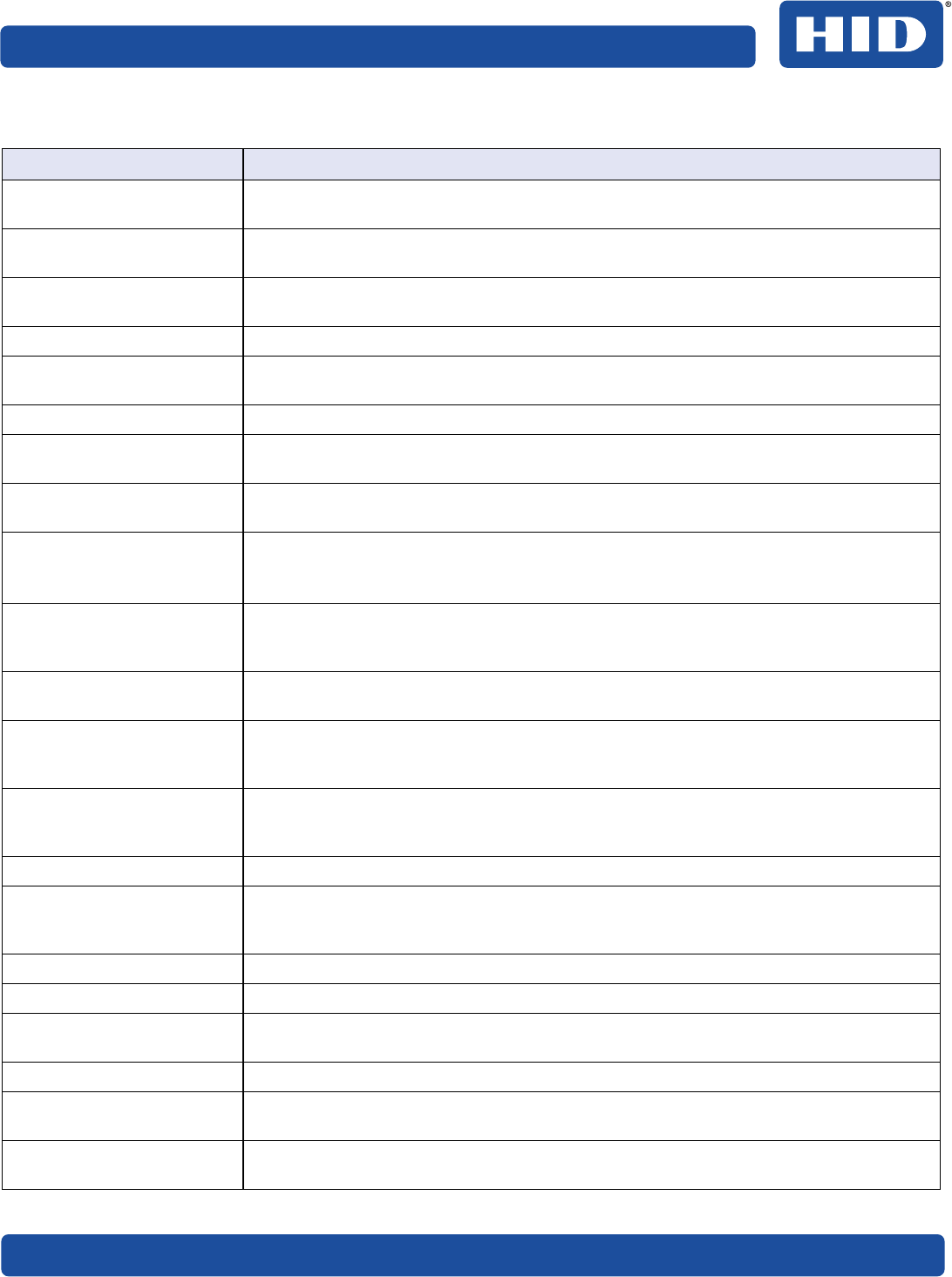
September 2018 105
PLT-02931, Rev. A.0 Ethernet option
5.8 Glossary of terms
Term Definition
Default gateway Specifies the address of the router (in a network using subnets) that forwards traffic to
a destination outside of the subnet of the transmitting device.
DHCP (Dynamic Host
Configuration Protocol)
The protocol used by a network to automatically assign network settings to connected
devices so that they work together.
DNS (Domain Name System) Defines the network protocol that allows devices to find IP addresses from a network
name server.
DNS domain suffix This is the suffix to be added to the domain name to make a complete name.
DNS server address This is the address of the server that provides the translation from a descriptive name to
an IP address.
Guest user A user without rights to change printer settings.
ICMP (Internet Control
Message Protocol)
The basic message protocol for the internet.
IP (Internet Protocol) The network protocol that identifies devices and messages by addresses so that
communications can occur between devices on different local networks.
IP addresses Specifies the current IP addresses that are 32-bit values that are normally expressed in
dotted-quad format.
Note: This address must not be the same as another device on the same local network.
MAC (Media Access Control) The unique numeric value address associated with a network device that gives the
device a unique identity. This address is assigned by the device manufacturer to ensure
its uniqueness.
MIB (Management
Information Base)
A formal description of the way an agent can be accessed using SNMP and the
functions that can be managed.
Network settings The basic network parameters needed to configure the network interface. These include
the IP address, the subnet mask, the default gateway, the DNS server address and the
DNS domain suffix.
Ping A common utility or command that sends a message to network devices asking for a
return message. This is used to diagnose if the device is on the network or to
troubleshoot the connection.
Root user A user with administrative rights to change any printer settings.
SNMP (Simple Network
Management Protocol)
This is protocol for the network management services. This protocol provides a means
for network compliant devices, called agents, to store data about themselves in
Management Information Bases (MIBs) and return this data to the SNMP requesters.
Subnet mask Specifies a 32-bit value that routers use to send a message to the correct subnet.
Syslog The standard method for logging system events.
TCP (Transmission Control
Protocol)
The network protocol that allows reliable network communications between devices.
TCP/IP Network communications using TCP and IP protocols.
Telnet This is a common terminal emulation program that allows a user to send commands to a
TCP/IP connected device and receive the responses.
UDP (User Datagram
Protocol)
Defines a protocol for sending and receiving messages on a network.

Ethernet option PLT-02931, Rev. A.0
This page is intentionally left blank.
106 September 2018
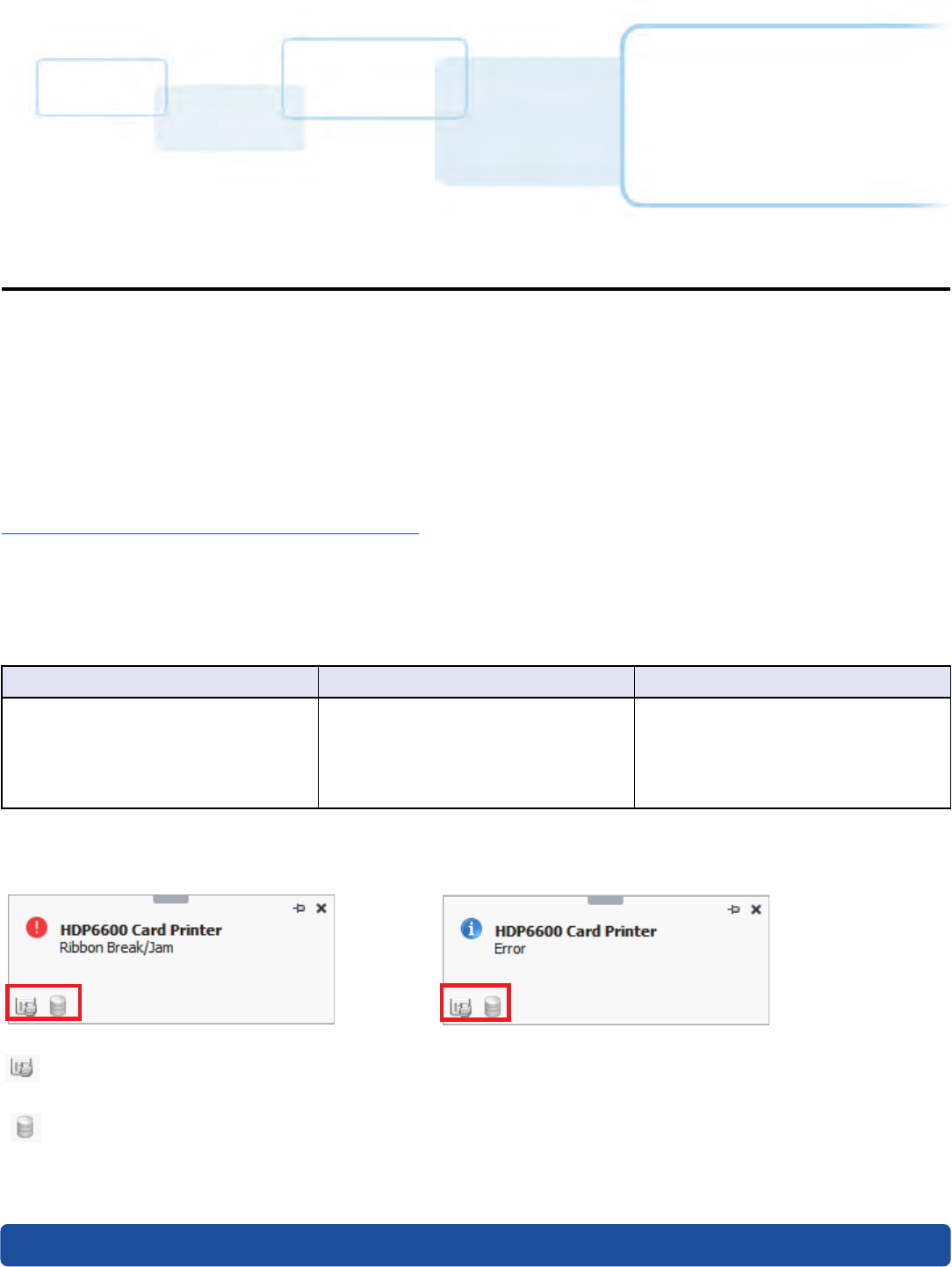
Section
6
September 2018 107
6 Troubleshooting
This section provides specific procedures relating to diagnosing error messages shown on the printer display
and the HID Printer Status monitor.
6.1 Error message tables
This section provides two troubleshooting tables: the printer display error messages and the messages shown
in the status monitor. Each table uses a 3-column presentation to present a specific error shown in the printer
display or the printer error message shown on your PC, its cause and solution.
If you encounter problems beyond the capabilities of these two error message tables, visit:
http://www.hidglobal.com/customer-service.
6.1.1 How to use the error message tables
The Printer Display Error Message column contains the error message and number that is displayed on the
printer display. In the following table and screen capture examples, you can find the printer display error
message or the Error Message number and then troubleshoot your printer as needed.
You can also view the error information in the HID Status Monitor by clicking the icons on the error messages
when they are displayed on your PC. These icons open the Configuration tab or the system Event Log tab of
the status monitor, where you can view additional information.
Printer Display Error Message Cause Solution
Ribbon Break/Jam
Error Message No. 523, 537
Matches the following screen shots.
The ribbon is not able to find the next
panel correctly. Check for
jams/breaks.
If jammed, clear the jam. If the ribbon
is broken, repair it by taping the
ribbon back on to the take-up core.
Press Resume to continue or Cancel
to abort.
Opens the Configuration tab of the HID printer status monitor. See Section 4.1 Configuration tab to
view current status of the selected instance.
Opens the System Event Log tab of the HID printer status monitor to view the latest print job
statuses. See Section 4.2 System event log tab to view current print jobs.
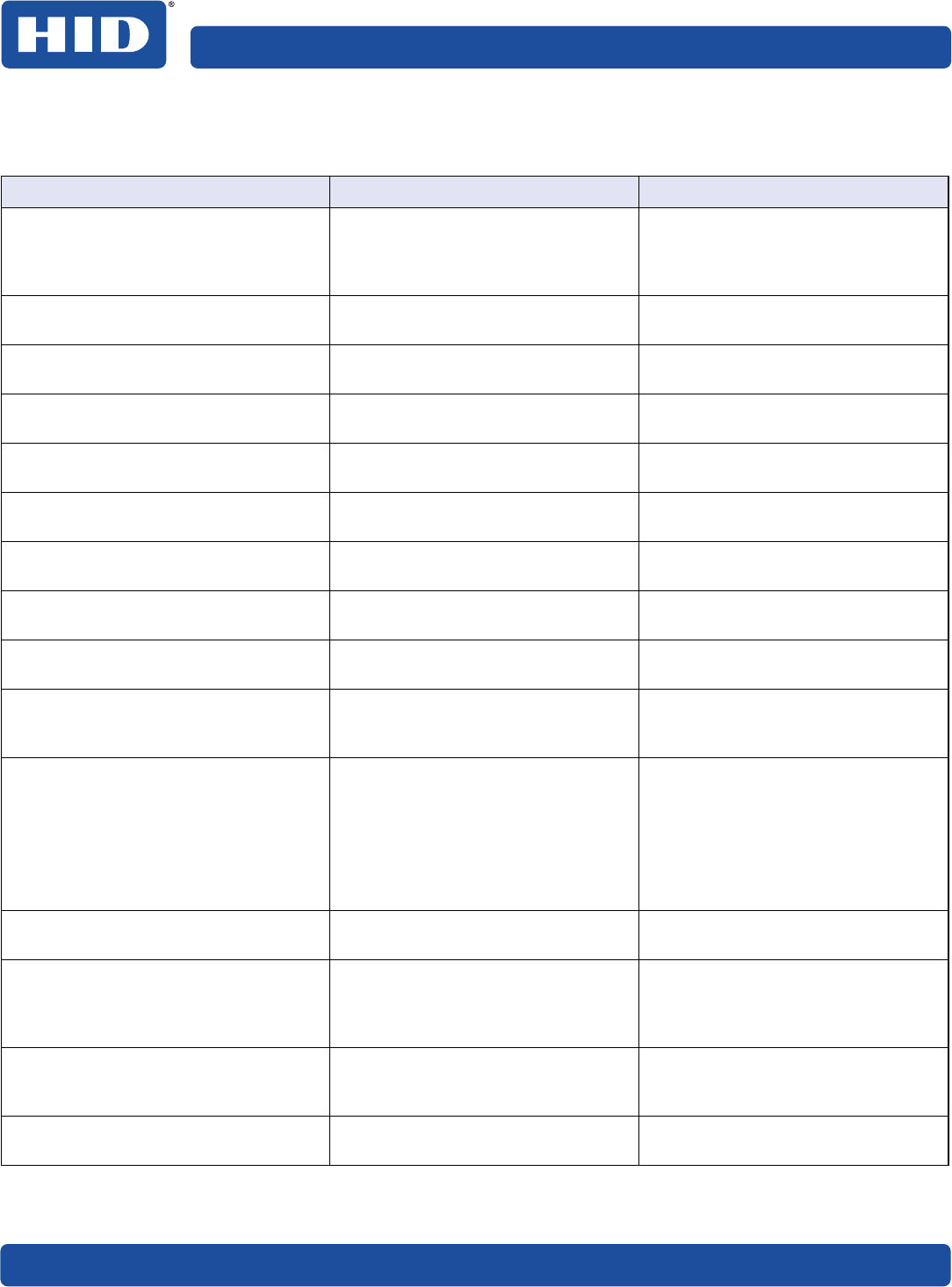
108 September 2018
Troubleshooting PLT-02931, Rev. A.0
6.1.2 Troubleshooting with the printer display error message table
The printer display shows the current status of the printer.
Printer Display Error Message Cause Solution
Calibrate Failed
Error Message No. 508, 535
Film or ribbon calibration has failed. Verify the film is installed correctly
and there is not a ribbon installed. If
this problem persists, call for
technical assistance.
Calibrate Film
Error Message No. 504
Film sensors need to be calibrated. Press Cancel and then perform the
film calibration procedure.
Calibrate Ribbon
Error Message No. 527
The print ribbon sensor is out of
calibration.
Press Cancel and then perform the
ribbon calibration procedure.
Card Jam
Error Message No. 467, 476, 484
A card is jammed in the print station
or card flipping area of the printer.
Clear the jam.
Card Jam: Smart Card
Error Message No. 469
A card is jammed in the smart card
encoding area of the printer.
Clear the jam.
Card Jam
Error Message No. 466
Card became jammed in the printer
during transfer.
Clear the jam.
Card Not Found
Error Message No. 465
Card cannot be found in the printer. Verify that the card is not jammed in
the printer and press Cancel.
Check Film
Error Message No. 501
The film is not able to move correctly.
Check for jams/breaks.
Check for obstruction. If the problem
persists, call for technical assistance.
Film Sensor Calibration Failure
Error Message No. 508
Film sensor failure. Reset the printer. Make sure film is
installed correctly. Try again.
Ribbon Sensor Calibration Failure
Error Message No. 535
Ribbon sensor failure. Reset the printer and try again. If
failure persists, call for technical
assistance.
Empty Reject Bin
Error Message No. 490
The reject bin is full. Remove the large number of rejected
cards from the reject bin.
Press OK to clear the notification
message.
In some cases, rejected cards are
incomplete or pose a security risk,
and should be disposed of properly.
Check Film
Error Message No. 500, 501, 506
The film is not able to move correctly.
Check for jams/breaks.
Check for obstruction. If the problem
persists, call for technical assistance.
Film Low
Error Message No. 503
The HDP® film will soon run out. If printing a large number of cards,
replace the film now or monitor the
printer until the film is gone and
install a new film.
Film Out
Error Message No. 497, 499
The HDP film has run out. Install a new roll of film and press
Resume to continue or Cancel to
reset.
Invalid Film
Error Message No. 493
The HDP film has been programmed
incorrectly or is damaged.
Verify the correct film is installed in
the film cartridge.
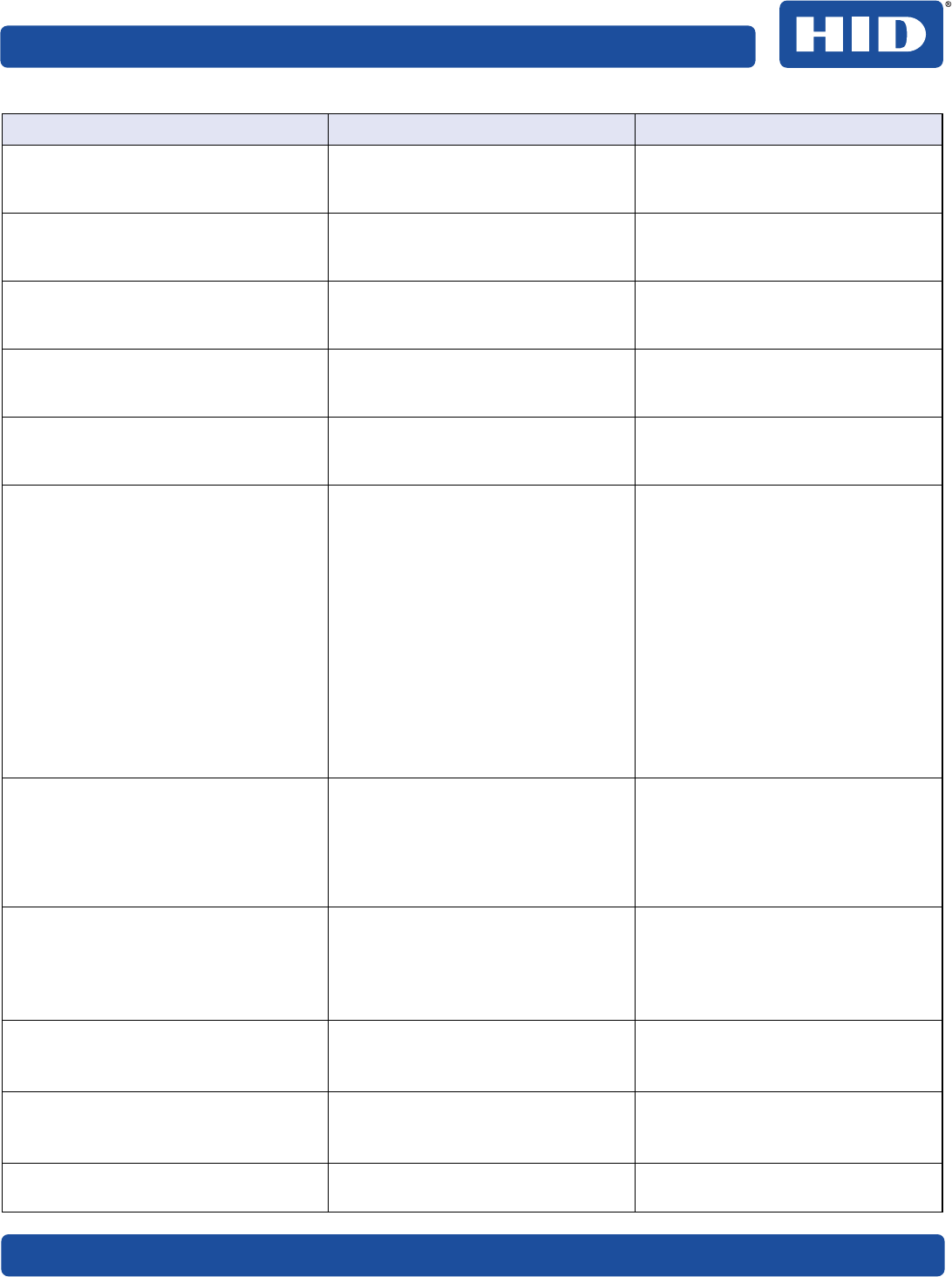
September 2018 109
PLT-02931, Rev. A.0 Troubleshooting
Failed to Initialize
Error Message No. 455, 456
An error has occurred during printer
start up.
Reset the printer and try again. If
problem persists, call for technical
assistance.
Check Options File
Error Message No. 458
Printer not set up correctly or
hardware failure.
Reset the printer and try again. If
problem persists, call for technical
assistance.
No Film
Error Message No. 498
Error reading film tag. Reset the printer and try again. If
problem persists, call for technical
assistance.
Ribbon Tag Error
Error Message No. 524
Error reading ribbon tag. Reset the printer and try again. If
problem persists, call for technical
assistance.
Heater Error
Error Message No. 558, 559
The flattener is too hot. Reset the printer and try again. If
problem persists, call for technical
assistance.
Flipper Jam
Error Message No. 480, 481
A card is jammed in the card flipping
area of the printer.
The flipper table is jammed or
non-functional.
Open the printer flipping module
cover.
Clear any cards in the flipping
module by opening the printer cover
and pressing the Forward and/or
Back buttons located on the printer
display.
Ensure that the flipper module can
rotate freely. Close the printer
flipping module cover.
Press Resume on the printer display
to continue printing.
To cancel the print, click Cancel Print
from the HID Printer Status Monitor.
Head Resistance
Error Message No. 434
The EE setting in printer driver for
head resistance is out of range.
Enter a value for Head Resistance in
the EE settings in the printer driver.
Reset the correct value according to
the steps in Section 3.4.8 Internal
printer settings. If this problem
persists, call for technical assistance.
See Manual
Error Message No. 435, 440
A hardware fault has prevented
setting the correct printhead voltage.
Verify Head Resistance EE setting is
correct.
Reset the printer and try again.
If this problem persists, call for
technical assistance.
Headlift Error
Error Message No. 436, 437, 442, 443
This is a problem with the printhead
lift.
Reset the printer and try again.
If this problem persists, call for
technical assistance.
Heater Error
Error Message No. 551, 557
The transfer heater roller is too hot. Reset the printer and try again.
If this problem persists, call for
technical assistance.
Invalid Ribbon
Error Message No. 519
An unauthorized ribbon is installed in
the printer.
Get the correct ribbon from your
dealer.
Printer Display Error Message Cause Solution
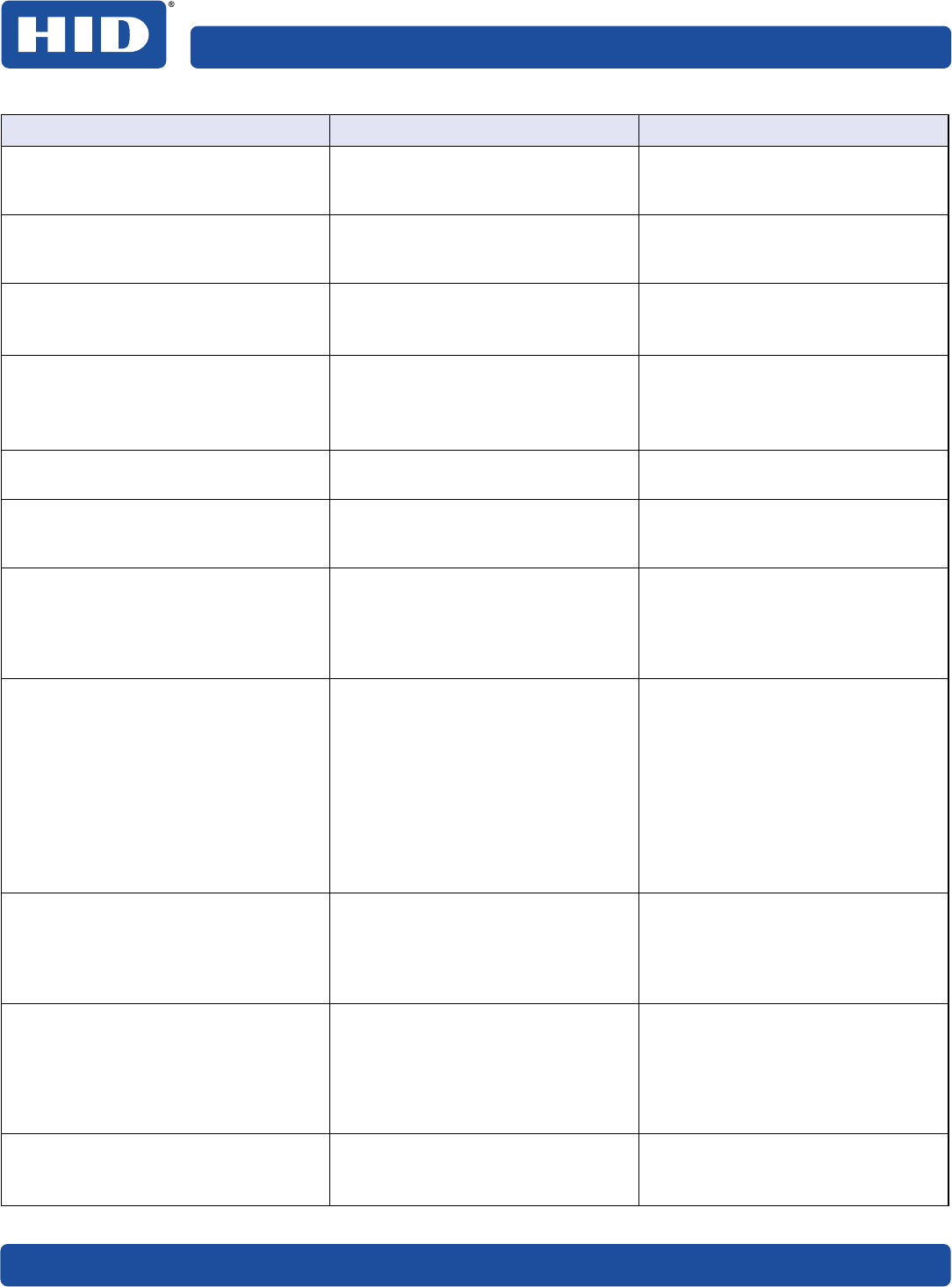
110 September 2018
Troubleshooting PLT-02931, Rev. A.0
Headlift Error
Error Message No. 553, 554, 555, 556
There is a problem with the transfer
roller headlift.
Reset the printer and try again. If
problem persists, call for technical
assistance.
Headlift Error
Error Message No. 560
There is a problem with the transfer
roller headlift.
Reset the printer and try again. If
problem persists, call for technical
assistance.
Job Data Error
Error Message No. 544
The print data sent to the printer is
corrupt or has been interrupted.
Reset the printer and try again.
If this problem persists, call for
technical assistance.
Mag Verify Error
Error Message No. 487
Printer could not verify mag write.
OR
The magnetic stripe was not
encoded properly.
Check the cards for correct mag
stripe orientation and try again.
Verify the mag coercivity selection in
the driver matches that of the cards
Multiple Feed
Error Message No. 475
Multiple cards were fed into the
printer.
Remove all cards and try again.
No E-card Encoder
Error Message No. 451
You are trying to send encoding data,
but the printer is not configured with
this encoder type.
To cancel, press Cancel Print.
No Film
Error Message No. 492
Film is not installed in the printer.
OR
Film RFID tag is bad.
Install the film and press Resume.
To cancel the print, press Cancel on
the printer display or click Cancel
Print from the HID Printer Status
Monitor.
No Flip Module
Error Message No. 482
Two-sided job sent to a one-sided
printer.
Using the printer display, verify the
printer has flipper capabilities.
If flipper capabilities are present,
ensure that the Print Both Sides
option in the printer driver is set
correctly.
Press Resume on the printer display
to continue printing.
To cancel the print, click Cancel Print
from the HID Printer Status Monitor.
No Mag Module
Error Message No. 486
Mag encoding job sent to the printer
without a mag encoder.
You are trying to send encoding data,
but the printer is not configured with
this encoder type.
To cancel the print, click Cancel Print
from the HID Printer Status Monitor.
No Ribbon
Error Message No. 518, 524
No ribbon is installed in the printer.
OR
The ribbon RFID tag is bad.
Install the correct ribbon and press
Resume on the printer display.
To cancel the print, press Cancel on
the printer display or click Cancel
Print from the HID Printer Status
Monitor.
See Manual
Error Message No. 444
An error was detected during
printing.
Reset the printer and try again.
If this problem persists, call for
technical assistance.
Printer Display Error Message Cause Solution
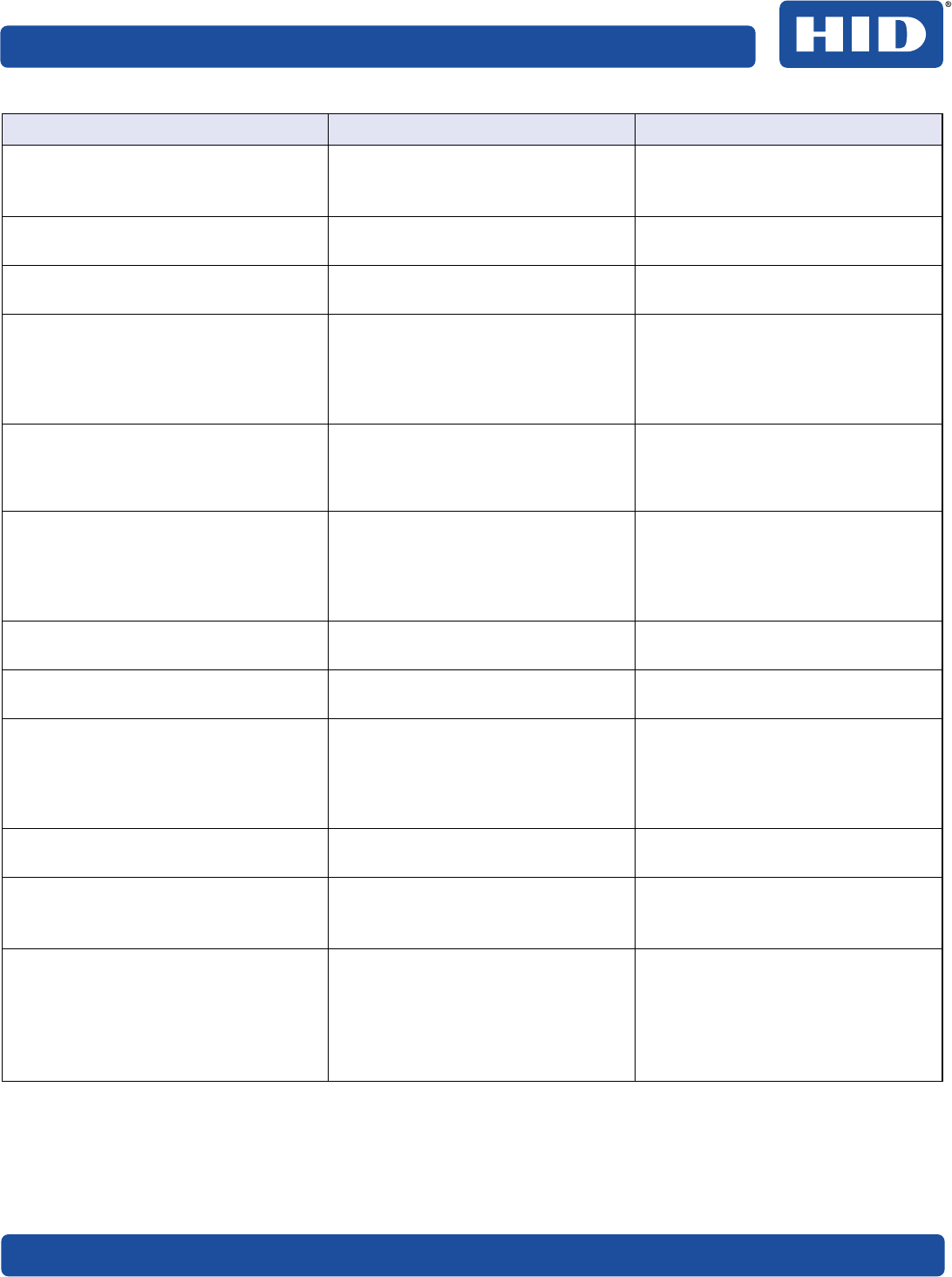
September 2018 111
PLT-02931, Rev. A.0 Troubleshooting
Reboot Required
Error Message No. 430
Unspecified system error detected
by the printer firmware.
Reset the printer and try again.
If this problem persists, call for
technical assistance.
Remove Card
Error Message No. 464
A card is jammed in the print station
or card flipping area of the printer.
Clear the jam and press Cancel.
Remove Ribbon
Error Message No. 533
The print ribbon is installed and
needs to be removed.
Remove the ribbon.
Ribbon Break/Jam
Error Message No. 523, 537
The ribbon is not able to find the
next panel correctly. Check for
jams/breaks.
If jammed, clear the jam. If broken,
repair the ribbon by taping the
ribbon back on to the take-up core.
Press Resume to continue or Cancel
to abort.
Ribbon Low
Error Message No. 528
The ribbon will soon run out. If printing a large number of cards,
replace the ribbon now or monitor
the printer until the ribbon is gone
and install a new ribbon.
Check Ribbon
Error Message No. 530
The ribbon is not able to find the
next panel correctly. Check for
jams/breaks.
If jammed, clear the jam. If broken,
repair by taping the ribbon back on
to the take-up core.
Press Resume to continue or Cancel
to abort.
Ribbon Out
Error Message No. 526, 538
The ribbon has run out. Install a new ribbon and press
Resume to continue.
Invalid Ribbon
Error Message No. 519, 531
The ribbon is not installed properly
or has been damaged.
Verify the correct ribbon is installed
in the ribbon cartridge.
Unable to Feed
Error Message No. 474
The printer is unable to feed a card
from the card hopper.
Verify there are cards in the card
cartridge.
Verify cards are not stuck together or
jammed, and they are the correct
thickness.
See Manual
Error Message No. 453
Command resulted in an error. Verify correct utility command is sent
to the printer.
Waiting for Data
Error Message No. 454
The printer has stopped receiving
data from the PC.
Reset the printer and try again.
If this problem persists, call for
technical assistance.
Wrong Film
Error Message No. 494
The print film installed in the printer
does not match the film type
selected in the printer driver.
OR
A self-test job cannot be printed with
the print media installed.
Replace the film in the printer with
the type specified by the printer
driver.
A reboot is required.
Printer Display Error Message Cause Solution
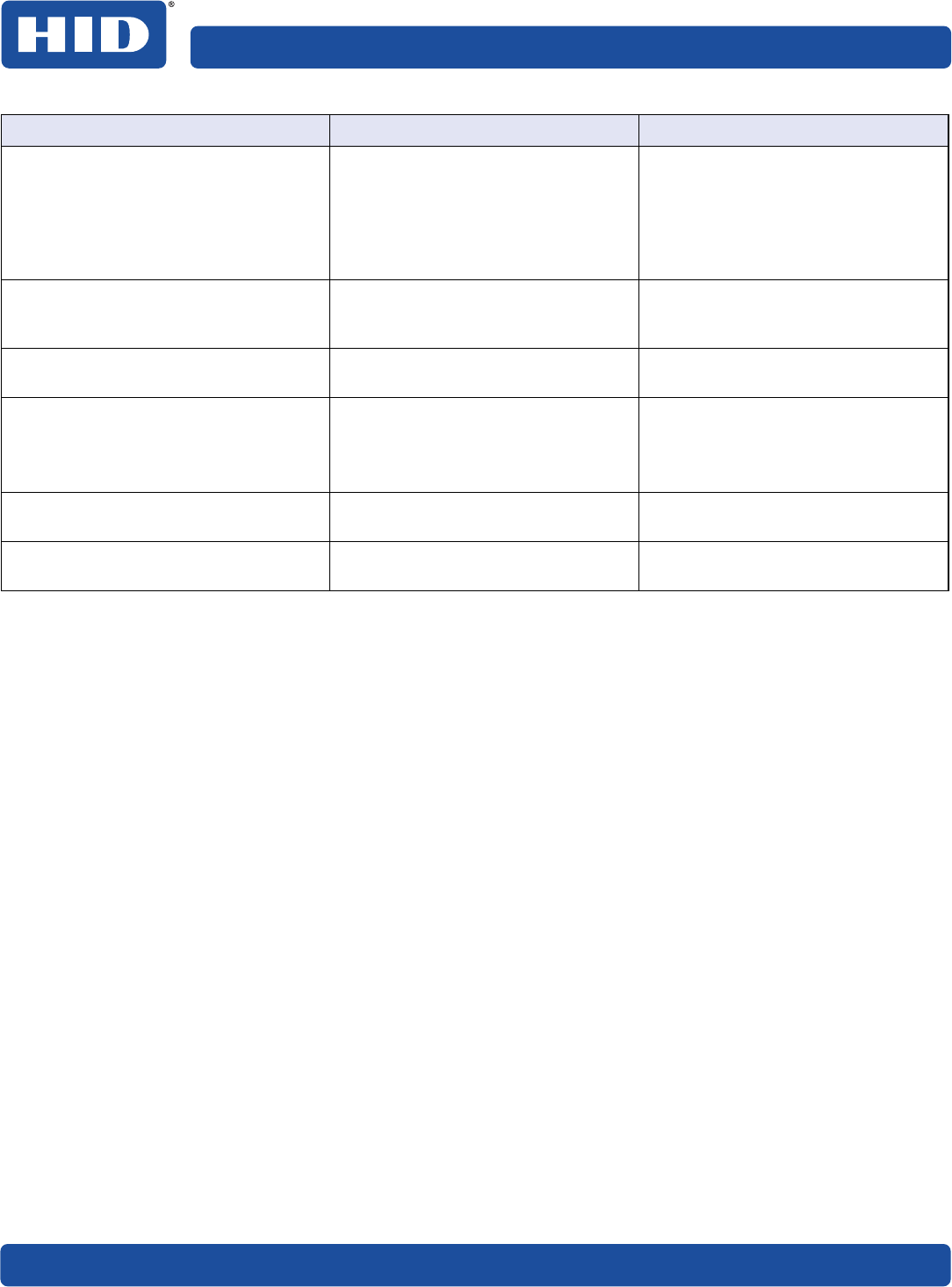
112 September 2018
Troubleshooting PLT-02931, Rev. A.0
Wrong Ribbon
Error Message No. 520
The ribbon installed in the printer
does not match the ribbon type
selected in the printer driver.
OR
A self-test job cannot be printed with
the print media installed.
Replace the ribbon in the printer with
the type specified by the printer
driver.
See Manual
Error Message No. 431, 432, 433, 452,
457, 485, 547, 548, 549, 550
Unspecified system error is detected
by printer firmware.
Reset printer and try again. If
problem persists, call for technical
assistance.
See Manual
Error Message No. 438
The print head has become too hot. Allow to cool off and try again.
Ribbon Temp Error
Error Message No. 441
The ambient temperature of the
printer is too high.
OR
Sensor failure.
Allow to cool off and try again. If
problem persists, call for technical
assistance.
Please Install Film and Close Cover
Error Message No. 536
Film is not installed. Install the film. Press OK and run the
calibration routine again.
Check Film/Card
Error Message No. 552
Card became jammed in printer
during transfer.
Clear the jam.
Printer Display Error Message Cause Solution
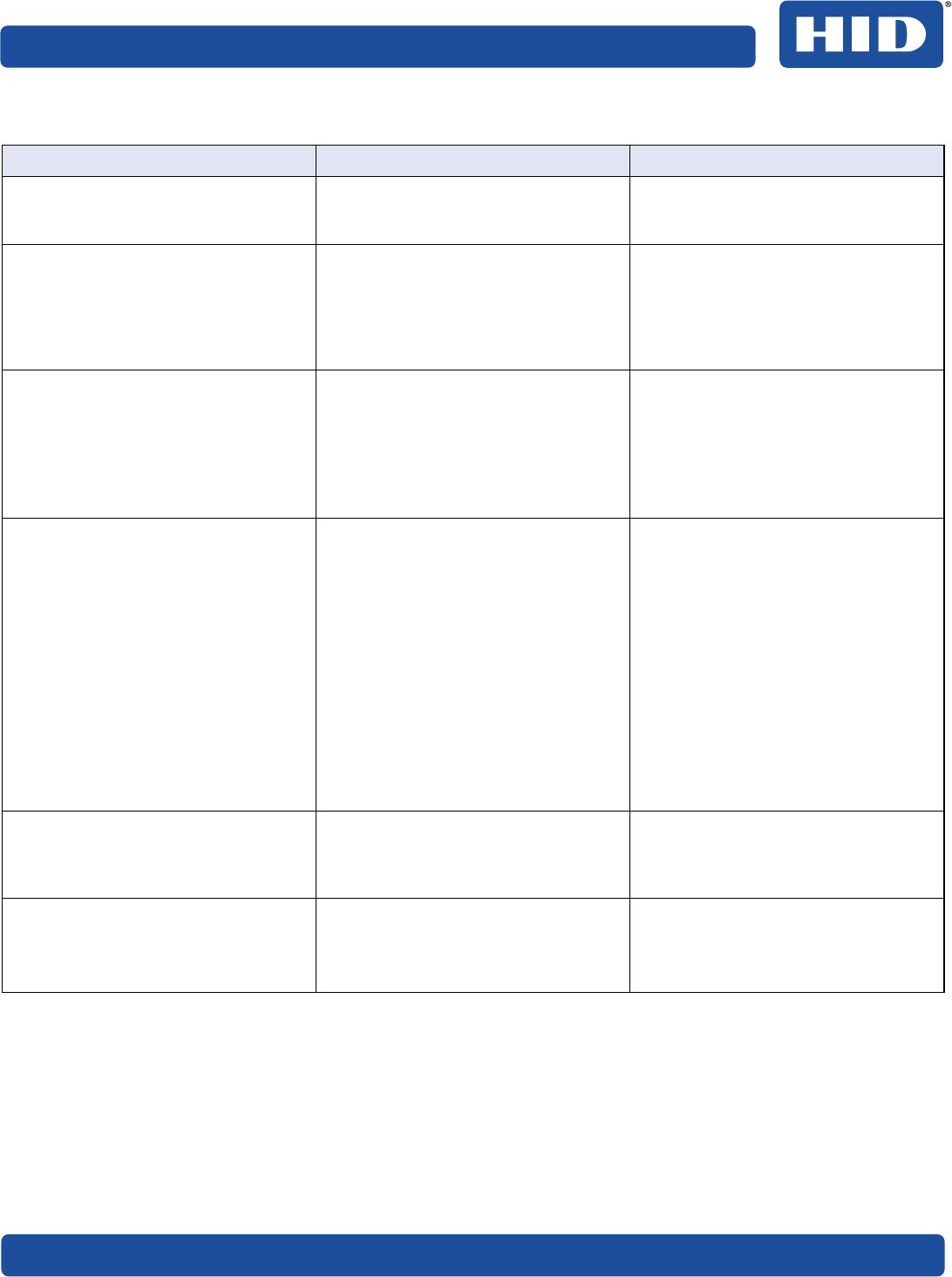
September 2018 113
PLT-02931, Rev. A.0 Troubleshooting
6.1.3 Troubleshooting the printer error message table
Printer Error Message Cause Solution
See Manual
Fail To Initialize
A general printer error has occurred. Press Cancel on the printer or click
Cancel Print from the HID Printer
Status Monitor.
Card Not Found The printer is unable to find the card. Check the printer for the card or other
obstruction. Remove the obstruction.
To cancel the print, press Cancel on
the printer display or click Cancel
Print from the HID Printer Status
Monitor.
Unable to Feed The printer is unable to feed a card
from the card cartridge.
Ensure that cards are available and
loaded correctly, press Resume on the
printer display to continue printing.
To cancel the print, press Cancel on
the printer display or click Cancel
Print from the HID Printer Status
Monitor.
Card Jam
Card Jam: Smart Card
Multiple Feed
Check Film/Card
A card has become jammed in the
printer.
Open the printer front cover and
remove the print ribbon and film
cartridges.
Clear any cards in the printer by
pressing the Forward and/or Back
buttons on the printer display.
Re-insert the ribbon and close the
printer front cover.
Press Resume on the printer display
to continue printing.
To cancel the print, press Cancel on
the printer display or click Cancel
Print from the HID Printer Status
Monitor.
Head Resistance Printhead resistance out of range. Verify that the head resistance
stamped on print head matches value
stored in EEPROM. Press Cancel on
the printer display.
Ribbon Temp Error The ambient temperature of the
printer is out of range.
OR
Sensor failure.
Press Cancel to cancel job. Allow the
printer to cool and cycle the power to
reboot.
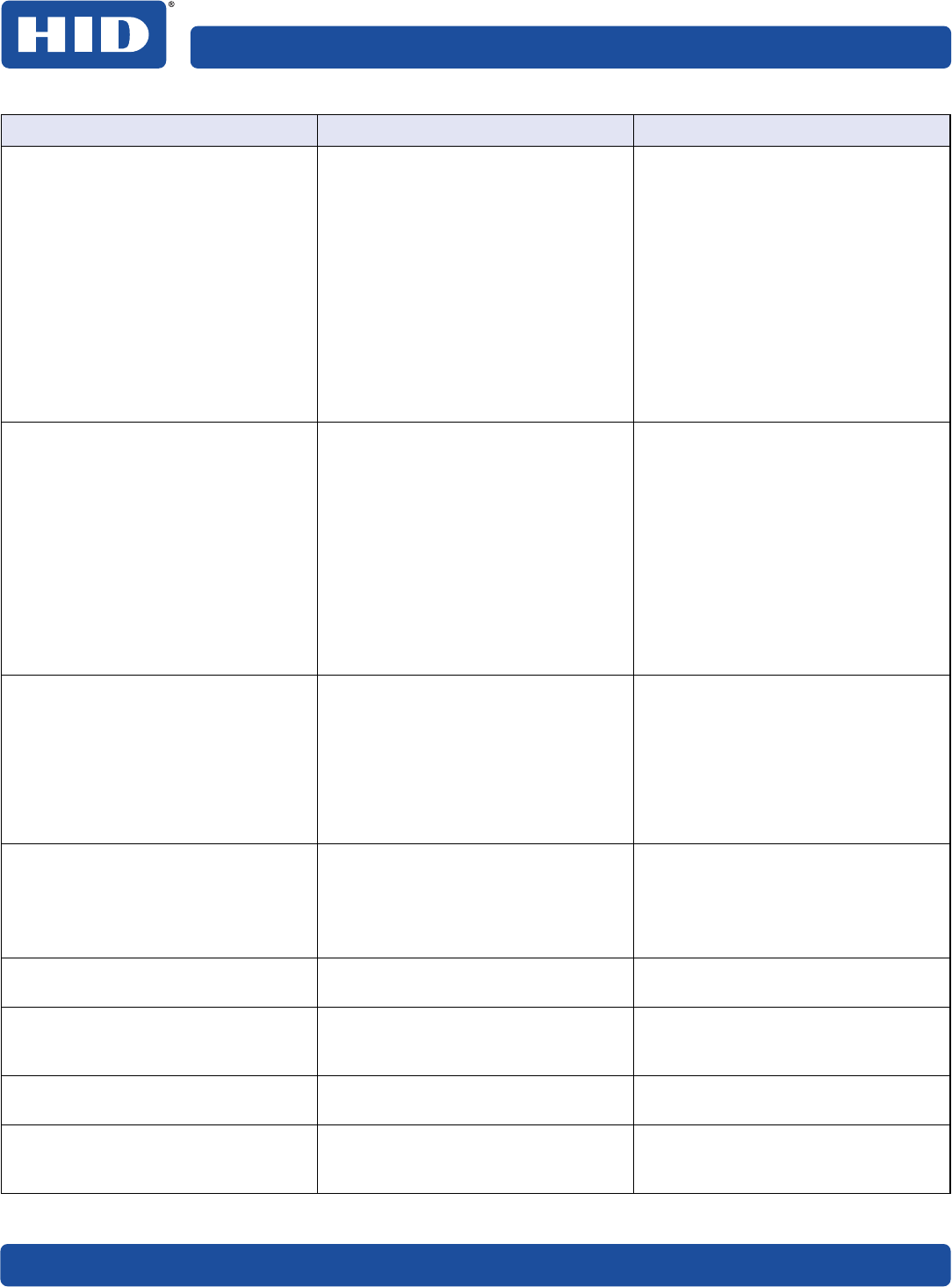
114 September 2018
Troubleshooting PLT-02931, Rev. A.0
Flipper Jam The flipper table has jammed while
either aligning itself or flipping a card.
Open the printer flipper module cover.
Clear any cards in the flipper module
by pressing Forward and/or Back on
the printer display.
Ensure that the flipper table can
rotate freely. Close the printer flipper
module cover.
Press Resume on the printer display
to continue printing.
To cancel the print, press Cancel on
the printer display or click Cancel
Print from the HID Printer Status
Monitor.
No Flip Module The printer does not have flipping
capabilities.
Verify the printer has flipper
capabilities by way of the printer
display menu.
If flipper capabilities are present,
ensure that the Print Both Sides
option in the driver is set correctly.
Press Resume on the printer display
to continue printing.
To cancel the print, press Cancel on
the printer display or click Cancel
Print from the HID Printer Status
Monitor.
Wrong Ribbon
Wrong Film
An incorrect ribbon or film is installed,
or a driver setting is incorrect.
Check that the ribbon or film is
correct for the printer and job. Press
Resume on the printer display to
continue printing.
To cancel the print, press Cancel on
the printer display or click Cancel
Print from the HID Printer Status
Monitor.
No Ribbon
No Film
No print ribbon or film is installed in
the printer.
OR
Ribbon or film tag information
corrupt.
Install the correct ribbon or film and
press Resume on the printer display.
Ribbon Out
Film Out
The print ribbon or film installed in the
printer is empty.
Install a new ribbon or film and press
Resume on the printer display.
Calibrate Ribbon The ribbon sensor is not calibrated. Cancel the job, open the cover,
remove the ribbon, close the cover,
run the ribbon calibration routine.
Calibrate Film The film sensor is not calibrated. Cancel the job, run the film calibration
routine.
Calibrate Failed The ribbon or film sensor failed
calibration.
Verify the ribbon is removed, the film
is installed, and print cover is closed.
Run calibration again.
Printer Error Message Cause Solution
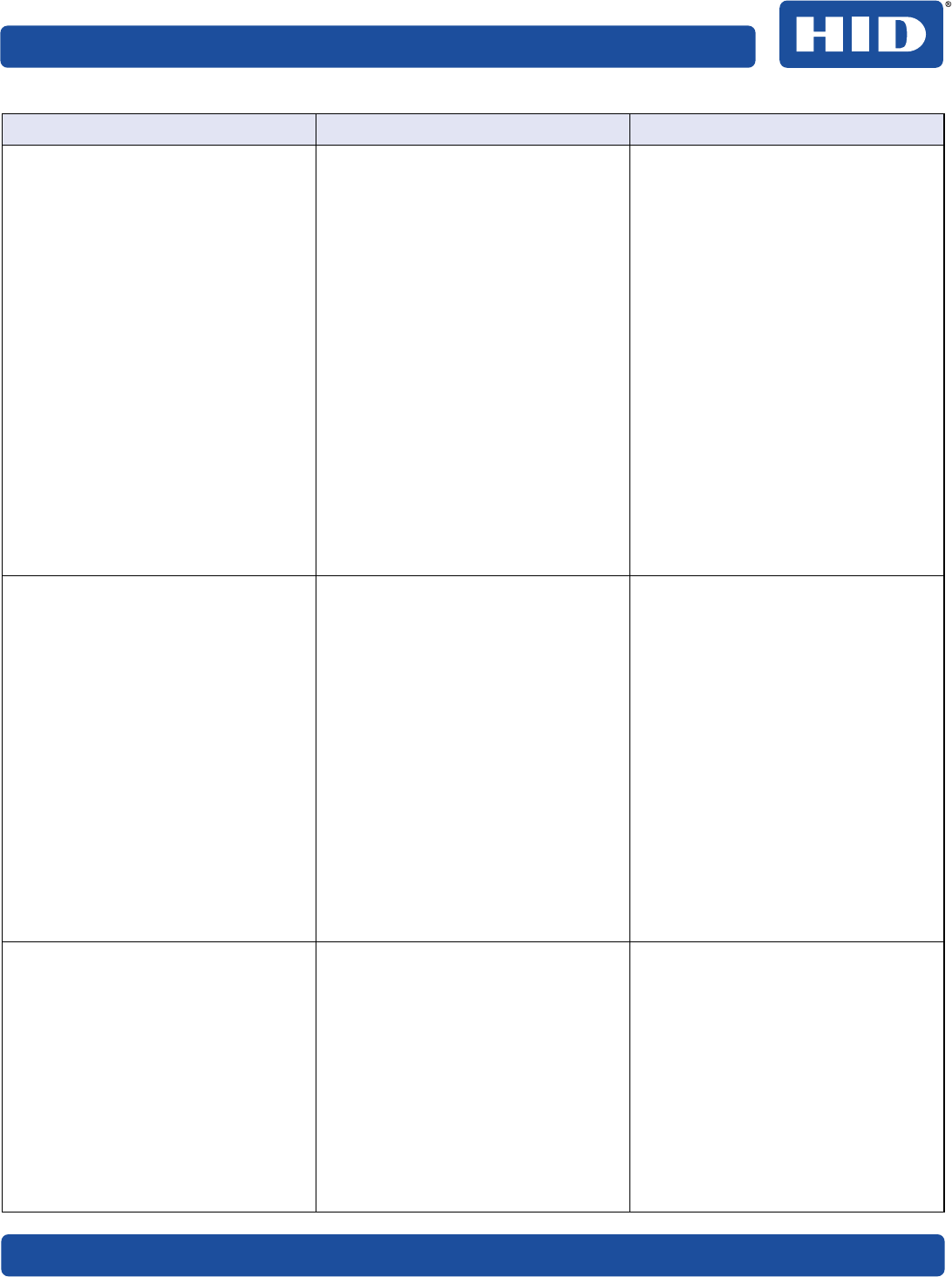
September 2018 115
PLT-02931, Rev. A.0 Troubleshooting
Ribbon Break/Jam, Check Ribbon A ribbon break/jam has been
detected inside the printer.
The printer has determined that the
installed ribbon has either jammed or
broken.
Open the printer cover and remove
the print ribbon. If ribbon is jammed,
remove the jam and tighten the
ribbon.
Clear any cards in the printer by
pressing the Forward and/or Back
buttons on the printer display.
Tape the ends of the ribbon together
and wind any excess onto the take-up
spool of the print ribbon.
Re-install the print ribbon, close the
printer cover and press Resume on
the printer display to continue
printing.
To cancel the print, press Cancel on
the printer display or click Cancel
Print from the HID Printer Status
Monitor.
Check Film A film break/jam has been detected
inside the printer.
Open the printer cover and remove
the print film. Check the film and see
if it is broken.
If the print film is not broken, re-install
the print film, close the printer cover,
and press Resume on the printer
display to continue printing.
If the print film is broken, tape the
ends of the print film together and
wind any excess onto the take-up
spool. Re-install the print film, close
the printer cover and press Resume
on the printer display to continue
printing.
To cancel the print, press Cancel on
the printer display or click Cancel
Print from the HID Printer Status
Monitor.
Invalid Film An incorrect print ribbon/print film
has been installed in the printer. (This
is if you are using SecureMark™ ribbon
and film.)
A non-SecureMark ribbon or film is
installed in a SecureMark printer.
Replace with the appropriate
SecureMark ribbon or film and press
Resume on the printer display to
continue printing.
Install a certified print ribbon and
press Resume on the printer display
to continue printing.
To cancel the print, press Cancel on
the printer display or click Cancel
Print from the HID Printer Status
Monitor.
Printer Error Message Cause Solution
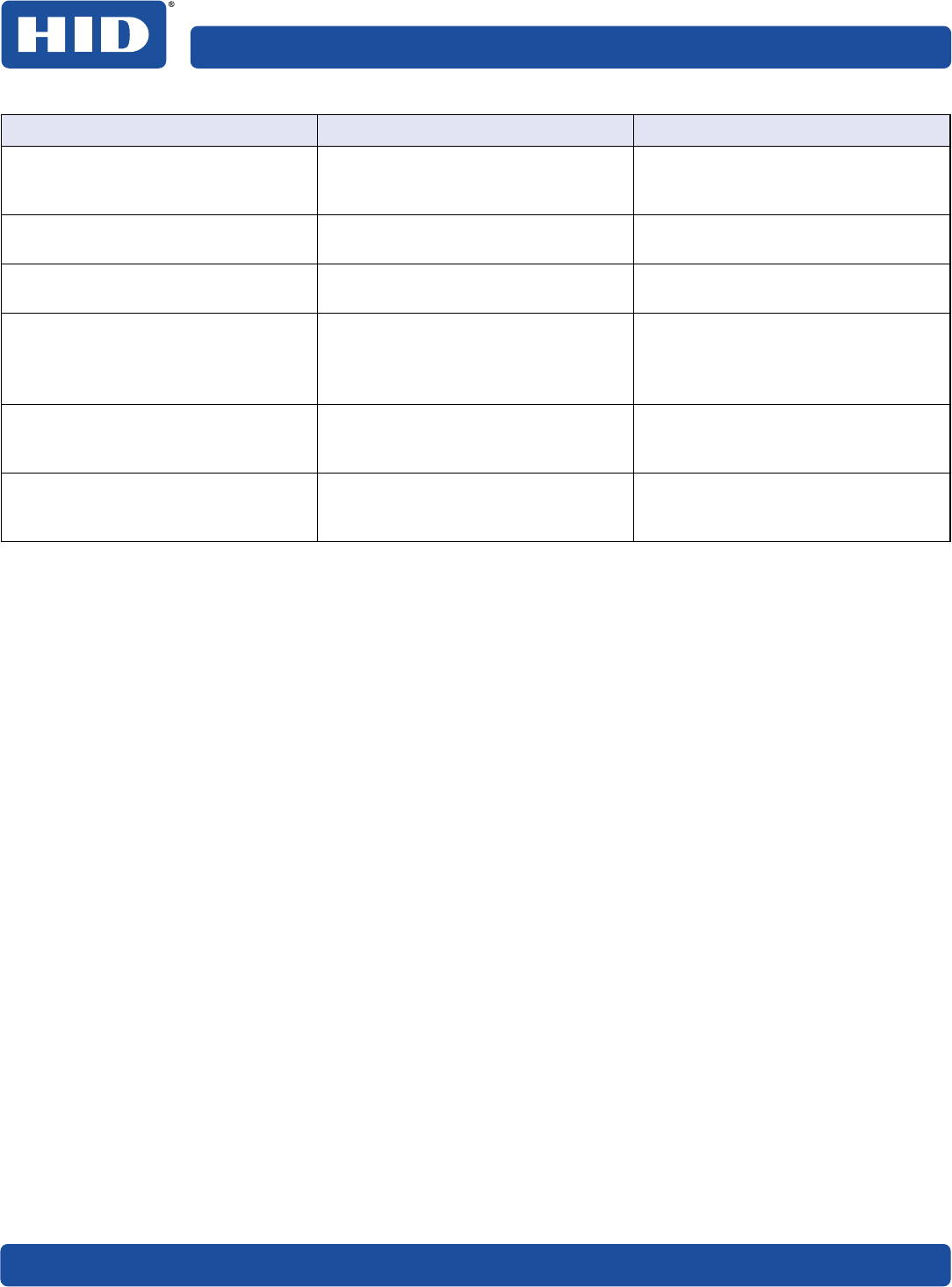
116 September 2018
Troubleshooting PLT-02931, Rev. A.0
No Mag Module A print job with magnetic encoding
was sent with no magnetic encoder
installed in the printer.
Ensure that encoding data is not
being sent with the print job and
reprint the card.
Mag Verify Error The printer is unable to verify
encoded data.
Check the cards and click Cancel
Print on the printer display.
No Ecard Encoder No smart prox card encoder is
installed in the printer.
To cancel, click Cancel Print on the
printer display.
Headlift Error The headlift sensor is not detecting
movement from the headlift cam. This
can occur for the printhead, transfer
roller, or card flattener.
Reboot the printer by cycling the
power.
To cancel, press Cancel Print on the
printer display.
Waiting For Data
Job Data Error
Entire print job is unable to be sent to
the printer
Verify physical connection to the
printer. To cancel, press Cancel Print
on the printer display.
Heater Error The transfer roller or card flattener
can not achieve correct temperature.
To cancel, press Cancel Print on the
printer display. Reboot the printer by
cycling the power.
Printer Error Message Cause Solution
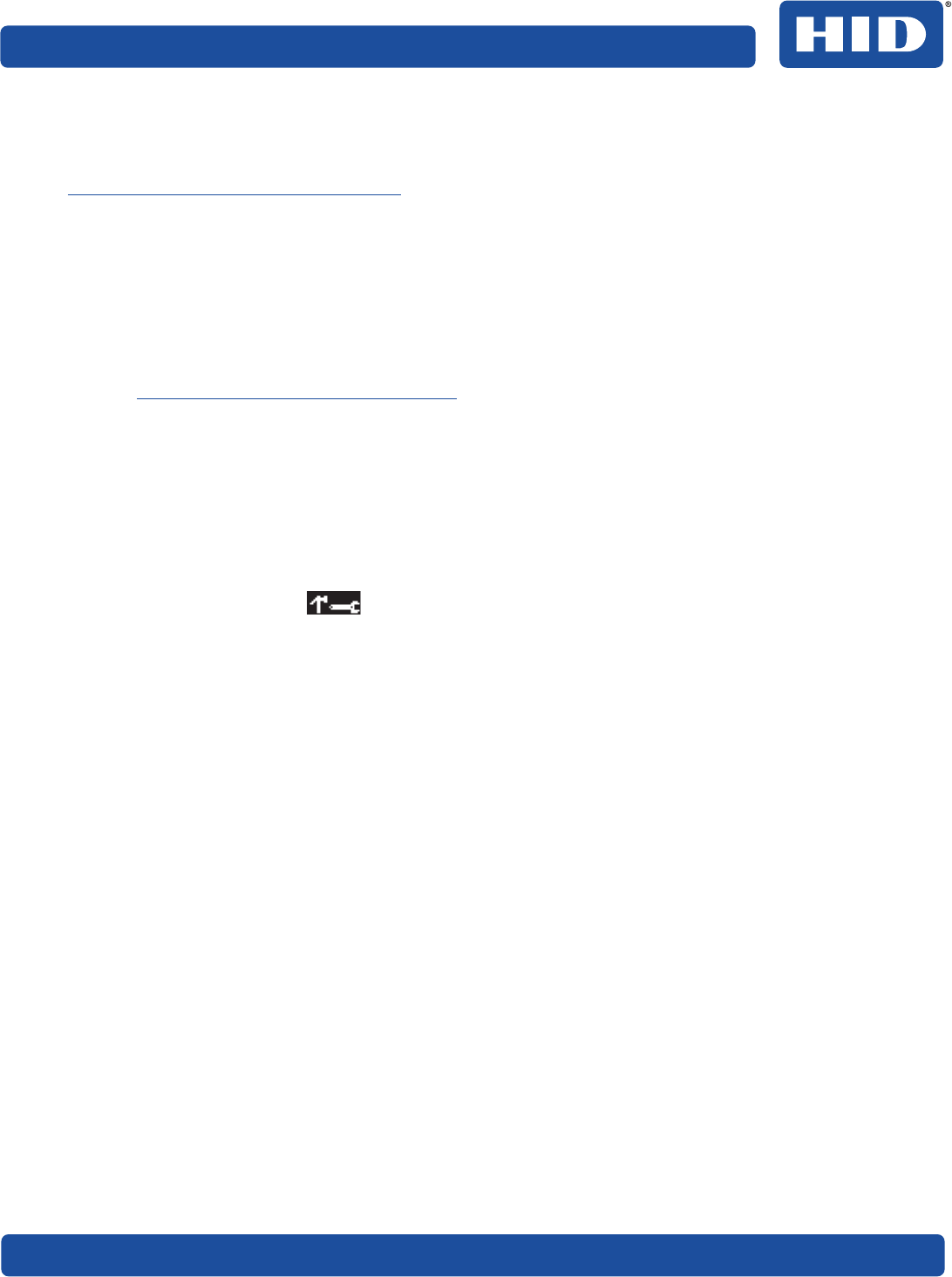
September 2018 117
PLT-02931, Rev. A.0 Troubleshooting
6.2 Resolving common errors
Confirm that the system meets the minimum requirements.
Access https://www.support.microsoft.com and search for your Microsoft OS system requirements.
Confirm the correct installation of the printer driver:
႑Close the software program and check the printer driver.
႑Reboot the computer.
႑Ensure the printer driver is installed correctly.
Note: This especially pertains if an obsolete driver was recently removed.
Ensure the correct setup options in the printer driver are selected. Confirm that the driver is current by
checking at: http://www.hidglobal.com/drivers.
Confirm the correct installation of the flipper table module assembly:
1. Reboot the computer.
2. Ensure that the print both sides option in the printer driver is set correctly.
3. Verify the flipper table module assembly is functioning properly by printing out cards in a test run.
Determine the problem with printing from the application:
႑Print a self-test from the printer.
On the printer display, select >Test Prints > Settings to ensure that the printer is functioning
properly.
႑Print the Windows test page from your computer.
a. From the Printing Preferences window, select the Utilities tab > Self Tests.
b. From the Self Tests tab, select one of the tests in the list, and click Run Test.
႑Use WordPad to print a test card.
a. Open WordPad and type: This is a test.
b. Go to the File menu and select Print.
c. Select HDP6600 Card Printer and click Apply.
d. Click Print.
Determine whether there is adequate hard disk space.
Note: A large volume of temporary files on the computer can cause communications errors. Use the Disk
Cleanup feature in your Windows Settings to free up disk space by deleting unnecessary files.

Troubleshooting PLT-02931, Rev. A.0
This page is intentionally left blank.
118 September 2018

September 2018 119
PLT-02931, Rev. A.0
This page is intentionally left blank.

hidglobal.com